

HIKING in PATAGONIA – The Ultimate Guide to the Best Treks
- Last Updated: February 5, 2024
Everything you need to know about hiking in Patagonia. From trekking in Torres del Paine to El Chalten and everywhere in between, this list of the best hikes in Patagonia will help you plan your big adventure!
Often and widely considered as having the most breathtaking, scenic landscapes in the world, trekking in Patagonia is every hiker’s dream, whether it is for the avid day hiker to the seasoned, experienced multi-day trekker.
Patagonia is a land of dreams, ranging from the raging rivers of the Rio Moscu to the iceberg glacial lakes of Tigre Sur.
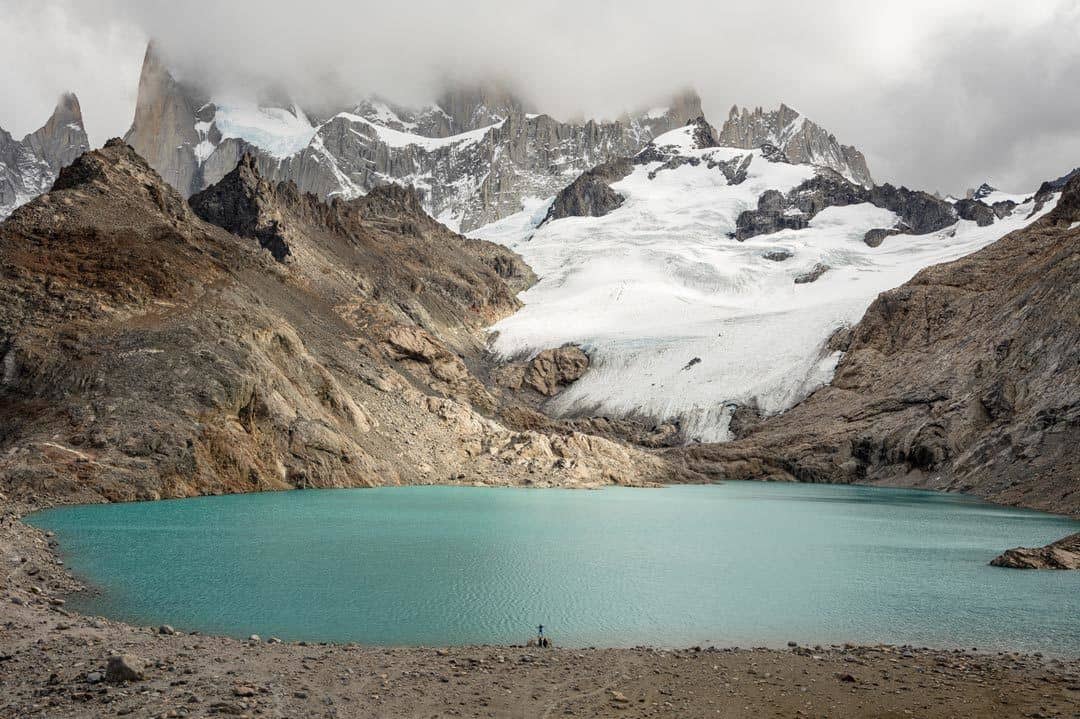
The hiking routes take you from lush meadows of wild flowers to snowy-rugged peaks at the base of the world famous Mount Fitz Roy.
Just the thought of hiking in Torres Del Paine National Park sends shivers down my spine. Ever wanted to visit one of the world’s most famous granite peaks? Cerro Torre in Patagonia is your place to do so.
There are literally endless kilometres of hikes to do, but it can be very difficult to choose just one when everything looks like it’s worthy of being on a postcard.
Patagonia truly is one if not the most beautiful places on earth, so where do you begin?
It’s every adventurer’s desire to get a taste of what trekking and hiking in Patagonia is like, so I have established a list of the best day hikes to the some of the world’s most stunning multi-day treks.
READ MORE: Don’t miss our guide on backpacking in Patagonia on a budget.
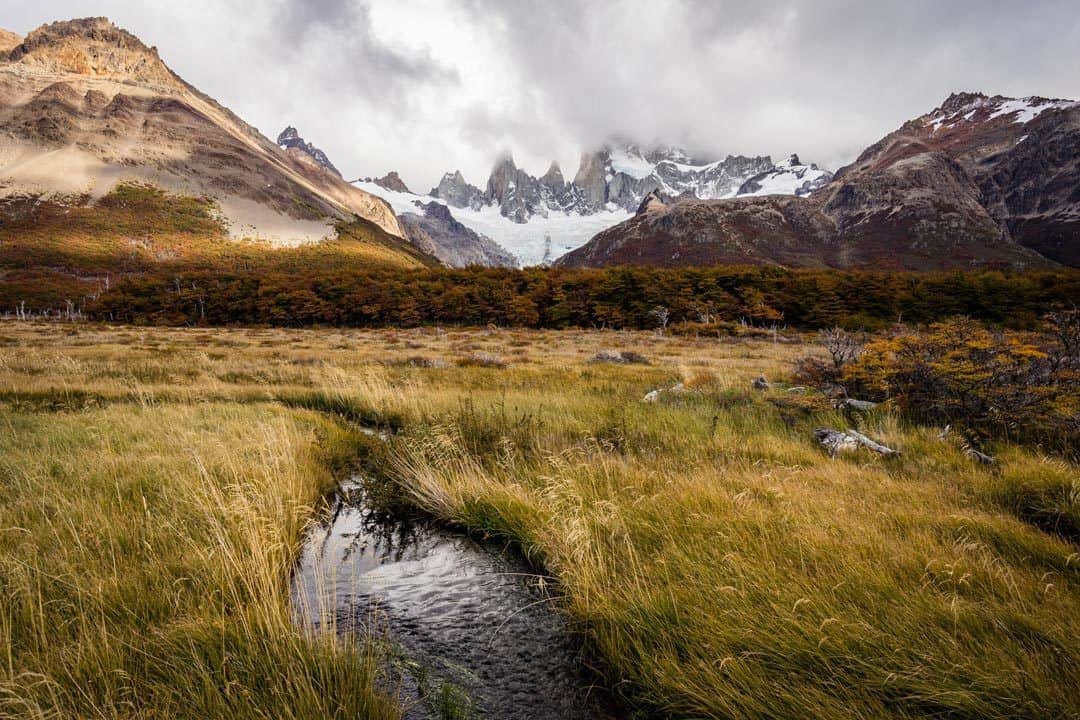
Table of Contents
Hiking to Mirador Las Torres
Lago grey (grey glacier), the french valley – valle del frances, los cuernos trail, the “o” circuit, short hike to condor lookout, day hike to the base of mount fitz roy – laguna de los tres, day hike to cerro torre, the huemul circuit, laguna esmeralda, glaciar vinciguerra, sierra valdivieso circuit, laguna tigre sur, valle rio moscu, cerro castillo, pumalin park – cascadas waterfalls hike (escondidas), save this pin for later, the best time to go hiking in patagonia.
Early November until late April are generally the best times to go hiking in Patagonia, however this can change from year to year due to varying amounts of snowfall.
Not a fan of the cold? Try and head there in February and March for the warmer months for some great Patagonia trekking.
Also it’s necessary to know that weather in Patagonia is so varied and can change at any time, which can very quickly alter your Patagonia hiking trip. Keep that in mind when planning your adventure.
Hiking according to the seasons in Patagonia has both pros and cons no matter what time of year you decide to go, so if you were going to pick a time, aim for the end of March to mid-April, where weather seems to be slightly cooler but more stable allowing you to enjoy Patagonia in all its glory.
But the best reason for visiting Patagonia at that time of year is to see the entire region in autumn colours! Simply breathtaking.
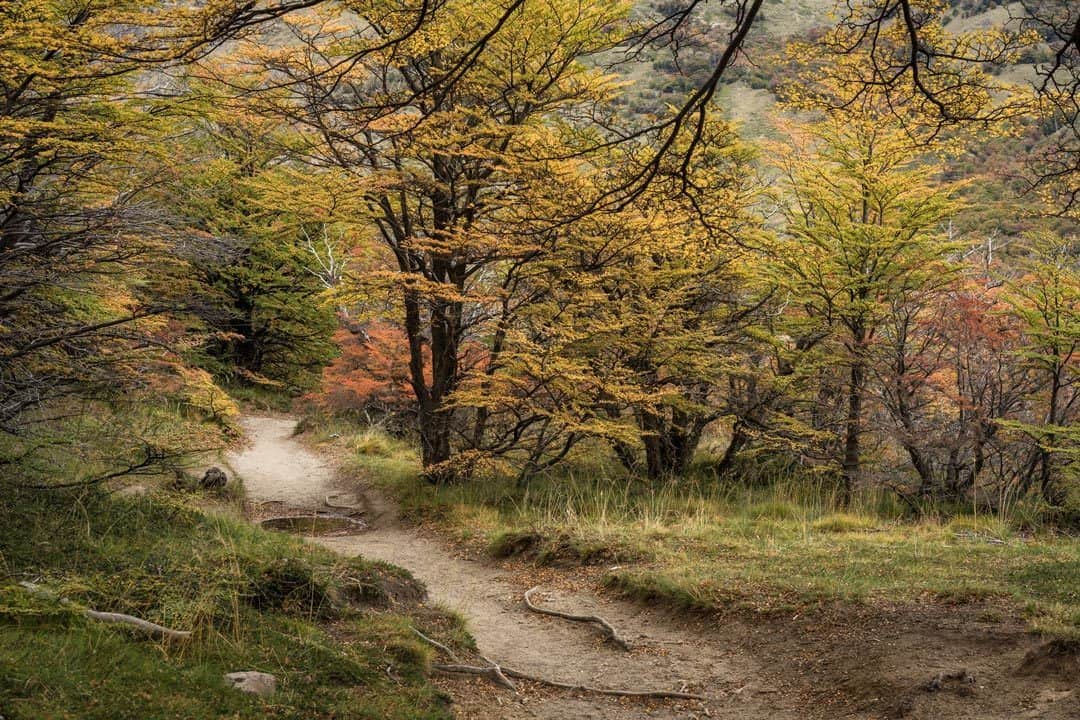
Hiking In Torres del Paine National Park
When it come to hiking in Patagonia, no trip would be complete without spending at least a few days in Torres del Paine National Park, the crown jewel of Chile.
Whether you’re interested in just heading into the park for a day hike, using one of the accommodations inside the park as a base (we personally recommend EcoCamp ), or carrying all of your camping gear and completing the famous O Circuit, you definitely won’t be disappointed with the trekking here.
- Time Required: 8 to 9 hours
- Distance: 18km
- Difficulty: Hard
- Start / Finish Points: Hotel Las Torres
Widely considered to be the most popular day hike in Torres del Paine, Mirador Las Torres is just one of the magical places you can hike to when in Torres del Paine.
Las Torres translated to English means ‘The Towers’, and mirador means ‘Lookout’ , so you should have an idea of what to expect up there.
The Towers are a series of 3 jagged peaks that literally tower over a turquoise lake below, and chances are you’ve already seen a photo of them at least once in your life.
This particular trek is 18 kilometres of visual delights, despite it being considered as a difficult hike, and the views once you reach the top are just awesome!
Most of the trek is uphill, but don’t let that put you off this classic day hike, as cascading waterfalls, forests beaming with life and boulder fields dominating the higher landscapes and just waiting for you to enjoy.
The last hour is extremely steep, so make sure you save some energy for the final slog.
If you are after a really magical experience spend the night in the park and start hiking up in the dark. If the weather cooperates you’ll be rewarded with Las Torres looking as though they’re on fire with the red sun lighting them up at sunrise.
Las Torres is a hiker’s dream, and if you could only choose one trek in the whole of Patagonia, this would be it! Return via the same way you climbed, starting and finishing at the Hotel Las Torres.
Prefer to hike with a guide? Book your Mirador Las Torres tour here with Get Your Guide.
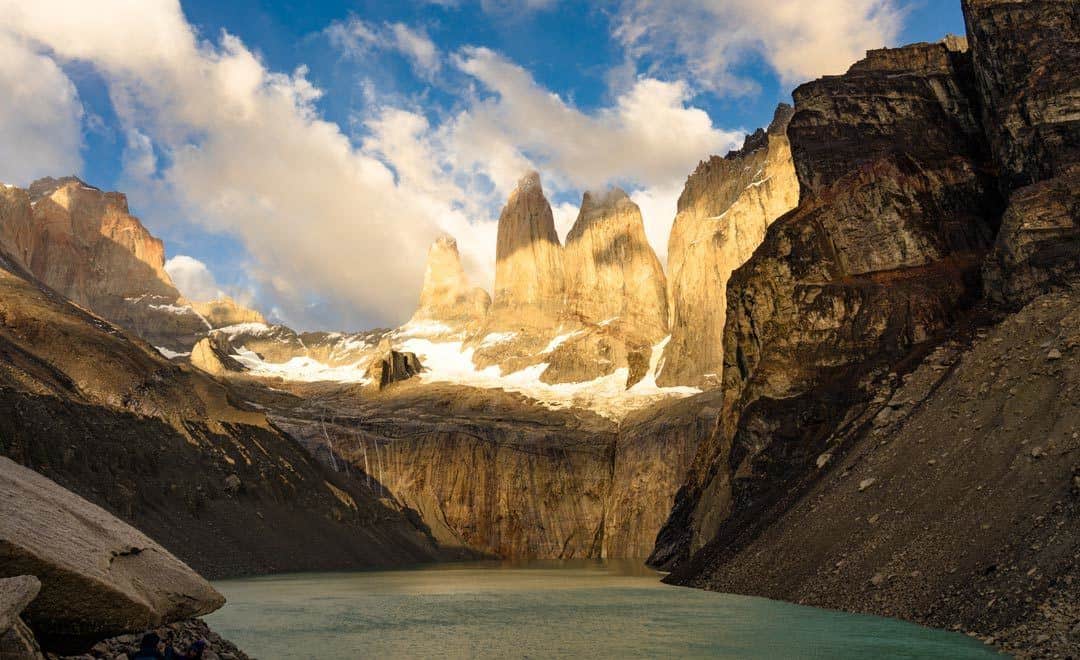
- Time Required: 3 to 4 hours
- Distance: 11 kilometres
- Difficulty: Easy to moderate
- Start / Finish Points: Mountain Lodge Paine Grande to Refugio Grey
As you might know there are quite a few glaciers in Patagonia (you can even visit some on an amazing glacier cruise in the Chilean fjords ), but this one takes the cake as the best of the best.
Along the famous “W” Trek, towards the western part of the hike, is a long section that follows the Lago Grey lake, which is gradually fed by a huge glacier known as Glaciar Grey.
Here you can expect to see pale blue icebergs floating around in the Lago Grey, as parts of Glaciar Grey collapse into the lake below and it’s a spectacular sight to see!
From Refugio Grey to Mountain Lodge Paine Grande is a 3 to 4 hour hike spanning over 11 kilometres, with little ascent or descent making it a fairly easy day out.
Expect to see vast areas of vegetation, wild flowers and the odd section of track that requires a tricky traverse but nothing too major. Keep an eye out for the majestic Cerro Torre piercing the sky.
Camping is available at Mountain Lodge Paine Grande and Refugio Grey if you want to spend the night there. Otherwise take the ferry to Paine Grande or Refugio Grey and start walking.
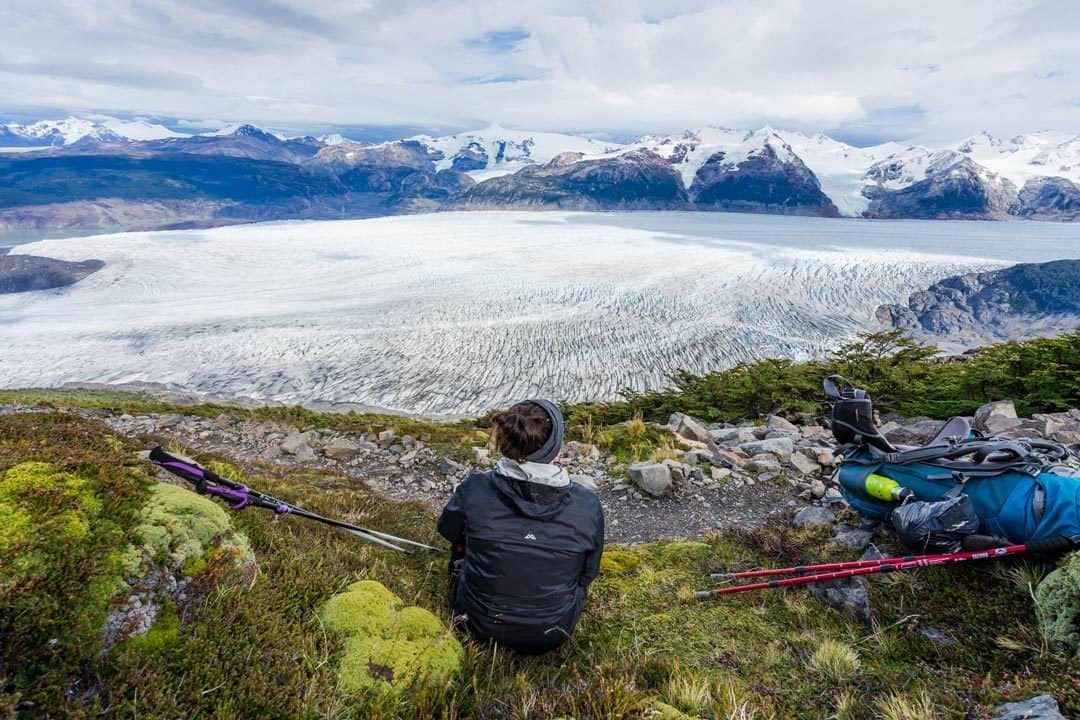
Alesha enjoying the view over Grey Glacier.
- Time Required: 3 to 4 hours
- Distance: 12km
- Difficulty: Moderate
- Start / Finish Points: Refugio Los Cuernos
You always have energy in Patagonia, even when you are literally falling asleep, so don’t miss this epic side trip that takes you between the Cerro Paine Grande and the Cuernos del Paine following the flowing river of the Rio Frances.
Why this hike is the one of the most spectacular side trips is because it has frozen waterfalls…how cool is that?!
READ MORE: We’ve just published our best hiking tips after 15 years trekking!
Also pretty dangerous though, so don’t be getting your ice picks out too soon, because there are views much higher up that you can enjoy, such as the 15 minute trek past the Campamento Britanico placing you in an almost cathedral of mountains.
The Mirador right towards the end is complete with a series of tarns beaming the reflections of the surrounding mountains making it that ideal moment to getting that camera of yours out! Camping is available (minus the facilities of toilets etc). Return the same way you came.
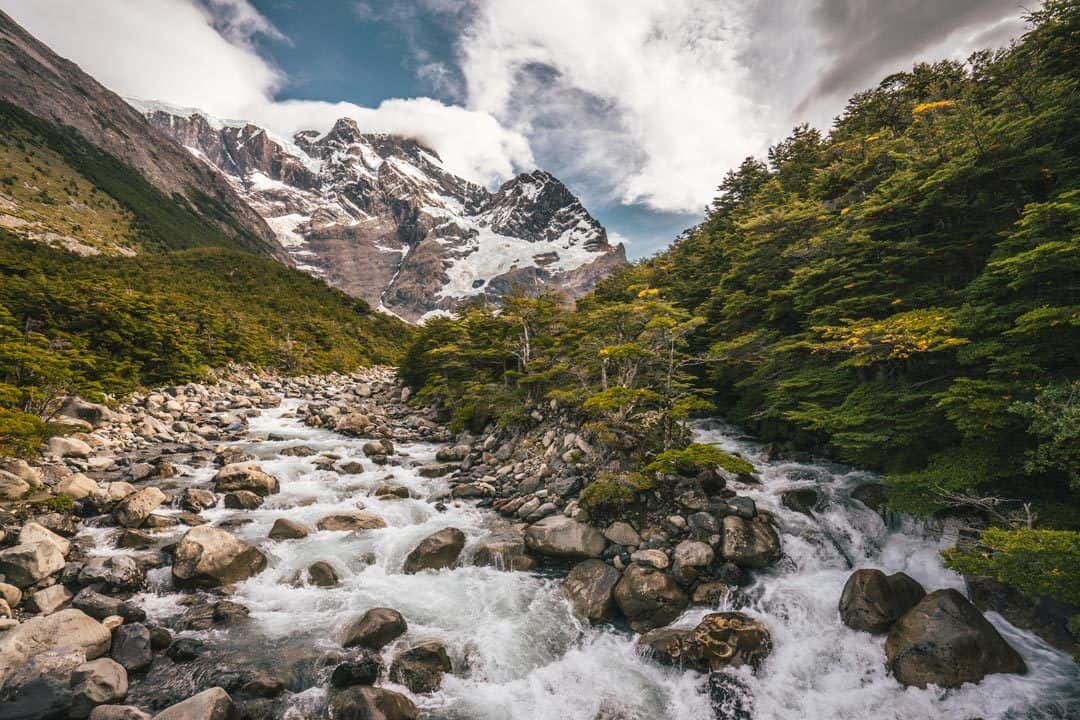
- Time Required: 6 hours
- Distance: 22km
- Difficulty: Moderate
- Start / Finish Points: Hotel Las Torres to Refugio Los Cuernos
Based along the front half of the park, home to the W Trek, is a fantastic day hike weaving around a series of steep banks perched along the edges of the Lago Nordenskjold.
Los Cuernos Trail, which means ‘The Horns’ in English and named after the mountains you can see that are shaped like horns, is a beautiful stretch offering views of the Cuernos del Paine, which never cease to amaze, and gorgeous vistas over the lake.
If you still have bounce in your step when you finish the trail, consider a side trips up the Valle del Frances, an additional 12 kilometre stunning section of track.
Plenty of camping is available on the south side of Cuernos Del Paine if you prefer to take more time on this hike (just keep in mind it gets quite windy in these camp spots).
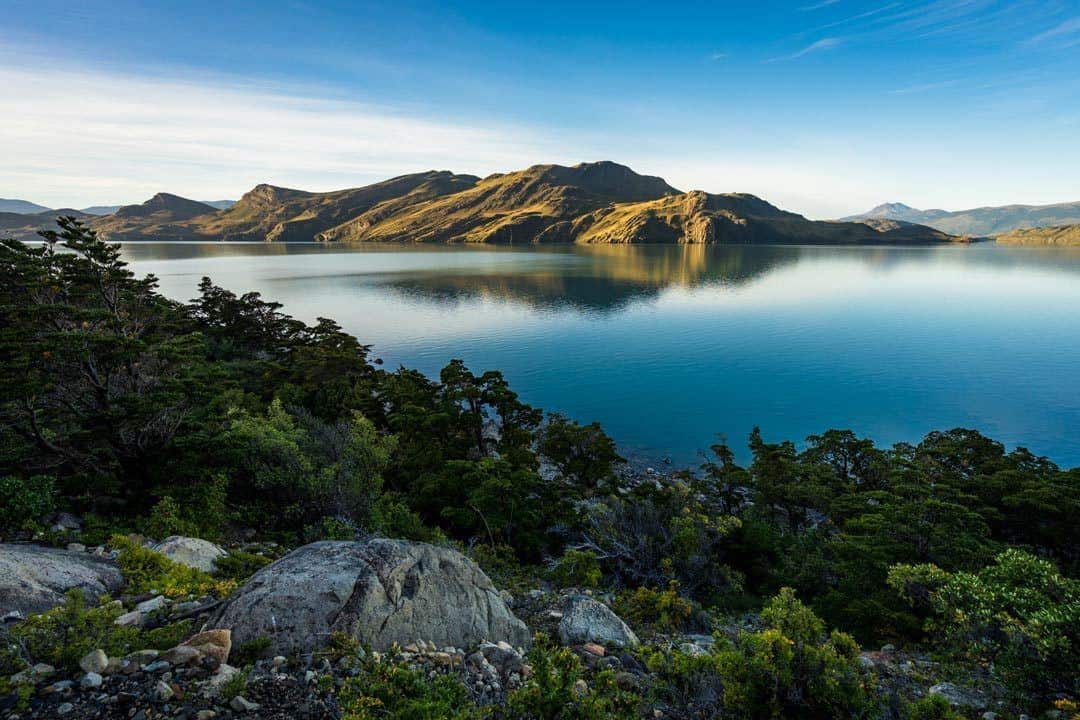
- Time Required: 6-8 days
- Distance: 135km
- Difficulty: Hard
- Start / Finish Points – Hotel Las Torres
Defined as one of the best treks on earth, the Paine Circuit, commonly known to the hiking world as the “O” Circuit due to its shape on a map, is a must do if you have a sense of adventure.
The circuit literally has it all, from pristine forests, meadows of native wild flowers to the grand peaks of Cerro Paine and Cuernos del Paine…and let’s not forget the addition of Las Torres along the eastern side of the trek.
You are best off starting at Hotel Las Torres and heading to Campamento Seron, where views of Cerro Paine (1,508 metres) dominate your surrounds along with rivers flowing off Lago Paine.
Once you connect with the track along the Rio de los Perros, mountains begin to pop-up more frequently along with glaciers, but be sure to pitch your tent at the campsite on Lago Dickinson, as views here are some of the best along the hike.
As you continue to be blown away by Grey Glacier in Torres del Paine (hopefully not by the wind), you find yourself on the trail that begins the “W” trek, which is the shorter, more popular sister of the O Circuit, which begins at Refugio Grey camping area.
Finishing the “O” circuit adds side trips along the French Valley (a must-do hike) and up to Las Torres to watch the sunrise, then heading back down to where you started.
If you want to finish on an alternative route, from Mountain Lodge Paine Grande you can hike along the Rio Grey to the Lago del Toro administration centre.
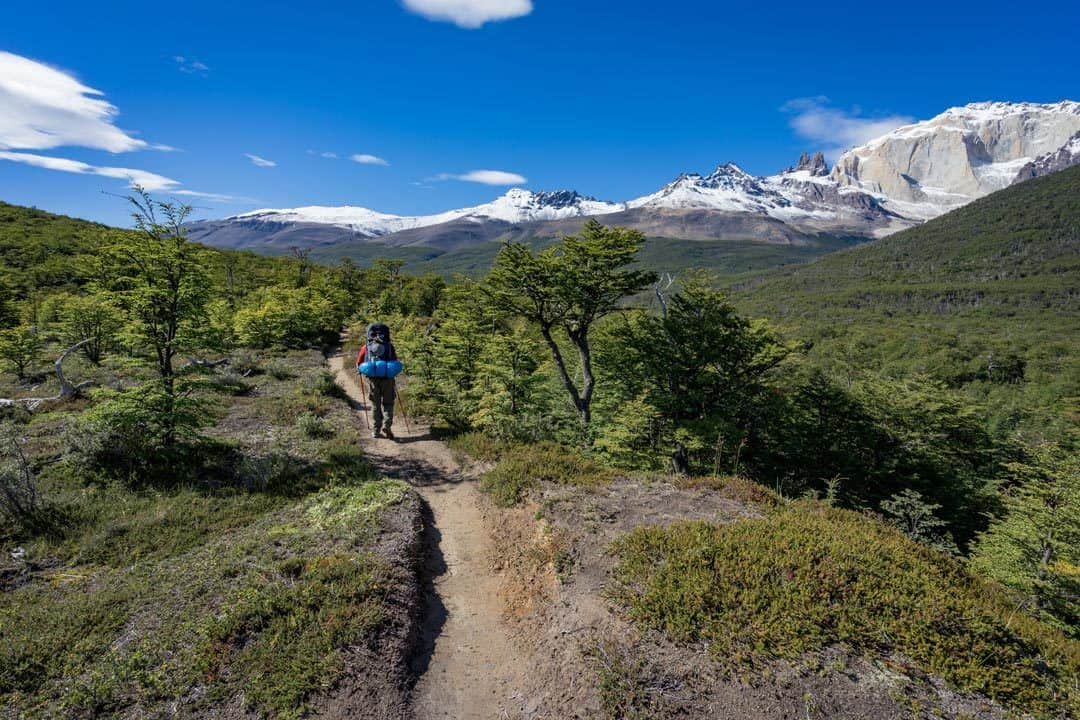
Trekking In El Chalten
While Torres del Paine is the most popular place to go hiking in Patagonia, the truth is El Chalten is the place that will steal most people’s hearts.
Across the border in Argentina, further north of Perito Moreno and its amazing glacier, is a tiny village called El Chalten that sits in the middle of Los Glaciares National Park.
What makes El Chalten so epic is that not only is entrance to the national park free (yes!!!), all of the hikes start from right in the middle of the village.
So once you’ve finished ticking off the quintessential Torres del Paine treks, head off to tackle some of the best hikes in El Chalten!
- Time Required: 1 hour
- Distance: 2km
- Difficulty : Easy
- Start / Finish Points: El Chaten
Based out of El Chaten is one of the shortest hikes in Patagonia, which mostly consists of a gradual ascent to views from Las Aguilas.
Just because it’s short doesn’t mean it’s not worth doing. The views are quite unexpected, as Viedma Lake appears with a backdrop of stunning, ever-covered mountains of snow.
This is a great hike to do for sunrise in case you don’t feel like camping out in the middle of the park. Return the same way you came.
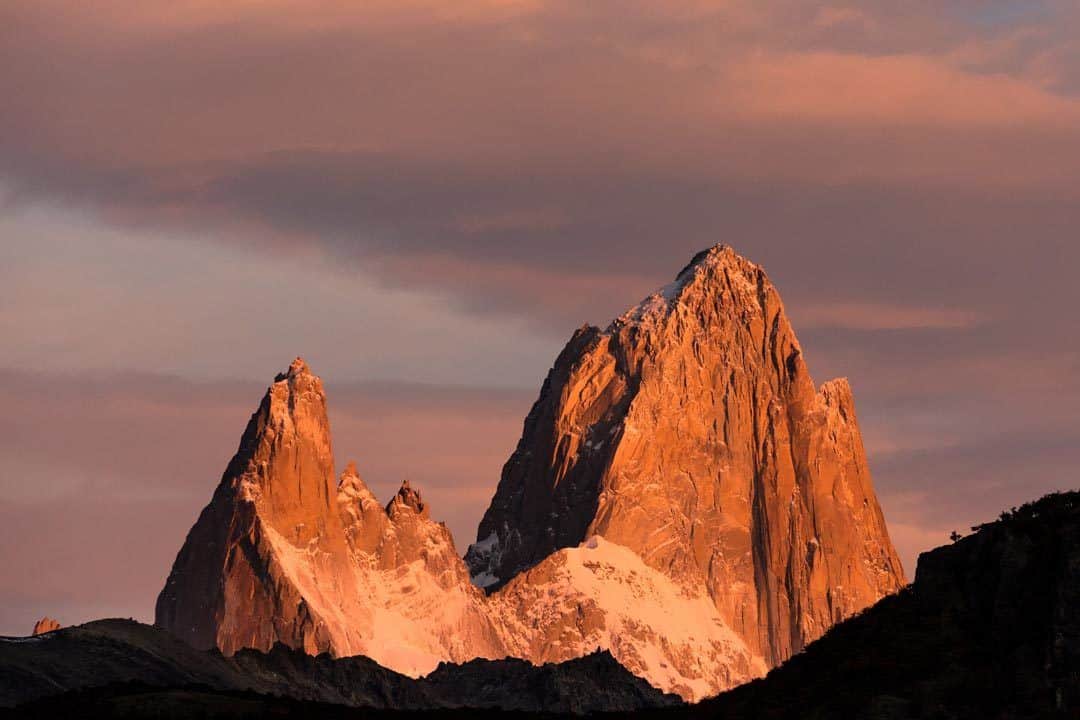
- Time Required: 8 hours
- Distance: 26km
- Difficulty: Moderate to hard
- Start / Finish Points: Northwest end of El Chalten
This hike will be the one that takes you as close as you can get to the foothill of Mt Fitz Roy, and one of the best hikes in El Chalten.
It’s best off to start early to enjoy the morning alpine glow on the peaks above, but that could be said of most treks in Patagonia.
The trail is pretty mellow to begin with, and there are a few narrow sections through forests which are lovely. Then the hard part comes.
Zig-zagging up and up for the last hour, you will finally reach Laguna de los Tres, with the most epic views of Mt Fitz Roy soaring above you!
Depending how skilled you are in the mountains, there is a climb that proceeds up the peak of Cerro Madsen (1,806 metres) for even better views of Fitz Roy.
Return the same way you came to head back to El Chalten, unless you are deciding to camp at Campamento Poincenot.
Prefer to have a guide? Book your Mount Fitz Roy tour here with Get Your Guide.
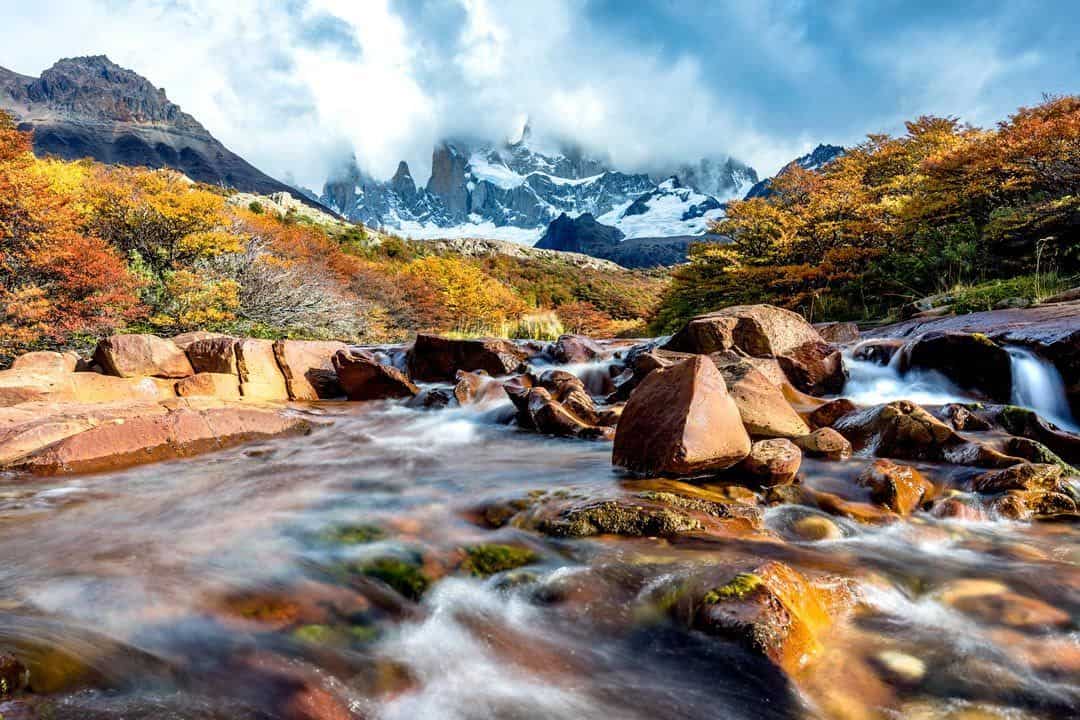
- Time Required: 2 days (can be done as a day hike)
- Distance: 19km
- Difficulty: Easy
- Start / Finish Points: El Chalten
A perfect opportunity to get up close and personal with Cerro Torre, reaching into the sky at 3102 metres, can be done as a day hike, but I think it’s pretty cool to take refuge at Campamento de Agostini at the base of Laguna Torre.
This 2-day trek is a culmination of lush meadows, rugged ever-changing glaciers and stunning views of Cerro Torre and its surround snowcapped peaks.
As a side trip, opt for the Mirador Maestri lookout which will add an additional 5 kilometres to your adventure. At Mirador Maestri be prepared for uninterrupted views of Cerro Torre in all its glory!
On return, head back the same way you came with views looking down the Rio Fitz Roy (a glaciated river from Glaciar Torre).
Prefer to have a guide? Book your Cerro Torre tour here with Get Your Guide.
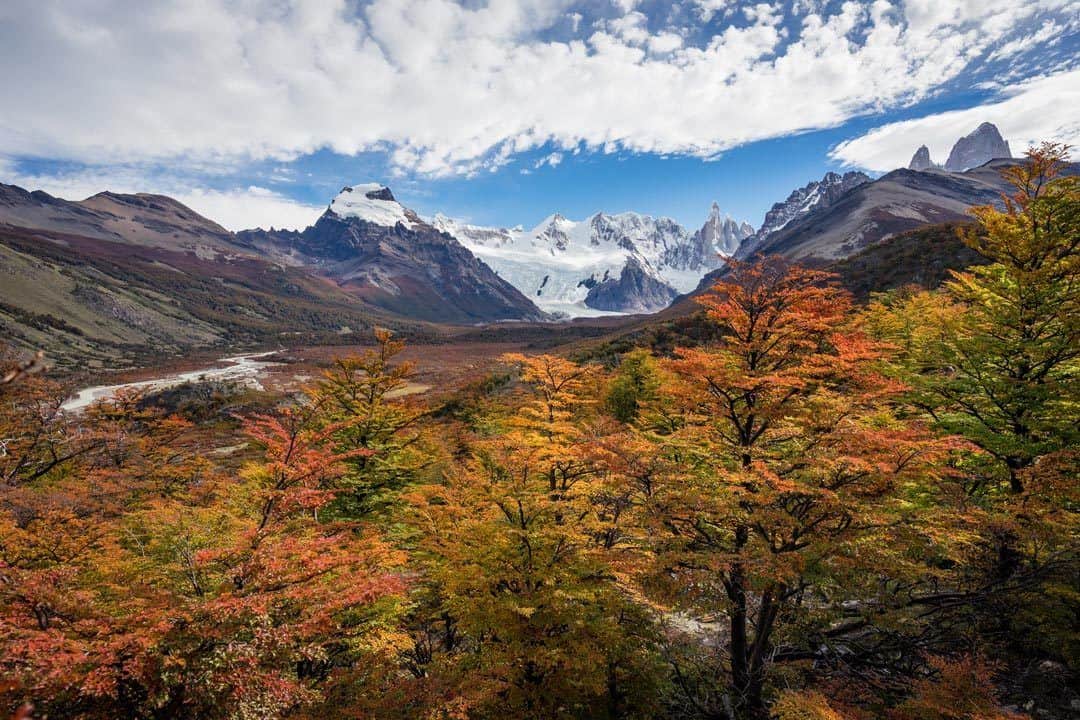
- Days Required: 4 days
- Distance: 63km
- Difficulty: Very difficult
This one is up there as one of the most difficult treks in Patagonia, so be prepared to be fully tested in this stunning lesser-known area of El Chalten.
This Patagonian trek, while demanding in nature, takes you into areas where Cerro Solo can be seen almost standing alone, hence the name ‘solo’.
Mount Huemul is also just as impressive as the contrast between the forest floor, fields of green pastures and rocky spires mix to create stunning views.
The Huemul track puts you to the test with a river crossing almost chest deep as you navigate the Rio Tunel with majestic mountain backdrops.
It only gets harder from here as the Southern Patagonian Ice Field nears, with a climb to Paso del Viento, which is sure to get your blood pumping.
But that’s not all, with a demanding climb to Passo Huemul presenting the clash of Lago Videma (lake) and the walls of the Videma Glaciar.
Views here are gobsmackingly awesome! Take your time to breathe in the fresh air before descending back the way you came.
The Huemul Circuit is considered as a very difficult trek, so its best off to hire a local guide who can help you navigate the rivers and provide insights into one of Patagonia’s most magical areas if you aren’t experienced.
Either way you’ll need a harness and know how to use it, so all hikers on the Huemul Circuit must check in at the information centre before departure to prove they know what they’re doing.
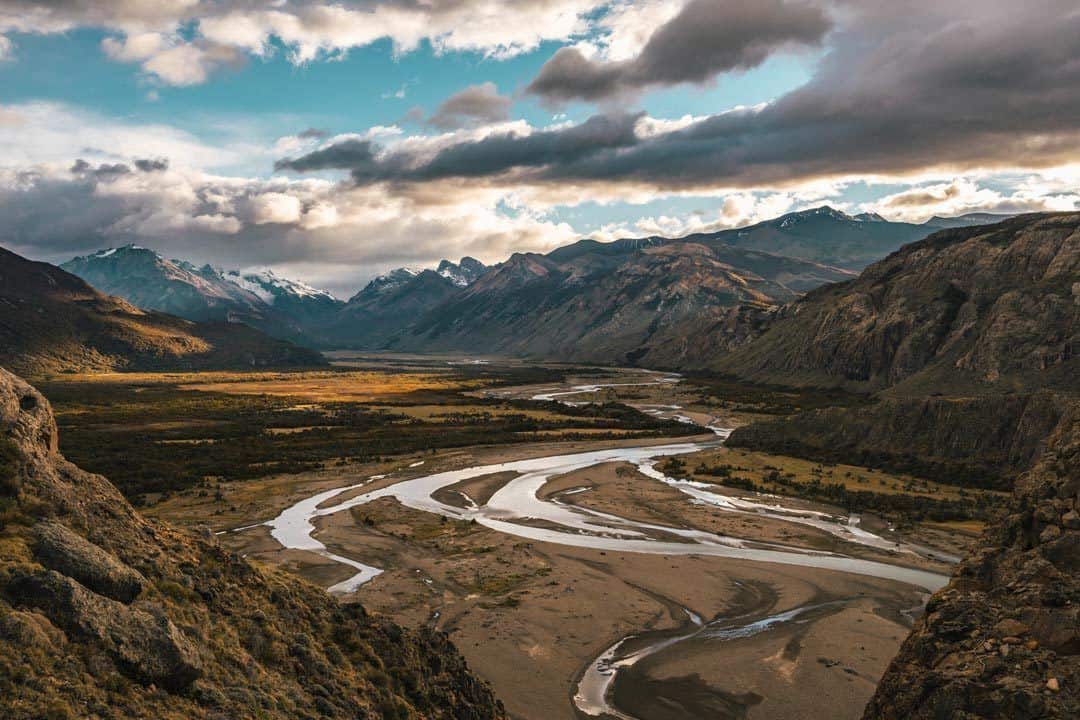
The Best Hikes in Ushuaia
Located at the bottom of Argentina and known as being ‘the end of the world’, Ushuaia is a place that often draws visitors looking to hang out at the bottom of South America. (Click here to read about our experience there.)
It also is a departure point for many people heading off on an expedition to Antarctica.
For those of us that love the outdoors, Ushuaia offers so much more though, and it’s worth spending a few days here to get in some good treks. These are some of the favourite hikes in Ushuaia!
- Distance: 9km
- Start / Finish Points: Refugio Valle Los Lobos
Patagonia isn’t all about multi-day treks, as sometimes the shorter it is the sweeter it tastes. Laguna Esmeralda is an easy 9 kilometre hike to the base of a glacier known as Glaciar Del Albino.
If you prefer to spend extra time taking in the stunning views, a refugios ‘ campsite’ is available near the lake towards the end of the hike allowing you to absorb your surrounds.
At the top, be rewarded with mesmerising views of the Esmeralda Valley down below.
Although this day hike is short, there is an opportunity to put on your crampons and go for a walk along Glaciar del Albino.
The walk on Glaciar del Albino does require advanced hiking skills and that extra bounce in your step, so add up to 4 hours on to your day.
If you’re not fully prepared for it and know what you are doing, don’t go past the 50 metre marker unless your name is Jimmy Chin.
- Days Required: 5 to 6 hours
- Distance: 13km
- Difficulty: Moderate
- Start / Finish Points: Tubera Valle Andorra
This moderately difficult Patagonian trek takes you to a series of glacial lakes with a few steep ascents, making this hike a worthy challenge for avid single day trekkers.
After a series of gradual/steep ascents, Laguna Encatada is finally reached, which is surrounded by lush meadows of grass with reflections of rugged peaks glimmering off its surface.
Hiking to Laguna Encatada provides a unique opportunity to climb the steady peak of Cerro Esfinge, rising to 1275 metres. At the top, the views are breathtaking!
When I think of this hike, I see rugged peaks, flowing hills of dark green grass blowing in the wind with cascading streams of water, and that’s exactly what it is!
The Glaciar Vinciguerra hike sees glaciers precariously wedged between the mountains you are hiking around, as glacial melt trickles past fields of wild flowers.
The water from the glaciers ends up accumulating in glacial lakes where the odd chunk of ice sits bobbing in the freezing waters.
Return the same way you came.
- Time Required: 4 Days
- Distance: 48.5km
- Difficulty: Demanding
- Start / Finish Points: Ruta Nacional 3 or Posada del Peregrine
Deep within the heart of the Fuegian Andes lays one of the more challenging treks in Argentina, but one that you definitely need to consider as a must do hike in Patagonia.
Trekking in the Patagonian Andes wouldn’t be complete with just lush-rugged forests; allow some icy peaks extending from the area’s many glaciers and crystal clear lakes (probably not ideal for swimming) to encompass your surrounds.
This particular trek is a lot quieter than some like the “O” Circuit, as tracks remain barely trodden, so a good sense of direction is always appreciated before attempting this 4 day, 48.5 kilometre trek.
Due to unstable weather conditions in this part of Argentina, it’s always appropriate to take more supplies than you think you will need.
Sierra Valdivieso is a culmination of muddy paths with contrasting streams of blue glimmering glacial water and is something that will acquire your sense of adventure.
This hike in the Fuegian Andes is a classic mix of snow, ice and scree which can be difficult in parts, but once you ascend to the high passes it all makes getting dirty worth it!
Prefer to have a guide? Book your Ushuaia hiking tour with Get Your Guide.
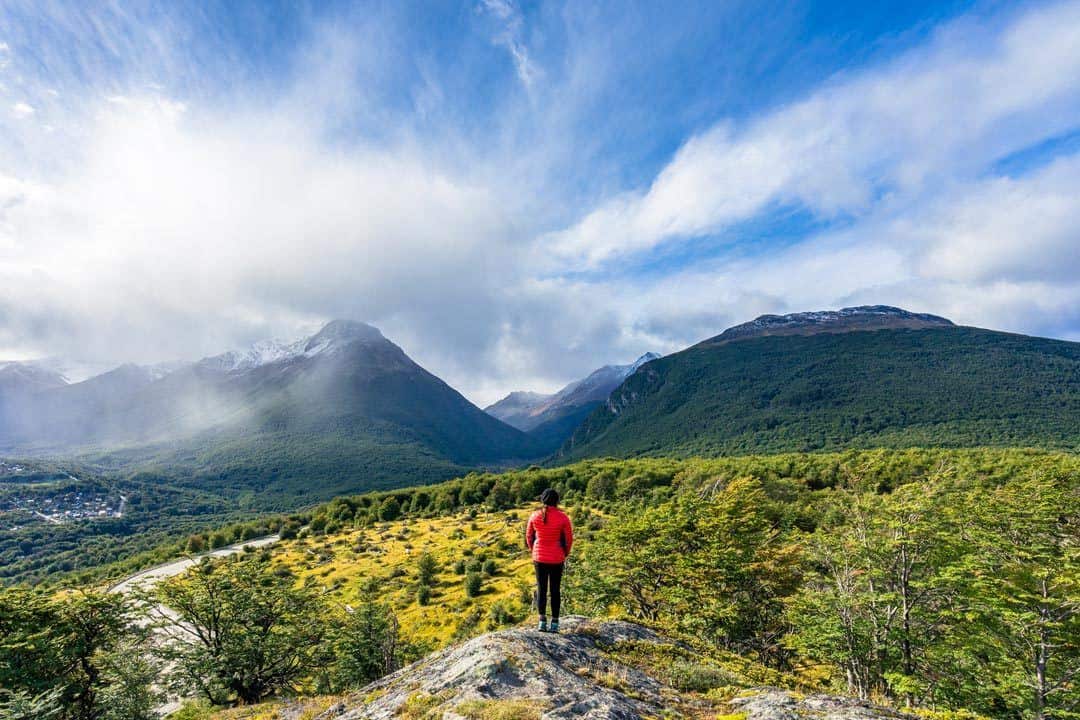
The Best Hikes Along The Carretera Austral
One of the least-visited parts of Patagonia is the long, narrow strip of coastline that makes up the bottom part of Chile.
While most people will make it to Torres del Paine and Puerto Natales , few cross back into the country and continue along the epic highway known as the Carretera Austral.
Public transport is just about non-existent along this long, rugged road, which leaves people to either hitchhike or self-drive between the towns.
When winter comes the place all but shuts down, so that leaves a big part of Chile that not many people see. But that doesn’t mean you shouldn’t check it out!
The Carretera Austral has some insane landscapes and gorgeous mountains and lakes. The coastline is as dramatic as you could imagine, and that all ads up for some amazing hiking!
- Time Required: 4 hours to 2 days (depending on side trips)
- Distance: 8km
- Start / Finish Points: Villa O’Higgins
Patagonia is known for its spectacular glacial landscapes and what better opportunity than to view them by hiking the Laguna Tigre Sur, a moderately difficult hike into some of the most densely populated region of glaciers.
This particular hike is best undertaken with the expertise of a local guide due to it being slightly confusing in regards to finding the correct track to take.
But don’t let that put you off visiting this glaciated area, as Laguna Tigre Sur offers a look into the wilder side of Patagonia, with the odd tricky ridge walk leading you to nearly undiscovered views, glaciers and mountain peaks.
High above the Glaciar Tigre is the Cordon Nevado where chilling winds and extreme temperatures can make things difficult so come prepared for the cold.
There are two side trips to choose from or you can do both with camping spots available. The first side trip leads to the base of the larger Glaciar Tigre Sur where wild flowers thrive in small pockets.
There are a few sections which require the use of your hands to navigate smaller gaps in the larger boulders. At the end of the trail its icebergs galore! Allow 2 hours for this side trip.
The 2 nd side trip continues onto the smaller glacier known as Glaciar Tigre, taking you past large gorges, pristine streams and colourful meadows. Allow 3 hours for this side trip and return the same way you came.
- Time Required: 2 days
- Start / Finish Points: Villa O’Higgins
Similar to what Laguna Tigre Sur provides in terms of glacial views, Valle Rio Moscu is an easy walk generally hiked in 2 days in order to explore a heavily glaciated valley towered by Patagonia’s famous jagged mountain tops.
Hiking at Valle Rio Moscu has a few tricky components such as small stream crossings, best to be taken when the river is low (check with local guides when this is).
The Rio Moscu is a fast-flowing river fed by smaller streams originating from the Cordon de Villa O’Higgins range, while glacial melt from the Ventisquero Rio Moscu contributes an overwhelming amount of water to the raging river.
Ideally it’s best to spend 2 days in the valley as you can explore a spectacular frozen world sitting high in the mountains above.
Camping is available at Refugio Rio Moscu, approximately halfway along the Rio Moscu.
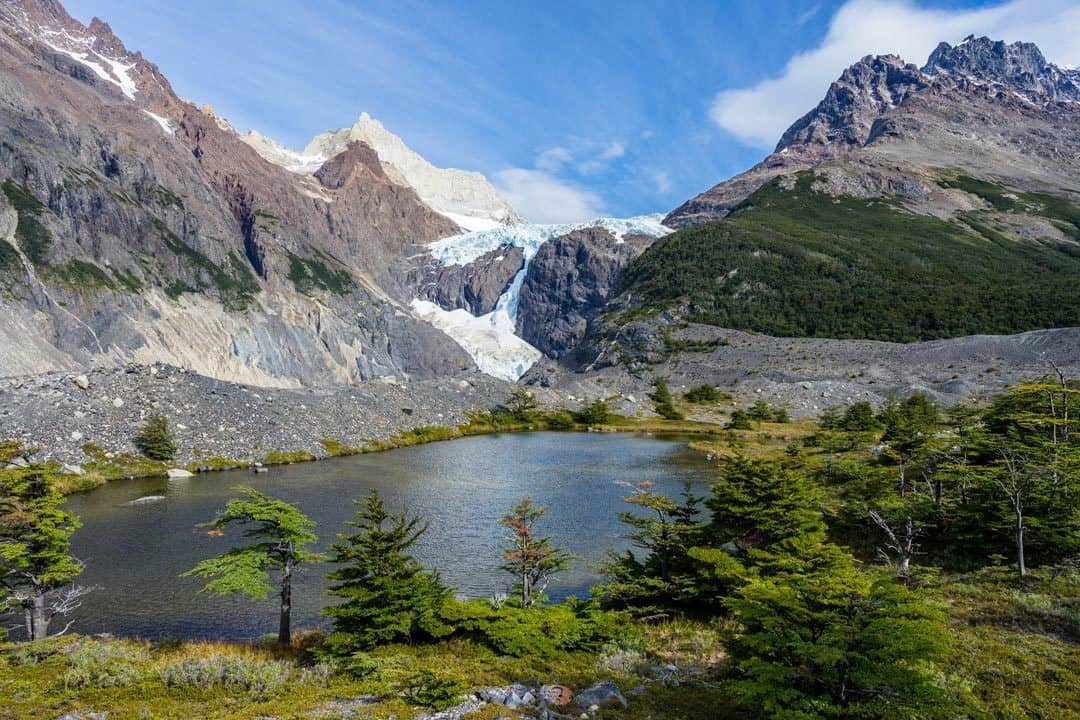
- Days Required: 4 days
- Distance: 62km
- Difficulty: Moderate to demanding
- Start / Finish Points: Las Horquetas Grandes to Villa Cerro Castillo
This 4-day trek will take you through majestic alpine landscapes guaranteed to lead you to plummeting waterfalls, isolated glaciers tucked away into the mountainous backdrops which you will find yourself immersed.
Cerro Castillo is a culmination of everything you think Patagonia is, all jam packed into this one epic Patagonian trek.
It will put you to the test with river crossings in freezing glacial waters, and parts of it needing spot-on navigational skills. Although tracks are well-trodden, they can be impeded by Patagonia’s wild untamed weather.
The whole hike consists of weaving in and out of a valley where mountains range from 1500 metres to a massive 2,675 metres of Cerro Castillo.
Camping is available the whole way along the trek, allowing you to take your time on one of Patagonia’s lesser known hikes which is increasing in popularity.
To gain a different perspective of Cerro Castillo, opt for the side trip into Upper Valle Parada, adding an additional 3 kilometres to your trek, where small lakes such as Laguna Duff remain hidden gems and well worth the extra few hours’ efforts.
The hike finishes at Villa Cerro Castillo, which can be taken by following either the Rio Ibanez or the adjacent path at Morro Rojo peak.
- Days Required: 1 to 2 hours
- Distance: 3.5km
- Start / Finish Points: Caleta Gonzalo
Pumalin Park is one of the world’s most remarkable nature reserves, not just because it is absolutely stunning, but because it would have been wiped off the planet if it wasn’t for a one awesome human being.
Doug Tompkins, the founder of the adventure gear company North Face, bought 400’000 hectares of land that was under threat from logging companies and turned it into a privately-owned by public-accessed park.
He later donated it to the Chilean government under the condition it would continue to be protected. The government agreed, adding more land to it, and today it is South America’s largest national park.
Pumalin Park can be kayaked if you prefer water, as 4 to 10-day kayak trips are available in this stunning part of the world.
However this article is all about hiking in Patagonia, so your best bet is to go for either those shorter hikes taking up to 30 minutes to the more demanding 8-hour plus hikes.
Cascadas is the one to go for as it showcases (as the name suggests) ‘cascading’ waterfalls. You will have to navigate through dense forests and wobbly wooden bridges and ladders before you reach the prize at the end of the trail, being the majestic Cascadas Bajas waterfall.
Camping is available at Rio Gonzalo.
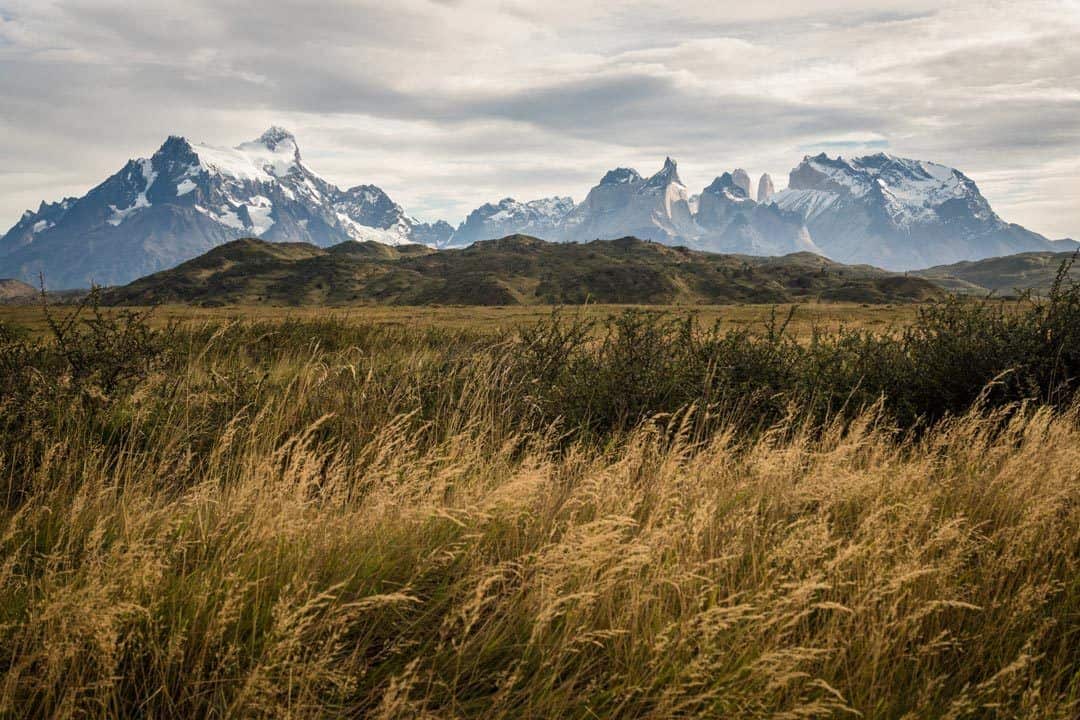
The Ultimate Trekking in Patagonia Packing List
Patagonia is certainly one of the most extreme, potentially harsh climates on earth, therefore it’s necessary to be prepared for all conditions months before you venture to the South American continent.
Hiking gear in Patagonia is quite expensive therefore it’s better to have your gear sorted before you travel to your destination. This packing list for hiking in Patagonia should give you a good idea on what to bring.
- Good quality, lightweight tent. Check out our guide to the best backpacking tents to find one that suits your style and budget.
- Thermal layering including top and pants
- Hiking pants, both long and short, or get convertible pants. These should be waterproof, otherwise get a pair of slip-over waterproof pants as well
- Gore-Tex (waterproof) hiking boots
- Quality backpack for hiking
- Down jacket – these puffy jackets are essential for keeping your torso warm
- Rain and wind jacket – make sure you get a quality jacket that doesn’t leak
- Sleeping bag and silk liner – The warmer the sleeping bag the better
- Cold weather gloves – you will need waterproof gloves aswell as a pair of inner gloves to keep your fingers warm
- Plenty of socks (dry socks are the best)
- A beanie – keeping your head warm is essential
- Hiking poles – if you’re carrying a heavy bag, hiking poles will help you balance. They also provide support for your knees.
- Ability to carry sufficient water (5 litres is ideal)
- Food to last the entire hike. You can pre-order food in some of the refugios in Torres del Paine, but that’s about it. Better to be over-prepared and over-fed then the other way around when hiking.
[box] Have you ever been hiking in Patagonia? Leave a comment below and tell us what your favourite trek was![/box]
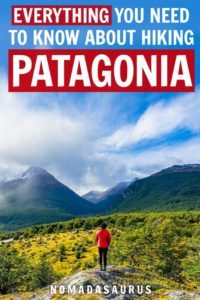
Calumn Hockey
Hi, We’re Alesha and Jarryd!

We’ve been traveling the world together since 2008, searching for the planet’s best destinations and adventures.
Love Travel?
Sign up for our free weekly newsletter for the best travel tips, ideas and deals!
We respect your privacy. Unsubscribe at any time.
READ MORE...
The Ultimate 3 Days in New York City Itinerary (2024 Update)
17 AWESOME Things to Do in Wanaka (Epic 2024 Guide)
The Ultimate Guide to Hiking in New Zealand (2024)
Related Posts
Ushuaia – chilling at the end of the world, altyn arashan in kyrgyzstan – hiking and hot springs, ecoventura ‘itinerary b’ galapagos islands cruise review, rocky mountaineer – celebrating 30 years of life-changing experiences, 18 thoughts on “hiking in patagonia – the ultimate guide to the best treks”.
Happy to read your post. I found your blog is very useful and informative. Thank you for sharing with us.
Actually, I am planning to hike in Patagonia in December. I hope I will have good weather. I loved your article; fascinating and helpful.
Patagonia is such a special place. Hope you get good weather. Even if you don’t it is still so beautiful in the rain or snow. Happy travels
Why you keep lying that Patagonia is chilean? Patagonia is ONLY on the Argentinian side (EAST of Los Andes.
Mt. Fitz has been high on our list since we saw Tommy Caldwell and Alex Honnold do the traverse there. I don’t think we’re up to the standards of the traverse but we’d definitely like to do some hiking around there, looks epic!
Great article guys, thanks!
Glad you enjoyed the article. Hope you get to climb Mt Fitz one day. 🙂
Great work guys, will definitely follow you in instagram, could you recommend some good travel companies who can help me with these hiking circuits, will be a solo traveller.
Hi Basu, thank you so much. We did our hikes through Eco Camp and they were brilliant. They have nice accommodation. We did not go with any other agent. 🙂
Thanks for this comprehensive list of treks near El Chalten. Could you tell me how is the biking scene in the town? I am a cyclist and love to ride in new places I visit. I was planning to take my bike on my trip to El Chalten, but not sure if it will be a good idea.
Glad this article could help. We didn’t go biking ourselves in El Chalten so we can not say about the treks. We are sure there is some in the area. If you contact one of the adventure tour companies they may be able to help. All the best and have a great time.
Fantastic blog! For the short hikes ie. <5 hours, are the trails easy to follow or well marked or do we need to know how to navigate? Thank you!
Thank you so much. Yes the paths are easy to follow and there are signage. You do have to have your own wheels to get to some of the hikes as the tourist shuttle doesn’t go near the beginning of them. Have a great time
This was great! Thanks! I know the answer to this, but I’m going to ask it anyways. Since there are camping spots along the way, are there toilets? Should we buy biodegradable TP for the day hikes?
Hi Sam, there are toilets at the campgrounds. Surprisingly all of them are flush toilets. Toilet paper is provided but always bring your own as the toilets run out. When you are hiking and need to use the bush toilet. Please bury your business and pick up your toilet paper. Thanks
Great Post, looking forward to exploring Patagonia.
Thank you so much
Love your blog 🙂 I wish I had more money to travel, cos nothing is better then collecting memories while traveling.
Thank you so much Miljan. Collecting memories is beautiful
Leave a comment Cancel reply
Save my name, email, and website in this browser for the next time I comment.
12 unmissable hikes in Patagonia: wonder at the pristine wilderness
Nov 16, 2021 • 10 min read
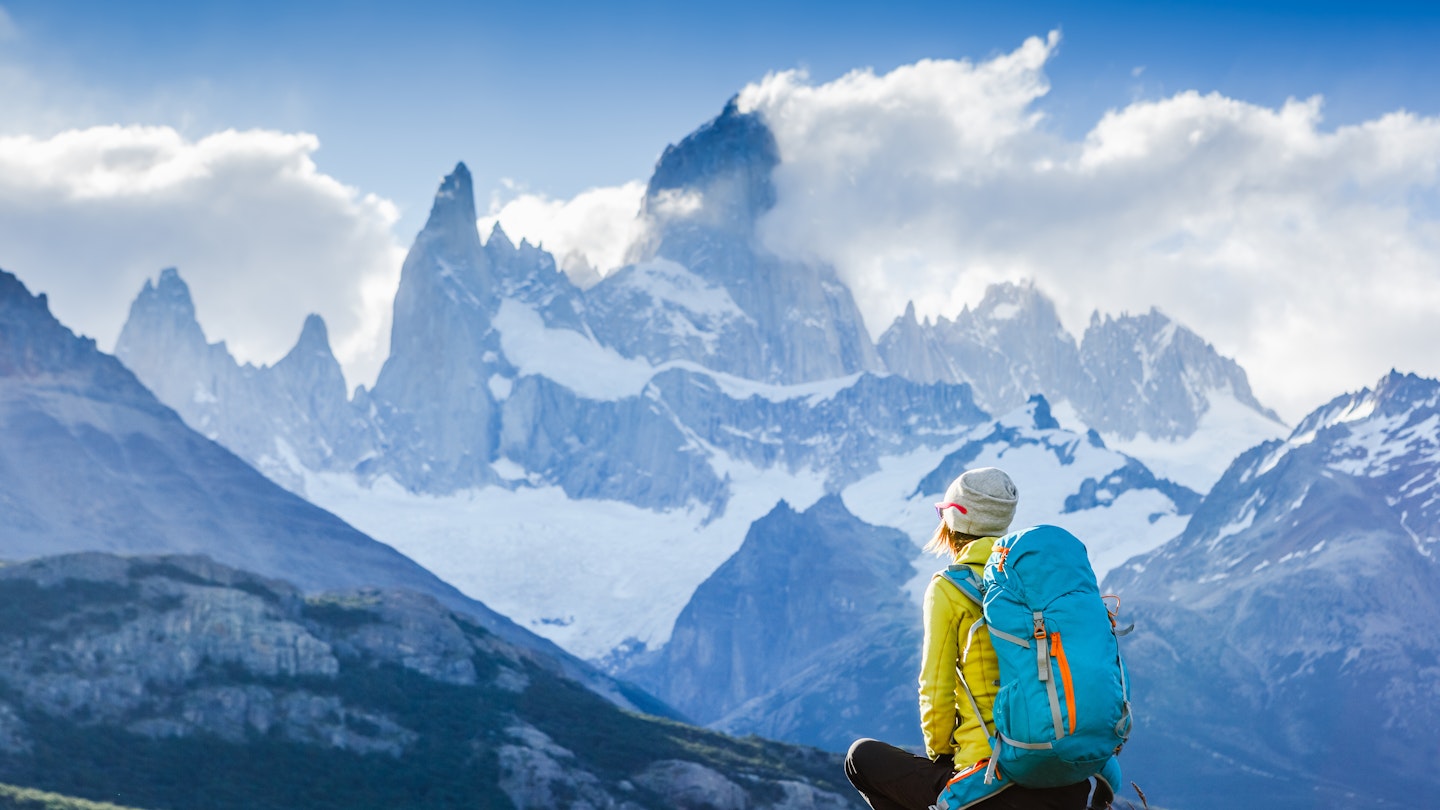
From short walks to multi-day treks, there are many inspiring hikes to choose from in Patagonia © Olga Danylenko / Shutterstock
The name “Patagonia” typically conjures up visions of endless pampas (grasslands) and southern cowboys, but there is so much more to the region than that. Covering a massive chunk of southern Chile and Argentina , this unique 402,734 sq mile region is a patchwork of diverse terrains and microclimates that challenges and surprises hikers of all abilities.
Criss-crossed by glacial rivers and streams, alternately covered in scrubland and ancient woodland, and dotted with myriad ice-melt lakes ranging from pale blue to navy, Patagonia bristles with mountain ranges (particularly on the Chilean side) and glitters with glaciers. Whether you’re looking to rough it on multi-day treks through pristine wilderness, hike from hut to hut in epic national parks , exert yourself on varied day treks before returning to the comfort of your boutique guesthouse, or just stretch your legs beneath the shade of Chile’s and Argentina’s oldest trees while road-tripping along Chile’s Carretera Austral , Patagonia has a great deal to offer.
Trekking in Patagonia and Tierra Del Fuego (included in this list of hikes) is largely confined to the peak and shoulder seasons of November to late March. If hiking off the beaten track, make sure someone knows your proposed route, take a tent sturdy enough to withstand the famous Patagonian wind – La Escoba de Dios (God’s Broom) – and all the supplies you’ll need . During any hike, all-weather gear is a must (since you may experience four seasons in one day!). Accommodations must be booked many weeks in advance for the December to February high season.
Here are 12 of the region's very best hikes.

The "W", Torres del Paine National Park (Chile)
Best overnight hike
46 miles (74km) one way, 3–5 days, moderate
The shorter of the two multi-day treks that Chile’s iconic Torres del Paine National Park is known for, this trail is shaped like the letter "W" (hence the name). You take a boat across Lake Pehoé, hike through woodland along the banks of Lake Grey to the icy monolith of Glacier Grey before retracing your steps. You then pass along the shores of glacial Lake Nordenskjold, and climb steeply up the French Valley for an up-close look at Los Cuernos – the park’s bell-shaped mountain range. A final stint through scrubland, across hills and up the Ascencio river valley brings you to the trident peaks of Las Torres. You can either camp en route at designated campsites, go from refugio (bunk hut) to refugio , or even glamp along the way. Due to Torres del Paine’s immense popularity, all accommodations and camping spots have to be pre-booked months in advance. The "W" is best hiked west to east if you’re camping, so that you’ll have used up most supplies before tackling the steep ascent to the granite towers.
Laguna de Los Tres, Parque Nacional Los Glaciares (Argentina)
Most scenic and most challenging
15.5 miles (25km) round trip, 8–10 hours, moderate
Only accessible on less windy days, this is the most scenic and challenging of all the day hikes around southern Argentina’s compact trekking capital of El Chaltén . The well-marked trail ascends through ñire (small southern beech) woodlands from the north end of El Chaltén’s main street, past the turquoise Laguna Capri, and across boggy terrain to Camapamento Poincenot, popular with climbers. A steep, exposed trail zigzags up the mountain side to the glacial lagoon, where you get excellent bonus views of Cerro Fitz Roy (11171ft/3405m) – the mountain resembling a jagged tooth. Dip your feet in the water and see how quickly they lose all feeling!
Lagunas Altas Trail, Parque Nacional Patagonia (Chile)
Easiest to access
14.2 miles (23km) loop, 8 hours, moderate
The most easily accessible trail in Parque Nacional Patagonia , due to its location near the entrance to the park this invigorating leg-stretcher is stupendously scenic. Climbing a forested ridge from the Westwind Campsite near the visitors center, the trail passes several tiny glacial meltwater lakes as you cross open terrain. You’ll find that your jaw drops open more than once during the hike at the all-encompassing views of the northern Patagonian ice field, Chacabuco Valley and the Jeinimeni Mountains en route.
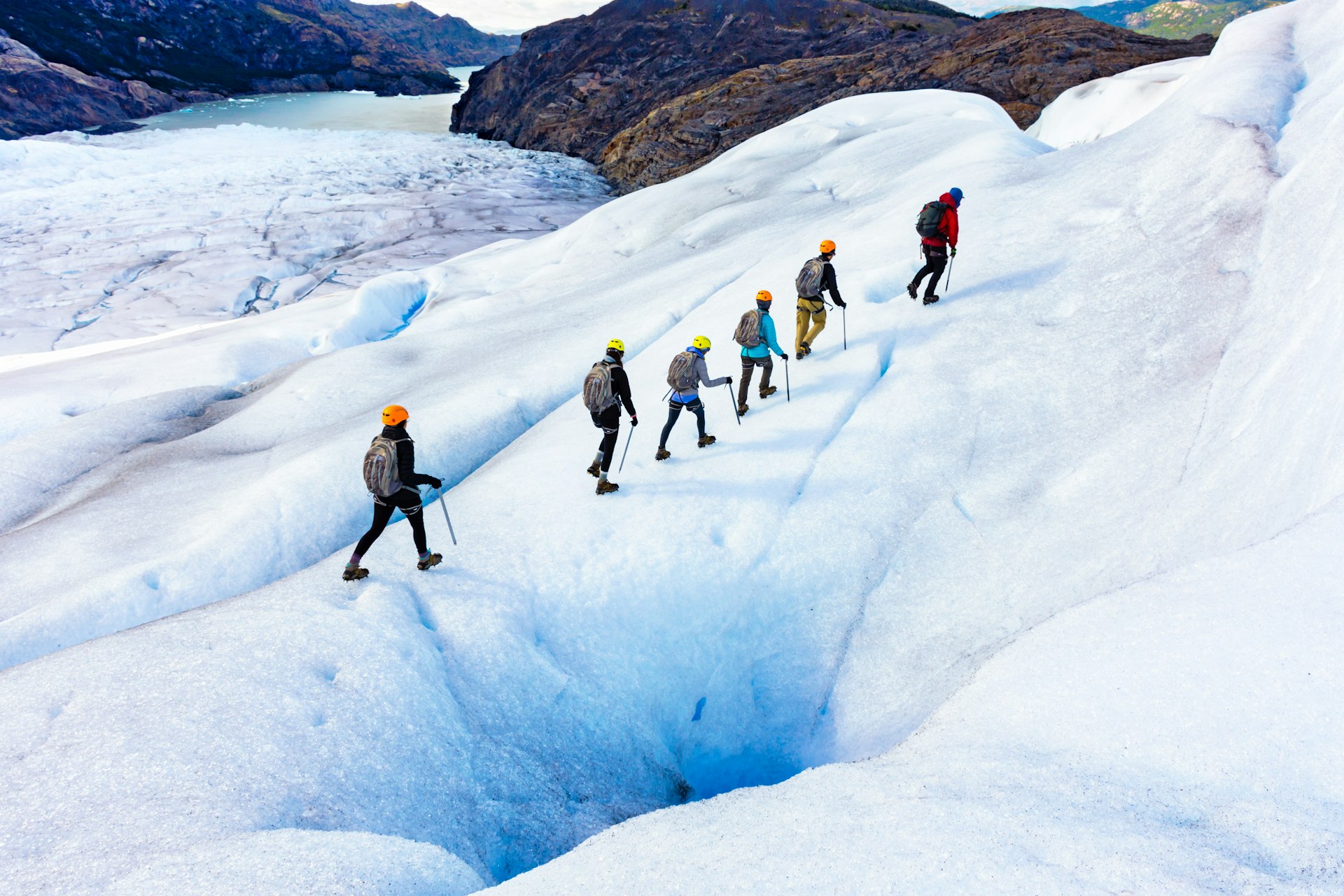
The "Circuit", Torres del Paine National Park (Chile)
Best long-distance trek
68 miles (110km) loop, 6–10 days, moderate
If you have more time to spare, hike the loop-shaped Circuit, the longest trek in Torres del Paine, trekked in a clockwise direction. Incorporating the "W", this spectacular loop gives you unique views of the backs of Los Cuernos and Las Torres – the park’s two mountain ranges – from remote back country. The terrain is never boring, as you climb partially-forested hills en route from the Serón campsite to the Dickson campsite and refugio , enjoying views of Lake Paine and Lake Dickson along the way, and taking boardwalks across boggy sections. This first half of the hike is where you’re most likely to come face to face with one of the park’s many mountain lions.
From Refugio Dickson, you enter dense southern forest with its thickets of giant wild rhubarb and ferns, with glimpses of waterfalls through the trees. The highest and most challenging part of the trek is the weather-dependent crossing of the John Gardner Pass (4002ft/1220m) between the Los Perros Campsite and Refugio Grey. Once you reach the top, the Glacier Grey icefield opens up below you like a vast, frozen river. As with the "W", you can either camp all the way, or go from refugio to refugio .
Los Alerces Trail, Parque Nacional Pumalín Douglas R. Tompkins (Chile)
Best easy hike
0.5 mile (700m) loop, 30 minutes, easy
Alerce trees are the giants of Patagonia. Growing up to 148ft (45m) in height and living for up to 3000 years, and used for making southern Chile’s unique shingled roof tiles, they were cut down almost to extinction by colonists in the late 19th and early 20th centuries and now have protected status. Off the Carretera Austral, some 7.7 miles (12.5km) south of the Caleta Gonzalo car ferry landing, this wonderful interpretive trail passes through a particularly impressive grove of these millennia-old skyscrapers of the forest.

Laguna Torre, Parque Nacional Los Glaciares (Argentina)
Best hike with icebergs and glaciers
13.6 miles (22km) roundtrip, 6–8 hours, moderate
Another excellent day hike from El Chaltén, this trail takes you from the south of town through the Fitz Roy river valley. Passing a small hydroelectric station, you climb through lenga and ñire woods to reach the Mirador Laguna Torre, with views of glaciers beneath the Adela mountain range, Cerro Torre, Mt Fitz Roy and the granite "needles" popular with rock climbers. Crossing an alluvial plain bisected by the glacial Fitz Roy river, you pass the partially sheltered De Agostini campsite before skirting the iceberg-filled Laguna Torre to reach Mirador Maestri, overlooking the Grande glacier.
Laguna de Los Témpanos, Parque Nacional Queulat (Chile)
Best hike in Parque Nacional Queulat
1.2 miles (2km) return, 1 hour, easy
If you do just one hike in Parque Nacional Queulat , off Chile’s Carretera Austral in northern Patagonia, make it this one. From the main car park, after crossing the hanging bridge high above the raging Ventisquero river, you may have to brave the perpetual rain. Expect to beslapped in the face with moisture-laden ferns as you make your way through dense forest and damp undergrowth along this straightforward trail to a splendid glacial lagoon – but it’s well worth it. From the banks of the lagoon, you get uninterrupted views of the Ventisquero Colgante – a hanging glacier across the lagoon, filled with car-sized chunks of calved ice. The frequently inclement weather, and the park’s remoteness, means you’re likely to have it all to yourself.
Volcan Chaitén Crater Trail, Parque Nacional Pumalín Douglas R. Tompkins (Chile)
Best all-encompassing view
2.7 miles (4.4km) round trip, 3 hours, moderate
In 2008, the eponymous volcano in northern Patagonia staged a surprise eruption and buried half the town of Chaitén under mud and ash. This relatively steep five-hour round-trip trek starts near Puente Los Gigos, off the Carretera Austral, north of the now-rebuilt town. Following the eruption path of the volcano, the trail gets progressively more barren the higher you get. Your reward at the top is the all-encompassing view of the still-smoking crater and the surrounding forest.
Dientes de Navarino Circuit, Navarino Island (Chile)
Best demanding trek
33.2 mile (53.5km) loop, 4–5 days, difficult
On Chile’s southernmost permanently inhabited territory (across the Beagle Channel from Tierra del Fuego), this demanding trail loops around the jagged pinnacles of the Dientes de Navarino mountain range. Requiring camping wild and excellent navigation skills, it’s best done in a clockwise direction with at least one other companion. The trail cuts across bare stony plateaux, skirts glacial lakes, traverses boggy lowlands, and crosses exposed mountain passes, with highlights including expansive views of the Beagle Channel from Cerro Bandera and Paso Virginia (near the beginning and end of the trek, respectively). Watch your footing on the steep, rapid descent from the latter pass.
Lago del Desierto – Chile trail (Argentina/Chile)
Best hike that crosses an international border
12.4 miles (20km) one way, 6–8 hours, moderate
In recent years, this cross-border trail connecting tiny El Chaltén in southern Argentina to Chile’s equally tiny Villa O’Higgins has gained in popularity with adventurous hikers (and cyclists). Best done from Argentina to Chile (as that avoids a relentless uphill slog), it involves taking a boat across the pristine Lago del Desierto, some 23 miles (37km) north of El Chaltén, getting stamped out at the Argentine border post, then trekking through hilly, dense woodland until you reach the sign welcoming you to Chile, where the narrow trail becomes a broad, forest-fringed gravel road. It then winds its way down to Lago O’Higgins, to the tiny border post of Candelario Mancilla. From here, you have to catch another ferry across Lake O’Higgins/San Martin. During high season, when ferries across both lakes are more frequent, you can time the hike so that it’s doable in a day; otherwise you may have to camp at one or both border posts.
Avilés Trail, Parque Nacional Patagonia (Chile)
Best hike for camping wild
29 miles (47km) one way, 3–4 days, difficult
Connecting the eponymous forest lake in the Reserva Nacional Lago Jeinimeni (accessed from Chile Chico) with the Casa Piedra campsite in the scenic Avilés Valley in Parque Nacional Patagonia further south, this is a serious off-the-beaten-track endeavor that requires organizing transfers to and from the trailheads in advance and ample wilderness trekking experience. While the terrain is only moderately demanding, the trail through the valley is rudimentary and minimally marked, there are multiple river crossings and you have to camp wild, bringing all your supplies with you.
Cabo Froward (Chile)
Most remote
45.3 miles (73km) round trip, 4 days, difficult
The goal of this adventurous hike is to reach Cape Froward – the southernmost mainland point on the continent of South America. Starting at the trailhead some 56 miles (90km) south of Punta Arenas , the trail mostly hugs the coast, meandering along wind-battered cliffs, traversing boggy undergrowth, and passing the San Isidro lighthouse. Unless you’re an experienced wayfarer, it’s best to join a guided hike with Erratic Rock from Puerto Natales , as the trek involves fording narrow, deep rivers at low tide and camping wild. The trail isn’t well-marked in places.
You might also like: Chile's best hikes and treks through extraordinary landscapes The best hikes in Argentina: from ice fields to rainforest trails I went on a solo trip to Patagonia (and I loved it)
This article was first published April 2014 and updated November 2021
Explore related stories

Jan 8, 2024 • 11 min read
From Andean treks to whale watching off Patagonia, here are the top things to do in Argentina.

Feb 8, 2023 • 4 min read
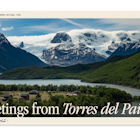
Feb 7, 2023 • 5 min read
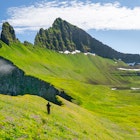
Dec 6, 2022 • 10 min read
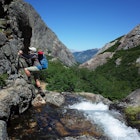
Nov 28, 2022 • 6 min read
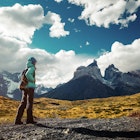
Oct 5, 2022 • 6 min read
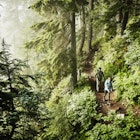
Jul 29, 2022 • 15 min read

Dec 13, 2021 • 11 min read
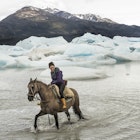
Dec 3, 2021 • 10 min read
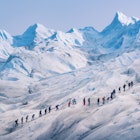
Oct 28, 2021 • 6 min read

The 15 Best Hikes in Patagonia You Can Do Without a Guide
By Author Steph Dyson
Posted on Last updated: 17th January 2024
Home to the final, southernmost stretch of the Andes Mountains as they plunge into the Pacific Ocean, Patagonia is a remarkable place for hiking, particularly if you like wild terrain and scenery.
Some of South America’s most superlatively beautiful hiking trails crisscross this land of wind-pummelled grasslands, clusters of evergreen forests blasted by the elements, and sky-piercing mountains, many weighed down with glaciers of the deepest hues of blue.
If the promise of this scenery isn’t enough to get you packing your rucksack and out onto the trail, then I don’t know what will. But trust me: Patagonia is a paradise for hikers, with day and multi-day treks that will leave you wishing you could extend your trip indefinitely.
I’ve spent months exploring the wildernesses of Chilean and Argentine Patagonia and this list comes from mostly personal experience (although I’ll admit I’ve snuck a couple in that I haven’t had the chance to do – yet).
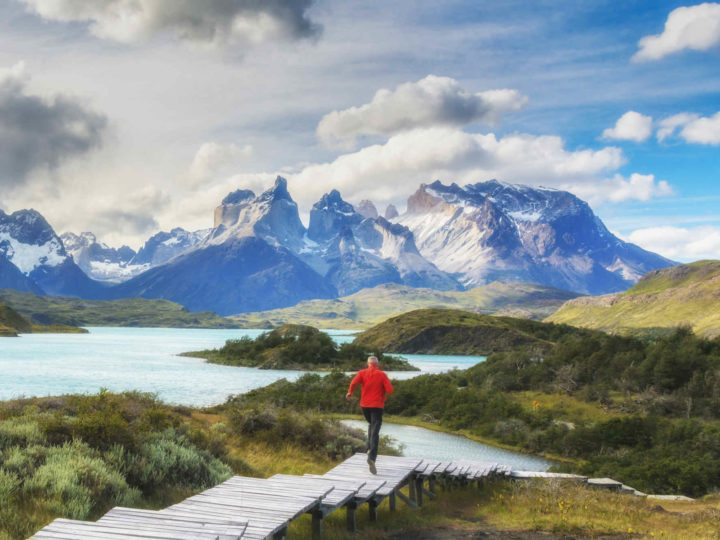
Join me on a jaunt around the region, with these fifteen of the best hikes in Patagonia.
Click to navigate this article:
A note about equipment for hiking in Patagonia
Patagonia is a rugged, remote, and untamed part of the world. Because of this, decent quality hiking gear, including hiking boots that you have worn on at least a few trails beforehand, is essential.
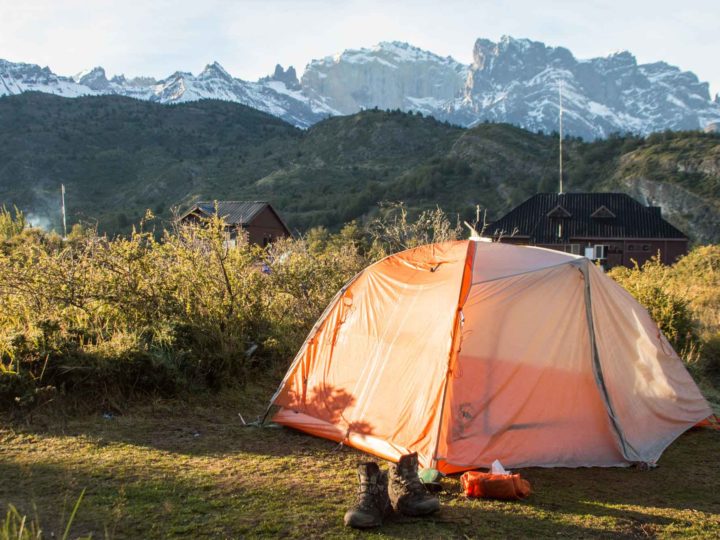
A day or larger pack , weather-appropriate clothing, and, if you’re staying overnight, a high-quality, lightweight tent and three-season sleeping bag will keep you safe and happy on these hikes.
Camping in Patagonia is all part of the adventure and I definitely recommend that you build it into your trip; camping out in a remote place, far from civilization in the very far south of the planet is quite the experience.
While you can hike these Patagonian trails without a guide, I have listed companies that do offer guide services, and who will likely provide camping and cooking equipment (or meals) where required.
A lot of these hikes have fresh water along the trail, however, I recommend bringing water purification tablets or some backpack-friendly water filtration system (such as a Sawyer filter, Grayl Geopress, or Steripen – read our review of the latter ).
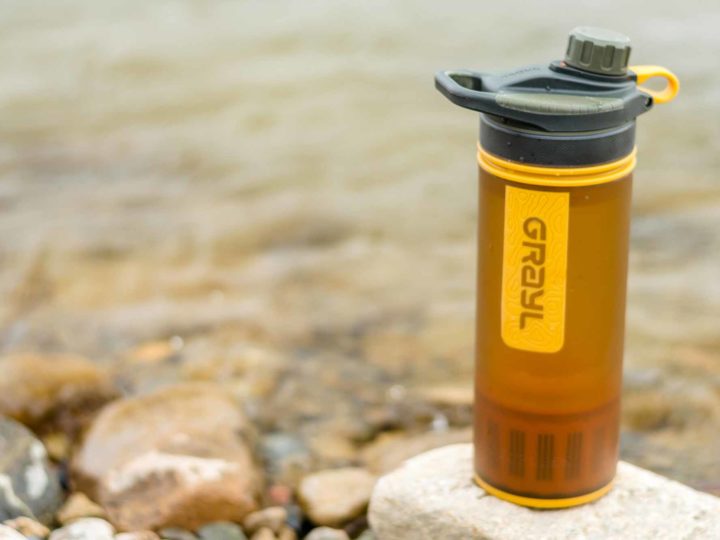
Some hikes require camping and cooking equipment, as well as carrying several days’ worth of rations.
If this is your first time packing for a hiking vacation, be sure to read our guide to what to pack for Patagonia .
I’m a huge advocate of packing light, and this list covers everything from hiking clothing and boots to camping equipment, and other day-to-day gear that will make your life on the trail markedly easier and more comfortable.
You can also find detailed descriptions of all these hikes in Patagonia in Moon Chile , a guidebook I spent two years working on.
For detailed descriptions of the longer treks, check out the Lonely Planet Trekking in the Patagonian Andes book (although don’t both if you’re in the UK – it’s insanely expensive there for some reason but you can find cheap used copies to buy on other websites!).
Planning Your Trip to Patagonia?
Save time, stress & money with a customized travel itinerary planned for you by a Patagonia expert
What previous clients have said:
“Steph’s itinerary exceeded all expectations. She provided off-the-beaten-path hikes, great restaurants and accommodations, and very helpful local contacts. Due to the weather we had to deviate from our original plan, however Steph quickly responded to our email during the trip with further recommendations. Her service took all the guesswork out of planning our vacation and led to the most fun and unforgettable trip we have ever had!”
When is the best time to hike in Patagonia?
The main season for visiting Patagonia is October through April. This is because of the weather, which can see snow and other inclement weather during the rest of the year. It’s also not advised to visit outside of these months because many hotels, tour operators, and national parks close.
The best time to hike in Patagonia is any time between October and April, although December through February is the high season for travel, so you’ll find trails busy and prices high.
The months of December, January, and February in Patagonia have the warmest temperatures, which hover around 15˚C (59˚F) and the days are long, with daylight lasting up to 17 hours. However, wind levels are high and can reach up to 190 kilometers per hour (120 miles p/h).
I always recommend visiting Patagonia in the fall months of March and April , when the landscapes turn a beautiful orange and red and temperatures hover around a mild 10˚C (50˚F) during the day – although they do drop below freezing at night. It’s a lot less windy than in summer, and there are also fewer visitors to Patagonia.
Another alternative is spring and the months of October and November. Patagonia during these months sees daytime temperatures of around 10˚C (50˚F) and winds are less fierce than in the summer, although they can be biting and, combined with overcast days, can lead to cold hiking conditions.
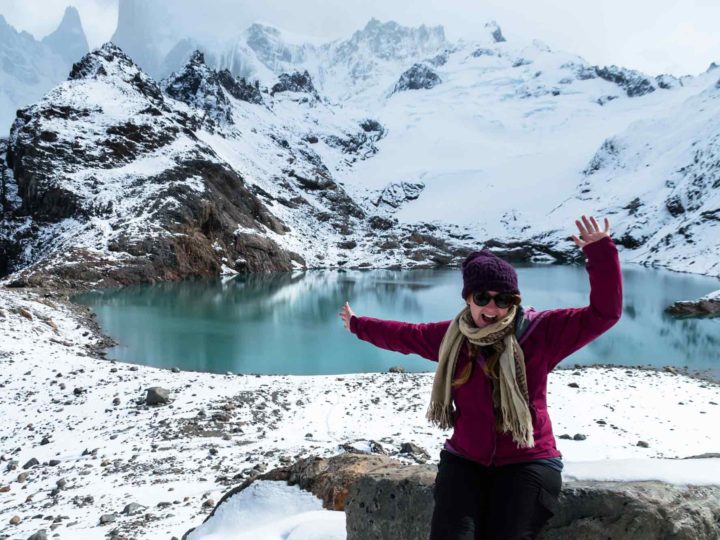
During winter, the region practically shuts down and heavy rain and snowfall close trails and even roads. Some destinations such as Torres del Paine are supposed to be spectacular, but you will need to go with a guide as entry is prohibited unless with a tour.
I re-visited Torres del Paine National Park in September and found that while the weather is cold – dropping well below freezing at night – it’s actually more settled than during summer, with lower wind speeds and, more often than not, bluebird skies.
Be aware that whenever you visit Patagonia, the chance of experiencing four seasons in a day – sun, rain, hail, and snow – is high and you’ll want to come prepared for every eventuality.
Best hikes in northern Chilean Patagonia (the Carretera Austral)
1. volcán chaitén, pumalín national park.
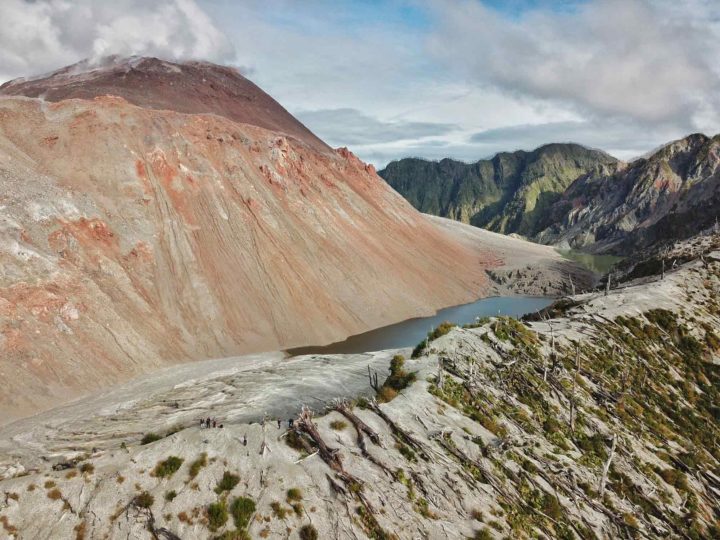
- Duration: 4.5 kilometers (2.7 miles); 3 hours.
- Best time to go: Conditions for hiking are best between October and April, although the park is at its busiest between mid-December and February
- Difficulty: Medium
- Highest point reached: Unknown. Elevation gain of 625 meters (2,050 feet)
- Starting point: The trailhead lies 24 kilometers (15 miles) north of Chaitén
- Ending point: Same as starting point
- Must-have gear: The trail is steep and the path strewn with rocky boulders, including smaller lumps of glassy obsidian and pumice stones that were hurled out of the volcano when it erupted, so hiking poles are recommended. Bring plenty of water as there is none available on the trail.
- Do I need a guide? No. The trailhead is well-marked and the path is clear to follow. Your biggest issue is getting there from Chaitén as there is no public transport. Hitchhiking or joining a very affordable tour operated by Chaitur Excursiones is the easiest means of reaching the park
- Cost: Free
- Useful information: The national park has a comprehensive website , complete with trekking information for the Volcán Chaitén hike .
- Map: OpenStreetMap
Volcano climbing is an activity that you can’t miss if you spend time in Chilean Patagonia. While Volcán Villarrica further north is perhaps the country’s most famous, Volcán Chaitén on the northern tip of Patagonia is equally impressive and the path up to the crater of this volcano easily ranks as one of the best day hikes in Patagonia, if not South America.
What’s more, the trail itself is short and sweet – if a steep climb. But, as you emerge out of the top of a grove of charred tree trunks (the debris left after the volcano erupted, when lahars of mud and ash blanketed the surroundings), the 45-minute ascent is more than worth it.
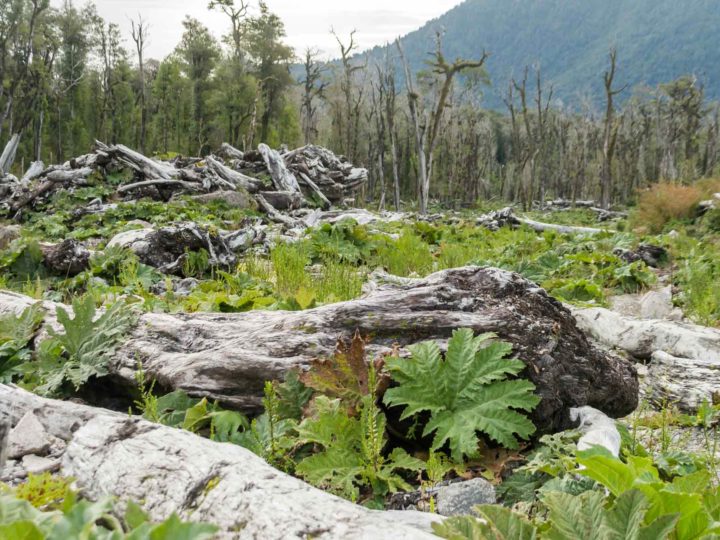
From the very top of the trail, you can appreciate the vastness of the volcano, and find yourself standing on the lip of its 3.5-kilometer (2-mile) crater.
As you do, keep an eye on the volcano itself. It’s still active, although currently offering nothing more dangerous than a tower of smoke puffing lazily from the top.
Other hikes in Pumalín National Park: the easy Sendero Alerces (0.7 km, 40 mins) is a beautiful short walk through protected alerce trees, while the medium Sendero Cascadas (5.6 km, 3 hrs) and Sendero Cascadas Escondidas (1.8 km, 2 hrs) reach some of the park’s most beautiful waterfalls. The hard Sendero Tronador (5 km, 4 hrs) and Sendero Volcán Michinmahuida (24 km, 8-10 hrs), the latter of which includes views of the snow-covered Michinmahuida Volcano, are also worth exploring.
2. Piedra del Aguila, Futaleufú
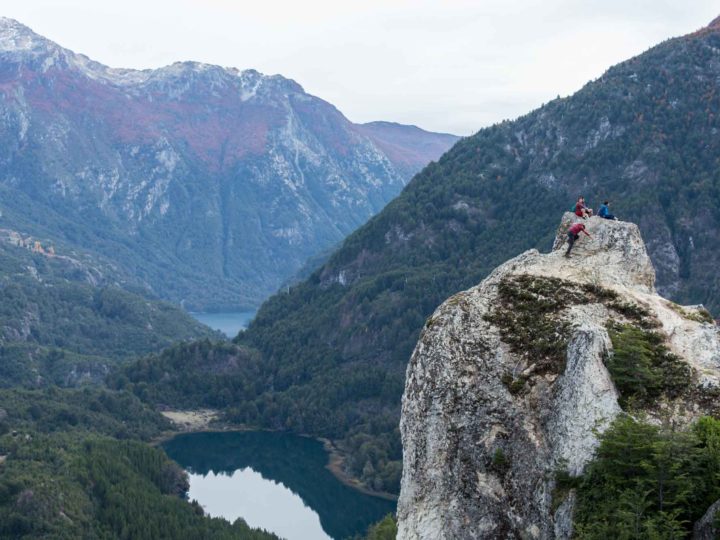
- Duration: 12 kilometers (7.5 miles); 2.5 hours
- Best time to go: Futaleufú is at its prettiest in the spring (October through mid-December) for wildflowers or fall (March-April) for the autumnal colors. Note that if you want to combine hiking with rating, the best season for the latter is November through March
- Difficulty: Easy; the ascent is gentle and on a gravel road
- Highest point reached: Unknown; the elevation gain is 420 meters (1,380 feet)
- Starting point: The center of Futaleufú
- Must-have gear: Take water or a water filter for filling up from the river and extra layers for the top of the rock where it can be cooler and windy
- Do I need a guide? No
- Cost: Access is through private land, so if you see the owner, you’ll need to pay $1,000 CLP ($1.2 USD)
- Useful information: N/A
Futaleufú might be better known as one of South America’s prime white-water rafting spots, but with the town in a picturesque river basin lined by forested mountains, there’s plenty to keep you busy on your own two feet.
Lying a few kilometers out of town, the Sendero Piedra del Aguila is an easy tramp up a gravel road to reach Eagle’s Rock, a jutting, 40-meter high lump of granite that grants sweeping views east across the valley towards two picturesque Alpine lakes.
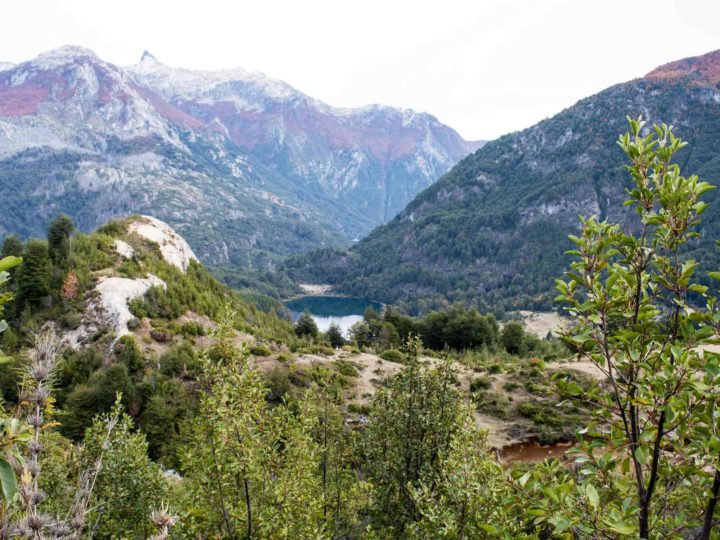
It’s not the wildest of Patagonian scenery, but it’s an easy introduction to hiking in the region.
3. Sendero Mirador del Ventisquero (Glacier Viewpoint Trail), Queulat National Park
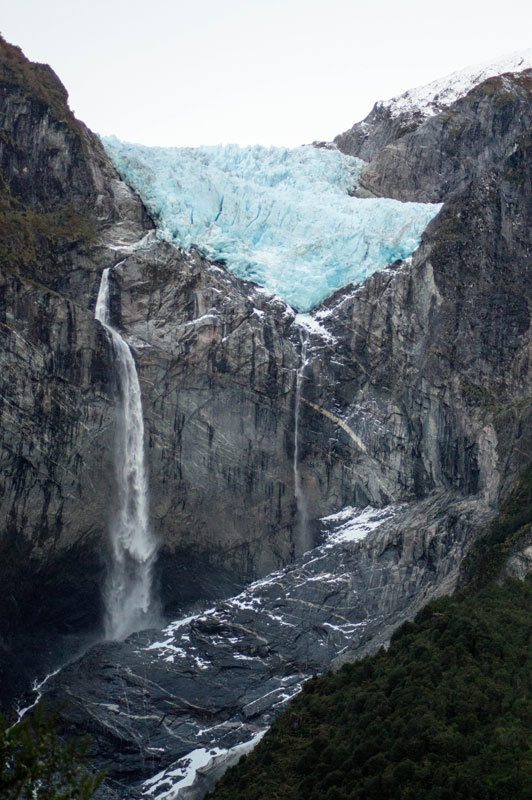
- Duration: 6.5 kilometers (4 miles); 2.5 hours
- Best time to go: This part of the Carretera Austral is best visited between October and April; outside of these months, snowfall can make the roads challenging and can close hiking trails
- Difficulty: Medium; the trail climbs continually to reach the viewpoint
- Highest point reached: Unknown; elevation gain of 305 meters (1,000 feet)
- Starting point: The ranger station at the entrance to Queulat National Park. To reach here, you can either hitchhike from Puyuhuapi or organize bikes through Turismo Experiencia Austral (who used to also operate minibusses but it’s not clear if that’s still an option)
- Ending point: Same as the starting point
- Must-have gear: A good quality Gore-Tex jacket as this part of the Carretera Austral is known for its heavy rainfall. The path can also be very slippery, so hiking boots with decent tread are essential
- Do I need a guide? No. The trail is well-marked
- Cost: $8,500 CLP ($10 USD) entry into the park
- Useful information: The national park has some basic information here
Wedged onto the cliff face high above a milk-blue lagoon, this glacier is one of the most magnificent in all of Patagonia, thanks to its magnificent colors and gush of meltwater that keeps the scene in motion.
One of the most iconic sights along the Carretera Austral is the egg-blue ice of the Ventisquero Colgante, the Queulat Hanging Glacier.
The light is better in the late afternoon, but, if you’re camping in the national park, you can take the short – if steep – trail, climbing through Valdivian temperate rainforest dripping with moss – at any time of the day.
Covid-19 update: You MUST make a reservation in order to visit the park. You can do this on this website , but you will need to pay in cash (bring small notes) upon arrival. You can only enter the park between 9:00am and 14:30pm (you can stay within the park until 16.30pm) and you must bring your reservation code on your phone or printed off to show at the park entrance.
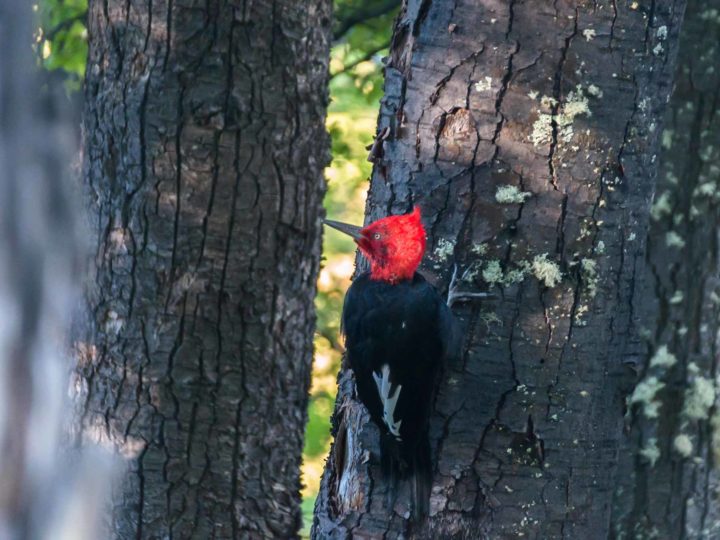
Watching the dazzling blue ice crumbling in noisy avalanches from the glacier’s snout is a sight you’ll want to absorb for as long as possible.
Other hikes in Queulat National Park: The easy Sendero El Aluvión (1 km, 30 mins) and Sendero Laguna Témpanos (1.2 km, 30 mins, easy) are also worth exploring (get information here ).
4. Cerro Castillo Traverse, Cerro Castillo National Park
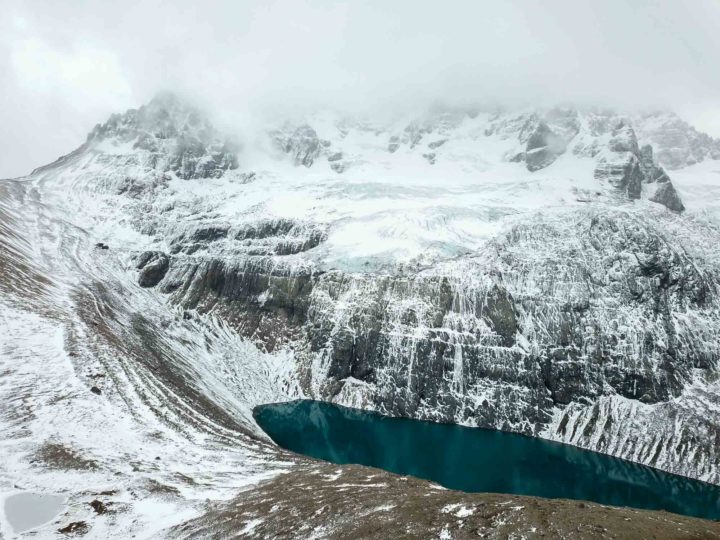
- Duration: 51 kilometers (32 miles); five days
- Best time to go: The best time to hike in the park is January through March when wind speeds drop and the weather is mostly stable; the other recommended months are between November and December and April, although snowfall is possible during these periods
- Difficulty: Medium/hard
- Highest point reached: 1,300 meters (4,265 feet) at Paso El Peñón (El Peñón Pass)
- Starting point: The Las Horquetas entrance to the park, 30 kilometers (19 miles) north of Villa Cerro Castillo along the Carretera Austral
- Ending point: TheEstero Parada entrance to the park, 7 kilometers (4.3 miles) west of Villa Cerro Castillo
- Must-have gear: A sturdy tent that can withstand high winds and a waterproof jacket and pants that can do the same. Winds at the Paso El Peñón can be fierce
- Do I need a guide? No, but you do need some experience in backcountry hiking and being able to follow a trail, while accidents have occurred in the park when hikers were unprepared for the weather conditions. You must register with the park rangers when you pay your entry fee, as well as on your way out of the trail.
- Cost: $29,000 CLP ($35 USD) park entry; local company Senderos Patagonia run 5D/4N tours of the trail, including food and English-speaking guides starting from $1,350 USD
- Useful information: The national park has an excellent website that provides plenty of detail about the trail and how to prepare for it
- Map: OpenStreetMap and the national park website
Torres del Paine National Park in southern Chilean Patagonia might have captured most visitors’ imaginations, but if you’re looking for a trail that promises outstanding mountain scenery and just a small fraction of the visitor numbers, there’s a new national park in town: Cerro Castillo.
Its cornerstone trail is the Cerro Castillo Traverse (or Travesía Las Horquetas), a challenging trek through exposed mountain passes where the rewards are delivered in the form of panoramic views of glacier-studded peaks.
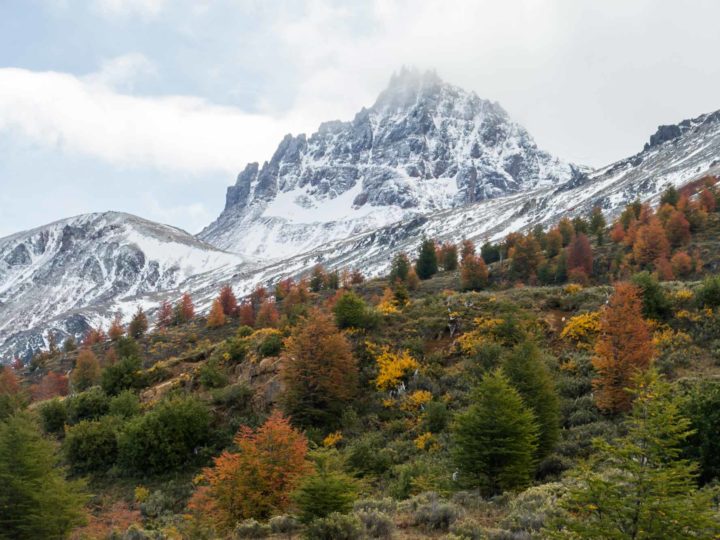
The most famous is the park’s namesake, Cerro Castillo, christened as such for its castle-like shape – and which looks, if only teeny bit, like the three granite prongs of Torres del Paine, situated, as it is, above a magnificent cobalt blue lagoon.
This hike combines pristine backcountry scenery of glittering lakes and gleaming glaciers, untechnical hiking, and few other hikers, making it a truly outstanding multi-day trek in Patagonia.
Other hikes in the national park: The challenging Sendero Mirador Laguna Cerro (14 km, 6-8 hrs) is a great day hike up to Laguna Cerro from where you can appreciate the castle-shaped peak. Information about it here .
5. Jeinimeni-Avilés Traverse, Sector Jeinimeni, Patagonia National Park
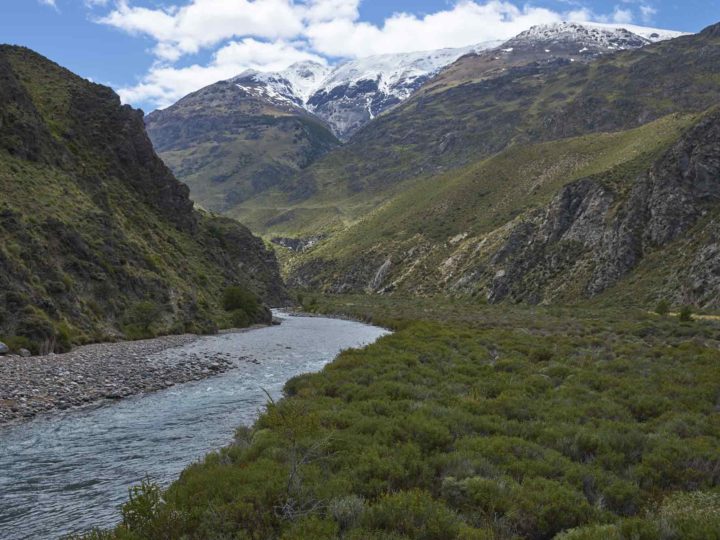
- Duration: 50 kilometers (31 miles); 3-4 days
- Best time to go: The trail is only passable between October and April due to snowfall and adverse weather conditions
- Difficulty: Hard
- Highest point reached: Unknown; elevation gain 1,084 meters (3,556 feet)
- Starting point: Laguna Jeinimeni in Sector Jeinimeni of the park
- Ending point: Stone House Campground in Sector Valle Chacabuco of the park; from here, it’s a further 26 kilometers (16 miles) to reach Los West Winds and the visitor center; you may be able to hitchhike with day visitors traveling this road
- Must-have gear: Light-weight camping and cooking gear, as well as sturdy hiking boots . A waterproof and windproof jacket , as well as plenty of layers for cold nights , are also essential. A water filter will allow you to safely drink water on the trail. A GPS or maps downloaded to your phone are also recommended
- Do I need a guide? You should only attempt this trail if you have extensive backcountry hiking experience, as the trail is remote and you are far away from help. River crossings are also necessary. Patagonia Xpress can potentially organize a guided trip
- Cost: Transport to the trailhead will cost $15,000 CLP p/p ($18 USD); camping at Valle Hermoso in Sector Jeinimeni costs $10,000 CLP ($12 USD) and at Stone House Campground costs $8,000 CLP ($10 USD). A taxi from here to Cochrane will cost $25,000 CLP ($30 USD)-$50,000 CLP ($61 USD), although in high season it may be possible to hitchhike
- Useful information: The national park has information about this trail on their website
Patagonia doesn’t get much more incredible than in the remote wildernesses of Patagonia National Park, one of Chile’s flagship new protected areas.
Brimming with jagged mountains that fold into bewitching glacial lakes, the park is home to trails crossing gurgling rivers and through valleys of sun-burned grasslands and into verdant forests of southern beech, and none is more impressive than the Jeinimeni-Avilés Traverse.
Spanning two sections of the park, Sector Jeinimeni and Sector Valle Chacabuco, this trail is a true challenge for the adventurous. The path is poorly marked, but the trek crosses the wildest parts of the national park, where huemul deer, guanaco, and even puma roam.
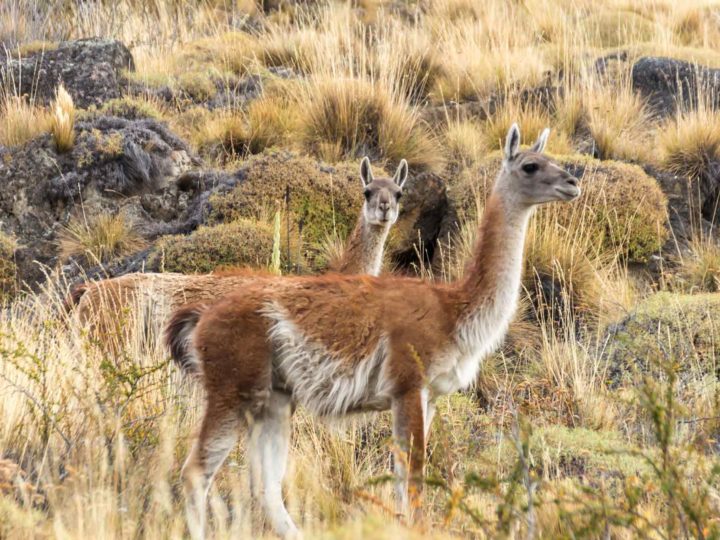
While this multi-day trek requires you to bring everything with you – you’re pretty damn remote, after all – the blindingly brilliant Patagonia vistas of undulating mountains and distant snow-dappled peaks will be more than worth it.
As one of Patagonia’s least-visited national parks, you’re also practically guaranteed to have the trail to yourself
Other trails in Patagonia National Park, Sector Jeinimeni: The Sendero Lago Verde (10 km, 2.5 hrs) takes you along the shores of Lago Jeinimeni to reach Lago Verde, both of which are similarly hued in electric blue. You can also turn this hike into the epic Patagonia National Park Trek (97 km, 5-6 days), which crosses Sector Valle Chacabuco and connects with the Paso Los Condores and the Ruta de Huemul to enter into Sector Tamango, the third part of the national park. Information about the latter here .
6. Lagunas Altas, Sector Valle Chacabuco, Patagonia National Park
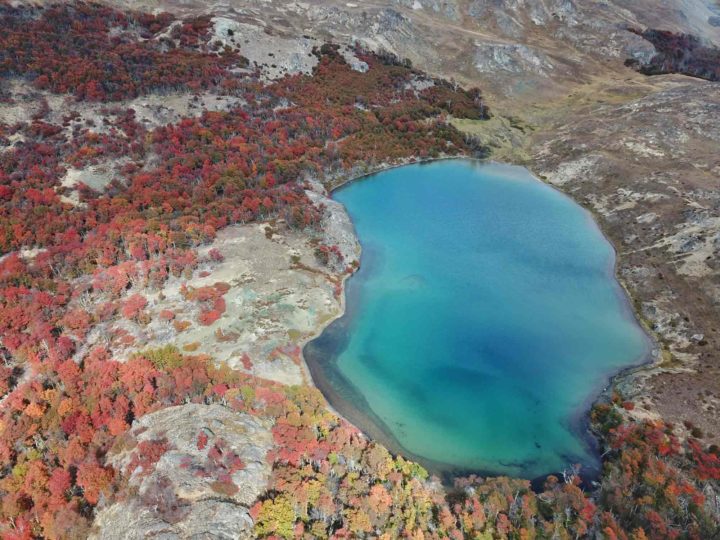
- Duration: 23 kilometers (14.3 miles); 6-8 hours.
- Best time to go: Patagonia in March is characterized by fall colors as the southern beech forests blush red, but any time between October and April is a good time to hike
- Difficulty: Medium; the trail climbs steadily on an exposed hillside for the first few kilometers
- Highest point reached: 1,240 meters (4,070 feet) just before reaching the first of the lakes
- Starting point: Just above the Los Westwinds campground, in Sector Valle Chacabuco of the park
- Ending point: The visitor center, two kilometers (1.2 miles) east of Los Westwinds
- Must-have gear: A windproof coat and layers as it can be cold up on the high plateau where the lakes are situated
- Do I need a guide? No. The trail is well-marked and you can access maps from the visitor center in the park
- Cost: Free.
- Useful information: The national park has information about all trails and logistical information on their website
- Map: The national park has a downloadable map here
The sweeping river basin of Valle Chacabuco is speckled with grazing guanaco and a carpet of ochre grasses that rustle in the breeze, and it’s probably my favorite of the three sections of the brand-new Patagonia National Park.
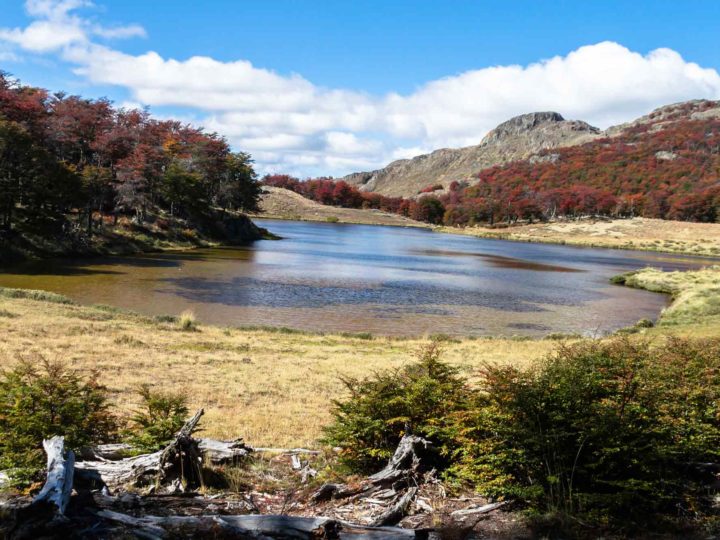
While ground level is spectacular, the views are enhanced as you climb up into the hills along the Laguna Altas trail, one of my personal favorite day hikes in Patagonia. Ascending steadily up into the flank of Cerro Tamaguito and onto an exposed plateau, you’ll find cinematic views across the entire Chacabuco valley and beyond to Argentina.
Along the way, a series of aquamarine lagoons provide the ideal spot for a picnic and, if you’re lucky, you might spy a puma padding through the undergrowth nearby.
Other hikes in the national park: The hard Avilés Loop (16 km, 5-7 hours) gives you a chance to combat the final part of the Jeinimeni-Avilés Traverse, while the medium Lago Chico Loop (12 km, 4 hrs) circuits Lago Chico for panoramic views of Monte San Lorenzo, one of Patagonia’s highest peaks.
Best hikes in northern Argentine Patagonia
7. nahuel huapi traverse, nahuel huapi national park.
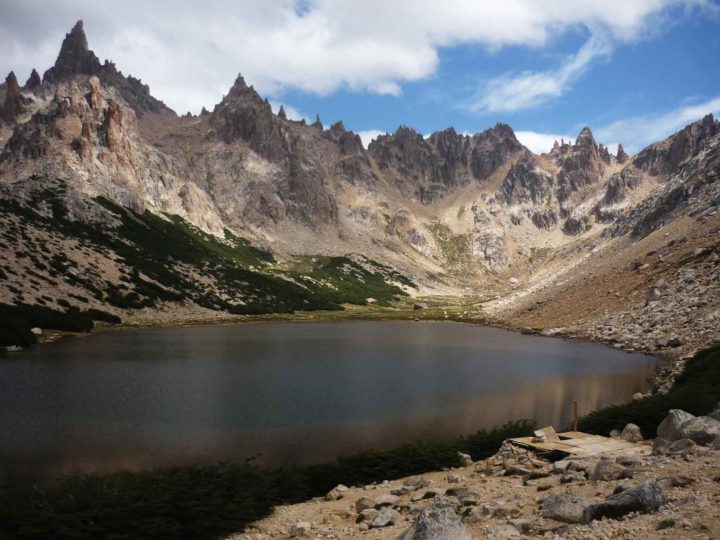
- Duration: 47 kilometers (29 miles); 5 days
- Best time to go: The trek can be impassable due to snow until mid-December, with December through March the best months for hiking
- Difficulty: Hard; some of the trail is poorly marked and there are high ridges and scrambles to be overcome
- Highest point reached: 2,060 meters (6,760 feet)
- Starting point: Cerro Catédral ski resort, 16 kilometers (10 miles) west of Bariloche
- Ending point: Arroyo Lopez, 26 kilometers (16 miles) northwest of Bariloche
- Must-have gear: Camping equipment if you don’t plan on staying in the refugios; trekking poles for the exposed sections of scree, and sturdy hiking boots , are also essential. A GPS or mobile phone with maps downloaded and GPS capabilities are also helpful when the path is poorly-marked
- Do I need a guide? No, however experience of path-finding is essential as much of it is poorly-marked
- Cost: Free; bus to the trailhead costs a few dollars
- Useful information: This website and this one have detailed information about the different stages of the hike
Hiking mecca Bariloche looks like a pleasant Swiss mountain village, with all the access to first-class trekking that you would expect. The nearby Nahuel Huapi National Park, with its craggy peaks and abundance of pristine mountain lagoons, is considered one of Argentina’s finest parks for the intrepid.
This five-day hike travels through an extremely remote part of the national park, with outstanding views of the region’s sparkling lakes (it’s part of the Argentine Lakes District, after all), picture-perfect volcanoes and the forest-fringed mountains that characterise this part of Patagonia.
Not only are the views epic, but the experience is one-of-a-kind, with remote mountain refugios offering a pleasant place to rest your head – and enjoy a beer – after a long day’s trekking in this spectacular part of Patagonia.
Best hikes in southern Chilean Patagonia
8. w trek, torres del paine national park.
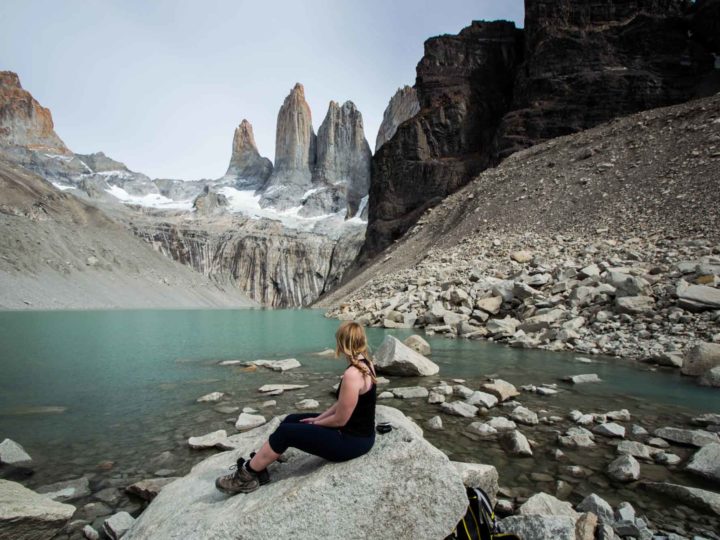
- Duration: 80 kilometers (50 miles); 4-5 days
- Best time to go: Shoulder season (November/mid-December or late February-April) when the trail has far fewer hikers and the weather is still stable and relatively warm, and, in many cases, a lot less windy than in the summer months (December through February). Refugio and campground reservations are also easier to come by during these months. From May through September, you can only hike accompanied by a tour guide
- Difficulty: Medium; to make things easier, you can pay for food and a tent or bed in a refugio to ensure you only have to carry the bare minimum in your day pack
- Highest point reached: 900 meters above sea level (2,950 feet). The trail includes two days of elevation gain of 500-700 meters (1,640-2,300 feet)
- Starting point: Guardería Paine Grande (hiking west to east) or Portería Laguna Amarga (hiking east to west)
- Ending point: Portería Laguna Amarga (hiking east to west) or Guardería Paine Grande (hiking west to east)
- Must-have gear: A Gore-Tex raincoat and waterproof pants are essentials, as high winds and heavy rain are common in Torres del Paine National Park throughout the year. A rain cover for your rucksack and waterproof dry bags to protect your belongings inside are also highly recommended
- Do I need a guide? No. However, the reservation process for the campgrounds can be complicated and must be done at least three months in advance. More details can be found in this guide to reserving refugios and camping in Torres del Paine National Park , or you can use Torres Hike , a website that will save you time and hassle
- Cost: $115,000 CLP ($153 USD), including park entry, camping, and transport; around $1,500 USD for a tour. I recommend Chile Nativo , who give readers a 5% discount when you use the referral discount code “Worldly Adventurer”.
- Useful information: I’ve covered this hike in forensic detail, so read up on how to hike it without a guide and what to pack for Torres del Paine National Park
- Map: Here .
Torres del Paine National Park, with its cobalt blue lakes, wind-buffeted sweeps of hardy forest, and majestic peaks that rise in a jagged, snow-dusted mass out of the center of the park, is Patagonia’s poster child. It’s also home to one of the region’s landmark hiking trails.
A five-day trek that follows a W-shaped trail across some of the park’s most magnificent scenery, the W is an introduction to the soul-stirring qualities of Patagonia.
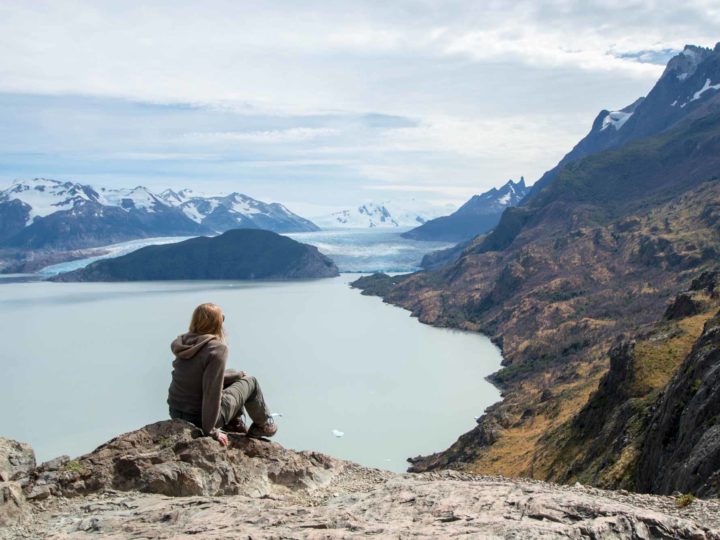
You trek through woodland and out again to face blinding panoramas, where you’ll admire Glacier Grey carving bergs the size of buses into silent waters beneath and stand in silence as you watch huemul picking through scattered vegetation beneath an amphitheater of mountains.
The final and most admired view, however, is Laguna Torres and the three granite towers after which the park is named, which, if you time it right, you can watch turning vivid orange in the light of sunrise. Once you reach the final viewpoint, head to the right along the ridge line, and you’ll get an even better view.
Other hikes in Torres del Paine National Park: There are dozens of hiking trails in the park, so read my guide to the best Torres del Paine day hikes for inspiration.
9. O Circuit, Torres del Paine National Park
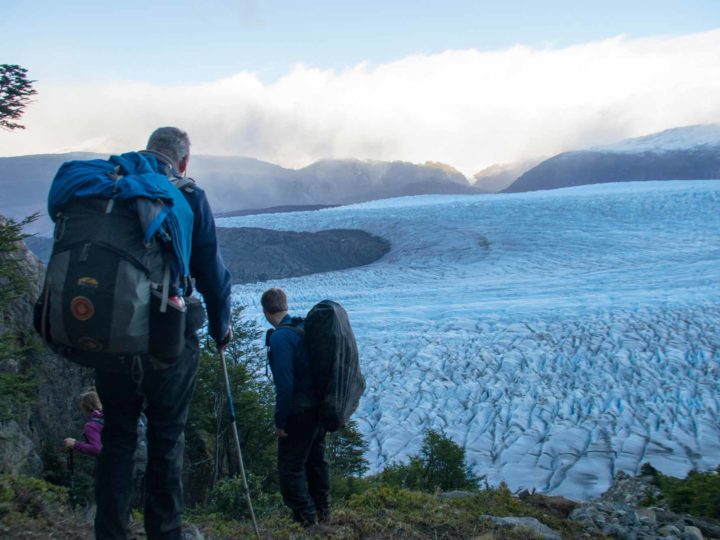
- Duration: 136 kilometers (85 miles); 9-11 days
- Best time to go: As above. For this trail, hikers are only permitted between November and April; the trail is closed during the rest of the year
- Difficulty: Hard; to make things easier, you can pay for food and a tent or bed in a refugio to ensure you only have to carry the bare minimum in your day pack
- Highest point reached: 1,200 meters (3,940 feet) above sea level at the John Gardner Pass.
- Starting point: Portería Laguna Amarga
- Must-have gear: As above. If you choose to self-cater, you will need to bring enough food for the duration of your hike, although small shops at the campgrounds along the W (which you join on day five) have basic supplies
- Do I need a guide? No. As for the O Circuit, the reservation process can be complicated and our article and Torres Hike are excellent resources
- Cost: $112,500 CLP ($155 USD), including park entry, camping and transport; $2,295 USD for a tour. I recommend Chile Nativo , who give readers a 5% discount when you use the referral discount code “Worldly Adventurer”
- Useful information: I’ve covered this hike in epic detail so read the complete guide to the Circuit , 14 things to know before you begin , and what to pack for hiking in Torres del Paine
The O Circuit promises a glimpse into the remote heart of Patagonia that goes beyond the much-trafficked trail of the W.
Instead, this hike takes a sweeping loop of the Cordillera Paine range, meandering into the park’s northern zone where each morning you awake to a new day of glaciers slung in the mountains high above you and gushing water powering its way through furious rivers that accompany the trail for miles.
On day four, you reach the trail’s most enticing viewpoint. A morning’s strenuous climb up to John Gardner Pass brings you to a view of miles of the Southern Patagonia Ice Field, with its ridged glaciers extending beyond the horizon.
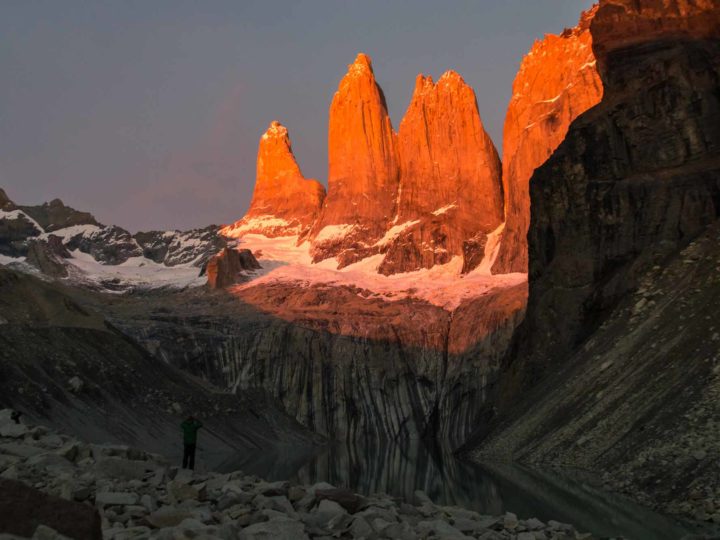
From here on in, you’re on the W trek, which you follow, bewitched, all the way to the final day and dawn rising over the towers.
Other hikes in Torres del Paine National Park: There are dozens of trails in the park, so read my guide to the best Torres del Paine day hikes for inspiration.
10. Hike to Cabo Froward, Punta Arenas
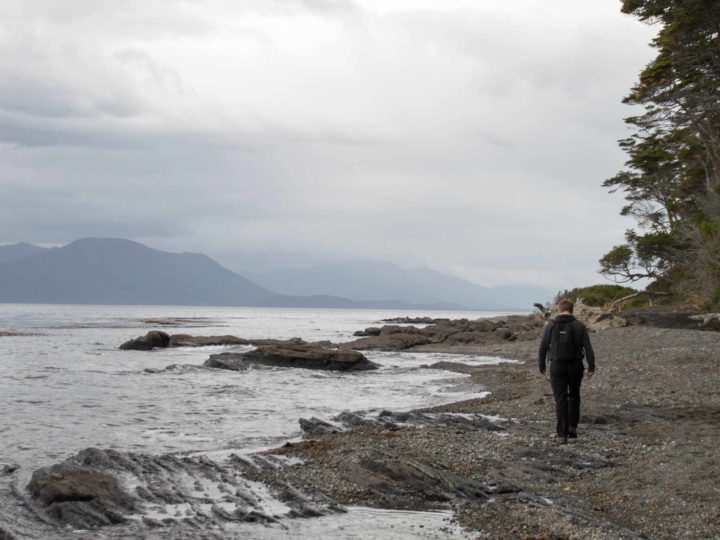
- Duration: 78 kilometers (48.5 miles); 5 days.
- Best time to go: The trek should only be attempted in summer (December through March) to avoid poor weather and rainfall that can make the river crossings even more perilous
- Difficulty: Hard; the trail is poorly marked and passes through remote and demanding terrain of forest and peat bog. Heavy rain means a likelihood of waist- to neck-high river crossings, so it’s essential you don’t attempt this alone. You’ll need to time your hike with the tide so that you can cross sections of the beach during low tide. SHOA , the Chilean navy’s hydrographic and oceanographic website, has tide tables
- Highest point reached: 365 meters (1,200 feet) at Cabo Froward
- Starting point: The trailhead begins at the end of the 9S road, 70 kilometers of Punta Arenas. You will need your own transport to get here, or hire the services of a taxi to drop you off and pick you up
- Must-have gear: Sturdy dry bags for your belongings to protect them during the numerous river crossings
- Do I need a guide? Only those with considerable hiking experience should do this trek and you shouldn’t attempt it alone. The Puerto Natales-based Erratic Rock used to offer five-day, four-night Cabo Froward trekking tours (from $900 USD) – confirm with them directly whether this is still the case
- Useful information: Check out Wikitravel for a route guide
The roaring oceans tumble and churn beyond the shoreline, providing a fierce backdrop as you hike across the beach and through peat bog and rugged forest to the very southernmost point of continental South America: Cabo Froward.
This is Patagonia at its wildest and most untamed, with the cape marking the point where the Atlantic and Pacific Oceans combine in a seething mass.
The waves are your constant companions, so it’s fitting that Cabo Froward – and the end of the trek out – is marked by the towering Cruz de los Mares, the Cross of the Seas, which rises out of the landscape to tower above you.
It’s here where you should pause, breathing in the fierce winds and absorbing the views of the Strait of Magellan across to the deserted mountains of Isla Dawson.
Keep your eyes peeled for dolphins, whales, and other sea life as you pick your route back the way you came and onwards to civilization – although the feeling of being buffeted by the wind and isolated far from everyone else is one that will last with you a long time.
11. Dientes de Navarino, Navarino Island
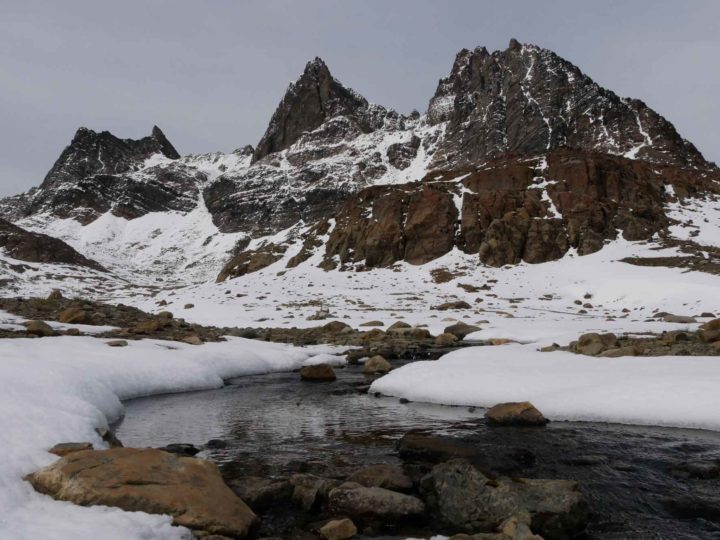
- Duration: 53.5 kilometers (33 miles); 5 days
- Best time to go: The trail is only passable in the Austral summer, between the months of December and March, although extreme weather, including high winds, rain, and even snow are possible at any time
- Difficulty: Strenuous; you must carry all of your own camping equipment and food for the duration of the trek. The trail itself is poorly marked at times, which means extensive hiking experience, plus a working GPS, are essential
- Highest point reached: 860 meters (2,820 feet) at Paso Virginia
- Starting point: Western edge of Puerto Williams
- Ending point: 6 kilometers (3.7 miles) west of Puerto Williams
- Must-have gear: Light-weight camping and cooking equipment are essential, while a durable, waterproof jacket , pants, and rucksack cover will keep you and your things warm and dry. A GPS or phone with downloaded maps and GPS capacities is also essential to ensure you can follow the trail
- Do I need a guide? No, but anyone who does not feel 100% confident with their experience of hiking in remote and extreme environments should seriously consider hiring a guide. You must register with the police in Puerto Williams before beginning this trek
- Cost: Free without a guide; $2,395 USD with a tour company. Local company Explora Isla Navarino can organize guided tours, including transfers to and from the start of the trail and the services of a guide with satellite phone.
- Useful information: This website has great information
If it’s remote, untouched Patagonia you’ve looking for on this list of hikes, then you’ll find it in the Dientes de Navarino, a trail that climbs through the final stretch of the Patagonian Andes and promises a true trekking adventure.
This five-day hike isn’t for the faint of heart of those without extensive trekking experience. But what you can expect is the truly wild, pristine, and mountainous scenery on what is officially the world’s southernmost long-distance hike.
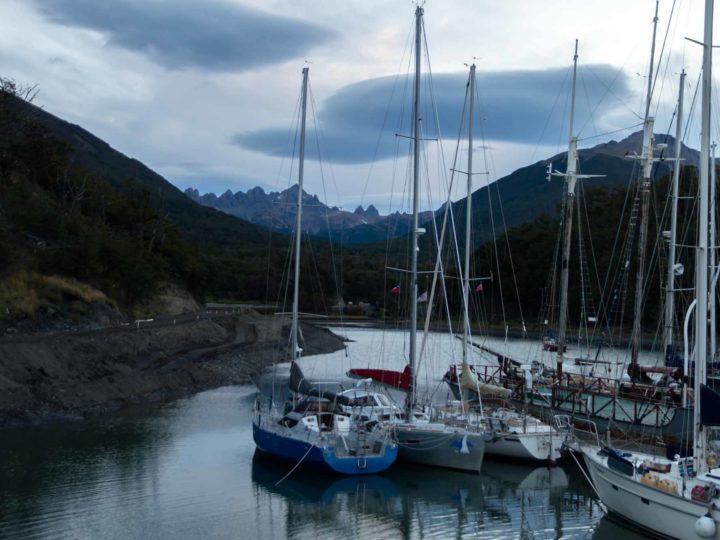
Named after the toothy mountains that jut out of Navarino Island (so far south it lies beyond Ushuaia, often mistakenly considered the southernmost settlement in the world), this trail clambers across stark, rocky land dotted with lakes and sparse, scrubby vegetation.
If you’re looking for an experience of hiking at the very ends of the earth, the Dientes de Navarino is the one for you.
Other hikes in Puerto Williams : If you don’t fancy doing the full circuit, you can do a short hike up to Cerro Bandera (4 km, 2 hrs) for stunning vistas across the town and the Beagle Channel.
Best hikes in southern Argentine Patagonia
12. laguna de los tres, los glaciares national park.
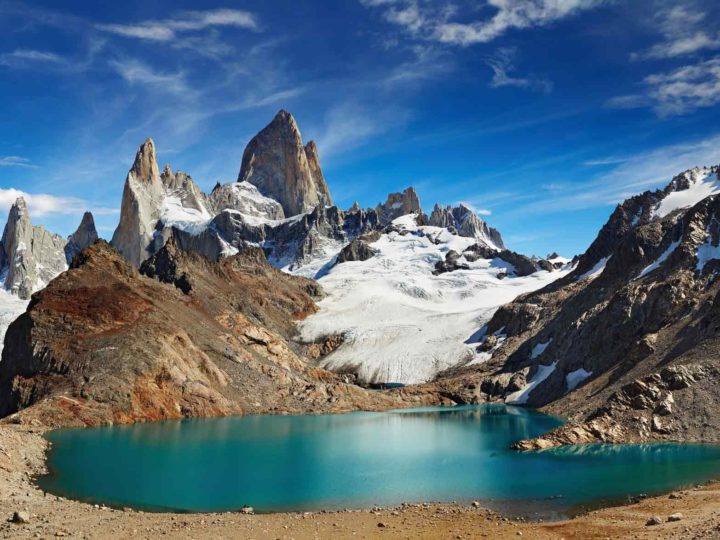
- Duration: 23 kilometers (14 miles); 8-10 hours, although you can turn it into a two-day trek, a watch dawn break over Monte Fitz Roy, if you camp overnight at Campamento Poincenot, just below the final ascent to Laguna de los Tres. If opting for a one-day trek, make sure you start early.
- Best time to go: The trail is generally only open from October through April (after which heavy snowfall closes much of the park). Like Torres del Paine National Park, visitors peak between mid-December and February, when you may find yourself queuing to make the final ascent
- Difficulty: Medium/hard; much of the hike has a gentle ascent, but the final two kilometers (1.2 miles) are very, very steep
- Highest point reached: Unknown, but the elevation gain across the trek is around 700 meters (2,300 feet), with the final 400 meters (1,300 feet) coming in the final two kilometers (1.2 miles).
- Starting point: From the northern edge of El Chaltén, the town closest to this part of Los Glaciares National Park
- Must-have gear: Sturdy hiking boots and trekking poles can help on the final ascent. If it’s raining, a good Gore-Tex waterproof coat will keep you dry, while you’ll want layered clothing ( a fleece or other warm sweater ) for the top, where it can get fiercely windy and cold
- Do I need a guide? No; plenty of other hikers on the trail will make it hard for you to get lost
- Useful information: This website has information about this trek and all others in and around El Chaltén
Like the W trek and the torres of Torres del Paine, Laguna de los Tres has become the stuff of backpacking legend in Patagonia and you can’t go hiking in South America without attempting this trail.
The Laguna de los Tres trail’s fame stems from the way it picks its way through shady forests where woodpeckers and even rare huemul deer linger, and where the occasional openings in the trees give up broad views of Monte Fitz Roy.

But mostly, this reverence stems from the very end point of the trek where, after a lung-busting climb up and up over rocky scree you appear out on the shores of Laguna de los Tres, whose green-tinged glacial waters reflect the pronged peak of Monte Fitz Roy rising directly above.
While many choose to clamber up to this dazzling viewpoint as a one-day excursion from El Chaltén, if you’ve got the time, take a tent to pitch up in the basic Campamento Poincenot, just below the final ascent to the lake, and head up early the next morning for a truly unforgettable sunrise.
Other hikes in Los Glaciares National Park: The moderate trek to Laguna Torre (18 km, 9 hrs) allows you to experience the start of the Huemul Circuit and has spellbinding views of the Cordón Adela mountains and the often cloud-covered Cerro Torre; the trail to Chorrillo del Salto (4 km, 1.5 hrs), is an easy wander out to a pretty 20-meter waterfall; the steep trail to Mirador Los Condores (2.5 km, 30 mins) and Mirador Aguila (1.3 km extra, 30 mins more) has great views of Lago Viedma, as well as the prospect of spying condors.
13. The Huemul Circuit, Los Glaciares National Park
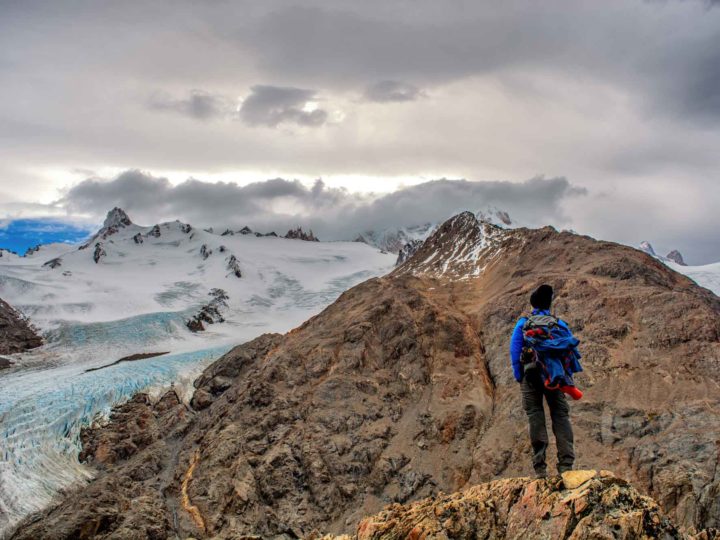
- Duration: 70 kilometers (43 miles); 4 days
- Best time to go: January and February see the best weather conditions on this hike and trekking should only be attempted between October and April. Shoulder seasons are far more challenging times to do this trek, as snowfall can prevent you from crossing the pass
- Difficulty: Strenuous; the trek includes two river crossings that often require the use of ziplines.
- Highest point reached: 1,550 meters (5,085 feet) at Paso del Viento (Windy Pass)
- Starting point: Southwestern edge of El Chaltén
- Ending point: Park ranger visitor’s center south of El Chaltén
- Must-have gear: Winds can reach up to 100 kilometers per hour, so bring plenty of layers and windproof, waterproof outer clothing to keep you warm. You will also need safety equipment (which you must show to the park rangers before you leave), including a harness, two carabiners, a safety line, and 20 meters of rope, all of which you can rent in El Chaltén; you will not be allowed to hike if you don’t have these. A GPS or phone with Maps.me downloaded is essential, as the trail is poorly marked
- Do I need a guide? As much of the trail is poorly marked, you should not attempt this trek unless you have considerable map-reading experience, as very few people – and park rangers – are on the trails and if you get into difficulty, you’re on your own. You must register at the Centro de Informes Ceferino Fonzo for the national park in El Chaltén to get a hiking permit – this will ensure that the rangers come out looking for you if you don’t come back off the mountain
- Cost: Free; tours start from around $900 USD per person. Fitz Roy Expediciones is a good option for a guided trek
- Useful information: This blog post has a level of detail that even I’m impressed by!
Laguna de los Tres might draw the day trippers, but Los Glaciares’ most superlative scenery is reserved for the most intrepid. The Huemul Circuit is just that.
What makes this trek an extraordinary adventure – and certainly among one of South America’s, if not the globe’s, best hikes – is the thrill of roaming the backcountry in this remote part of Argentina, picking your way past glaciers and around milky-blue glacial lakes.
But the most astonishing feature of this trek is the views from Paso del Viento, all the way across the Southern Patagonian Ice Field – an astonishing panorama of practically unending ice that shimmers beneath the sky.
The Huemul Circuit is by no means a walk in the park, but those who do it will find themselves safe in the knowledge that they may just well have encountered the finest views in all of Patagonia.
Other hikes in Los Glaciares National Park: The moderate trek to Laguna Torre (18 km, 9 hrs) allows you to experience the start of the Huemul Circuit and has spellbinding views of the Cordón Adela mountains and the often cloud-covered Cerro Torre; the trail to Chorrillo del Salto (4 km, 1.5 hrs), is an easy wander out to a pretty 20-meter waterfall; the steep trail to Mirador Los Condores (2.5 km, 30 mins) and Mirador Aguila (1.3 km extra, 30 mins more) has great views of Lago Viedma, plus the prospect of spying condors.
14. Crossing from Villa O’Higgins to El Chaltén (Chile/Argentina)
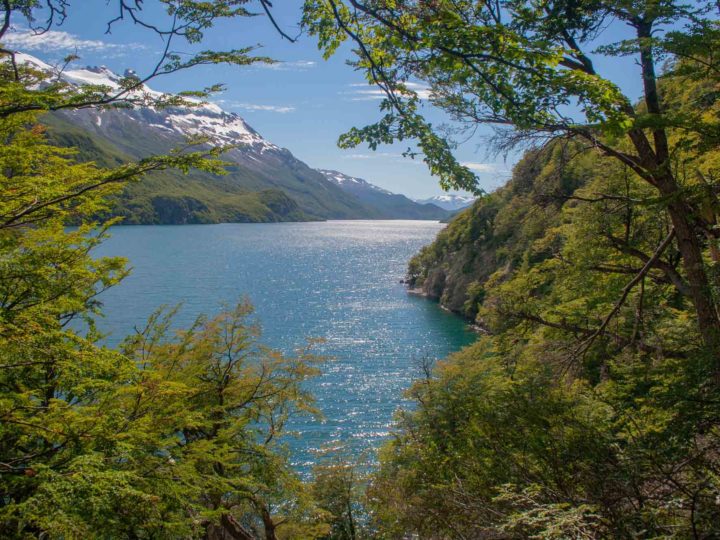
- Duration: 22 kilometers (13.7 miles) or an additional 10 kilometers (6 miles) if you don’t take the ferry on the first day; 2 days
- Best time to go: You can only take this route November through April, as the ferries stop operating outside of these months
- Highest point reached: Unknown, although there are no high peaks to be climbed on this hike
- Starting point: Lago del Desierto, 35 kilometers (21.7 miles) north of El Chaltén along the Ruta 23, although the journey can be done in the opposite direction
- Ending point: Villa O’Higgins
- Must-have gear: Bring Chilean pesos, enough food for at least two or three days of waiting around for a boat, camping equipment, and plenty of warm and waterproof clothing
- Do I need a guide? No. Note that you may find yourself waiting for a couple of days for your ferry across to Villa O’Higgins if poor weather prevents the ferry from making the crossing
- Cost: Minibus to Lago del Desierto costs $20 USD (2 hrs); ferry across Lago del Desierto costs $28 USD; ferry from Canderlario Mancilla to Villa O’Higgins costs $36,000 CLP ($50 USD) direct to Villa O’Higgins or $82,000 CLP ($113 USD) via Glaciar O’Higgins.
- Useful information: You can make reservations for all of the bus journeys and boats, plus horses for cargo and the campsite at Candelario Mancilla, in advance here
In Patagonia, even the border crossings between Chile and Argentina are an adventure, particularly the route between El Chaltén and Villa O’Higgins, one only passable on foot.
Starting on the shores of the azure Lago del Desierto, you’ll hike or take the ferry across to the northern edge of the lake, where the only way is on foot as you climb gently up into the mountains through wind-battered forests of southern beech, with Monte Fitz Roy crowing the sky behind you.
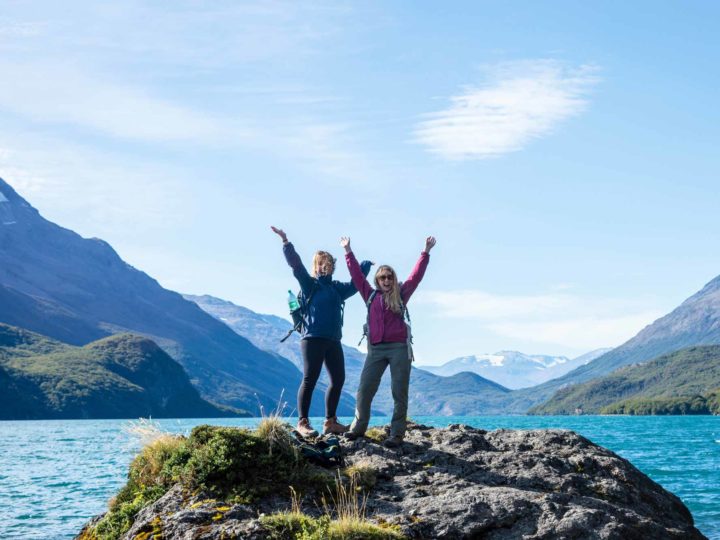
But that’s not all: after crossing the Chilean border and reaching the remote settlement of Candelario Mancilla, you’ll have to wait for your transport. It’s a boat that’ll take you past the calving ice giant that is Glaciar O’Higgins before dropping you onto the shores of the southernmost settlement along the Carretera Austral, Villa O’Higgins.
You’ll soon realize on this trail that every moment of this journey feels deliciously wild, untouched, and magical.
15. Cerro Guanaco, Tierra del Fuego National Park
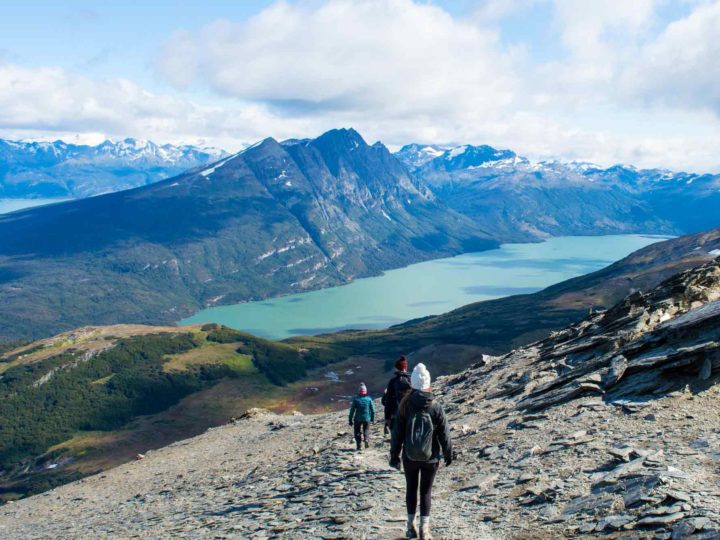
- Duration: 8 kilometers; 8 hours
- Best time to go: November through March promise the best weather, as well as public transport to the park. A small number of campgrounds are also open in the national park during these months
- Difficulty: Hard; the trek gains 973 meters (3,190 feet) over just four kilometers, making the trail extraordinarily steep
- Highest point reached: 973 meters (3,190 feet) at Cerro Guanaco
- Starting point: From outside the Centro de Visitantes Alakush. The public bus from Ushuaia picks up and drops off here throughout the day; if traveling in a pair or more, it’s often cheaper to hire a car for the day than take the bus, which costs around $20 USD return per person
- Must-have gear: A pair of trekking poles will be invaluable in the muddy section of the hike as well as in the open scree
- Do I need a guide? No; the trail is well-marked
- Cost: $8 USD for park entry
- Useful information: Park website with basic information here
Flanked by a wall of mountains on its northern edge and the frigid, whale-filled waters of the Beagle Channel in the south, Ushuaia is Argentina’s southernmost city and has access to spectacular nature nearby.
Tierra del Fuego National Park has a handful of day hikes, but the gem in its crown is the challenging trek up Cerro Guanaco. It’s a sludgy, waterlogged climb once you exit the tree line and find yourself in a bog that merges into a staggeringly steep and bone-dry outcrop of scree.
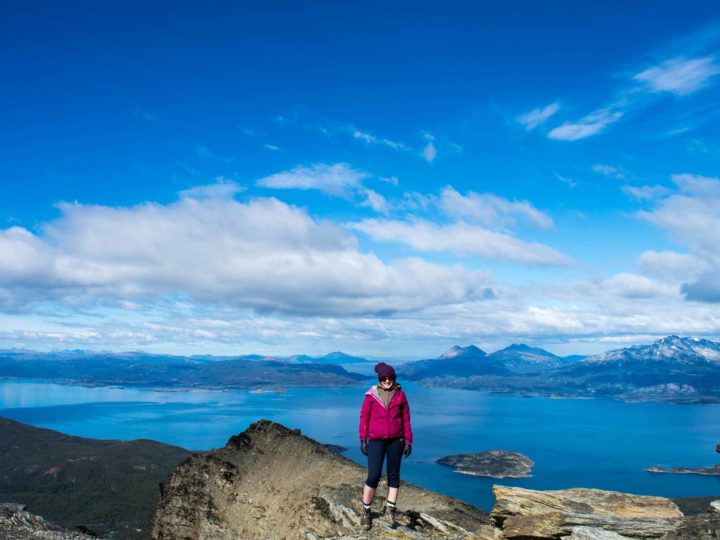
A final clamber along the edges of this and you finally reach the top of Cerro Guanaco, from whose exposed crest the cinematic views of the Beagle Channel and the mountains of Navarino Island await.
Keep your eyes peeled as you hike through the forests the first section of the trail, where red and black-headed Magellanic woodpeckers are resident.
Other hikes to do in Tierra del Fuego National Park: The easy Senda Costera (8 km 4 hrs) is a meandering coastal path with beautiful mountain views; the also easy Senda Pampa Alta (3 km, 1 hr) climbs up to a lookout for views of the Beagle Channel and the Valle del Río Pipo; the Senda Hito XXIV (7 km, 3 hrs) is an easy hike along the edges of Lago Acigami to reach the border with Chile and has lovely views across the Beagle Channel.
FAQs about hiking in Patagonia
Is patagonia good for hiking.
Patagonia is considered one of the best places on the planet to hike! With the Andes Mountains cutting through the middle of Patagonia, it’s no wonder that the region offers excellent hiking. Destinations such as Torres del Paine National Park, Bariloche, and the new national parks along the Carretera Austral top of most trekkers’ bucket lists.
The best thing about hiking in Patagonia is that, despite the proximity to the mountains, none of the hikes in Patagonia are at altitude.
In fact, unless you’re a climber, you’re unlikely to reach over 1311 (4,301) meters above sea level – the elevation of Paso Viento, the highest point along Argentine Patagonia’s Huemul trek – on any of the hikes. As a result, there’s no need to worry about hiking at altitude in Patagonia.
Is hiking difficult in Patagonia?
It entirely depends on the hiking you choose to do. While the O Circuit in Torres del Paine National Park might be a moderately challenging eight- or nine-day trek , it’s still a great choice for people who’ve never embarked upon a multi-day hike before (although you certainly want to have day hiking experience before doing so!).
Patagonia is also home to plenty of one-day treks, including those such as the Lagunas Altas trail in Chile’s magnificent Patagonia National Park and the more famous Laguna de los Tres route in Argentina’s Los Glaciares National Park.
There are also plenty of moderate multi-day hikes, such as the five-day W trek and the four-day Cerro Castillo Traverse (both in Chile), plus difficult routes such as the four-day Huemul Circuit (also in Los Glaciares National Park) and Dientes de Navarino (on Chile’s Navarino Island). As a result, you can pick and choose trails that suit your ability.
How many days do you need to hike in Patagonia?
Patagonia is packed with hiking trails, so it really depends on how many you want to do! If you fancy the five-day W trek, then you’ll need at least a couple of days on each side to fly from Santiago to Puerto Natales, the closest airport to Torres del Paine National Park (the park in which the hike is located).
Additionally, if you plan on doing day or multi-day hiking in Los Glaciares National Park just across the border in Argentina, you’ll want at least three days (for day hikes) or four days for the Huemul Circuit, plus a couple of days to get there and back from Chile or from Buenos Aires.
If you fancy tackling the best treks in Bariloche, give yourself at least four days, while Chile’s Carretera Austral, with its glut of lesser-known national parks, needs at least two weeks if you plan on hiking the best trails.

9 Top-Rated Hiking Trails in Patagonia
Written by Mark Johanson Updated Jul 26, 2021
Few places on planet Earth are as remote and untouched as Patagonia. This sparsely populated region, which spans the southernmost tips of both Argentina and Chile , is rightfully famous for its soaring Andean peaks, windswept steppes, crackling glaciers, and distinct gaucho culture. It's also a mecca for adventure enthusiasts, with incredible hiking and multi-day trekking routes through some of the world's most rugged and unforgiving landscapes.
In general, the Patagonia trekking season runs from October to April . Some trails can get downright overcrowded in the height of summer (January and February), when the weather is at its most ideal, and local Chileans and Argentineans take their holidays. If you're planning to travel during this time, it may be a good idea to book campgrounds and lodgings in advance.
Your Patagonia hiking experience can be as tough or as luxurious as you choose. Over the past number of years, an excellent assortment of quality accommodation has emerged on the scene. These range from mid-range hotel options to lodges in spectacular locations right through to luxury eco-yurts complete with Jacuzzis and world-class dining.
Find the right route for you with our list of the best hiking trails in Patagonia.
1. The W Trek
2. the o circuit, 3. the lago del desierto border crossing, 4. the laguna torre trek, 5. the huemul circuit, 6. the hut-to-hut hike through nahuel huapi, 7. the cerro castillo circuit, 8. the ice hike on perito moreno, 9. the cabo froward trek, map of hiking trails in patagonia.
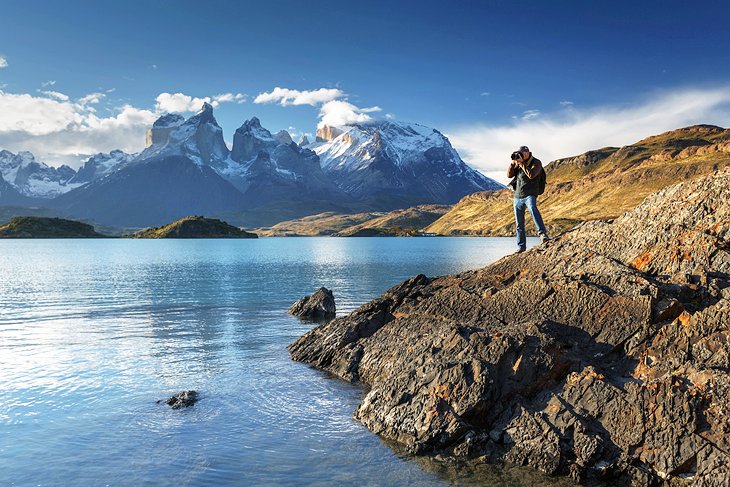
Looking for a hike that will offer you the highlights reel of Patagonia? The five-day W Trek through Torres Del Paine National Park is, perhaps, the most quintessential experience in the south of South America and a rite of passage for any avid hiker. It's also the best trail in Patagonia for solo travelers (or female hikers) as you're guaranteed to meet others along the way to share the journey.
Most visitors enter Torres Del Paine on a bus from the regional hub of Puerto Natales and begin the 71-kilometer W Trek at Refugio Las Torres. Head north from there to hike to the base of Las Torres before swinging back around and heading into the French Valley . Continue onward into the second U of the W and over to the massive Grey Glacier , part of the Patagonian Ice Field.
Once you finish the five-day, four-night trek, you can catch a boat out at either Refugio Paine Grande or Refugio Grey. Keep in mind that, in Torres Del Paine, it's not uncommon to experience four seasons in one day. In fact, plan on it!
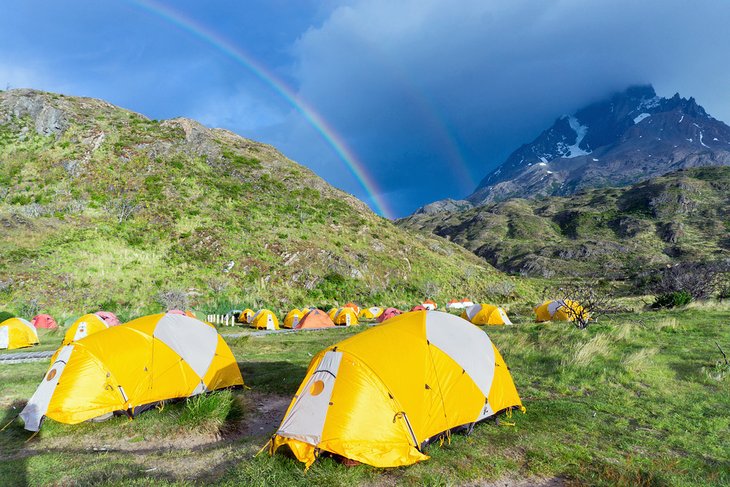
You can make this once-in-a-lifetime experience as rustic or luxurious as you like by carting all of your own camping gear on your back and sleeping at the campgrounds or bunking-up in Refugio's, where bedding is provided and cooks can set you up with three meals a day.
The luxurious option is to take a lodge-based guided tour, where you'll still see all the highlights of the W Circuit but at the same time enjoy comfortable beds, hot showers, first-class dining, shuttles, and kayaking excursions. As an added bonus, you only need to carry a day pack, not a heavy backpack with all your gear. If that's outside your budget, it is also possible to make your own trip and combine all the options by camping, staying in a refugio, and living it up at a lodge for a night or two.
Instead of carrying all your camping gear on your back, consider renting equipment that will be all set up for you when you arrive at each location. The gear is good quality, clean, and more than adequate. Make your gear booking through the same companies that operate the refugios.
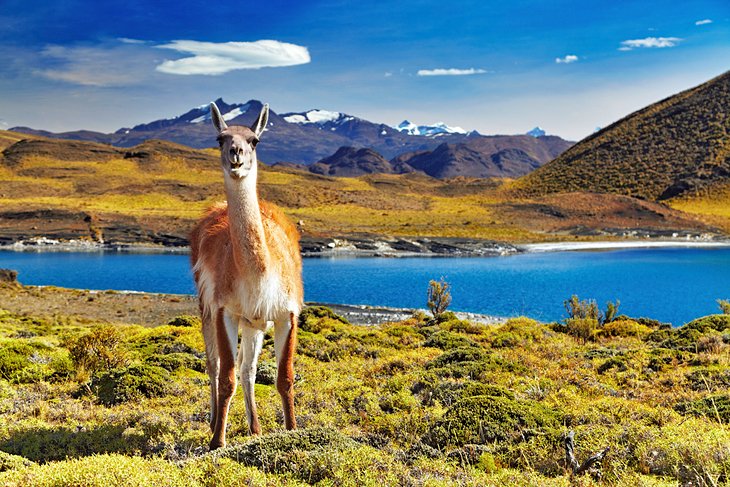
If you want the full-on Patagonian experience that includes the best of the W Trek, and layers on the best of the true backcountry of the region, consider the O Circuit.
This will add an additional 50 kilometers to your hike for a grand total of 136 kilometers. Hikers are limited to 80 per day, and with the incredible vastness of this area, solitude is almost guaranteed.
The trail runs counter clockwise only and starts in Laguna Armarga , where it ascends along the Rio Paine through the Patagonian steppes, and passes beautiful Dickson Lake and the panoramic view of the Perros Glacier near Campamento Los Perrosand. It's at this point, you'll begin the ascent up and over Paso John Gardner . You'll then descend into the far side of the park and begin the classic W Trek.
Accommodation on the remote parts of this trail (i.e. the part that is not included in the W Trek) is in rustic refugios and campgrounds.
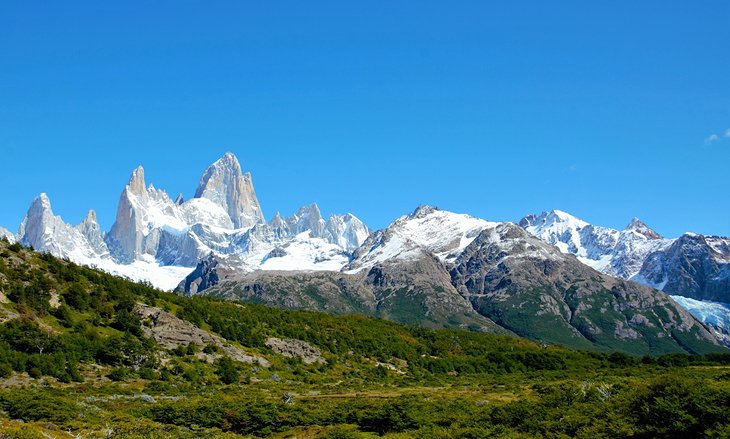
The Carretera Austral is the only artery through Northern Patagonia on the Chilean side of the Andes, but this infamous highway (popular with road-trippers and cyclists alike) peters out in the remote gaucho town of Villa O'Higgins . Not far away as the condor flies is the popular Argentinean resort town of El Chaltén .
So how do you get between the two? First, you'll need to catch a four-hour ferry across the turquoise Lago O'Higgins, stopping to see the impressive O'Higgins Glacier before continuing to the remote Chilean outpost of Candelario Mansilla (home to a police station, campground, and little else). Get your passport stamped out of Chile and continue onward by foot 20 kilometers to the next border post at Lago del Desierto, where you can get an entry stamp for Argentina and camp for the evening. Continue along the edge of Lago del Desierto the following day for 15 kilometers until you reach the southern shores of the lake, where regular buses shuttle tourists to El Chaltén 37 kilometers away.
The entire journey works more or less the same in reverse. You should also keep in mind that it's not uncommon for boats across Lago O'Higgins to be delayed for days due to strong winds that make the crossing unsafe.
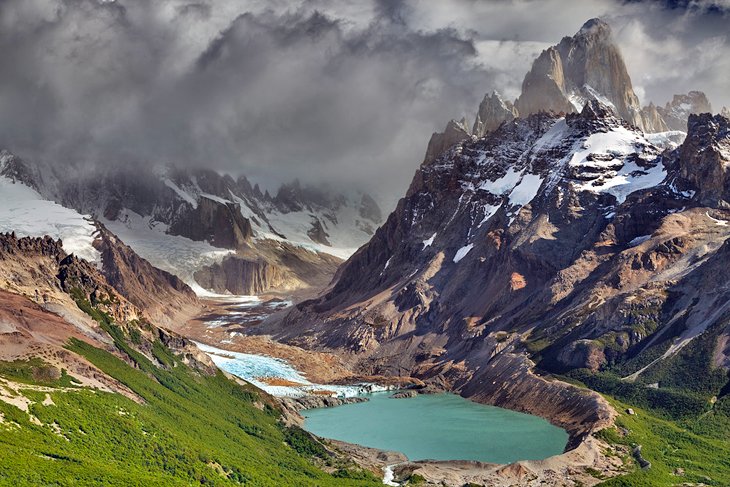
The wind-whipped village of El Chaltén is Argentina's premier trekking capital, with some of the most scenic hikes in South America. The most popular day hike from town, which can be extended into a multi-day hike for more adventurous travelers, is Laguna Torre also known as the Fitz Roy Trek . This 20-kilometer, in-and-out route takes you to several miradores (lookouts) with views of the icy spires of Cerro Torre (3,128 meters).
Much of the path follows the edge of Rio Fitz Roy until you reach the glacial lake of Laguna Torre, where you'll find a small campground. You'll then traverse the edge of the lake to the most stunning lookout of them all, Mirador Maestri, where the icy folds of Glacier Torre fade into the horizon.
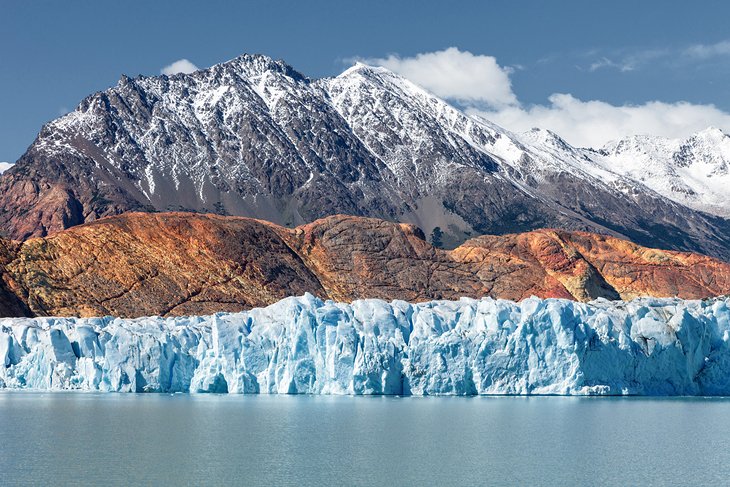
This four-day circuit trek into the heart of Argentina's Los Glaciares National Park takes in native beech forests, high-altitude meadows, and the frozen wonders of the Patagonian Ice Field . Begin in El Chaltén for a 15-kilometer hike to Laguna Toro to camp on day one, before wading across Túnel River and skirting the edge of a sweeping glacier field on day two to camp at Refugio Paso del Viento 12 kilometers later.
Continue circling the jagged peaks of Cerro Huemul on day three for 18 kilometers to camp at Bahía Cabo de Hornos on Lago Viedma, a massive lake formed from the melting ice of Argentina's largest glacier . The final push on day four is a relatively flat 18 kilometers through the Patagonian steppe.
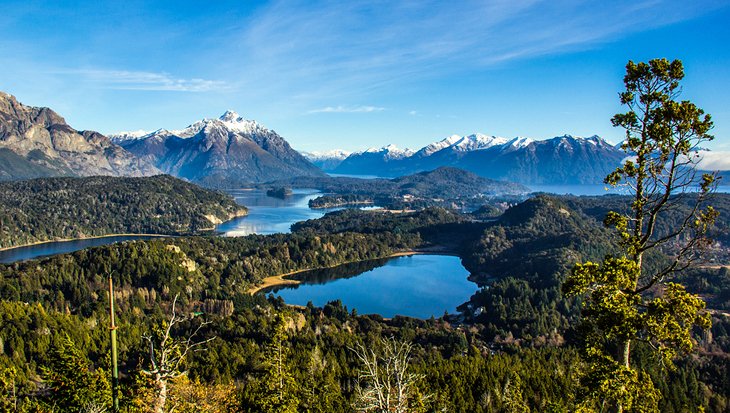
One of the most stunning and well-planned paths through northern Patagonia lies in Argentina's Nahuel Huapi National Park , which surrounds the four-seasons resort town of Bariloche . This four-day hike traverses a number of mountain ridges and lake-carved valleys along the Andean frontier with Chile, and includes overnight stays in shared rooms (with mattresses) at three well-equipped mountain huts. Though they don't have showers, they do have simple bathrooms, and you can take a dip in the cool waters of the lagoons along the way.
Start trekking from the foot of the Cerro Catedral ski area up to Refugio Frey (12 kilometers) for night one. The next morning, you'll walk between the granite towers known as Los Catedrales and on to Refugio Jakob at the edge of Laguna San Martin (9.5 kilometers). Spend night three in Refugio Laguna Negra, 10 kilometers away, before wrapping up the hike 16 kilometers later on day four in Colonia Suiza , a town on the outskirts of Bariloche with chalets that recall the area's early Swiss colonists.
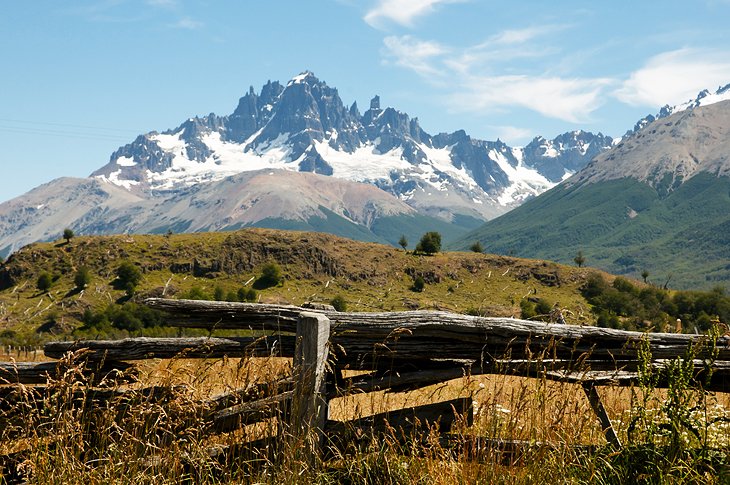
Looking for a lesser-known multi-day hike through Chilean Patagonia? The 43-kilometer Cerro Castillo Circuit offers the same wow factor of the W Trek (above) without the crowds. In four arduous days, you'll circumnavigate the castle-like spires of Cerro Castillo, passing glistening glaciers, turquoise lagoons, and endangered huemul deer along the way.
This circuit trail doesn't see a whole lot of traffic throughout the year and is best appreciated on a guided tour for inexperienced backpackers due to some tricky stream crossings and technical mountain passes. Find guides in the service village of Villa Cerro Castillo or the regional capital of Coyhaique 1.5 hours away. Experienced hikers with prior backcountry experience should be fine on their own with a good map.
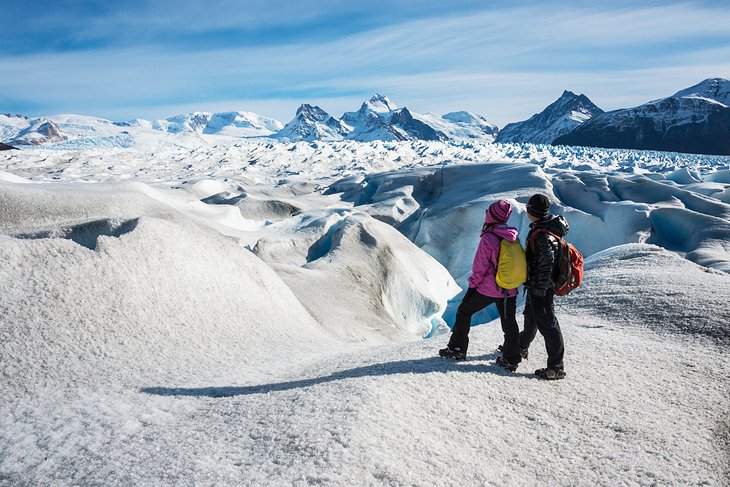
Though not the biggest glacier in Patagonia, Perito Moreno is easily the most famous as it creeps forward up to two meters per day, resulting in thundering roars of cascading ice as it calves truck-sized icebergs into Canal de los Tempanos. This 30-kilometer-long, five-kilometer-wide glacier is the photogenic star of many a postcard and one of Argentina's top attractions luring visitors from near and far.
One of the best ways to experience it is on an ice hike through its frozen contours. Four-hour guided treks onto the ice can be arranged in nearby El Calafate , the main hub for lodgings and tourist services in the southern sector of Los Glaciares National Park . Most tours involve a boat ride from Puerto Bajo de las Sombras and a walk through a lenga forest before you strap on some crampons and take to the ice.
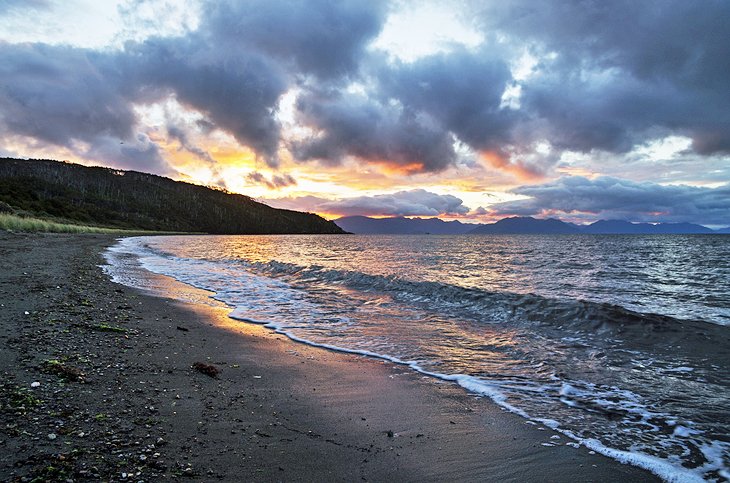
Known as "the trek to the end of the world," this 45-kilometer route skirts the edge of the Strait of Magellan and will take you to the southernmost tip of continental South America . The four-day journey traverses an uninhabited stretch of Chile's Brunswick Peninsula, with incredible views of Tierra del Fuego and Isla Dawson along the way. There's also a high probability that you'll stumble across penguins or see dolphins swimming along the shore, offering an intimate connection to the Patagonian countryside.
You can reach the trailhead in Rio Santa Maria by bus from the regional capital of Punta Arenas , but the hike is extremely challenging, not well-marked, and best done with a proper guide. Try the team at Erratic Rock Expeditions , who helped pioneer this route.

More on Argentina
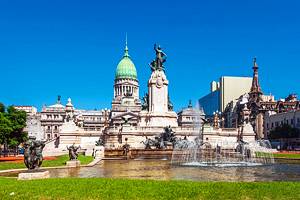

How to Hike the ‘O’ Circuit in Torres del Paine, Patagonia

Where : Torres del Paine National Park Distance : 76 miles | 123 km Days to Complete : 6-11 Difficulty : Strenuous Best Time to Hike : December-March Typical Weather : High wind, rain
Permit : Proof of reservations required Park Fee: 21,000 CLP/$31 US Hiker Traffic : Moderate-Heavy Resupply Options : Only on ‘W’ side Huts/Cabins/Hotels : Yes Cell Service : Spotty
I’d heard rave reviews about the stunning beauty of Torres del Paine’s ‘O’ Circuit, but I wasn’t prepared for it to take me to a transcendent new world.
Towering granite spires, sprawling glaciers, breathtaking mountain passes, intense and ever-changing weather — I experienced it all on every step of my six-day journey. Trekking Patagonia’s ‘O’ Circuit had exposed me to a completely different type of outdoor experience than I’d ever known.
Chile’s proudest national reserve – located in the far reaches of the Patagonian wilderness – is a mecca for outdoor enthusiasts worldwide. A quarter-million visitors travel to Torres del Paine every year, and now I know why.
Within Torres del Paine exist the captivating ‘O’ and ‘W’ Circuits, two multi-day hiking trails that bring trekkers face to face with some of the most jaw-dropping landscapes our world has to offer.
You can complete the ‘O’ Circuit safely and affordably during the 2023-2024 season. If I can pull it off without a guide, then so can you. Let me tell you exactly how I did it.
Torres del Paine ‘O’ Circuit
What is the ‘O’ Circuit?
- Booking Reservations on the ‘O’ Circuit
- Recommended ‘O’ Circuit Itineraries
Pre and Post Trek Accommodation
Essential gear for the ‘o’ circuit.
- Getting to Torres del Paine N.P.
- Preparing for the ‘O’ Circuit
- Pehoé Terminal to Camp Italiano
- Camp Italiano to Camp Las Torres
- Camp Las Torres to Camp Serón
- Camp Serón to Camp Dickson
- Camp Dickson to Camp Paso
- Camp Paso to Pehoé Boat Terminal
- Final Thoughts: The ‘O’ Circuit

In short, the ‘O’ Circuit is a 126-kilometer loop around the scenic Cordillera del Paine mountains within Patagonia’s Torres del Paine National Park. The trail includes the famous ‘W’ Circuit (67 km), and wraps around the backside of the spectacular mountain range, eventually connecting to make a loop. I’ve included a map below to show you the routes for both treks.
The trail is full of challenges: steep inclines, long intervals, and notoriously erratic weather. To solo hike the ‘O’ Circuit requires a substantial amount of planning and preparation.
Most people choose to complete the trek in 7 to 10 days. Some hike it quicker, some take longer. I decided to hike the loop in 6 days, which is the fastest itinerary I would recommend.
There are three trailheads to choose from to begin the ‘O’ Trek: Grey (accessible by boat), Paine Grande (accessible by boat), and Las Torres (accessible by car or bus).
You MUST hike backside of the circuit (the ‘O’ portion) counter-clockwise. The hiker traffic on the backside of the mountain is drastically less than the front side, which is why it was my favorite stretch of the trek.
Booking Reservations for the ‘O’ Circuit Trek
The ‘W’ and ‘O’ Circuits are Patagonia’s most famous treks but only allow for limited traffic. Don’t risk getting turned away — make all your reservations months in advance. Procrastination might result in a booked up calendar.
BOOK YOUR RESERVATIONS BEFORE ANYTHING ELSE!

How to Make Camping/Lodging Reservations
There are three different websites from which you can book campsites and refugios (cabins with beds) online. Study the trail map, distances, and elevation changes carefully to plan your itinerary. You’ll need to visit two or three websites to book your entire trip.
Most campsites will turn you away if you show up without a reservation, and rangers won’t even let you onto the ‘O’ side of the trek without proof of camping/lodging bookings. Get creative with your itinerary if specific sites are full and entertain all options as you plan your trip.
All ‘O’ Circuit reservations can be made on the following websites:
Italiano Closed for 2024 season.
Paso Price : FREE camping! Amenities : Bathrooms, water. Not available : Electricity, showers, food, gear, supplies.
Torres Closed for 2024 season.
Dickson Price : Campsites starting at $9 US per night. Dorm bed starting at $37 US per night . Amenities : Water, bathrooms, showers, electricity, gear rental, re-supply shop, restaurant.
Los Perros Price : Campsites starting at $9 US per night. Refugios starting at $37 US per night . Amenities : Water, bathrooms, showers, electricity, gear rental, resupply shop, restaurant.
Grey Price : Campsites starting at $9 US per night. Dorm beds starting at $37 US per night . Amenities : Water, bathrooms, showers, electricity, gear rental, resupply shop, restaurant.
Paine Grande Price : Campsites starting at $11 US per night. Dorm beds starting at $57 US per night . Amenities : Water, bathrooms, showers, electricity, gear rental, resupply shop, restaurant.
Las Torres Central and Norte Price : Campsites starting at $11 US per night. Refugios starting at $116 US per night . Amenities : Water, bathrooms, showers, electricity, gear rental, re-supply shop, restaurant.
Chileno Price : Campsites starting at $11 US per night. Refugios starting at $116 US per night . Amenities : Water, bathrooms, showers, electricity, gear rental, resupply shop, restaurant.
Serón Price : Campsites starting at $11 US per night. Refugios starting at $116 US per night . Amenities : Water, bathrooms, showers, electricity, gear rental, resupply shop, restaurant.
Los Cuernos Price : Campsites starting at $11 US per night. Refugios starting at $116 US per night . Amenities : Water, bathrooms, showers, electricity, gear rental, resupply shop, restaurant.
Frances Price : Campsites starting at $11 US per night. Refugios starting at $116 US per night . Amenities : Water, bathrooms, showers, gear rental, restaurant. Not available : Electricity, resupply shop.
Note: Above prices are for High Season (November-March.) Mid Season (September, October, April) is slightly cheaper. All reservations can be upgraded to ‘Half board and lodging’ (about $50 US extra) or ‘Full board and lodging’ (about $70 US additional.)
There are plentiful options to take guided tours where reservations, food, and gear are all provided. While I prefer to trek solo, join a private tour if reservations are full, you’re an inexperienced trekker, or don’t want to bother with carrying gear.
Recommended Torres del Paine’ O’ Circuit Itineraries

I completed the ‘O’ Circuit – plus 17 additional kilometers (10.6 miles) – over six days and five nights. Based on my experience, I’ve written a detailed six-day guide. Keep in mind, however, that most trekkers choose to spend 8-10 days hiking the ‘O’ Circuit.
Because of this, I’ve provided a list of recommended itineraries for six, seven, eight, nine, and ten-day trips of the ‘O’ Circuit. Pick an itinerary that suits you and start planning accordingly.
Six-Day Itinerary
- Day One : Camp Las Torres to Serón (Hike Mirador Las Torres) – 32 km/19.9 miles
- Day Two : Serón to Dickson – 18 km/11.2 miles
- Day Three : Dickson to Paso – 19.8 km/12.3 miles
- Day Four : Paso to Paine Grande – 18 km/11.1 miles
- Day Five : Paine Grande to Frances (Hike Mirador Britanico) – 20.3 km/ 12.7 miles
- Day Six : Frances to Camp Las Torres – 14.6 km/9.1 miles
Distance Per Day : 20.4 km/12.7 miles
Seven-Day Itinerary
- Day One : Camp Las Torres to Serón – 13 km/8.1 miles
- Day Five : Paine Grande to Frances (Hike Mirador Britanico) – 20.3 km/ 12.7 miles
- Day Seven : Stay at Camp Las Torres (Hike Mirador Las Torres) – 19 km/11.8 miles
Distance Per Day : 17.5 km/10.9 miles
Eight-Day Itinerary
- Day Three : Dickson to Los Perros – 11.8 km/7.3 miles
- Day Four : Los Perros to Grey – 15 km/9.3 miles
- Day Five : Grey to Frances – 20.5 km/12.7 miles
- Day Six : Camp at Frances (Hike Mirador Britanico) 14.8 km/9.2 miles
- Day Seven : Frances to Camp Las Torres – 14.6 km/9.1 miles
- Day Eight : Stay at Camp Las Torres (Hike Mirador Las Torres) – 19 km/11.8 miles
Distance Per Day : 15.3 km/9.5 miles
Nine-Day Itinerary
- Day Five : Grey to Paine Grande – 11 km/6.8 miles
- Day Six : Paine Grande to Frances – 9 .5 km/5.9 miles
- Day Seven : Frances to Los Cuernos (Hike Mirador Britanico) – 17.8 km/11.1 miles
- Day Eight : Los Cuernos to Chileno – 16.6 km/10.3 miles
- Day Nine : Chileno to Camp Las Torres (Hike Mirador Las Torres) – 14 km/8.7 miles
Distance Per Day : 13.7 km/8.5 miles
If you choose to attempt the trek in six days as I did, know that your average day will include a considerable average distance (20.5 km/12.7 miles) and elevation gain (823 meters/2700 feet). If your body isn’t ready for these distances and elevation gains, do not attempt to complete the trek in six days.

After you have your ‘O’ Circuit reservations squared away, don’t forget to book accommodations for the days leading up to (and after) the trek. The best hotels and hostels fill up quickly in the high season, so book early to get your top choices for lodging.
I highly recommend staying in Puerto Natales, Chile during the days leading up to your trek. I made the mistake of starting in El Calafate, Argentina, and my ensuing bus trip to Torres del Paine took nearly six hours. It is possible to make the trip from El Calafate, however, so book your lodging there if it makes sense logistically.
Here are a few highly-rated hotels and hostels in Puerto Natales and El Calafate:
Puerto Natales Accommodation
Maromava patagonia, hotel vendaval, hotel simple patagonia, el calafate accommodation, folk hostel, america del sur hostel, cabañas de nené.
Accommodation is available for every budget in Puerto Natales and El Calafate . Don’t procrastinate when you are booking your lodging, however, or you may miss out on the hotel or hostel that best suits you.
Torres del Paine, like most of Patagonia, is known for its notoriously windy and rainy weather patterns. Conditions along the ‘O’ Circuit can get downright intense, so you’d better show up prepared.
Click here for my current list of ultralight backpacking gear. I brought a very similar setup on the ‘O’ Circuit, which stood up impeccably to Patagonia’s harsh wind and rain. The base weight of my pack is 8.8 pounds (4.5 kg).
While every piece of gear you bring along is important, some pieces of gear are simply more important than others. These are those pieces of gear:
Lightweight & Comfortable Backpack
The Backpack I Used : Osprey Exos 48 Trekking the ‘O’ Circuit’s 76 miles of harsh terrain would be a brutal experience with an uncomfortable backpack, so make sure to bring along a pack that fits well and doesn’t hold you back. Don’t risk cheapening your once-in-a-lifetime trip with an uncomfortable bag weighing you down.

Sturdy Four-Season Tent
The Tent I Pitched: Zpacks Triplex As I mentioned earlier, the weather in Torres del Paine can become nasty in the blink of an eye. Wind gusts nearing 100 mph (160 kph) are common on the ‘O’ Circuit, so bring along a backpacking tent that can stand up to them. A failing tent means a wrecked trek. I know from experience .

Burly Waterproof Hiking Boots
The Boots I Wore: Salomon Quest 4D 3 GTX Rain, mud, scree, steep ascents/descents, loose rocks, stream crossings – you’ll see it all along the ‘O’ Circuit. Bring a pair of rugged, waterproof boots that will hold their own against unpredictable conditions along the trail. The last thing you need is waterlogged feet or, worse, a rolled ankle.

Head-to-Toe Rain Protection
The Jacket I Recommend: Outdoor Research Helium II The Pants I Wore: Outdoor Research Helium Did I mention that it rains a lot in Torres del Paine? Be prepared to cover your body from head to toe in rain gear at a moment’s notice. Bring a rain cover for your backpack, also, to keep the rest of your gear dry. Windy rain will probably come at you from every direction at some point or another.

Trusty Pair of Trekking Poles
The Poles I Used: Cascade Mountain Tech I met a backpacker who was having knee issues along the ‘O’ Circuit, and the pain eventually derailed her trip. Trekking poles give you four points of contact on the trail and take considerable pressure off your knees. Seventy-six miles in Patagonia is a long haul, so give your knees some support.
Keep your backpack as light as possible. Resist the temptation to pack excessively and only carry what you need. The less weight on your back, the better. Reference my backpacking gear list for a good idea of what you should (and shouldn’t) bring.
Gear Rental Options in El Calafate and Puerto Natales
Puerto Natales and El Calafate have several mountaineering and trekking stores that will rent out the gear you need for your hike. Backpacks, tents, sleeping bags – it should all be easy to find at these shops.
Here’s a helpful post for renting gear in Puerto Natales .
And here’s one for renting gear in El Calafate .
Of course, gear rental is expensive, so I always economize by bringing my own equipment. Researching and buying a lightweight setup ahead of time is an excellent investment in budget travel.
Getting to Torres del Paine National Park
Torres del Paine National Park hugs Chile-Argentina border in the Patagonia region of South America
The ‘O’ Circuit is tucked away deep in Patagonia, far from any major cities or hubs. Luckily, getting there is relatively easy and affordable. Direct flights from Santiago and Buenos Aires will get you to Puerto Natales or El Calafate – backpacking towns that are within a few hour’s drive of Torres del Paine.
From Puerto Natales, Chile

Puerto Natales is the most convenient launching point for those preparing to visit Torres del Paine. Affordable three-hour direct flights are available from Santiago.
From Puerto Natales, Torres del Paine is just a three-hour bus ride. Two daily buses depart from the main terminal – one at 7:15 a.m. and one at 11:30 a.m. I recommend using BusBud.com to buy tickets in advance.
From El Calafate, Argentina
If you are trying to reach Torres del Paine via Buenos Aires, flying into El Calafate is the fastest and most affordable option. Direct, three-hour flights depart daily from Jorge Newberry Airport.
Bus tickets from El Calafate aren’t available through commercial companies like BusBud.com or BusSur.com, because the trip requires a border crossing.
You can, however, purchase tickets through certain hotels and hostels, but they are rather expensive due to the border crossing. I paid $90 US (62,700 CLP) for mine through America del Sur Hostel .
Book your ticket a few days in advance to ensure you get the bus you want.
The trip to Torres del Paine takes at least five and a half hours from El Calafate – four hours of driving time and about an hour and a half at the border for passport control/customs. It took me almost seven hours to get from my hostel to the trailhead.
Plan to stay in Puerto Natales before your trek, if at all possible. You’ll save yourself money, time, and border-crossing headaches.
Hitchhiking
Many ‘O’ Circuit trekkers choose to hitchhike into Torres del Paine National Park from Puerto Natales or El Calafate – I saw dozens lining the road along the way.
Hitching a ride in Patagonia is extremely popular, so be prepared to compete with other travelers for potential rides. Find a suitable spot to post up, stick out your thumb, and cross your fingers.
Preparing for Patagonia’s ‘O’ Circuit

Preparation requires more than merely booking campsites and finding your way to Torres del Paine; this trek took much more time and effort than any other backpacking trip I’d ever experienced. It’s worth it, of course, so prepare early and often.
My Total Cost of Trekking the ‘O’ Circuit
A common misconception is that hiking the ‘O’ or ‘W’ Circuit is an expensive endeavor. While it certainly can be (some tours cost upwards of $4,000 US!), it is possible to pull it off affordably if you plan correctly.
Here are my approximate expenses (minus airfare) for the whole trek. I always try to be a frugal traveler and found it easy to complete this trek at a reasonable cost.
- Hostel in El Calafate : $22 US
- Tour bus to Torres del Paine : $90 US
- Park Fee : $31 US
- Campsite reservations : $48 US
- Catamaran : $26 US
- Packed food for six days : $78 US
- Restaurants/re-supply : N/A
- Hitchhiking to Punta Arenas : Free
My total expenses for the ‘O’ Circuit : $295 US
There are no ATMs in Torres del Paine National Park . Bring enough cash to pay the park entrance fee and buy any food, lodging, supplies, or transportation (catamaran, bus) within the park. Some shops accept credit cards, but the majority of businesses only accept cash.

Weather in Torres del Paine
A calm day in Torres del Paine is a rare occurrence.
I found out quickly that weather from all four seasons is fair game on the ‘O’ Circuit during peak season, much like the majority of Patagonia. Be prepared for intense rainfall, brisk temperatures (0-13°C/32-55°F), and powerful winds that can reach up to 110 mph (180 kph).
Keep an eye on the conditions as your trek draws closer and prepare accordingly. WindGuru has, by far, the most detailed and accurate forecasts available for Torres del Paine, I highly recommend saving the upcoming week’s weather information before starting your trek.
Free Offline Trail Maps with Maps.me

Maps.me is a handy offline navigation app that has trail maps from hikes all over the world. I highly recommend downloading this app ahead of your trek. Sure, the trail is very popular and well-marked, but downloading offline maps provides an extra layer of security on top of a physical map.
The entire ‘O’ Circuit trail is available on the app and easy to follow, so download it ahead of time. Drop a few waypoints before you start the trek, so you know where specific destinations and landmarks will be. You won’t need cell service to use the maps.
Water Along the ‘O’ Circuit

The ‘O’ Circuit boasts plenty of clean drinking water along, almost all of which can be consumed safely without any pre-treatment.
I brought my water filter along in case I needed it, but never ended up using it. The water along the ‘O’ Circuit is glacier-cold, clean, and fresh – a testament to the purity of Patagonia.
Food: To Pack or Not to Pack?
There are plenty of grocery and backpacking stores to purchase food in Puerto Natales and El Calafate. I chose to fly all my favorite backpacking food out from the US so that I could plan out every meal ahead of time. On a given day on the trail, I’ll consume some combination of the following:
- Instant Espresso
- Energy bars
- Dehydrated fruit
- Prepackaged dehydrated meal
I packed all six days’ worth of food, but doing so isn’t necessary, as there are many restaurants and resupply stations along the trail. The food inside Torres del Paine is not cheap, so saving weight will end up costing you more money.
I typically ration myself around 3,000 calories a day. Plus, I always bring an extra day’s worth of food in case of an emergency. There are few things worse than running out of food in the middle of the wilderness.
Here’s a post I’ve written on how to meal plan and pack food for backpacking trips .
IMPORTANT : If you are crossing into Chile from Argentina, you’ll have to go through customs and border control, and they won’t allow you to bring any meat products, eggs, cheese, fresh fruit, or vegetables into Chile. A customs officer confiscated a block of cheese and a stick of sausage from my bag at the border.
Physical and Mental Preparation

Hiking 123 brutal kilometers (76 miles) in the harsh Torres del Paine wilderness is a formidable test of both body and mind. To prepare myself, I hiked, camped, and exercised regularly during the months leading up to the trek. By the end of the ‘O’ Circuit, I was absolutely beat, but still intact. I’m glad I prepared my body.
If you’re concerned that you may not be ready for the harsh terrain and distances ahead, start training now. Knees can act up, backs can give out, and gear can fail you if you’re not adequately trained — both physically and mentally — for the rough conditions of Torres del Paine.
Just a week before embarking on the ‘O’ Circuit, I trekked the Huemul Circuit in Argentina to get my body prepared. I highly recommend this trek.
I’ve gone on challenging treks with minimal preparation, and they don’t always end up going so well .
Here are the hiking distances between each stop along the way:

Leave No Trace
Always pack out everything you pack in!
The ‘O’ Circuit is an extremely clean and beautiful trail. Let’s all work together to keep it that way for the rest of the world to enjoy. There are no excuses for leaving waste behind.
If you feel like going the extra mile, fill a small adventure bag to help keep the trails clean.
Visit LNT.org for more information on keeping nature clean and unpolluted.
Now that I’ve covered all the preparation logistics you need, let’s switch over to my six-day trekking experience of the ‘O’ Circuit. This is where the fun begins.
Day One: Pehoé Boat Terminal to Camp Italiano
Distance : 18.5 km/11.5 miles Elevation gain : 869 meters/2850 feet Highlights : Lake Pehoé catamaran ride, Mirador Britanico

Ah, day one. The day the boots finally hit the trail. Months of preparation and anticipation are about to pay off. Reservations, weather forecasts, gear, food, training – it’s all in play now. It’s time to take the first step.
Much of Day One will be spent tangled up in getting to the trailhead. It’s a bit tedious jumping through all the hoops, but also completely worth it in the end. The views and scenery are magnificent right off the bat, setting the tone for the rest of the trail.
Take a Bus to Torres del Paine
I made the mistake of starting my adventure in El Calafate, Argentina. As I mentioned earlier, beginning in Puerto Natales, Chile is the smart way to go. You’ll save yourself a significant amount of money and time and won’t have to deal with a border crossing on the first day of your hike. Because I started the trek in El Calafate, I arrived at the trailhead much later than anticipated and had to adjust my itinerary.
My bus (which ended up being a tour bus) didn’t end up leaving town until nearly two hours past its scheduled time. And since it was a tour bus, it made regular stops along the way to Torres del Paine. I was at my wit’s end by the time I got off the bus. Such is travel.
Argentina/Chile Border Crossing
Part of the reason the ride into Torres del Paine took so long, was a very long stop at the customs and border control office on the way into the park. In all, it took nearly an hour and a half for our bus full of chatty tourists to get cleared through customs.
Checking in at the Administration Office
Whether you are arriving in Torres del Paine from Puerto Natales or El Calafate, it’s required to stop at the administration office on the way into the park.
The mandatory fee of $31 US (21,000 CLP) must be paid in cash! Don’t forget to bring enough money – I nearly screwed this one up.
If you’re hiking the ‘O’ or the ‘W’ Circuit, you must register at the park ranger station within the administration office before you start. The park rangers will need to see your reservations for every single night you plan on staying in the park. Be sure to have them at the ready, either on your phone or printed out. They’ll give you a map and a detailed list of the rules of the park .

Catamaran Across Lake Pehoé
If you want to start the ‘O’ Circuit at Paine Grande as I did, you’ll need to take a boat across Lake Pehoé. There are affordable shuttles for $4 US (3000 CLP) that will run from the administration office to the catamaran dock. Luckily, my tour bus dropped me off at the pier, so I didn’t have to worry about transferring to a shuttle.
The catamaran only departs five times a day, so be sure to check the schedule to find a time that works for you. There’s no need to book tickets in advance. The tickets are cash only.
Lake Pehoé Catamaran Information
To start the trek at Paine Grande, you must take a catamaran across Lake Pehoé to reach the campground/refugio area. There are no buses that drop off at Paine Grande.
Note: The information below is for December 1st through February 28th. Boats will run less frequently outside of these dates.
Departure Times (Pehoé → Paine Grande) : 9:00, 11:00, 14:00, 16:15, 18:00 Return Times (Paine Grande → Pehoé) : 9:35, 11:35, 14:35, 17:00, 18:35 Duration : 25 minutes Price : 18,000 CLP ($26 US) one way/28,000 CLP ($40 US) round trip (cash only)
The boat ride across Lake Pehoé offers stunning views of Patagonia’s famous ‘Blue Towers.’ I was blessed with a sunny and clear boat ride, so the mountains were unobstructed by clouds. Have your camera ready, as the photos ops are endless.
Setting Up at Camp Italiano
Once you arrive at the Paine Grande campgrounds, it’s (finally) time to start hiking. Because the backside of the ‘O’ Circuit must be traversed counter-clockwise, your only option will be to begin hiking east along the trail, which will be easy to find.
Camp Italiano is a comfortable 7.5-kilometer (4.7-mile) hike from Paine Grande. Once you arrive, check in with the park ranger and set up camp. Italiano is a free CONAF site with basic amenities, so don’t expect to find anything beyond a tent site, a bathroom, and water.
Put together a daypack with some water and snacks and get ready to see the first of two miradores (lookouts) of the Torres del Paine.

Mirador Britanico
Mirador Britanico is the first of two magnificent lookouts on the front side of the trek. Getting to the lookout point requires a steep 5.4-kilometer (3.4-mile) ascent up the Frances Valley.
On the way up the valley, you’ll pass the stunning Frances Glacier, where it’s possible to hear the booming and crackling of slabs of ice breaking free and sliding down the face of the mountain.
The entire hike up the valley is stunning, and the breathtaking lookouts to the massive peaks are appropriate rewards for the tiring uphill march it takes to arrive.
You’ll descend on the same trail, which will serve as an early test for your knees. Take your time and use trekking poles if you brought them.
Note: Because of my late start, I was forced to hike to Mirador Britanico at the beginning of Day Two. This made for two long and brutal days in a row. Try to avoid that.
Day Two: Camp Italiano to Camp Las Torres
Distance : 16.6 km/10.3 miles Elevation gain : 396 meters/1300 feet Highlights : Frances Glacier, Lake Nordenskjöld

In terms of distance and elevation gain, Day Two will be one of the quicker days of the trek. For much of the day, gorgeous Lake Nordenskjöld will be on your right and the imposing Mount Almirante Nieto on your left. Because of its sheer beauty, Day Two was one of my favorite stretches of the trail.
All the logistics — hostels, buses, boats, reservations, border crossings, and packing — are finally behind you. Now you can spend the rest of the ‘O’ Circuit focusing on the stunning beauty, physical challenges, and the erratic weather of Torres del Paine.

Hiking Along Lake Nordenskjöld
It’s a joy to hike along Lake Nordenskjöld. There aren’t any more severe inclines, so it’s a comfortable, non-technical experience. Plus, the trail stays close to the shoreline of this pristine body of water.
The weather for most of Day Two was close to perfect. I experienced zero rain and only light winds on the path to Camp Las Torres. That’s when it hit me — the ‘O’ Circuit was a once-in-a-lifetime trek that was already exceeding my incredibly high expectations.

Setting Up at Camp Las Torres
As I passed Lake Nordenskjöld and made my way to Camp Las Torres, the wind started to pick up. The ‘O’ Circuit’s notorious Patagonian gusts flexed their muscles and pushed me around, so I put my head down and forged onward to find a place to pitch my tent.
Camp Las Torres is divided into two sections: Central and Norte. Check in at the ranger’s station to see which side to find a site on. Las Torres is luxurious with its hot showers, resupply stations, a restaurant, electricity, and gear rentals, especially when compared to Camp Italiano. It’s a great place to freshen up and recharge your morale.
Trekking Tip: Camping in High Winds
Even if the weather is calm when you arrive at camp, do your best to find a site that’s protected from the wind. Look for spots that are protected by bushes, rocks, buildings, etc. Don’t camp underneath trees, where you and your tent are susceptible to falling branches. Ask the park rangers about the forecast and plan accordingly. Torres del Paine’s winds are known for wrecking tents and ruining trips.
When I searched for a suitable site to set up camp, the wind kept howling. After a lot of head-scratching, I finally found a campsite that was shielded from the wind on three of four sides. Perfect . It was a tight squeeze to fit my tent in, but I was happy to have found the spot. Wind gusts that night reached nearly 100 km/h (60 mph).
I put in my earplugs, snuggled into my sleeping bag, and went to sleep early that night. I was about to face the most brutal day of the circuit in the morning.
Day Three: Camp Las Torres to Camp Serón
Distance : 32 km/19.9 miles Elevation gain/loss : 1356 meters/4450 feet Highlights : Mirador Las Torres, Paine River

If you want to squeeze the ‘O’ Circuit into six days as I did, count on some very long and tiring stretches. Today will be the longest and most exhausting of the bunch.
Day Three is an extreme challenge both mentally and physically, but the rewards along the trail are plentiful. You’ll soak in the most famous view of the trek, Mirador Las Torres, an unbelievable vista of the jagged granite peaks that photos just don’t do justice.
Note: If you want to make Day Three less daunting, spend the second night at Camp Chileno – this will cut 5 kilometers (3.1 miles) and considerable elevation gain off the start of your sharp incline.
A Brutal Morning
The rigors of Day Three will require an early start – preferably three or more hours before the sun comes up. The goal of most trekkers is to witness the sunrise cast light onto the sheer towers of rock. Apparently, this is quite the sight to behold, but I wouldn’t know. I slept through my alarm.
I chose to leave my tent wholly set up for my hike to the towers to save weight on the trail. Doing so was risky, but ultimately everything was intact when I got back.
The hike up to the towers is 9.4 kilometers (5.8 miles) of calf-burning ascent, which challenged me more than any other section of the trek. The further I climbed, the windier it got. By the time I reached the towers, the wind was whipping small gravel into the air and stopping me dead in my tracks. It was a real test of mental endurance but proved worthwhile in the end.

Mirador Las Torres
Here’s the ‘O’ Circuit’s vivid Torres del Paine postcard moment. Towers of granite shoot straight into the sky, cutting into the clouds. An ice-cold lake below collects the runoff from Glacier Las Torres. It’s a truly majestic view that makes you forgive the cold, windy, and draining ascent that brought you there.
All too briefly, I soaked up the view of the mirador until the wild weather (and my depleted snack supply) forced me back down the trail to Las Torres Camp. I was thankful for my trekking poles – they took the pressure off my knees for the duration of the long descent.

Torres del Paine’s Backside: Where the ‘W’ becomes the ‘O’
The crowds thin out considerably between Las Torres and Serón. You no longer have to share the way with ‘W’ Circuit hikers, so the trail opens up, and a sense of solitude sinks in. I encountered more horses than humans along my walk to Serón.
The scenery quickly changes once you start the backside of the trek. The trail is calm, flat, dry, and winding – a welcome break from the first half of the day. The broad River Paine snakes its way through the open valley, guiding the path towards the next patch of earth to set up camp and recharge.
Setting up at Camp Serón
By the time I got to Serón, the wind had picked up yet again. The forecast called for more powerful wind gusts of 100+ km/h (60 mph) throughout the night. Because of my late start, I arrived to find a packed campground.
I set up shop in one of the last spots available, secured my tent, and braced for another intense and windy evening. After a hot shower, I dozed off quickly and slept like a baby through a night of fiercely buffeting winds.
Day Four: Camp Serón to Camp Dickson
Distance : 18 km/11.2 miles Elevation gain/loss : 472 meters/1550 feet Highlights : Backside views of the towers, Camp Dickson

The hike from Serón to Dickson is far less challenging in terms of distance and elevation gain than the day before, but the weather will ultimately dictate the pace on this leg of the trip. I didn’t get so lucky with the rain and wind on this stretch.
Preparing for Harsh Weather
After I packed up camp, I asked the staff at Serón about the forecast. They told me to expect steady rain and wind throughout the day. I moved my rain pants and jacket to the exterior of my pack for easy access and started towards Dickson. The staff’s forecast would prove all too accurate.
Check the forecast whenever you have the chance . I’m glad I did.

A Harsh Slog Over the Pass
Fairly quickly after Serón, you will encounter a short but exposed pass that is notorious for its high winds. The elevation gain is mild compared to other portions of the ‘O’ Circuit, but the infamous Torres del Paine weather can make this section quite formidable.
Heavy rain coupled with furious wind made for brutal conditions as I trudged through the most challenging weather of my entire trek. Beads of water stung my face like needles as the powerful Patagonian gales whipped and cut in every direction.
Then, in an instant, the wind and rain stopped, and a vivid double rainbow opened up over the trail. My frustration turned to amazement – a common occurrence on this trail.
After the pass, the trail flattens out on the descent to Dickson. You’ll need to check in at the Coirón ranger station and present your passport and camping reservations. There you will find covered picnic tables, making it a great place to stop for lunch.

Setting Up Camp at Dickson
The wind settled down after the pass, but the heavy rain persisted until I reached Dickson. I arrived at camp depleted and soaking wet, itching to set up my tent and retreat to my dry zone.
There’s a large, open shelter at Dickson to hang out clothes and, in general, escape the elements. I was among dozens of campers taking advantage of this dry oasis.
The refugios are also great places to dry out and recharge. I thoroughly enjoyed flipping through the guestbook and reading the vivid ‘O’ Circuit memories left behind from Torres del Paine trekkers of years past.
The sites at Dickson are fairly spread out, with some very scenic spots available for the taking. Once you set up camp, walk to Lake Dickson and soak up the magnificent views before night settles in.
Day Five: Camp Dickson to Camp Paso
Distance : 19.8 km/12.3 miles Elevation gain/loss : 1204 meters/3950 feet Highlights : Los Perros Glacier, John Gardner Pass

The eternal Patagonian beauty of Torres del Paine continues on Day Five as you reach the high elevation point of the trek, John Gardner Pass. At 1200 meters (3900 feet) in elevation, this pass is (surprise, surprise) known for its heavy winds. Try to reach the top anytime before noon, which is typically the calmest period.
Be sure to catch the sunrise over the mountains behind Camp Dickson before moving on towards Paso. It was one of the highlights of my trip.
From Dickson to Paso, I had a perfect mix of stunning scenery, solitude, and superb weather. It was my favorite leg of the trek.

Get an Early Start
Most trekkers are slow to leave Dickson. The most common plan of attack is to make the manageable 11.8-kilometer (7.3-mile) hike to Los Perros campground and stop for the day, saving John Gardner Pass for the next morning. Because of this, the early birds often have a quiet and uncrowded trail ahead of them.
I got such an early start and didn’t see another human for the first three hours. Rise with the sun, and have Torres del Paine all to yourself.
Checking in at Los Perros
It’s mandatory to check in at the Los Perros ranger station, even if you don’t plan on spending the night. Park rangers need to take down your information and give you the green light before you can proceed. On dangerously windy days, rangers will not allow trekkers to attempt the daunting mountain pass.

John Gardner Pass
Luckily, I experienced none of the awful wind that I had read so much about. The weather was perfect, and I was treated to spectacular views of the valley below as I slowly climbed in elevation. Glacial streams and cascading mini-waterfalls were everywhere as I approached the pass.
Once you reach the top, you’ll get your first view of Glacier Grey. A glimpse of this sprawling glacier is a sign of good things to come.
In my notes, I wrote that hiking John Gardner Pass “was like living in a dream.” This stretch of trail will always be one of my favorite lifetime hiking memories. I’m so grateful the weather cooperated that day.
The descent from John Gardner Pass is just as steep as the walk up, so prepare your knees for another tough test. Descend slowly, use trekking poles if you have them, and do not rush this stretch of trail.
Setting up Camp at Paso
The facilities at Paso reminded me a lot of Camp Italiano. Both campgrounds are free (thank you, CONAF) and offer bare-bones amenities. Tent sites, toilets, and water – that’s pretty much the extent of it at Camp Paso.
Paso sits at a higher elevation than any other campground on the ‘O’ Circuit. Be prepared for significantly colder weather and a higher probability of wind and rain. For me, night five was chilly and restless; sleep was hard to come by.
Day Six: Camp Paso to Pehoé Boat Terminal
Distance : 18 km/11.1 miles Optional hike back to ranger station : 17 km (additional)/10.6 miles (additional) Elevation gain/loss : 640 meters/2100 feet Highlights : Grey Glacier, Lake Grey

It’s time to put a bow on Torres del Paine’s ‘O’ Circuit. This final day on the trail offers tremendous views of the massive Grey Glacier and the impressive length of Lake Grey. This last stretch of trail is breathtaking and relatively mild in terms of elevation gain – a perfect end to a most memorable trek.
It’s also possible to hike an additional 17 kilometers (10.6 miles) to turn your experience into the ‘Q’ Circuit. This very flat stretch of trail runs from Paine Grande back to the administration office, cutting out the need to take the catamaran back across Lake Pehoé.
Exhaustion, sadness, excitement, joy, frustration – I ran through the gamut of emotions on Day Six. What an utterly bittersweet day.

Grey Glacier
Day Six brings spectacular views of the imposing Grey Glacier, which is but a slice of the vast South Patagonian Ice Field that spans more than 12,200 square kilometers (4,700 square miles).
I recommend stopping at every possible lookout to soak up the enormous and humbling vistas. Along the way, you’ll cross three suspension bridges that dip with each step and sway with every gust of wind. Trust the bridge engineers and enjoy the ride.
You’ll soon reach Camp Grey, a great place to drop your pack, grab a quick lunch, and give your body a break. There’s a short trail to a lookout above the shoreline, a great spot to snap a few more photos.
Completing the ‘O’ Circuit in Torres del Paine
As you leave Camp Grey, you’ll climb one last incline, a modest 400 meter (1300 foot) gain in elevation. This stretch of trail is part of the ‘W’ Circuit, so it will be a bit more crowded than the backside of your trek.
Once you top out in elevation, you’ll slowly descend back near sea level as you return to Paine Grande and the Pehoé catamaran dock. Once there, you’ll have completed the ‘O’ Circuit! It’s time to take off your pack and grab a beer at the nearby restaurant. You’ve earned it.
Check the schedule and hop on the next Pehoé catamaran back to the administration office. From there, find a bus or hitchhike towards your next destination. Check the catamaran departures schedule in the Day One section of this post.

The ‘Q’ Trek: The Long Way Back
Not quite ready to say goodbye to Torres del Paine and the unrelenting beauty of the ‘O’ Circuit? Extend your adventure by skipping the catamaran and walking your way back, as I chose to do. By doing this, you’re turning the ‘O’ Circuit trek into the ‘Q’ Circuit, and soaking in more of Patagonia’s splendor.
The trail back to the administration office was nearly empty for the entire 17-kilometer (10.6-mile) haul – I only saw three other people the whole time. It was also very flat and straight, a huge relief since I was walking my longest day yet on the circuit.
The return hike along Lake Pehoé is spectacular. I turned around regularly to soak in the last precious views of Torres del Paine. Few people choose to hike this extension, but I highly recommend it to anyone who still has fuel left in their tank. It’s the cherry on top of a life-changing trek.

Hitchhiking to Puerto Natales
The bonus ‘Q’ Trek will eventually take you to a paved road that leads back to the administration office. From there, catch a bus or post up at an intersection and hitchhike like I did.
I stuck my thumb out and had a ride within 10 minutes. A Chilean man in his late 50s picked me up, and we chatted the entire way back to Puerto Natales while the Patagonian sun crept lower. I couldn’t believe it – I’d completed the famous ‘O’ Circuit in six exhausting and awe-inspiring days! When I got dropped off on the edge of town, I limped to my hotel, sprawled onto a real bed, smiled exhaustedly at the ceiling, and drifted off to a night of deep sleep.
Torres del Paine’s ‘O’ Circuit: Final Thoughts
For weeks after the ‘O’ Circuit trek, I struggled to find a way to express what I’d just experienced. Now, nearly a year later, my writing is but a faint echo of those six glorious days. Words may fail me, but travel doesn’t.
In Torres del Paine, I’d traversed alongside towering granite spires, immense glaciers, peaceful waterfalls, serene mountain lakes, and endured a torrent of unpredictable weather. It left me with a powerful sense of unique beauty that is beyond capturing.
All the anticipation and preparation I put into that trek was repaid with a flood of profoundly vivid lifetime memories. The ‘O’ Circuit left me uplifted, humbled and hungry for more.
It will do the same for you.
One day, I’ll return to Patagonia to see what other wonderment lies on the horizon. In the meantime, I’ll continue exploring the earth and searching for other special places that will expand my soul. They’re out there and, by traveling, I can find them.
Last Updated on March 19, 2024

Noel Krasomil
Affiliate Disclosure : Some of the links in this post may be affiliate links. If you click an affiliate link and make a purchase, we may receive a small commission at no extra cost to you. Affiliate links help support this website and keep it 100% ad-free.

- Best Hikes In The World
- Appalachian Trail
- European Hikes
- Nepal Hikes
- Patagonia Hikes
- See All Hikes
- Mount Kenya
- Mount Kilimanjaro
- Mount Toubkal
- See All Mountains
- South Africa
- New Zealand
- Switzerland
- United Kingdom
- Packing Lists
Trekking In Patagonia- Essential Info For Hiking Patagonia
Argentina , Chile , Hikes , Patagonia , South & Central America
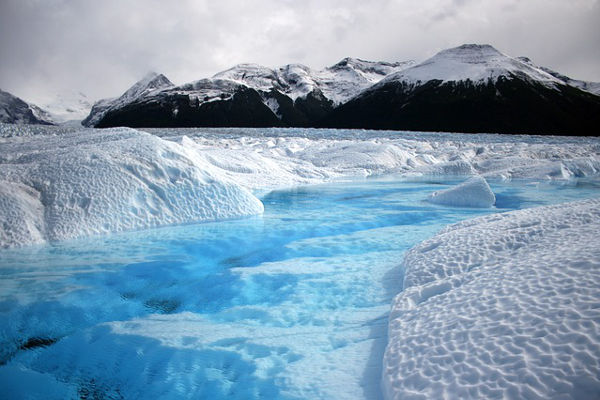
Patagonia is an incredibly varied trekking destination. This is a true natural wonderland where condors soar and volcanos smoke. Patagonia hiking trails offer, in my opinion, some of the best treks in South America !
In 2022 I was lucky enough to spend a few months in Patagonia hiking and exploring.
Below I've provided an overview of useful information that will help you choose and plan your Patagonia hike. Where appropriate, you will find links to in-depth guidance articles on popular hikes like the Fitz Roy , W trek and O Circuit .
But before I jump in, let's briefly look at why I love Patagonia.
Why Go Hiking In Patagonia?
Patagonia is one of the leading trekking destinations in the world, and it’s easy to see why! If you need any further motivation, read on. These are a few reasons why travelers rate Patagonia trekking so highly.
Patagonia Hiking Landscapes
Lying on South America’s southern frontier and covering some 400,000 square miles, Patagonia is a wild landscape that is both barren and beautiful.
If you chose to trek in Patagonia, you will find wide open spaces, places with beautiful mountains , towering granite spires, and pristine rivers.
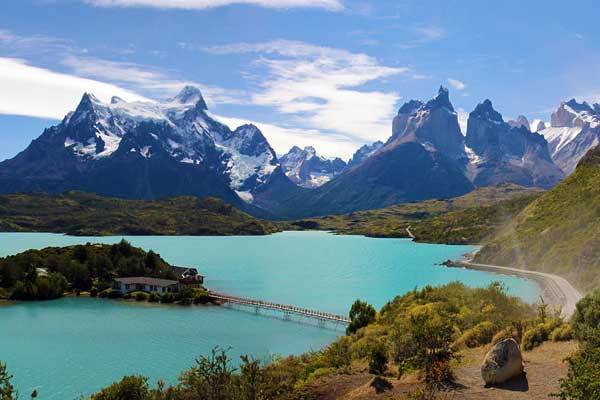
Patagonia is without a doubt a land of extremes. In the west, the land is home to some of the most beautiful temperate rainforests on the planet whilst the east experiences some of the most ferocious winds in the Americas. Patagonia is also home – quite surprisingly – to the world’s seventh-largest desert.
Patagonia Wildlife
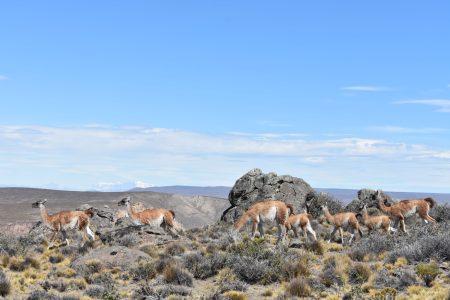
Guanacos in Patagonia National Park
Nature enthusiasts are no doubt wondering what animals you will see along the trails of Patagonia. The answer is a lot.
No matter where you hike in Patagonia, you are sure to see an abundance of birdlife. Look out for different woodpecker species in the forests and an abundance of waterbirds around the rivers and Lagunas. Massive condors are often spotted soaring above the desert.
The seemingly barren lands alongside the roads of southern Argentina are home to a surprising array of creatures. You can’t miss the thousands of shaggy guanacos. If you pay attention, you will probably also spot some foxes and even skunks.
I lucked out on my Patagonia backpacking trip. Not only did I get to see a Huemel (an endangered Chilean deer), but also had a face-to-face encounter with a Puma!
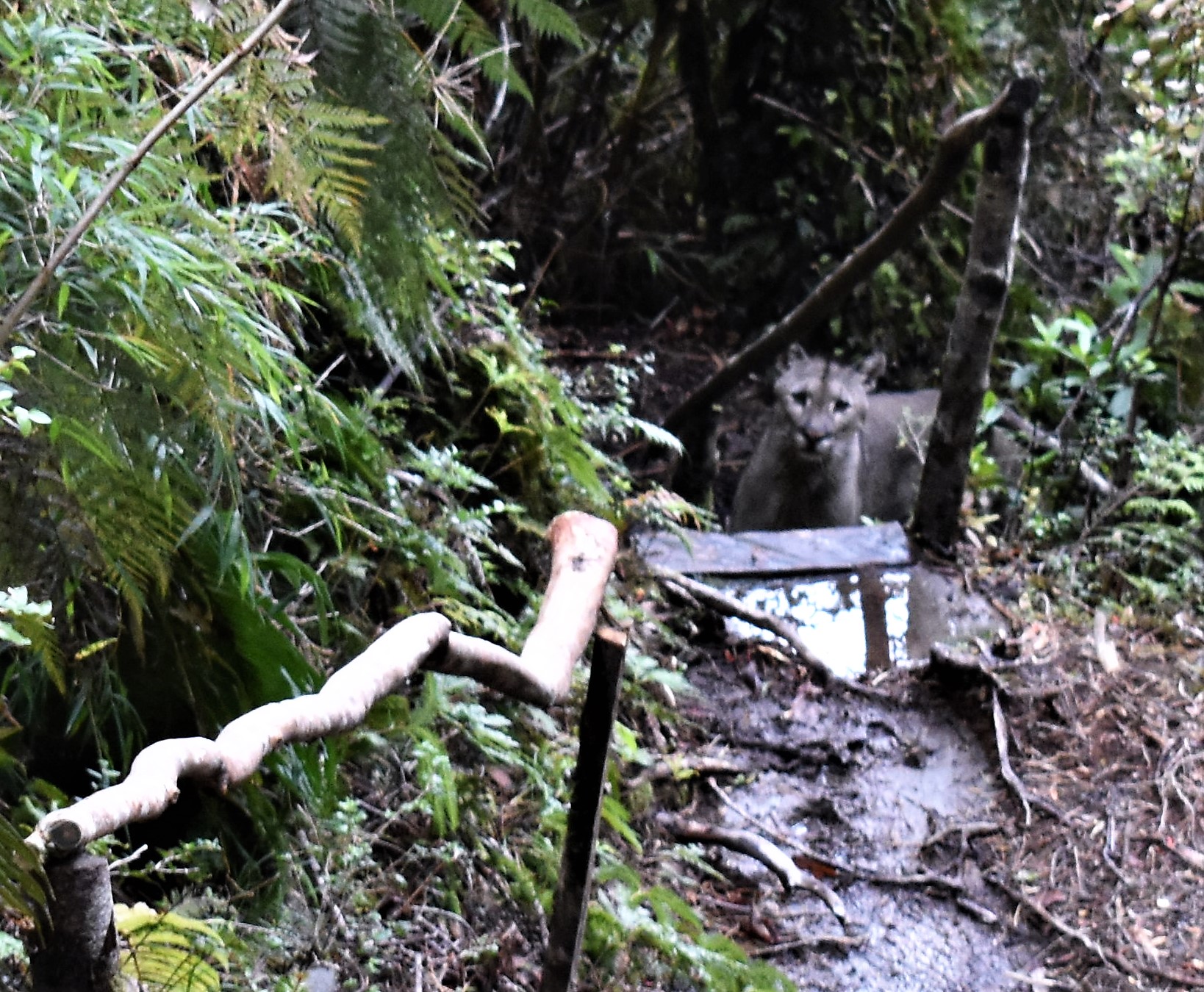
I managed to take a -not very good- pic of the curious cat
You can increase your chances of animal sightings by getting out early and always paying attention to your surroundings. However, luck plays a big role!
Patagonia Hiking Trails Are Easy To Follow
Almost all major treks in Patagonia are on well-worn trails. There is very little chance of getting lost. Even the lesser-known routes had some of the clearest markings I’ve seen anywhere.
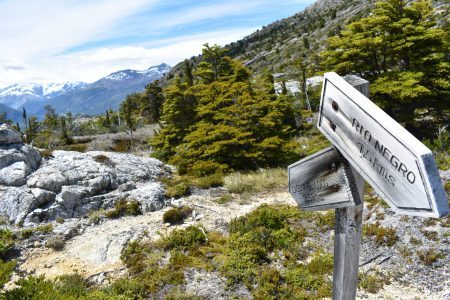
A trail marker along one of Chile's many hiking routes
Ranger huts are dotted along the bigger trails. The park authorities put a lot of effort into keeping the trails clear and taking care of the infrastructure. This is why you shouldn’t complain about paying the entrance fee required for most reserves.
Popular Hiking Routes in Patagonia
Being such a wild and beautiful landscape, Patagonia is packed with literally hundreds of trekking routes. There are hundreds of options for day hikes and multi-day treks.
The three most popular trekking routes in Patagonia are the Torres Del Paine Full Circuit Trek, the Torres W Trek, and the Fitz Roy Trek. All three treks offer something very different in terms of landscapes and difficulty.
Below is a brief description of each route.
Torres Del Paine Full Circuit Trek
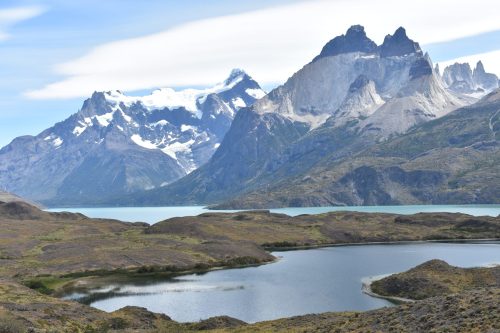
Torres Del Paine National Park
One of the greatest and undiscovered treks on earth, the Torres Del Paine Full Circuit is a brilliant mix of stunning landscapes and unrivalled panoramic views.
The trail is 130km long and trekkers generally take 7 to 9 days to complete it, although often more experienced trekkers do it in less than 5 days!
Torres del Paine National Park was designated a World Biosphere Reserve by UNESCO in 1978 and is home to some of the most diverse flora and fauna in South America.
The Full Circuit leads trekkers on the standard W Trek before continuing around the back end of the park to Refugio Dickson. Hikers then climb up and over John Gardner Pass before descending back down to Campamento Grey.
See my complete guide to the Torres del Paine O trek.
Torres Del Paine W Trek
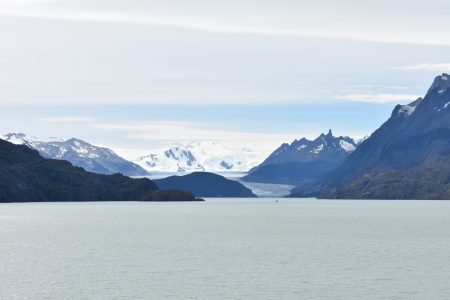
Grey Lake with Grey Glacier in the background, the start of the W Trek
Probably the most popular trek in Patagonia, the Torres Del Paine W Trek is fast becoming one of the most well-respected short hikes in the world due to the trail’s incredible scenery.
The trek generally takes in the region of 5 days to complete (depending on fitness) and leads visitors into the very heart of the national park through vibrant forests, soaring granite peaks, and colossal glaciers.
The trail is 100km long and begins with an excellent boat ride near the Grey Glacier and finishes with a beautiful sunrise at the famous Torres on the last morning.
Fitz Roy Trek
One of the most well-known mountains in South America , Mount Fitz Roy has been an emblem of Patagonia for many years.
At 3,375m, the jagged granite spines as you enter the small village of El Chaltén. Also known as Cerro Chaltén, Mount Fitz Roy is located on the border between Argentina and Chile on the Southern Patagonian Ice Field.
The Fitz Roy hike is generally around 30km in length and takes 3-4 days to complete depending on how much walking you wish to do each day.
Best Short Hikes in Patagonia
Although Patagonia is home to some incredible multi-day hikes, there are actually countless shorter hikes available for visitors with a little less time on their hands.
Day hikes to Mount Fitz Roy are extremely popular as you can get the classic peak photo to take home!
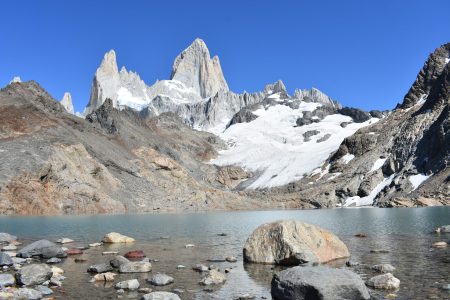
Mount Fitzroy view from Laguna Los Tres. One of Patagonia's most famous sights!
There are also some fantastic short hikes if you want to visit a glacier, such as the Cerro Castillo Glacier walk and the El Morado Glacier Trek.
See our guide to Patagonia day hikes .
Planning Your Patagonia Trek
Here are some of the key considerations when hiking Patagonia.
Chilean Patagonia Vs Argentinian Patagonia
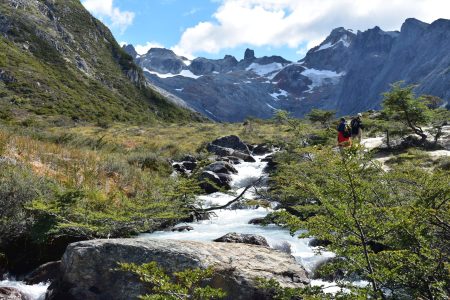
A short and popular trail to Laguna Esmeralda outside Ushuaia
Patagonia overlaps the border into the southernmost parts of Chile and Argentina. Despite being close to each other, the two sides are pretty distinct. Luckily, it is easy to cross the border and spend time in both countries. Patagonia Argentina is the more popular region for tourists. As a result, the trails get very busy over peak season (November-March). Between mountains, the landscape is surprisingly flat, dry, and rocky. Route 40 is a popular road for motorcyclists. Argentina is home to some of the most famous places for hiking in Patagonia. These include El Chalten (Fitz Roy) and Ushuaia. By contrast, Chilean Patagonia is much greener and more mountainous. The Caraterra Austral is the only main road through this region. It runs from Puerto Montt and ends in O’ Higgens. Along this route, you will find gushing waterfalls, fjords, thriving forests, and even volcanos. To be honest, I fell in love with the Chilean side of Patagonia. The trails are uncrowded and there are a ton of hidden gems to discover. The Caraterra Austral is probably also the safest and easiest road in the world for hitchhiking. This is a great way to meet people and practice your Spanish.
Torres Del Paine, probably the most famous Patagonian park, is on the Chilean side.
Do I Need To Book In Advance When Hiking In Patagonia?
The more popular routes often limit the number of trekkers and you’ll need to book early to avoid disappointment. Campsites also book up early and you’ll often need to prove you have a booking to obtain a permit – this is only necessary on certain treks, particularly in the Torres Del Paine region.
A good rule of thumb is to always assume you will need an advance booking. For small reserves, you can get these on the same day but often need to reserve online.
Where To Sleep When Hiking In Patagonia
If you have booked a multi-day trek in Patagonia, chances are your only accommodation options are in tents. Campsites along famous routes like the W and O Treks in Torres Del Paine need to be booked well in advance online.
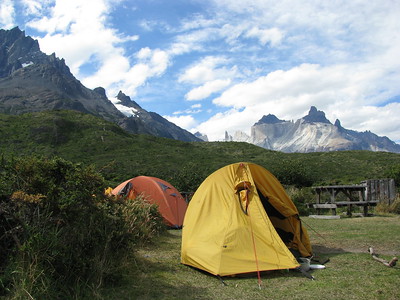
Camping is the cheapest form of accommodation in Patagonia - photo credit: Inacio Gueberoff
If you are on a tight budget, camping is the most affordable option to stay in towns close to the trails. Most official campsites cost around $10 a night and include bathrooms.
Some campsites have a small kitchen. However, I would recommend traveling with your own camp cooking equipment .
You can find a fair amount of free campsites throughout the region. If you download Maps Me app , you will see these free sites are marked. This is generally a great app to have while backpacking Patagonia. It shows many of the trails, even those which are not marked well.
Hostels, Hospedajes and Refugios
Hostels are always a great option for budget travelers. Most towns have some sort of hostel accommodation where you can spend the night before or after a hike. On hikes in Patagonia, you will be able to find refugios. These small, locally run accommodations are particularly common on the Argentina side. As well as being warmer and more comfortable than a tent, Refugio owners usually cook delicious local meals. This ‘luxury’ comes with a much higher price tag than a hostel. I’d recommend staying in a nice refugio at least once for the experience. If you are visiting Chilean Patagonia, you are bound to see hospedajes. Hostels are not so common in these parts. Hospedajes offer small and simple private rooms with access to a kitchen and bathroom. You can also usually buy meals at an extra cost. Chilean hospedajes were some of my favorite places to stay on my travels. The owners are welcoming and there is always a wood stove burning! These help a lot if you need to dry your soaked hiking gear.
When is the Best Time to Trek In Patagonia?
The brilliant thing about trekking in Patagonia is that all of the treks never reach high altitudes, therefore the region is made accessible all year round.
To give you a sense of the seasons, we have written an overview of each below. See more detailed information on the best time to hike Patagonia .
Spring - September to November
If you want warm, clear weather but without crowds, this is the perfect time of year to visit the park.
Although it’s certainly not as warm as the high summer months, the skies during Spring are still clear and you’ll get incredible views across the wild landscapes.
Spring is also the best season to see flowering flora in the region as well as wildlife breeding season.
Summer - December to March
This is the high season for both temperatures and tourists. The trails are at their capacity during this period and the parks often feel quite busy.
However, the trade-off is fantastic weather to travel in. The summer months are also the time in which alternative activities such as horse riding, mountain biking, and kayaking are possible. Probably the best period for the active type or for inexperienced trekkers.
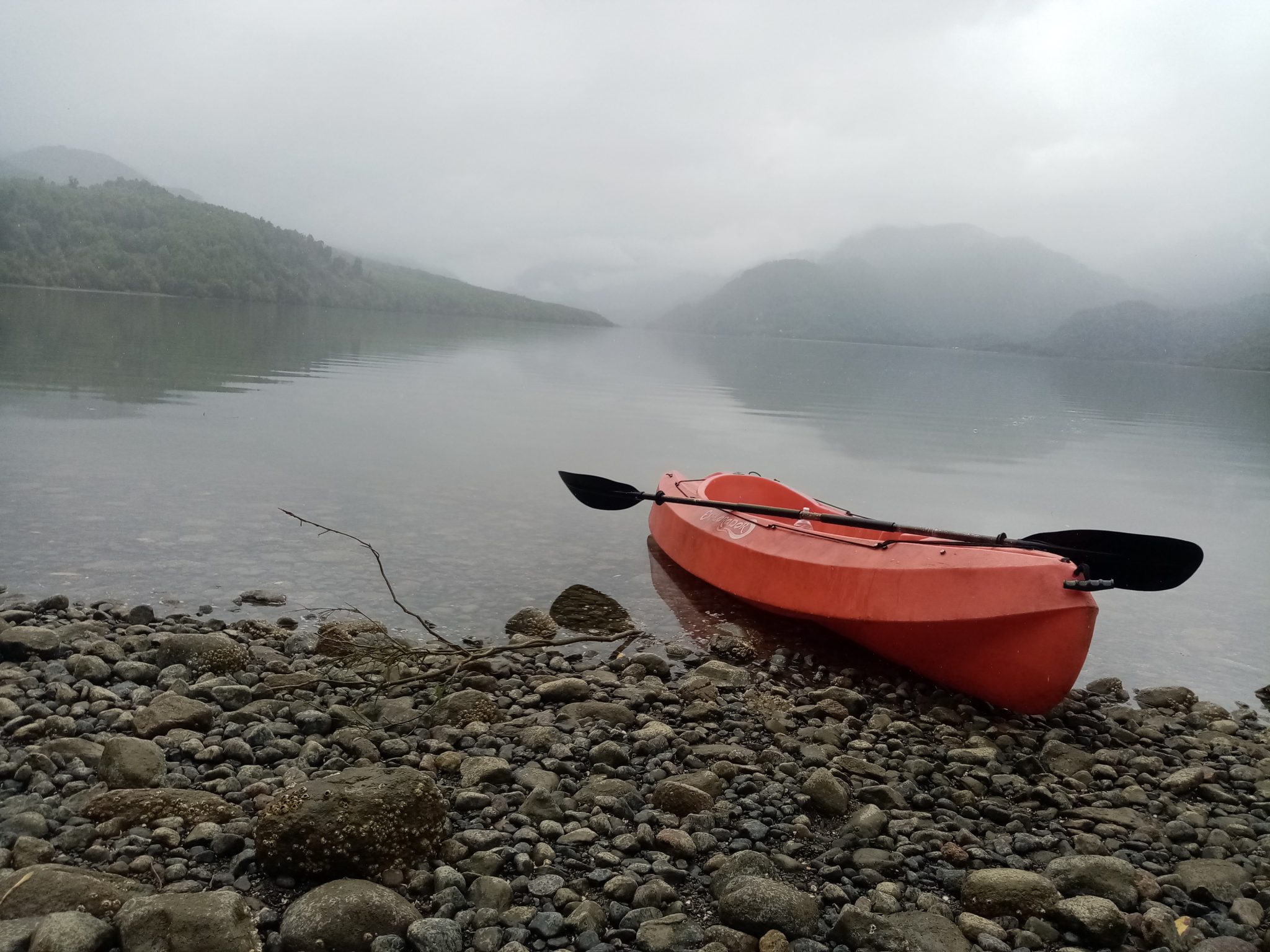
You can rent kayaks or book kayaking tours in some places in Patagonia - This was on a misty morning kayaking the fjord in Puyuhuapi, Chile
Fall - March to June
Probably my favourite season. The landscape simply comes alive with blazing colours as the trees and grasses begin their journey into winter.
The trails also begin to empty out during the Fall and the clear landscape views are still common. Be wary though, ferocious winds are frequent during this period and you’ll need to bring the appropriate gear.
Winter - June to August
Although the majority of refugios are closed during this period, this season is certainly the quietest and you’ll often have the trails to yourself.
This is also the coldest period with strong winds, frequent storms, and wintery nights. Most suitable for hardy trekkers who are looking for a quiet experience in the wilds of Patagonia.
Packing List: What Gear Do I need to Trek in Patagonia?
The trekking gear you choose to take with you to Patagonia will very much depend on what route you intend to take and what season you intend to trek in.
To help you prepare we have provided a comprehensive multi-day trek packing list .
The packing list provided includes a number of essential trekking items. The gear we recommend has been tried and tested by countless trekkers and will serve you well on any multi-day trekking experience.
If you plan to trek in Patagonia independently then you’ll need to keep your backpack weight down. Many of these items such as sleeping bags, tents, trekking poles, etc. can be rented at park entrances across Patagonia. However, I strongly recommend bringing the the important pieces of kit
What Does Patagonia Trek Cost? What Permits Do I Need?
Tourists entering Chile and Argentina from America and the UK do NOT need a visa if the intended trip is under 90 days. If you plan to stay longer than three months then you will need to consult with your local embassy as to the policies regarding this.
Honestly, the easiest thing to do is make a quick border crossing to the other country and return for a renewed 90 days. The authorities are well aware that tourists do this and are not too bothered. However, things change quickly in these parts so best to double-check. Depending on where you plan to trek, a trekking or park permit may be needed. For instance, trekkers looking to hike in Torres Del Paine National Park are required to have a permit which needs to be booked and paid for online. You will also need to produce proof of campsite bookings. If trekking with an operator this should all be taken care of by them prior to your trip – always check though. For the Fitz Roy trekking region there is no permit required.
Recommended Patgonia Guidebook
The Lonely Planet Trekking in the Patagonian Andes (Travel Guide) is one of the most detailed, yet an easy-to-digest guide to the Patagonian Andes. It has most of the treks and routes in it.
About the author
Alison Macallister
With a degree in Nature Conservation and experience working with wildlife including the Big 5, Alison used to work as a guide for a 5-star safari reserve in South Africa. Today she is a full time traveller and editor for Mountain IQ. She has travelled and hiked extensively in South America, including many solo hikes in Patagonia, the Cusco region of Peru, Ecuador and Chile.
Leave a Reply
Your email address will not be published. Required fields are marked
simple and clear blog and the easiest I found yet after searching blogs and sites for nearly a month I am an experienced solo traveller with flexibility approach so the blog is perfect for me
Hi Ghada, glad that you have found this useful!
We work with local guides to offer great value adventures at unbeatable prices

Hiking in Patagonia: Your Ultimate Guide to Scenic Trails & Multi-Day Treks
Everything you need to know about hiking in Patagonia, from Torres del Paine to El Chalten: when to visit, best hikes, how to plan and what to pack.
Are you ready to embark on the adventure of a lifetime? Patagonia beckons hikers from around the globe. Situated in the southern regions of Chile and Argentina, this remote corner of our planet boasts awe-inspiring landscapes, challenging trails and unique wildlife. From the iconic Torres del Paine to the hidden gems of Ushuaia, Patagonia has something for everyone.
Whether embarking on a scenic trail or multi-day hike, you can expect a treasure trove of windswept landscapes, jagged granite spires, immense glaciers, and some of the largest ice fields on Earth. In this ultimate guide to hiking in Patagonia, we’ll equip you with all the information you need to plan your dream trek.
This article contains affiliate links from the Amazon Associate and Travelpayouts programs. Wild Travel Tales will earn from qualifying purchases, at no extra cost to you .
The Best Time to Go Hiking in Patagonia
Before we dive into the specific treks, let’s talk about the best time to visit Patagonia. Each season offers a unique experience, and your choice will depend on your budget, tolerance for different weather conditions and other travel plans. In this section, we’ll delve into the weather patterns, seasons, and the ideal months for hiking in Patagonia.
Generally, the period from early November to late April is considered ideal for hiking. If you prefer milder temperatures, aim for February and March. For the full spectrum of Patagonian beauty, visit in late March to mid-April when the region is painted in stunning autumn colours. However, Patagonia’s weather is known for its unpredictability, so be prepared for sudden changes.
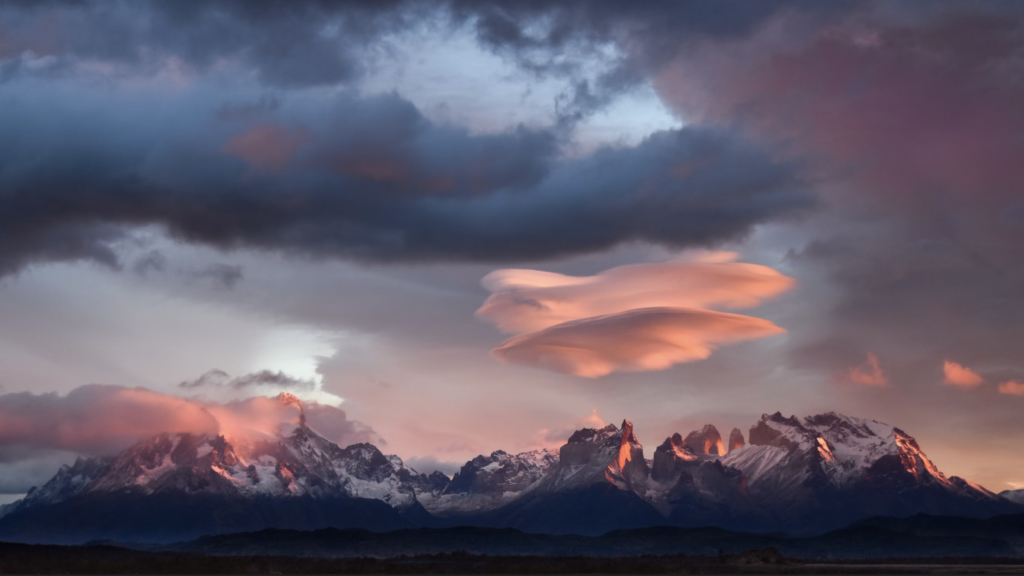
Weather in Patagonia
The weather in Patagonia is famously unpredictable, and understanding its patterns is vital for planning your trek. You can experience all four seasons in a single day, any day of the year. As Patagonia’s weather can change rapidly, you must come prepared with appropriate gear for all conditions.
Proper preparation is key to a successful hike. While the information below acts as a useful guide, local ranger stations will be an invaluable resource for up-to-date weather forecasts and safety advice.
Summer (December-February)
- Summary: December through February marks the peak hiking season in Patagonia. This period is considered the most favorable time for travelers to explore the region due to milder weather and longer daylight hours. Fierce winds are common, sometimes reaching up to 120km/hour.
- Weather: During this time, temperatures are at their warmest and typically range from 15°C to 24°C (60°F to 70°F). The weather is relatively more stable and less extreme.
- Daylight: The days are long, providing ample daylight for exploration. This is especially important for trekkers who need sufficient daylight for their adventures.
- Crowds: Patagonia can get crowded during the peak season, especially in popular national parks and trekking areas. If you prefer a quieter and more secluded experience, you might want to explore less-visited regions or consider visiting during the shoulder season.
- Precipitation: Occasional precipitation, but typically less frequent and intense than in autumn. There are also reduced chances of snowfall.
- Trail accessibility: The majority of the trekking routes, including popular ones like the W Trek in Torres del Paine National Park, are fully accessible and well-marked during the peak season. Trails are less likely to be affected by snow and ice, making hiking conditions more manageable.
- Wildlife: Peak season coincides with the breeding and nesting seasons for many of Patagonia’s wildlife species. It’s an excellent time for birdwatching and observing animals like guanacos, foxes, condors, and even penguins along the coast.
Autumn (March-April)
- Summary: Autumn offers a quieter alternative to the bustling summer season. Hiking in Patagonia over this shoulder season will provide a quiet and unique experience.
- Weather: Slightly cooler temperatures than summer, with daytime temperatures ranging from 8°C to 15°C (46°F to 59°F) on average. The wind is also milder. However, temperatures can still drop significantly at night, so packing warm layers is essential.
- Daylight: Daylight hours start to decrease as autumn progresses. You can expect around 10 to 12 hours of daylight in March and slightly less in April. While this means shorter daylight for activities, it can also lead to stunning sunrise and sunset opportunities.
- Crowds: One of the significant advantages of traveling in Patagonia during March to April is the reduced number of tourists. The peak season crowds have mostly dissipated, making it easier to find accommodations and enjoy the wilderness in a quieter, more contemplative atmosphere.
- Precipitation: Higher levels of precipitation are possible, so waterproof gear is advisable. Additionally, some areas may experience the first snowfalls of the season, particularly in late April.
- Trail accessibility: Many trekking routes and trails remain accessible during March and April, but the conditions can be more challenging due to cooler temperatures and potential rain or snow. Some higher-altitude trails may become less accessible as snow accumulates.
- Wildlife: Patagonia’s wildlife remains active during the autumn months. You may have opportunities to see animals like guanacos, foxes, and birds as they prepare for the winter season. Additionally, this time of year can be ideal for birdwatching, as migratory species pass through the region.
Spring (September-November)
- Summary: Spring is an excellent time to explore Patagonia, as the region awakens from winter but before the tourist rush. During this time, you’ll witness the landscapes coming to life with blooming flowers and newborn wildlife. However, the weather can be quite variable and trails may still have some remnants of snow and mud.
- Weather: Spring in Patagonia is characterized by gradually warming temperatures. Daytime temperatures typically range from 8°C to 15°C (46°F to 59°F) in September and can reach 15°C to 20°C (59°F to 68°F) in November. However, be prepared for chilly nights, especially in September when temperatures can drop significantly.
- Daylight: Daylight hours increase as spring progresses. In September, you can expect around 11 to 13 hours of daylight, while in November, there are approximately 15 hours of daylight. Longer daylight hours provide more time for outdoor activities.
- Crowds: Traveling during spring allows you to avoid the peak summer crowds. While some tourists may start arriving in November, the region remains relatively uncrowded compared to the December to February period.
- Precipitation: Precipitation levels can vary, but spring tends to be less rainy than the autumn months. You may still encounter occasional rain showers, especially in September, so having waterproof gear is advisable. As the season progresses, rain becomes less frequent.
- Trail accessibility: Trail conditions in early spring can be challenging, with some lingering snow and muddy sections in higher-altitude areas. As the season advances, trails become more accessible and drier. Popular trekking routes like the W Trek are generally open, but it’s essential to check trail conditions and be prepared for variable terrain.
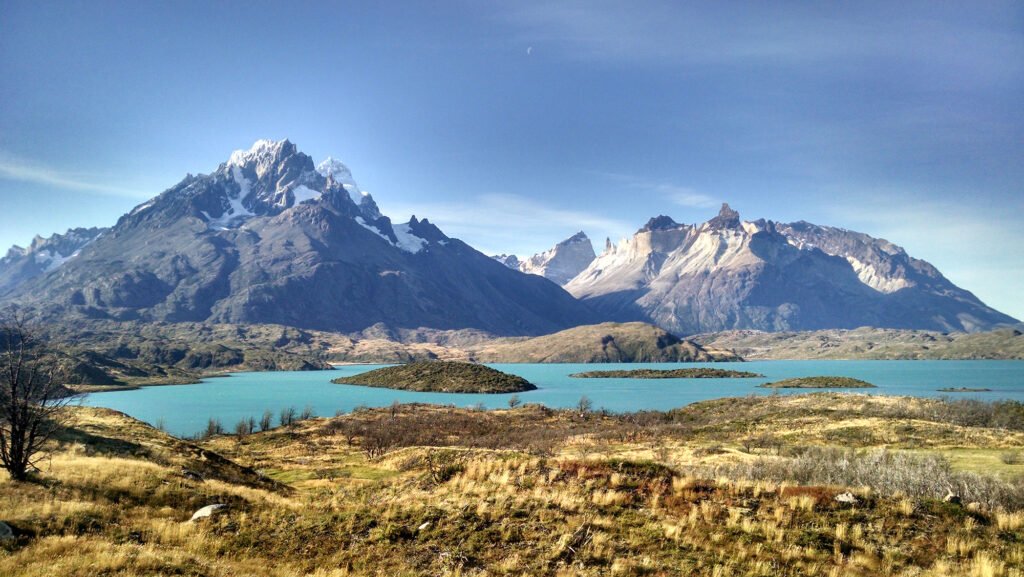
How Many Days Does it Take to go Hiking in Patagonia?
Determining the ideal duration for your Patagonian adventure depends on several factors, including your interests, fitness level, and the specific trails you plan to hike. Patagonia offers a wide range of hiking options, from day hikes to multi-day treks. Here’s a general guideline to help you plan:
- Day Hikes: If you have limited time or prefer a more relaxed experience, day hikes can be incredibly rewarding. Many of Patagonia’s iconic trails, such as Laguna de Los Tres in El Chaltén or Mirador Las Torres in Torres del Paine, can be completed in a day.
- Multi-Day Treks: For a more immersive experience, consider embarking on multi-day treks. The duration can vary significantly depending on the trail. The popular W Trek in Torres del Paine typically takes 4-5 days, while the more extensive O Circuit can span 6-9 days.
- Combination: To make the most of your visit, consider a combination of day hikes and multi-day treks. This approach allows you to explore the highlights while also delving deeper into the wilderness.
Remember that travel times between hiking destinations, rest days, and acclimatization are factors to consider when determining the duration of your Patagonian adventure. It’s advisable to plan for some flexibility in your itinerary, allowing you to fully immerse yourself in the stunning landscapes and unexpected discoveries that Patagonia has to offer.
Building in extra days also allows you to adjust your plans based on adverse weather conditions. Spending an extra night or two in a warm hostel, instead of braving the rain on a multi-day hike to ensure you keep to your itinerary, can make all the difference!
Getting to Patagonia
Patagonia spans both Chile and Argentina, and its vast wilderness is located in the southern reaches of these countries. Here’s a guide to help you reach Patagonia efficiently:
1. International Airports:
- Santiago, Chile: Many travelers fly into Santiago, Chile, for international arrivals.
- Buenos Aires, Argentina: Buenos Aires, Argentina, is another common international gateway to Patagonia.
2. Domestic Flights:
- Punta Arenas, Chile: If arriving in Santiago, consider taking a domestic flight to Punta Arenas, Chile, to minimize travel costs and time.
- El Calafate, Argentina: If departing from Buenos Aires, domestic flights to El Calafate, Argentina, offer convenience.
3. Bus Transportation:
- Connecting to Main Trekking Areas: Upon arriving in southern Patagonia, efficient and affordable bus transportation is readily available to connect you to the main trekking areas.
Hiking In Torres del Paine National Park
Now that we’ve covered essential planning aspects, let’s dive into the heart of Patagonia: Torres del Paine National Park. This iconic destination offers some of the most breathtaking hikes in the region. You can access the park via Puerto Natales .
Hiking to Mirador Las Torres
- Time Required: 8 to 9 hours
- Distance: 18km
- Difficulty: Moderately challenging with steep sections
- Start / Finish Points: Hotel Las Torres
- Highlights: Witness the famous Torres del Paine towers mirrored in the glacial lake
One cannot speak of hiking in Patagonia without mentioning Torres del Paine National Park. A must-visit for any trekking enthusiast, the Mirador Las Torres trail offers a challenging but immensely rewarding day hike. The path spans 18 kilometers and leads to the iconic Towers – three jagged peaks overlooking a turquoise lake. The last leg of the hike is steep, but the views are absolutely breathtaking. If you’re an early riser, consider starting before dawn to witness the iconic granite spires bathed in the fiery glow of sunrise.
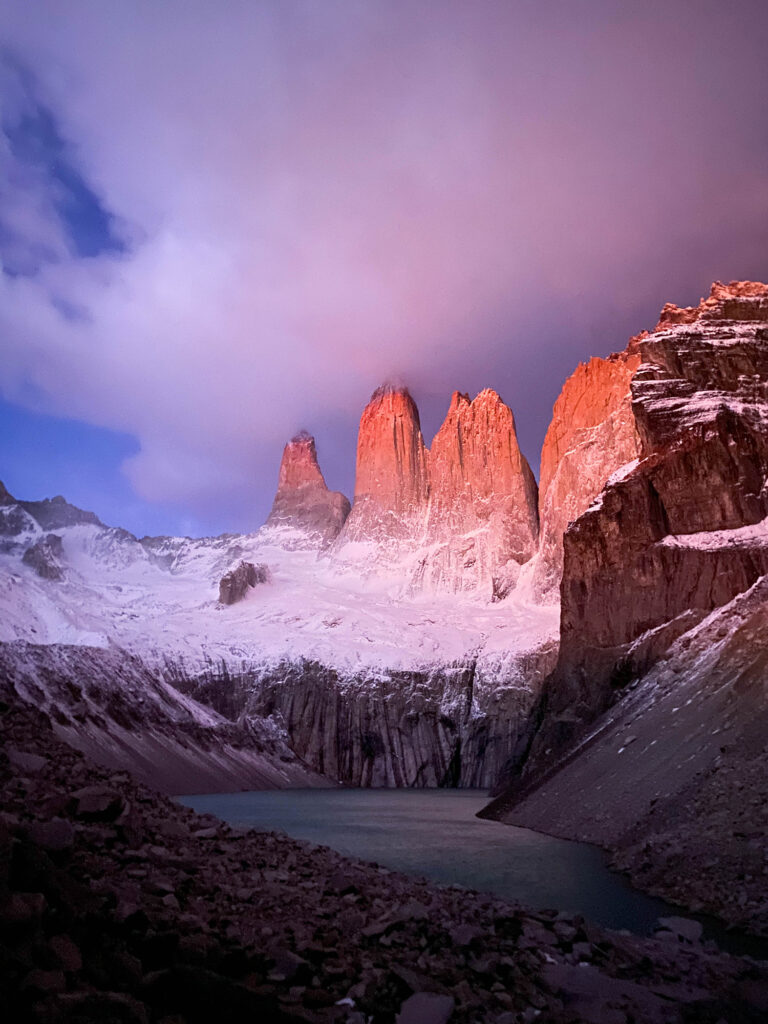
Lago Grey (Grey Glacier)
- Time Required: 3 to 4 hours
- Distance: 11 kilometers
- Difficulty: Easy to moderate
- Start / Finish Points: Mountain Lodge Paine Grande to Refugio Grey
- Highlights: Get up close to Grey Glacier’s stunning ice formations and ethereal blue glacier
For those craving a more relaxed hike with stunning glacier views, the Lago Grey trail is perfect. This 11-kilometer route takes you along the W Trek, offering glimpses of the awe-inspiring Glaciar Grey and its floating icebergs. The terrain is relatively easy, with a few tricky sections. If you’re in the mood for camping, you can spend the night at Mountain Lodge Paine Grande or Refugio Grey and enjoy the serene surroundings.
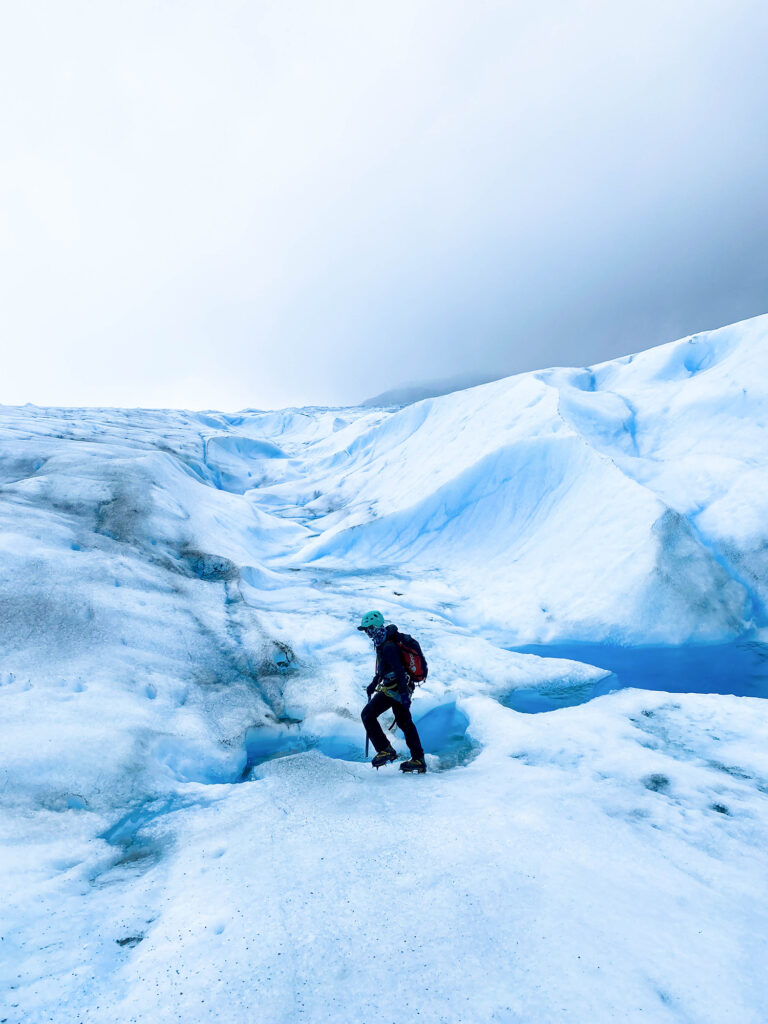
Valle del Frances (The French Valley)
- Distance: 12km
- Difficulty: Moderate
- Start / Finish Points: Refugio Los Cuernos
- Highlights: Jaw-dropping vistas of the granite peaks and hanging glaciers
Prepare to be mesmerised by the beauty of the French Valley, which offers breathtaking panoramic views of the Paine Massif. This moderate hike takes you between Cerro Paine Grande and Cuernos del Paine, following the Rio Frances. The highlight of this trail is the frozen waterfalls, a sight to behold. Although the path can be challenging, the rewards are ample. The Mirador at the end provides breathtaking views of the surrounding mountains and tarns reflecting the scenery.

Los Cuernos Trail
Offering a fantastic day hike, the Los Cuernos Trail winds its way around the stunning Lago Nordenskjold. You’ll be treated to incredible vistas of Cuernos del Paine and the lake’s clear waters. For those with extra energy, consider exploring the Valle del Frances, an additional 12-kilometer section known for its beauty. Camping options are available on the south side of Cuernos Del Paine if you want to extend your hike.
- Time Required: 6 hours
- Distance: 22km
- Start / Finish Points: Hotel Las Torres to Refugio Los Cuernos
- Highlights: Diverse landscapes and stunning views of the Cuernos del Paine

- Time Required: 4 to 5 days
- Distance: Approximately 50-70 kilometers (31-44 miles)
- Difficulty: Moderate to challenging, with steep ascents and variable weather.
- Start / Finish Points: Typically, the trek begins and ends at the administrative center of Torres del Paine National Park, near Laguna Amarga.
- Highlights: The “W” Trek in Torres del Paine National Park encompasses Mirador Las Torres, Lago Grey, the French Valley, and Los Cuernos, making it a comprehensive hiking experience.
Hiking the W Trek in Torres del Paine National Park is a bucket-list adventure for nature enthusiasts, offering a chance to immerse yourself in Patagonia’s pristine wilderness and witness some of the world’s most awe-inspiring natural wonders. You can also go ice hiking on Grey Glacier , a unique and unforgettable experience. Various accommodation options are available along the route, including campsites and mountain lodges (refugios). Reservations should be made in advance, especially during the high season. Plan ahead, pack appropriately, and embark on this unforgettable journey through Chile’s breathtaking landscapes.
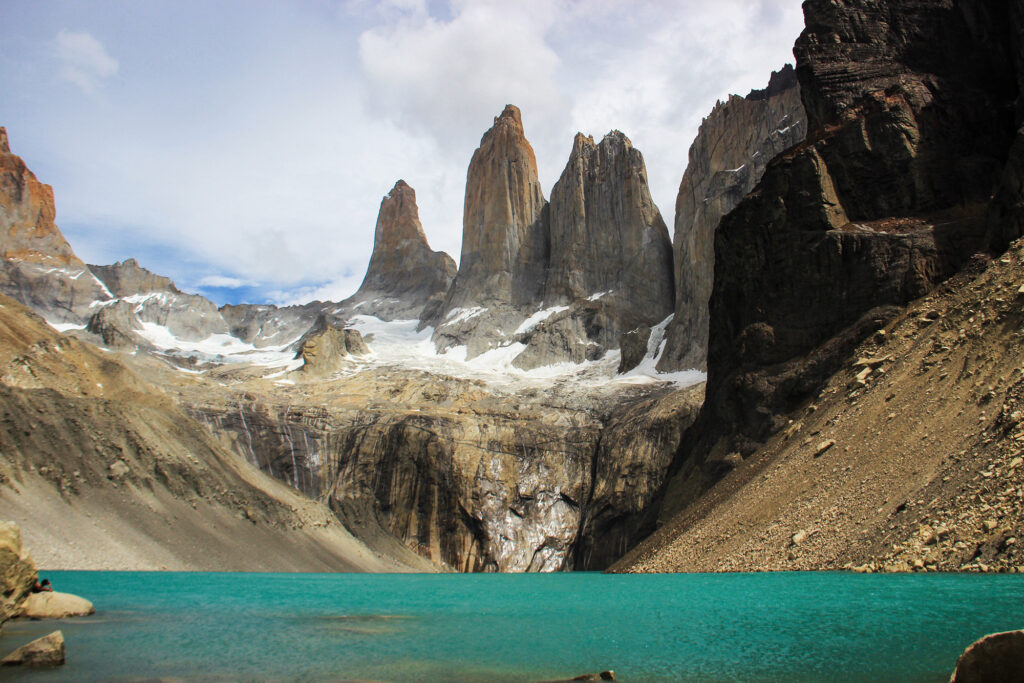
The O Circuit
- Time Required: 6-8 days
- Distance: 135km
- Difficulty: Hard
- Highlights: In addition to the sights of the W Trek, you will also see John Gardner Pass, Grey Glacier Peninsula, Paso los Perros
Considered one of the world’s best treks, the O Circuit is a must for adventurous souls. It is an extension of the W Trek, following the same trail for 4-5 days before continuing in a loop. It is a more remote, immersive wilderness experience that takes you deeper into Torres del Paine National Park.
This 135-kilometer circuit encompasses pristine forests, meadows of wildflowers, grand peaks like Cerro Paine and Cuernos del Paine, and even the iconic Las Torres. Starting at Hotel Las Torres and heading to Campamento Seron, you’ll encounter ever-changing landscapes and breathtaking scenery. Side trips to the French Valley and Las Torres are highly recommended, and you can finish your journey at Mountain Lodge Paine Grande or Lago del Toro.
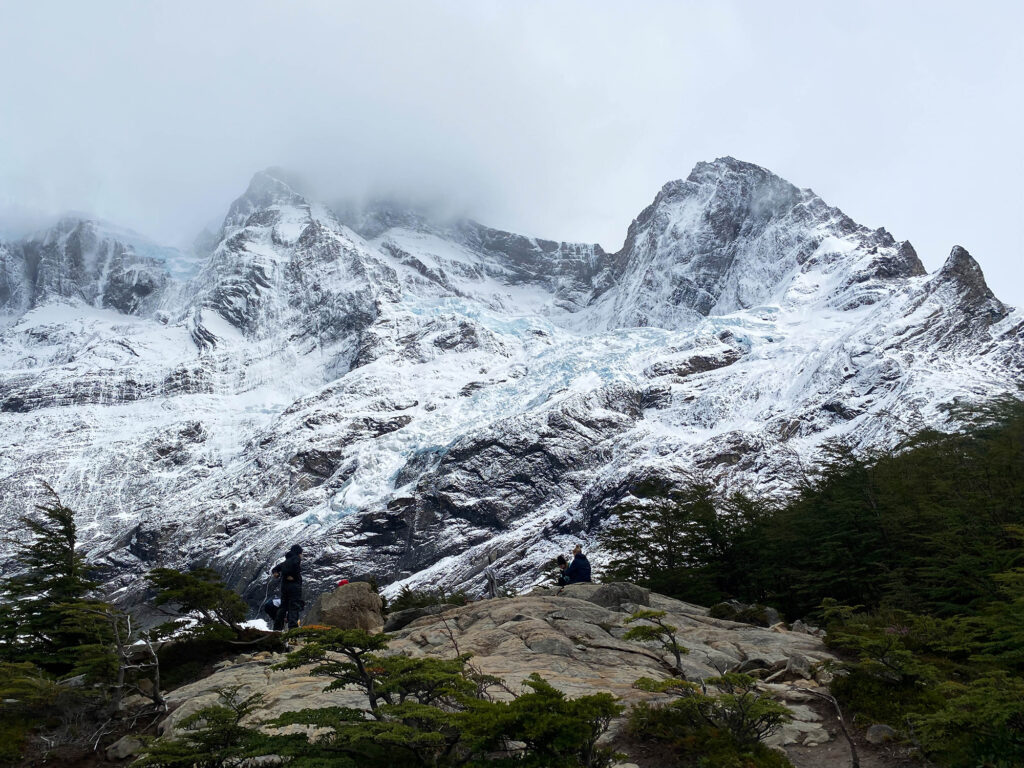
Hiking in El Chalten
While Torres del Paine is undeniably stunning, El Chalten has its own charm. It is a beloved destination for backpackers, offering unparalleled hiking opportunities amid stunning landscapes. Here are some of the best hikes in El Chalten .
Short Hike to Condor Lookout
- Time Required: 1 hour
- Distance: 2km
- Difficulty: Easy
- Start / Finish Points: El Chalten
- Highlights: Panoramic vistas and potential condor sightings
A short but sweet hike, the Condor Lookout offers unexpected views of Viedma Lake framed by snow-covered peaks. This is an excellent option for a sunrise hike, allowing you to witness the alpine glow on the mountains. The trail is gradual, making it accessible for most hikers.
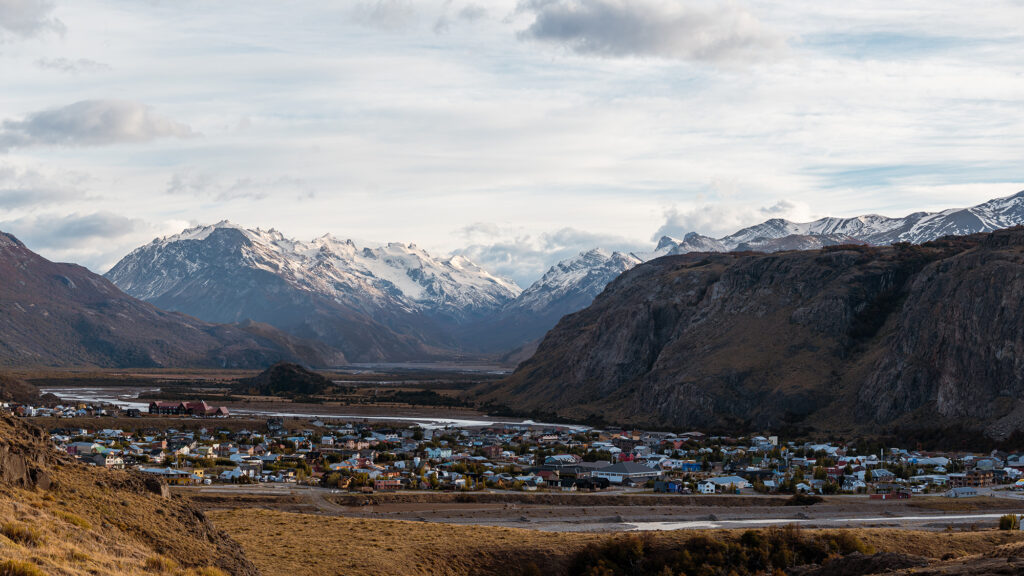
Day Hike to Laguna de Los Tres (Base Of Mt Fitz Roy)
- Time Required: 8 hours
- Distance: 26km
- Start / Finish Points: Northwest end of El Chalten
- Highlights: The incredible sight of Mt Fitz Roy mirrored in the lake
You cannot go hiking in Patagonia without visiting Mt Fitz Roy. For those seeking an up-close encounter with Mt Fitz Roy, the Laguna De Los Tres hike is a must. Starting early is advisable to catch the morning alpine glow. The trail begins gently, passing through forests, but the last hour involves a steep ascent. Your reward? The mesmerising Laguna De Los Tres with Fitz Roy towering above. If you’re up for it, consider climbing Cerro Madsen for even better views.
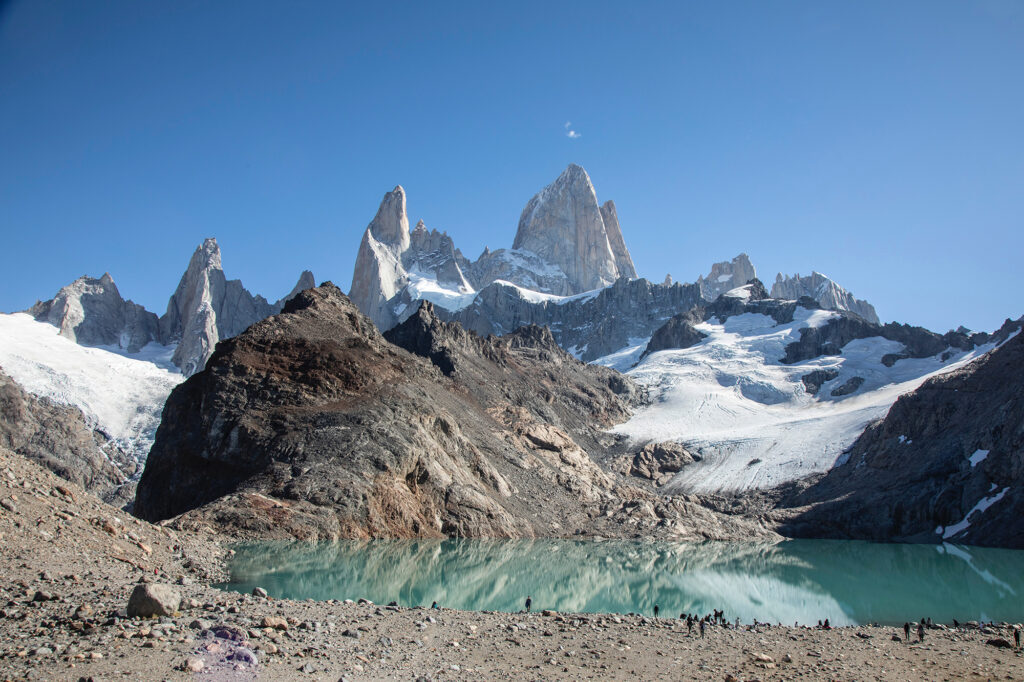
Day Hike to Laguna Suica
- Time Required: 1-2 days (can be done as a day hike)
- Distance: 19km
- Difficulty: Moderate to difficult, with some scrambling and rock climbing required
- Highlights: Scenic views of Mt Fitzroy and surrounding mountains, looming over a sparkling blue lake, with no crowds!
If you’re looking for expansive views of Mt Fitz Roy without the crowds, this is the hike for you. Instead of taking the ascent to Laguna de Los Tres, veer off the beaten path to Laguna Suica. This option offers arguably better views, and you’re likely to have the whole lake to yourself!
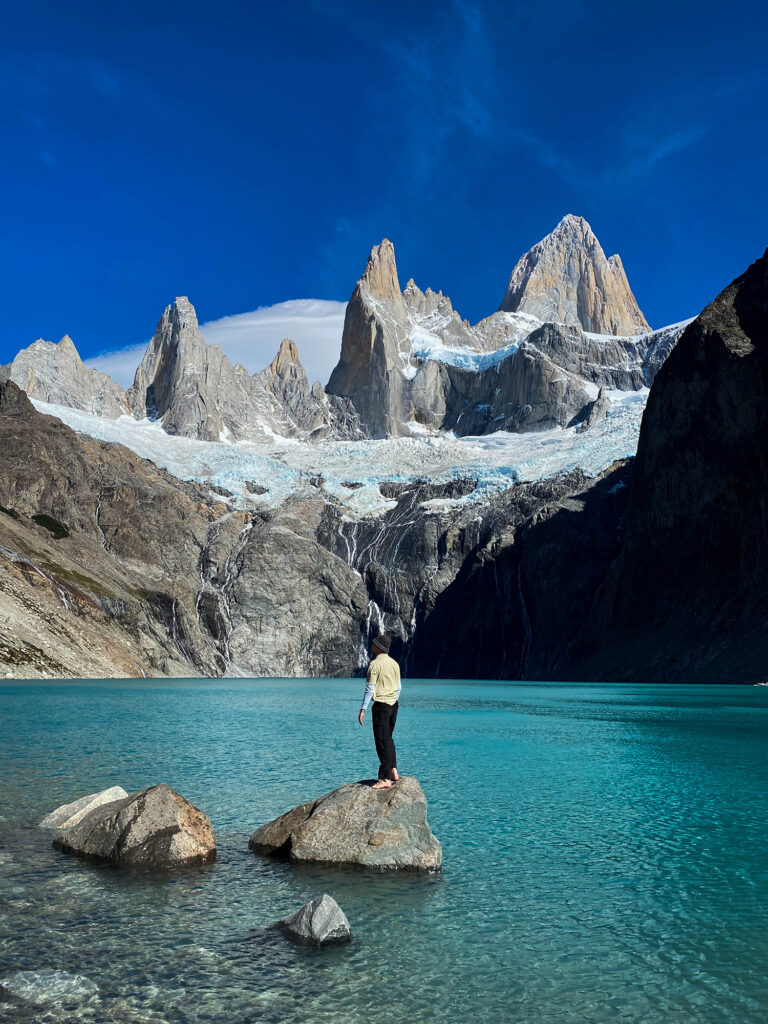
Day Hike to Cerro Torre
- Highlights: Views of Cerro Torre and its surrounding spires
Cerro Torre, reaching 3102 meters into the sky, is a sight to behold. This 2-day hike takes you through lush meadows, ever-changing glaciers, and offers stunning views of Cerro Torre and its neighboring peaks. A side trip to Mirador Maestri adds even more beauty to your journey. Return the same way you came, or camp at Campamento de Agostini for an immersive experience.
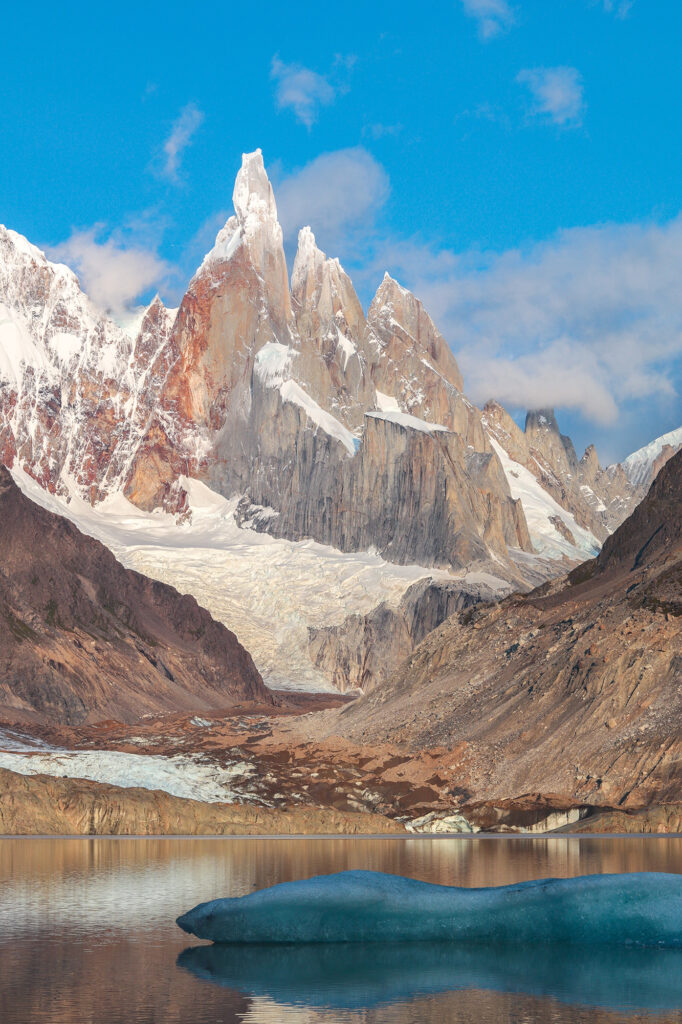
The Huemul Circuit
- Time Required: 4 days
- Distance: 63km
- Difficulty: Difficult, for advanced hikers
- Highlights: Panoramic views of Southern Patagonia, including Laguna Toro, Paso del Viento, Paso Huemul and Lake Viedma
The Huemul Circuit is not for the faint of heart, but it rewards intrepid hikers with a unique Patagonian experience. This trek takes you through breathtaking landscapes, including the majestic Mount Huemul and the Southern Patagonian Ice Field. It is known for its challenging terrain, river crossings, and rugged paths.
It’s a trek for those seeking adventure, and the relative isolation of the route ensures a sense of solitude and connection with the wilderness.
While hiking the Huemul Circuit, you may encounter a variety of wildlife, including guanacos, condors, foxes, and numerous bird species. The trek also takes you through diverse ecosystems, from lush forests to alpine meadows.
Be prepared for a difficult hike, but the views are worth every effort. Hiring a local guide is advisable for this demanding trek.
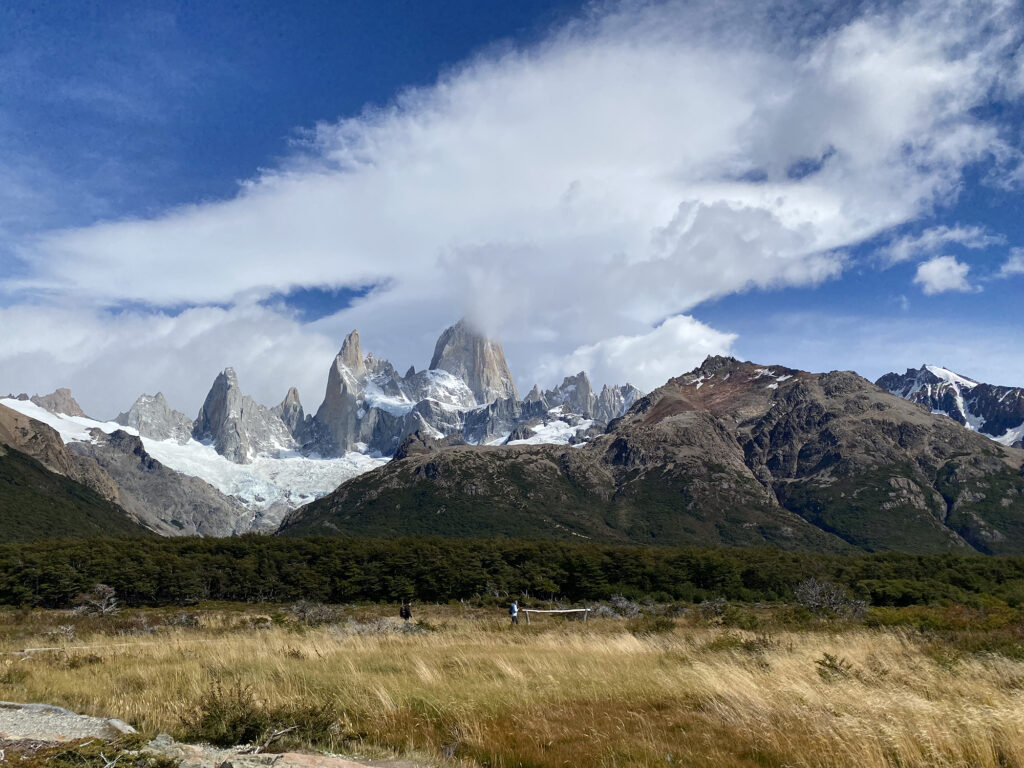
Best Hikes in Ushuaia
Located at the southernmost tip of Argentina, Ushuaia is known as ‘the end of the world’. It is the furthest of your options when hiking in Patagonia, but the views are totally worth it. Besides being a gateway to Antarctica, it offers some fantastic treks.
Laguna Esmeralda
- Distance: 9km
- Start / Finish Points: Refugio Valle Los Lobos
- Highlights: The stunning emerald-colored lake and surrounding landscapes
For a short but sweet hike, Laguna Esmeralda is a striking turquoise lake nestled amidst snow-capped peaks. This 9-kilometer trail leads to the base of Glaciar Del Albino, with an option to continue onto the glacier if you’re up for it. The refugio near the lake allows you to soak in the stunning views.
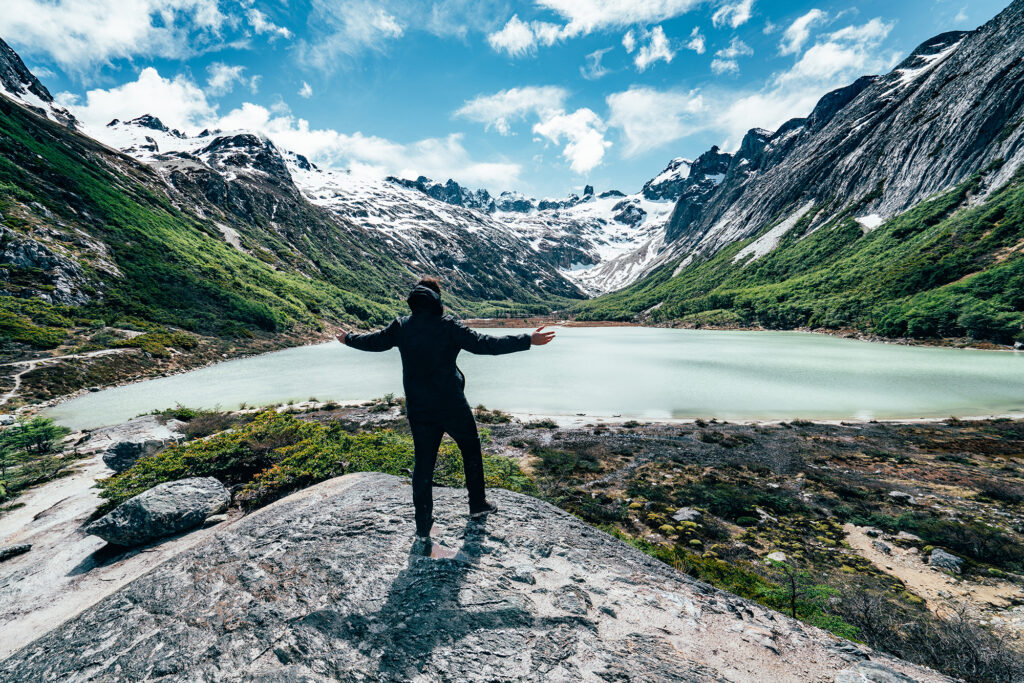
Glaciar Vinciguerra
- Time Required: 5 to 6 hours
- Distance: 13km
- Start / Finish Points: Tubera Valle Andorra
- Highlights: Close encounter with a glacier and pristine alpine scenery
The Glaciar Vinciguerra trek takes you to a series of glacial lakes with steep ascents, making it a satisfying challenge for a day hike. You’ll encounter Laguna Encatada, surrounded by lush meadows and rugged peaks. If you’re feeling adventurous, climb Cerro Esfinge for even better views.
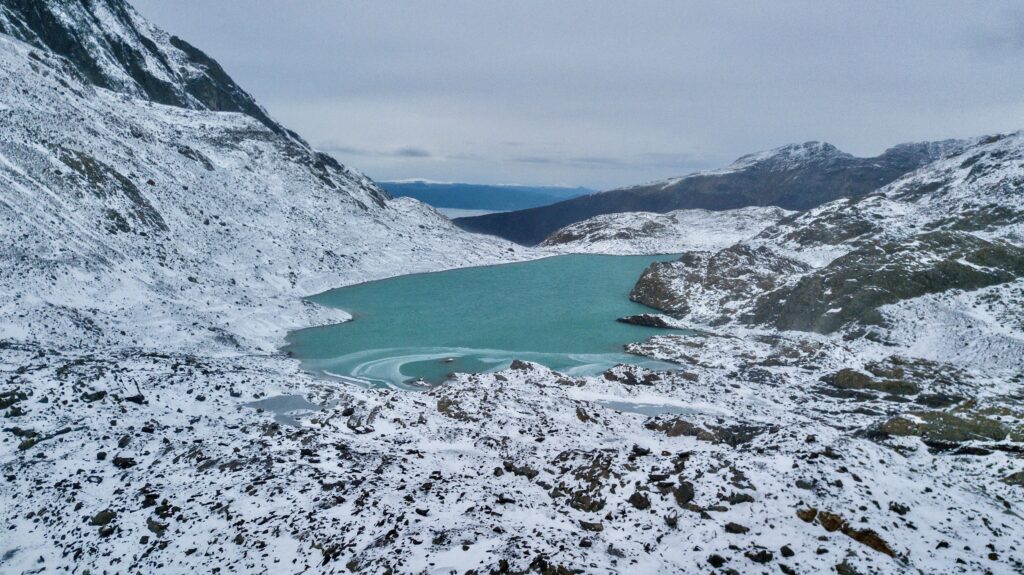
Sierra Valdivieso Circuit
- Distance: 48.5km
- Difficulty: Demanding
- Start / Finish Points: Ruta Nacional 3 or Posada del Peregrine
- Highlights: A multi-day trek encapsulating all the highlights of Ushuaia
Deep within the Fuegian Andes lies the Sierra Valdivieso Circuit, one of the most challenging treks in Argentina. This trek takes you through snowy peaks, glaciers, and crystal-clear lakes. The trail is less traveled, so good navigation skills are essential. Due to unpredictable weather, carry extra supplies.
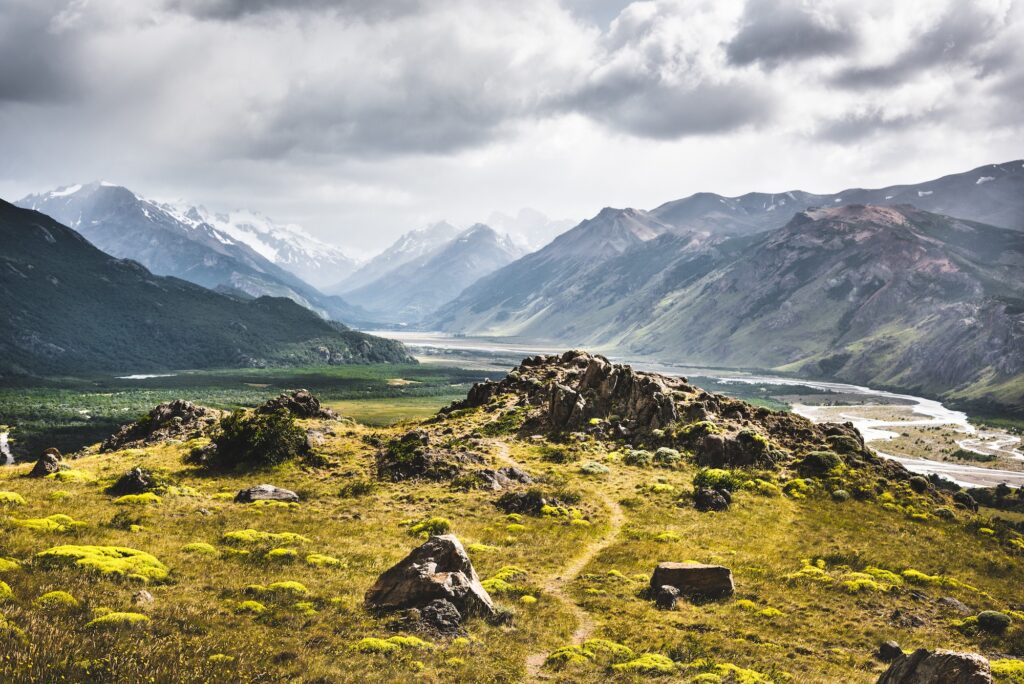
Best Hikes Along the Carretera Austral
While Patagonia’s most famous hiking destinations are often found in the well-known national parks and reserves, the Carretera Austral offers a unique opportunity to explore some of the region’s less-traveled trails. This remote highway stretches over 1,240 kilometers, running through the heart of Chilean Patagonia. Along the way, you’ll encounter a variety of off-the-beaten-path hiking experiences.
Laguna Tigre Sur
- Time Required: About 4 to 5 hours
- Distance: 8km
- Start / Finish Points: Villa O’Higgins
- Highlights: Remote and pristine landscape with the chance to spot wildlife
Located in the pristine Pumalin Park, the hike to Laguna Tigre Sur is a hidden gem. This relatively short trail takes you through lush temperate rainforests, offering glimpses of Patagonia’s diverse flora and fauna. The reward at the end is the serene Laguna Tigre Sur, a tranquil lake surrounded by ancient forests. The area’s remoteness ensures a peaceful and immersive experience.
Valle Rio Moscu
- Time Required: About 5 to 7 hours
- Highlights: Lush valleys and beautiful river views
Deep within the Aysen region, Valle Rio Moscu offers an enchanting trek through pristine wilderness. This valley is known for its stunning scenery, including dramatic waterfalls, lush forests, and crystal-clear rivers. The trail takes you along the Moscu River, surrounded by towering peaks and glaciers. Be prepared for challenging river crossings, but the breathtaking views make it all worthwhile.
Cerro Castillo
- Time Required: 3 to 5 days, depending on the route
- Distance: 62km
- Difficulty: Moderate to challenging
- Start / Finish Points: Las Horquetas Grandes to Villa Cerro Castillo
- Highlights: Stunning mountain scenery and pristine wilderness
While Cerro Castillo is often associated with its well-known reserve, you can also explore its lesser-known and equally spectacular trails. The Cerro Castillo trek takes you through lush forests, across pristine rivers, and up to high alpine meadows. The reward is the stunning view of Cerro Castillo’s jagged peaks and glaciers. This trek is a fantastic alternative for those looking to avoid the crowds while still enjoying the beauty of the region.
Pumalin Park – Cascadas Waterfalls Hike (Escondidas)
- Time Required: 1 to 2 hours
- Distance: 3.5km
- Start / Finish Points: Caleta Gonzalo
- Highlights: Remarkable nature reserve with cascading waterfalls
Pumalin Park is a true wilderness paradise, and the Cascadas Waterfalls Hike is a prime example of its natural beauty. This trail leads you through dense forests, alongside pristine rivers, and to a series of cascading waterfalls. The lush vegetation, combined with the sounds of rushing water, creates a magical atmosphere. While the hike itself is not particularly long or strenuous, it offers a peaceful escape into the heart of Patagonia.
Planning Your Hike in Patagonia
Can you hike patagonia on your own.
Choosing between independent or guided trekking depends on your experience and personal preferences. If you’re an experienced backpacker tackling a well-traveled route like the W Trek or hikes around Fitz Roy, independent hiking is entirely feasible. These trails are well-marked, and with proper planning, you can have a successful journey. However, meticulous preparation is essential, including booking campsites in advance.
For those seeking a more guided experience or exploring less-traveled routes, organized tours provide valuable support and expertise. Guided tours handle logistics, navigation, and safety measures, allowing you to focus on enjoying the scenery and adventure. Let’s explore the pros and cons of both options.
Hiking in Patagonia Independently (incl. Solo Hiking)
- Freedom: Hiking independently allows you to set your own pace and explore as you wish.
- Cost: It’s generally more budget-friendly than guided tours.
- Self-Discovery: You’ll gain valuable wilderness skills and self-sufficiency.
- Navigational Challenges: Patagonia’s trails can be challenging to navigate, and weather conditions can change rapidly.
- Safety: In remote areas, getting help in emergencies can be difficult.
- Logistics: Planning routes, permits, and accommodations can be time-consuming.
Hiring a Guide for Patagonia (incl. Group Tours)
- Expertise: Guides offer in-depth knowledge of the terrain, flora, fauna, and local culture.
- Safety: They are trained in wilderness first aid and can respond to emergencies.
- Logistical Support: Guides handle permits, accommodations, and meal planning.
- Cost: Guided tours are more expensive due to the added services.
- Less Freedom: You’ll follow a predefined itinerary.
Ultimately, the decision comes down to your experience, comfort level, and objectives. Experienced hikers with wilderness navigation skills may relish the freedom of independent trekking. However, if you’re new to Patagonia or prefer a structured experience, hiring a guide can enhance your adventure and safety.
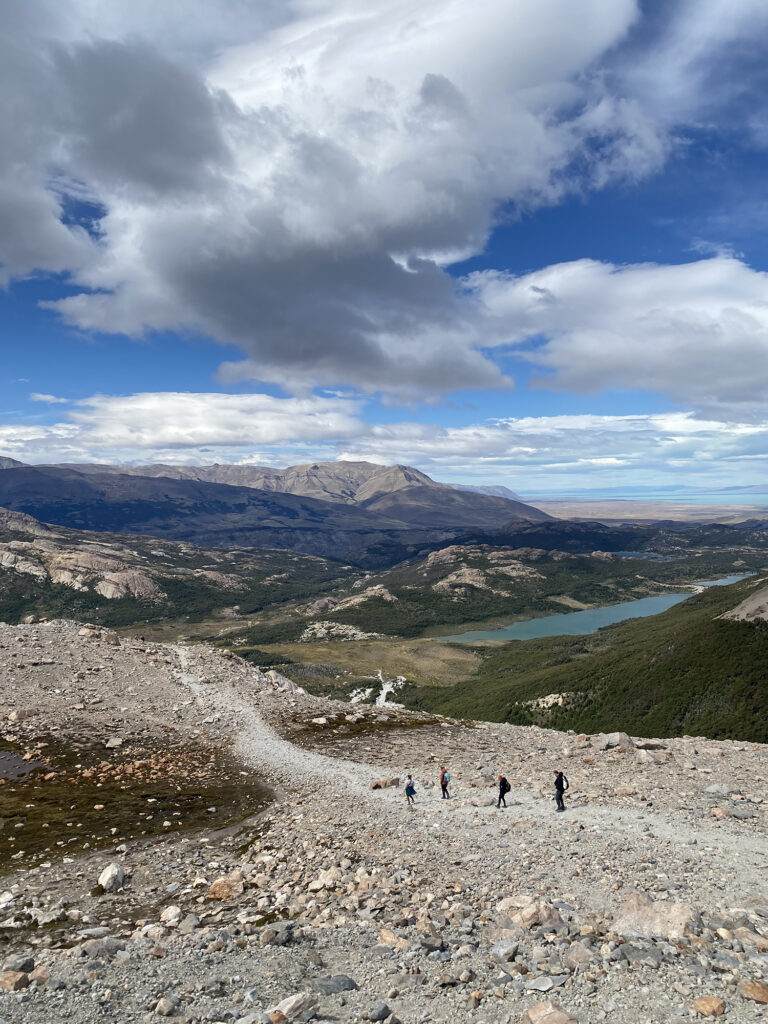
Is Hiking in Patagonia Difficult?
Patagonia’s hiking trails offer varying levels of difficulty, from relatively easy day hikes to challenging multi-day treks. The difficulty of your hike depends on factors such as trail conditions, terrain, and weather. Here’s a breakdown:
- Easy Hikes: Short, well-marked trails with minimal elevation gain, suitable for beginners and families. Examples include Laguna Esmeralda and Condor Lookout.
- Moderate Hikes: Longer day hikes or multi-day treks with moderate elevation gain and varied terrain. Trails like the W Trek and Cerro Torre fall into this category.
- Challenging Hikes: Multi-day treks with significant elevation changes, steep ascents or descents, and unpredictable weather. The O Circuit and Huemul Circuit are more challenging options.
- Technical Hikes: Some routes may involve technical climbing or glacier travel, requiring specialized skills and equipment. Seek guidance from experts for these adventures.
It’s crucial to choose hikes that match your fitness level and experience. Beginners can enjoy many fantastic trails in Patagonia with the right preparation and gear.
Can Beginners Go Hiking in Patagonia?
Yes, beginners can certainly enjoy hiking in Patagonia, but it’s essential to plan appropriately and choose suitable trails. Here are some tips for novice hikers:
- Select Easy to Moderate Trails: Start with shorter and less challenging hikes that match your fitness level. Laguna Esmeralda, Condor Lookout, and the short hikes in Torres del Paine are excellent options.
- Prepare Physically: Begin a fitness routine that includes cardiovascular and leg-strengthening exercises to build endurance for hiking.
- Acclimate: If possible, spend a day or two in a nearby town like Puerto Natales or El Calafate to acclimate to the altitude and climate.
- Gear Up: Invest in proper hiking gear, including waterproof and insulated clothing, sturdy hiking boots, and trekking poles for stability.
- Travel Light: Keep your backpack as light as possible to reduce the strain on your body.
- Plan Adequate Time: Allocate extra time for rests and adjustments to the pace, especially if you’re not accustomed to hiking.
- Stay Informed: Check trail conditions, weather forecasts, and park regulations before embarking on your hike.
- Travel with a Group: If you’re uncertain about your hiking abilities, consider joining a guided tour or traveling with experienced hikers.
Remember that safety should be a priority, and it’s better to start with easier hikes and gradually progress to more challenging trails as you gain confidence and experience.
Cost of Hiking in Patagonia
It’s important to note that Patagonia is not a budget-friendly destination compared to other South American locations. Expect higher costs for lodging, food, and various amenities. However, there are options to save money. Some factors influencing the cost of your trip include duration, accommodation preferences, and whether you hire a guide. Here’s a breakdown of potential expenses:
- Flights: International and domestic flights to Patagonia can be a significant expense, so booking in advance and searching for deals is advisable.
- Accommodation: Options range from camping (cheapest) to hostels, cabins, and luxury lodges (more expensive). Prices increase during peak seasons.
- Park Fees: Most national parks in Patagonia charge entrance fees. The costs vary, so check with each park for updated prices.
- Food: Dining out in Patagonia can be pricey, especially in remote areas. Consider bringing some of your own food for longer treks to save money.
- Gear and Equipment: Investing in quality hiking gear, clothing, and camping equipment can be expensive upfront but pays off in comfort and safety.
- Guides: Hiring a guide or joining a guided tour adds to the cost but provides expertise and logistical support.
- Transportation: Transportation within Patagonia, such as buses or boats, will contribute to your expenses.
- Miscellaneous: Budget for additional expenses like permits, travel insurance, and souvenirs.
It’s possible to go hiking in Patagonia on a tight budget by camping, preparing your own meals, and choosing less expensive accommodations. Conversely, those seeking more comfort and convenience can opt for guided tours and upscale lodging. Careful planning and budgeting will help you make the most of your Patagonian adventure within your financial means.
How Safe is Hiking in Patagonia?
Hiking in Patagonia offers incredible experiences, but it’s essential to prioritise safety due to its remote and challenging nature. Here are some safety considerations:
- Weather: Be prepared for rapidly changing weather conditions. Carry adequate clothing, rain gear, and layers to stay warm and dry.
- Navigation: Trails can be poorly marked, and getting lost is a risk. Carry maps, a compass, and a GPS device, and know how to use them.
- Wildlife: Patagonia is home to various wildlife, including pumas. Understand how to react if you encounter animals and store food securely.
- Altitude: Some hikes reach high altitudes. Acclimatize gradually and be aware of symptoms of altitude sickness.
- Water: Water sources can be contaminated. Use water treatment methods to ensure safe drinking water.
- Emergency Contact: Inform someone of your itinerary and expected return time. Cell phone coverage can be limited.
- Health: Ensure you have any necessary medications and a basic first aid kit. Be prepared for minor injuries and know basic first aid.
- Group Travel: Traveling with others or hiring a guide can enhance safety, especially for beginners.
- Local Advice: Seek advice from local rangers and experts who can provide up-to-date information on trail conditions and safety concerns.
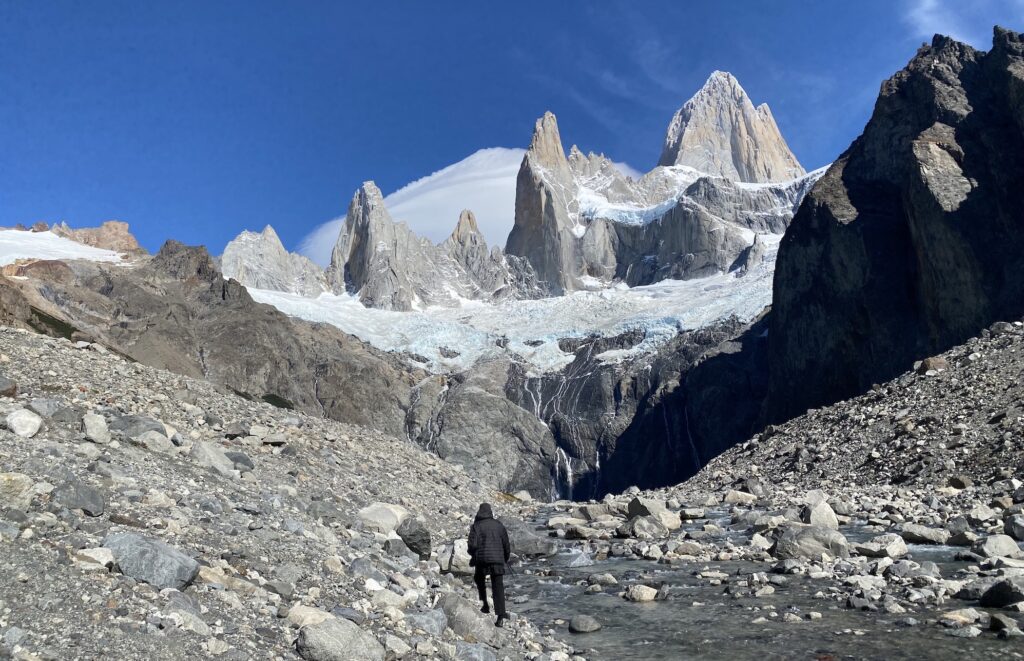
Hiking in Patagonia Packing List
Before you embark on your Patagonian adventure, it’s essential to have the right gear and supplies to ensure a safe and enjoyable journey. Here’s a comprehensive packing list to help you prepare for trekking in Patagonia:
- Moisture-wicking base layers (top and bottom)
- Insulating mid-layers (fleece or down jacket)
- Waterproof and windproof outer layer (jacket and pants)
- Quick-drying hiking pants
- Sturdy and comfortable hiking boots
- Warm gloves
- Wool hat or beanie
- Moisture-wicking socks and sock liners
- Gaiters (for keeping debris out of your boots)
- Sun hat and sunglasses
- Bandana or buff (for sun protection)
- Swimsuit (for swimming in thermal pools or lakes)
Backpacking Gear
- Hiking backpack with rain cover (40-70 liters, depending on your trip)
- Tent or lightweight shelter (if camping)
- Sleeping bag suitable for cold weather
- Sleeping pad or mattress
- Cooking stov e and cookware (if camping)
- Lightweight utensils, cup, and bowl
- Headlam p or flashlight with extra batteries
- Multi-tool or camping knife
- Lighter or waterproof matches
- Trekking poles (optional but recommended)
- Dry bags or stuff sacks (for organising gear)
- Navigation tools (maps, compass, GPS)
Personal Items
- Passport and any necessary visas
- Travel insurance information
- Cash in local currency (ATMs may be scarce)
- First-aid kit with essential medications
- Toiletries (toothbrush, toothpaste, soap, etc.)
- Microfiber towel
- Insect repellent
- Sunscreen and lip balm with SPF
- Personal identification (ID or driver’s license)
- Camera and accessories
- Charging cables and portable power bank
Food and Water
- High-energy snacks (nuts, energy bars, dried fruit, etc.)
- Dehydrated or freeze-dried meals (if camping)
- Reusable water bottle or hydration reservoir (3+ liters)
- Water purification filter or water purification tablets
Miscellaneous
- Travel itinerary and emergency contact information
- Travel adapters and chargers
- Travel-sized sewing kit
- Ziplock bags (for organizing and waterproofing)
- Trash bags (for packing out waste)
- Local guidebooks or trail maps
- Notepad and pen
- Entertainment (book, playing cards, etc.)
- Solar charger for electronics
- Binoculars for wildlife viewing
- Travel pillow
- Camp shoes (lightweight sandals or camp slippers)
- Down booties for keeping feet warm in camp
Leave No Trace Principles
When hiking in Patagonia, it’s crucial to adhere to Leave No Trace principles to minimize your impact on the environment. These principles include:
- Plan ahead and prepare: Research your route, obtain necessary permits, and pack appropriately to minimize waste and resource use.
- Travel and camp on durable surfaces: Stick to established trails and campsites to prevent soil erosion and damage to fragile ecosystems.
- Dispose of waste properly: Pack out all trash and waste, including biodegradable items like food scraps and toilet paper.
- Leave what you find: Preserve the natural environment by not picking plants, disturbing wildlife, or removing rocks and historical or cultural artifacts.
- Minimize campfire impact: Use a camp stove for cooking instead of making fires, as fires can scar the landscape and deplete limited wood resources.
- Respect wildlife: Observe animals from a distance, avoid feeding them, and keep a safe distance to prevent stress and harm.
- Be considerate of other visitors: Keep noise levels down, yield the trail to others, and maintain a friendly and respectful attitude towards fellow hikers.
By following these principles, you can help protect the fragile ecosystems of Patagonia and ensure that this pristine wilderness remains a natural wonder for generations to come.
Hiking in Patagonia is a journey into the heart of one of Earth’s most awe-inspiring landscapes. From the towering peaks of Torres del Paine to the hidden treasures of the Carretera Austral, this region offers a diverse range of trails for adventurers of all levels. Whether you choose to hike independently or join a guided tour, careful preparation, respect for the environment, and a sense of wonder are essential companions on your Patagonian trek.
As you embark on your adventure, take the time to savour the beauty of Patagonia, listen to the whispers of the wind, and marvel at the sheer majesty of nature. In this remote corner of the world, you’ll discover not only breathtaking landscapes but also a profound connection to the wild and untamed spirit of Patagonia. So lace up your boots, shoulder your pack, and set out to explore this magnificent land – Patagonia awaits your footprints, and the adventure of a lifetime awaits your spirit.
Hiking in Patagonia offers a range of difficulty levels. Some trails are suitable for beginners with minimal elevation gain, while others are more challenging, requiring experience and endurance. Choose trails that match your fitness level and goals.
Yes, beginners can hike in Patagonia. Many trails are beginner-friendly, such as short day hikes and well-marked paths. However, it’s essential to prepare physically, choose appropriate trails, and be equipped with proper gear for varying weather conditions.
The duration of your hike in Patagonia varies greatly depending on the trail and your itinerary. You can enjoy short day hikes or embark on multi-day treks that last from a few days to several weeks. It’s flexible and depends on your preferences.
Yes, you can hike in Patagonia independently. Many trails are well-marked, and with proper preparation, navigation tools, and safety precautions, solo hiking is possible. However, some remote and technical routes may require guides or group travel.
Hiking in Patagonia can be safe if you prioritize safety precautions. Weather conditions can change rapidly, and wildlife is present. With proper gear, navigation tools, and knowledge, you can minimize risks. Traveling with others or hiring guides can enhance safety, especially for beginners.
The cost of hiking in Patagonia varies depending on factors like accommodation, transportation, gear, and whether you choose guided tours. Budget-conscious travelers can camp and cook their meals to save money, while those seeking more comfort might spend more on lodging and services.
The best time to visit Patagonia depends on your interests. For milder weather and more accessible trails, consider the spring and summer months from November to March. However, each season offers unique experiences, so plan based on your preferences.
Both Chilean and Argentine Patagonia both offer breathtaking landscapes and hiking opportunities. Argentina offers similar views at a much lower budget: you can even camp for free. Chile has more developed infrastructure, which comes with bigger crowds and higher cost. But it is also arguably (ever so slightly) more beautiful than Argentina. Your choice may depend on specific destinations, visa requirements, or the type of experiences you seek.
Determining the most beautiful part of Patagonia is subjective, as it offers diverse landscapes. Torres del Paine National Park in Chile and Los Glaciares National Park in Argentina are often considered among the most stunning areas. Each region has its own unique charm.
Patagonia is rich in wildlife, including guanacos, foxes, condors, red-headed woodpeckers, and if you’re fortunate, elusive creatures like pumas, huemuls, or pygmy owls. The marine life is abundant, with whales, seals, and penguins along the coast. Patagonia’s biodiversity is a highlight for nature enthusiasts.

Lucas is a travel writer with deep experience exploring South America. He enjoys hiking through mountain ranges, cycling across deserts and paddling down rivers.
Best Food in Puerto Natales: 17 Top Restaurants & Cafes
Get our best tips direct to your inbox.

14 best hikes in Patagonia: from short walks to multi day treks
There is an incredible amount of stunning hiking trails in Patagonia. It is definitely a hiker’s paradise. You don’t even have to be in an incredible physical shape – some of the best hikes in Patagonia are accessible even to relative beginners!
We spent 10 days in Patagonia when we visited South America (Chile mostly, but still) in 2017, which is not exactly enough time to do any serious hiking.
In our case, we managed to do exactly one full day hike, since the weather made it rather dangerous to try others – the Laguna de los Tres hike from El Chalten in Argentina.
In addition to that we managed a short hike in Torres del Paine National park to the lago Nordenskjöld, which offers an incredible view of the Cuernos del Paine, and Mirador Los Condores from El Chalten in Argentina.
Plus, we did a guided tour on the Perito Moreno glacier in Los Glaciares national park – definitely, a must do.
Since we didn’t get to enjoy more hiking, I decided to do a lot of research to put together a list of some of the best hikes in Patagonia.
Honestly, it was almost impossible to choose between them, as each of the treks offers something different, but equally amazing.
As a side note, most of the hikes in Patagonia can be done without a travel guide. There are some companies, though, that offer guide services and who might even provide you with equipment for camping and preparing food if you’d like.
In this article you’ll see some of the best hikes in Patagonia, both multi-day treks, single day, and not even day hikes (I’d call them walks even).
Here you can see all of them on a map.
This post might contain affiliate links, which means that if you purchase anything via them, we might earn a small commission – at no extra cost to you. Check our affiliate disclaimer for more information. As an Amazon Associate we earn from qualifying purchases .
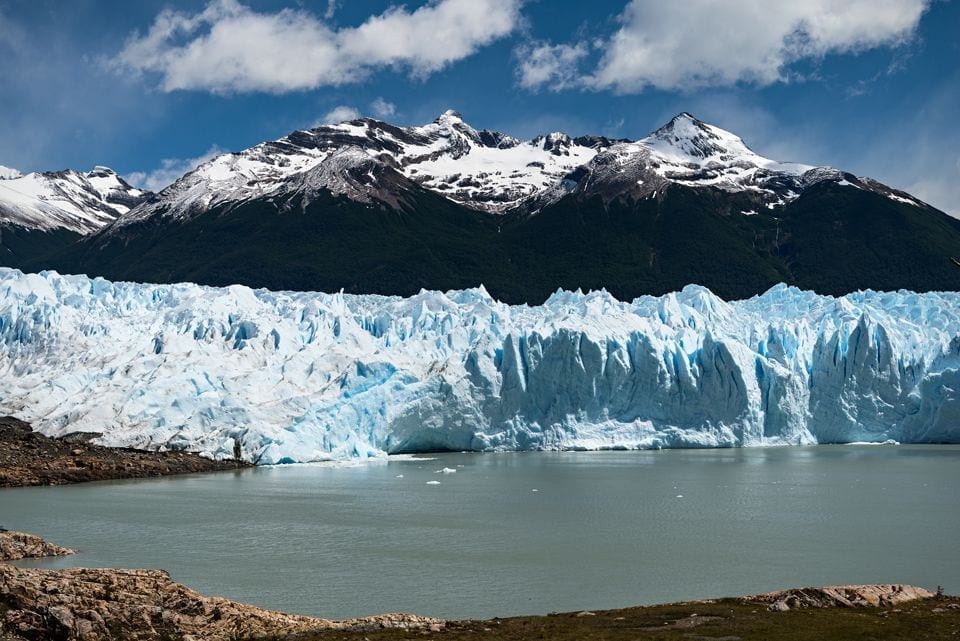
Best short hikes in Patagonia
By short hikes, I mean those that can be completed in less than 3 hours. You can do the trek and be back for a lunch in town.
Just because the hike is short, doesn’t mean that you won’t get to enjoy incredible views.
Hell, even the views from the side of the road tend to be jaw-dropping, so don’t be hesitant to add some of the easy hikes to your Patagonia itinerary.
Lago Nordenskjöld in Torres del Paine NP, Chile
The beautiful lake Nordenskjöld lies at the feet of the Cuernos del Paine in the Torres del Paine national park in Southern Chile.
The viewpoint of the lake and the Cuernos is just a short hike away from the Salto Grande waterfall.
The hike is more of a walk, and you’ll get to enjoy many interesting sceneries of the Patagonia wilderness – ragged peaks, emerald waters, and mesmerizing green meadows.
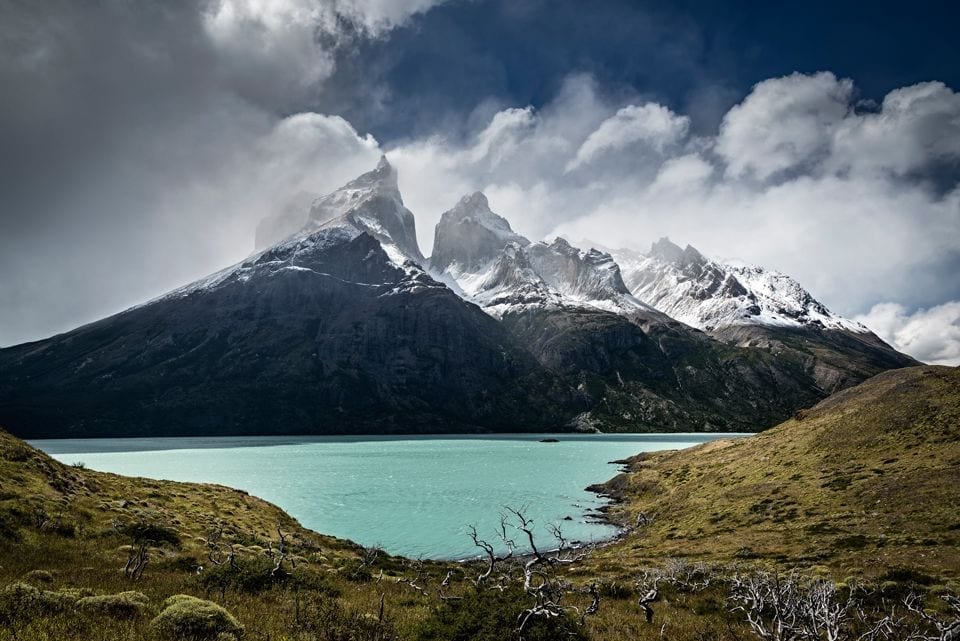
Location: Torres del Paine National Park in Chile Duration: 40 minutes to 1 hour Distance: approximately 2km Difficulty: very easy, minimal elevation gain What to carry: nothing extra is needed Paid? No, the only fee is to enter the park itself
Mirador Los Condores and Las Aguilas in Los Glaciares NP, Argentina
Technically, it’s two different hikes, but they are both at the same place. Just at one point of the trail, there’s a fork – if you turn left, in 10 minutes you’ll reach the Los Condores viewpoint, and if you turn right, it’s 30 minutes to the Las Aguilas.
The starting point of this walk is at the National park visitor’s centre in El Chalten. The trail is well signed, and it gives you the opportunity to enjoy some incredible views just a short and easy walk away.
As the name suggests, the trails offer you a chance to see some condors, as well as give a view of the lago Viedma.

We did this hike the next day after doing one of the best hikes in Patagonia – Laguna de los Tres, when I thought that I wouldn’t be able to walk uphill ever again because of the muscle pain. But alas, we did it!
Location: Los Glaciares National Park in Argentina Duration: 2h Distance: 4 or 6km Difficulty: Easy, minimal elevation gain What to carry: nothing extra Paid? No
Related: Where to stay in El Chalten
Cerro campanario in nahuel huapi national park.
One of the most popular hikes in the Argentinian lake district, the Cerro Campanario hike is located near the town of Bariloche.
This easy walk offers you incredible views of Lake Nahuel Huapi, the Llao Llao peninsula, and the surrounding peaks and valleys.
At the top of the mountain, you get to enjoy views of some of Patagonia’s most stunning landscapes, such as El Trebol Lagoon and some of the mountains – Cerro Otto and Cerro Catedral.

Location: Nahuel Huapi National Park in Argentina Duration: 30 minutes Difficulty: Easy, if a little steep at times; you can even take a chair lift What to carry: snacks and drinks. There’s a café at the end, but it’s expensive Paid? No, but the lift is paid
Mirador of Exploradores Glaciar in Laguna San Rafael NP, Chile
Get an unobstructed view of the Exploradores Glaciar with this rather easy and short walk to the mirador Mirador Glaciar Exploradores.
This short walk through the forest setting leads to a balcony where you can overlook the glacier in all its glory.

Is just looking at it not enough? You can go on a tour that takes you on the glacier itself!
On the tour , you get to experience walking on glacial ice, looking in some turquoise glacial ponds, and even going through ice tunnels!
Location: Laguna San Rafael National Park, Chile Duration: 25 minutes (6-7h for the guided trek) Distance: 1km (8,5km for the glacier hike) Difficulty: moderate, 60m elevation gain ( the glacier hike is rated moderate ) What to carry: snacks and drinks. Paid? The tour is paid
Best day hikes in Patagonia
Not too many people are ready to commit to a multi-day trek, so they (and us, for that matter) chose to go on day hikes instead.
But there are quite a few options of where to go for full-day hikes in Patagonia, both in Chilean and Argentinian one.
Minitrekking on Perito Moreno glacier in Los Glaciares NP, Argentina
Although this might be the most popular glacier hike in Patagonia and it’s definitely one of the most popular things to do in Los Glaciares , and you must do it with a tour guide, it’s definitely a remarkable experience to have.
Despite most of the glaciers in the world losing their mass due to global warming and climate change, the Perito Moreno glacier remains in a state of equilibrium, meaning that it loses as much of the ice as it gains. Plus, you can constantly hear the ice breaking and cracking, as the glacier moves approximately 2 meters a day!
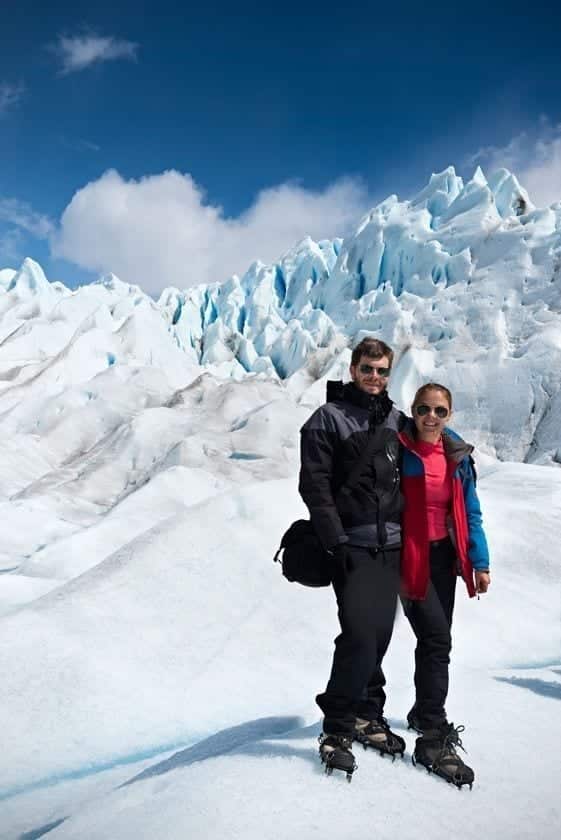
The company that does the tour we did – Hielo y Aventura – has two tours on ice – Minitrekking and Big Ice . There are also some other companies doing it – check out which ones in our article about activities that you can do in Los Glaciares National park.
Honestly, we did the minitrekking , but I wish we had done the Big Ice tour. I loved the minitrekking so much that I wished we could stay longer! And really, the minitrekking was much easier than I expected.
The tour guides speak English, Spanish, and Portuguese. They not only take you on the trek but provide you with information about the glacier and glaciology in general.
After the tour, definitely spend a bit of time on the balconies overlooking Perito Moreno! We saw some enormous chunks of ice fall off the side of the glacier, it was just phenomenal!
Location: Los Glaciares National Park in Argentina Duration: 10 hours (1,5h on ice); includes transfer times (optional) Difficulty: moderate What to carry: food for after the hike, warm clothing Paid? Yes
Don’t feel like hiking on the ice? There are cruise tours available as well.
Laguna de los Tres in Los Glaciares NP, Argentina
Obviously, since we did the Laguna de los Tres hike in Los Glaciares National Park ourselves, I had to start with it.

It’s one of the most famous hikes in Patagonia, so expect lots and lots of crowds. On the plus side, though, it means that it’s hard to get lost (the trail is well marked as well, though)!
The hike itself is rather easy for the most part, but the final hour or so is very strenuous.
We saw some children climb to Laguna de los Tres as well! It took them much longer than an hour to do the last part, though – we saw them both on the way up and down.
The view at the end, though? Definitely worth it.
The peaks of Mt Fitz Roy, Poincenot and Torre – the tres in the name of Laguna de los Tres – reflect nicely in the lagoon.
Don’t forget to check out the other laguna – laguna Sucia, located a tiny bit to the left of the Laguna de los Tres. Just a short hike uphill will open up another incredible view to you.
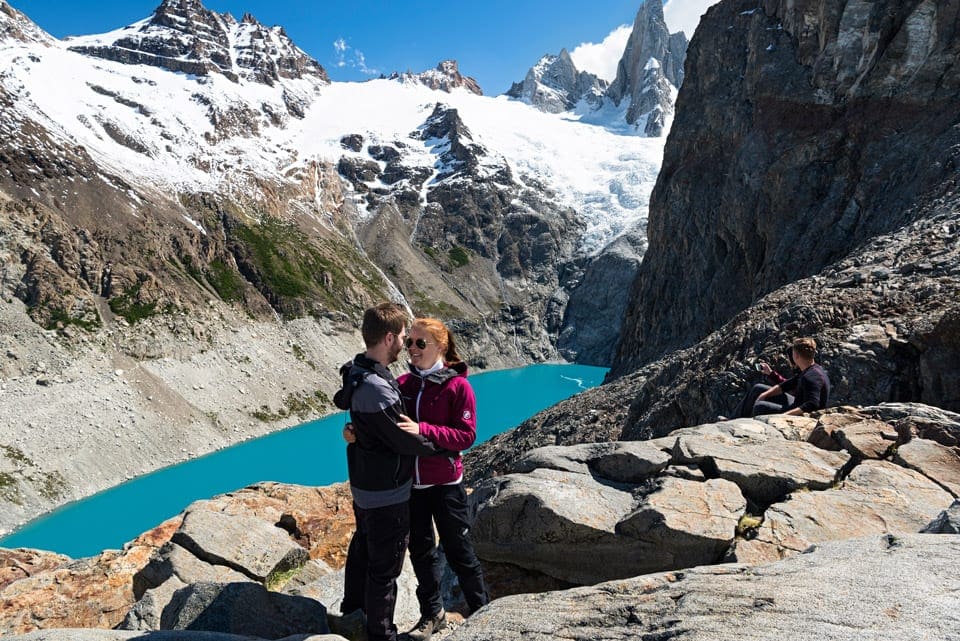
You can even make this a multi-day trek – there are campgrounds on the trail near the last ascent to the laguna de los Tres. It’s one of the most unique things to do in Argentina!
Give yourself the unique chance to enjoy the sun rise over the lagoon!
Location: Los Glaciares National Park in Argentina Duration: 8 to 10 hours Distance: 23km Difficulty: moderate to hard, cumulative approximately 960m elevation gain What to carry: Hiking poles Paid? No (unless you do a transfer)
Laguna Torre in Los Glaciares NP, Argentina
Another amazing day hike in Los Glaciares with the starting point in El Chalten.
This relatively easy hike offers several incredible lookouts (miradores) where you’ll have a chance to see the peaks of Cerro Torre. Most of the hike is along the shores of the Rio Torre, until you reach the glacial laguna Torre.

If you decide to go the extra distance along the laguna Torre to Mirador Maestri, you’ll get to see the icy tongue of Glaciar Torre peeking out of the rocks.
Laguna Torre is the start of the Huemul Circuit, so even if you don’t do the full one, you still get to experience at least a part of it!
Location: Los Glaciares National Park in Argentina Duration: 5 to 6h Distance: 20km Difficulty: easy, 250m (350m to mirador Maestri) elevation gain Paid? No
Grey Glacier in Torres del Paine NP, Chile
The Grey Glacier is one of the most spectacular glaciers in Torres del Paine National Park , which tumbles into Lago Grey.
There are several ways to explore the glaciar Grey – go on a boat tour, kayak, go on a glacier hike, and, of course, do one of the best hikes in Patagonia – a day trek to the Grey Glacier.
The Lago Grey hike is part of the famous W trek, so you get to enjoy a part one of the best multi-day treks in the whole Patagonia!

A huge glacier creating icebergs with a deep growl, the blue lago Grey, and the Torres del Paine mountains around – it is definitely a view not to miss.
The hike can be done in one day, but you must make sure to get back to the last ferry. Alternatively, you can reserve a spot at a refugio and enjoy it as a 2-day trek.
Location: Torres del Paine National Park, Chile Duration: 6h Distance: 22km Difficulty: hard Paid? Entrance fee to Torres del Paine, plus the ferry to the trailhead
Laguna Cerro Castillo in Cerro Castillo NR in Chile
Do you want to enjoy the Cerro Castillo mountains, but don’t feel like doing a multi-day hike?
A hiking trail that used to be an emergency route has opened up, letting you hike up to the Laguna Cerro Castillo in just a day!
Enjoy the turquoise lake, rocks covered in glacial ice, and the stunning looks of the castle -looking Cerro Castillo without worrying about camping in snow and rain.

Unlike the multi-day trek, you start this hike in Villa Cerro Castillo and return back to it.
Location: Cerro Castillo National Reserve, Aysen, Chile Duration: 6h Distance: 14km Difficulty: hard, 1000m elevation gain Paid? Yes, the entrance fee
Best multi-day treks in Patagonia
Patagonia is a hiker’s paradise with an enormous number of remote areas that have been barely touched by people.
That’s why it makes sense that most of the best hikes in Patagonia take more than just a day.
Take your pick of spending just a night in the wilderness or hiking for days on end. All of these hikes in Patagonia are breathtaking, each in its own way.
W trek (or the longer O trek/Torres del Paine circuit) in Torres del Paine NP, Chile
The most popular multi-day trek in Torres del Paine National Park is the W trek. It’s quintessential for any hiker who’s up for the challenge of a multi-day hike in Patagonia.
This crown-jewel hike takes you through the backcountry of the park on the trail that makes a W shape.
The W hike allows you to enjoy the best of Torres del Paine – the Glacier Grey, Valle Frances, Los Cuernos, Torres del Paine (the mountains), and Paine Grande. And that’s just in addition to all the turquoise lakes, raging rivers, wind-ripped forests, and emerald meadows.
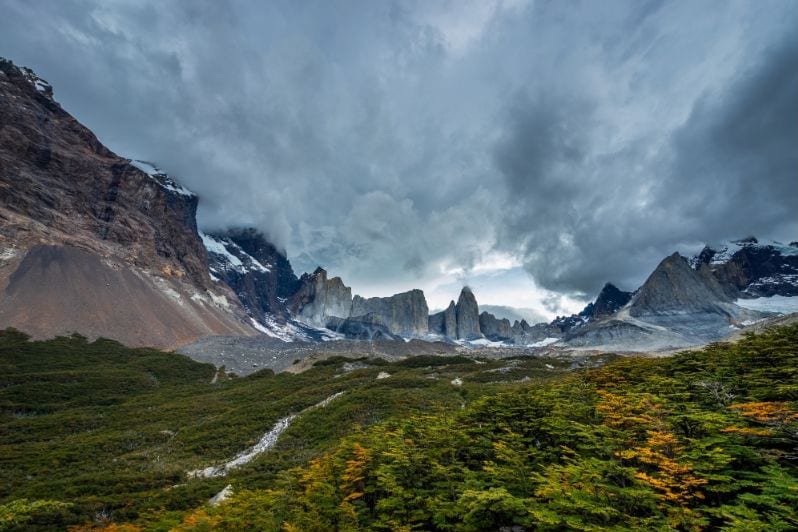
But, do you feel that the W is just not enough and have 3 more days to spare?
Add a little loop to your W and go on the O-trek, also known as the Torres del Paine circuit. It allows you to enjoy the lesser-walked Northern parts of Torres del Paine.
The extended O-trek gives you an opportunity to experience the Southern Patagonia ice field in all of its glory. Keep in mind that there are no refugios on the northern side .
Location: Torres del Paine National Park in Chile Duration: 5 days (9 for the O trek) Distance: 71km (120km for the O circuit) Difficulty: moderate-hard, elevation gain cumulative 2,956 meters for the W trek What to carry: camping equipment and food. Some refugios offer beds with bedding and food, though, but not on the O trek, where you’ll have to camp. Paid? Yes – you need to pay the park entrance fee and the accommodation/camping.

Cerro Castillo circuit in Cerro Castillo NP in Chile
One of the least crowded and most beautiful hikes in Patagonia is the Cerro Castillo Circuit in Chile. In some places, like the Cerro Castillo National Park website, this circuit is known as Las Horquetas, which is the starting point of the trail. It ends in Villa Cerro Castillo, which is 30km away.

It offers Patagonia at its finest to you. There are turquoise lakes and blue lagoons, hanging glaciers, high mountains and deep valleys, lush forests and rich meadows.
Another outstanding thing about this one of the best trails in Patagonia? It’s still relatively unknown, so you can enjoy all the beauty Patagonia has to offer while meeting a fraction of people that would flood Los Glaciares or Torres del Paine!
On this exceptional trail, there are some campgrounds that have common picnic tables and even outside bathrooms. But make sure to carry food with you, as well as water purification equipment!
Location: Cerro Castillo National Park in Chile Duration: 4 days Distance: 57km Difficulty: hard, elevation gain 2374m What to carry: camping and cooking equipment, hiking poles Paid? Entrance fee. You have to cross private ground, which the owners charge for.
The Huemul Circuit Los Glaciares NP, Argentina
The Huemul Circuit is considered to be one of the hardest hikes in Patagonia. Only experienced hikers should go on these.
It goes over two mountain passes, is badly marked, and you cross rivers which sometimes requires ziplining. Since it’s a very demanding hike, you wouldn’t meet a lot of people, which means that you need to prepare for emergency situations as well.
On the other hand, the views definitely are worth it. There are massive glaciers, incredible mountain views, turquoise waters, and lush greenery. The view from Paso del Viento of the Southern Patagonian Ice field, though, definitely makes this one of the best hikes in Patagonia.

To go on this hike, you need to register with the Centro de Informes Ceferino Fonzo for the national park in El Chaltén to get a hiking permit, plus the rangers will check that you have the safety gear and know-how to use it. You need (per person) 1 harness, 2 carabiners, 1 safety line or sling, 1 thin cord or rope (35m long), a map of the circuit, and a cooking stove.
Location: Los Glaciares National Park in Argentina Duration: 5 days Distance: 64km Difficulty: hard What to carry: Safety equipment, map, compass or GPS. Camping and cooking equipment. Trekking poles. Bigger (45l at least) hiking backpack. Paid? Not, unless you go with a guide.
The Lago del Desierto Border Crossing – hiking from Villa O’Higgins to El Chaltén (Chile/Argentina)
This almost one-of-a-kind trek takes you over the Chile-Argentina border through the no man’s land.
Its starting point is located at the very end of the Chilean highway Carretera Austral – in the village of Villa O’Higgins (if you start in Chile), and you cross over the border to the town with the best hikes in Patagonia – El Chalten.
You can do it either from Villa O’Higgins to El Chaltén or the opposite way.
This trip involves ferries, buses, and camping.
On this hike, you get to enjoy the incredible lago del Desierto, views of the Mount Fitz Roy, plus the ferry on Lago O’Higgins will stop at the Glaciar O’Higgins before continuing on.
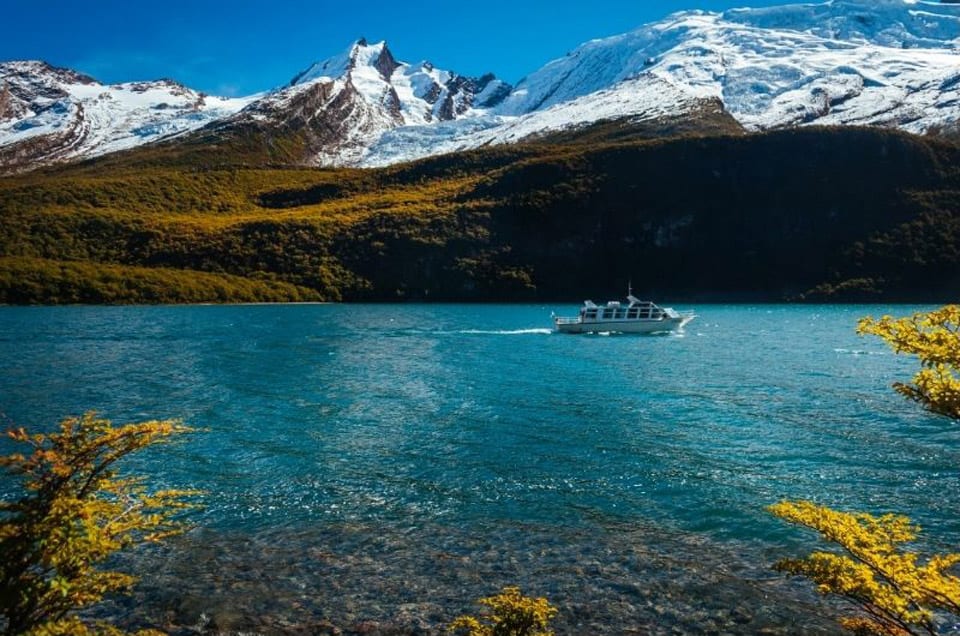
Location: End of Carretera Austral highway, border of Chile and Argentina Duration: 2-3 days Distance: 22km Difficulty: relatively easy What to carry: both Chilean and Argentinian pesos, camping equipment, food (in case you have to wait for a ferry). Keep in mind that you can’t bring fresh food into either country . Paid? Ferries and buses are paid
Los Dientes de Navarino in Chile
Named after the Dientes de Navarino mountains, this is considered to be the world’s southernmost long-term trek. It starts in the southernmost settlement known to sailors – Puerto Williams.
The trail circuits the jagged spires of Cordon de los Dientes, which looks like teeth, hence the name – dientes.
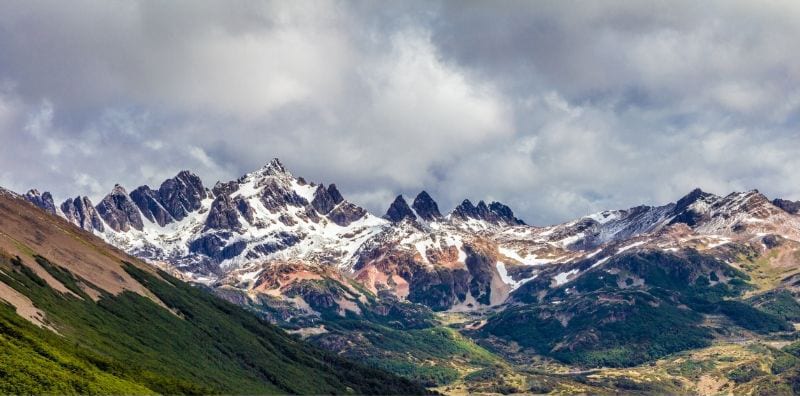
This trail in the very Southern Patagonia is not for the beginners nor the faint of heart. It goes through raw wilderness, the weather is savage, to put it mildly, and the trail rather empty, plus there’s no official rescue service.
But if you want to enjoy untouched landscapes with hundreds of lakes, view of the Cape Horn and the Beagle Channel, condors, guanacos, and so much more, plus you have the extensive trekking knowledge, then you can be one of the very few to complete the Dientes de Navarino circuit .
Location: Tierra del Fuego National Park, Chile Duration: 4-6 days Distance: 53km Difficulty: moderate What to carry: Camping equipment, cooking equipment and food, map, and GPS is beneficial as well. Paid? No, but if you don’t feel 100% sure about your abilities, it’s better to go with a guided tour. Plus, you need to get there (plane or ferry)
Tierra del Fuego is an incredible place. If you’d like to visit it, know that there are many more hikes here, and of course, so many other things to do. Matej from Czech the World can teach you a lot more about Tierra del Fuego .
Things you should take on all hikes in Patagonia
Although the hikes mentioned in this article differ in length and difficulty, there is some equipment that you should carry on all of them.
For ease of reading, I decided to write these basic items here in a separate paragraph. If the hikes listed below require anything more, I’ll add those items there.
Related: our full Patago nia packing list
Hiking clothes.
Definitely wear layers! In Patagonia, it’s not unusual to experience all four seasons in one day, even if you visit in summer. It can go from sun to rain to snow and hail in all of 10 minutes.
So, it’s a good idea to pack – and wear – some lightweight thermal underwear , a fleece jacket, a windproof jacket , and a winter jacket on top. Gloves and a scarf is a good idea as well.
On the bottom, I wore normal hiking pants . And, obviously, hiking shoes.
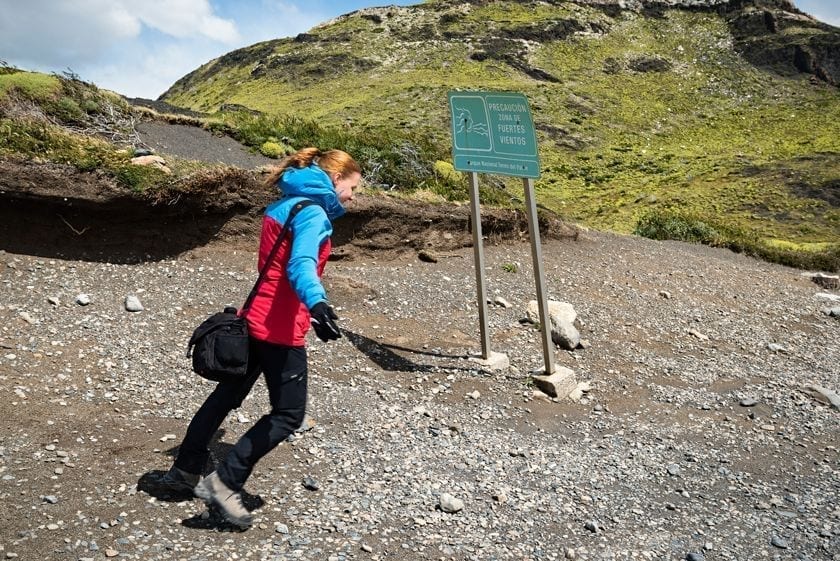
Proper hiking shoes
Although some of the hikes are more like walks, it’s better to always wear proper hiking boots .
The weather, as I already mentioned, is unpredictable – it can be sunny in one minute and snow-raining the next (it’s always bloody windy, though).
It means that the trails can get slippery very fast – you definitely don’t want to end up with a sprained ankle (or worse) because you wore improper shoes.
If possible, try to go to a store and really try the shoes out before buying them. Good shops will have a place where you can try the shoes out on different terrains and angles, to make sure that they fit perfectly. Alternatively, you can check them on Amazon .
The weather in Patagonia changes like crazy, so it’s good to be prepared for rain even if it’s not forecasted. It’s not unusual to have all four seasons in one day – even when visiting Patagonia in summer.
Of course, having waterproof clothes and bags is great, but the rain cover just gives you that extra sense of staying dry.
Proper backpack
A day back (or bigger, if you’re doing a multi-day hike) that is a proper size (we usually do with a 25-30l backpack for each of us for a day hike).
Check the straps on the backpack so that they don’t cut into your shoulders. It’s good to have the chance to fasten the straps on the chest and waist as well, as it helps distribute the weight.
A place for hiking poles with straps to hold it in place is convenient to have.
I like having an outside pocket for a water bottle as well, as it’s more comfortable than reaching in the backpack. Some people enjoy having the straw that reaches from the backpack to your front.
First aid kit
There are specific hiking first aid kits that you can buy, but it’s not that hard to put together your own little one.
The basic items to have in your first aid kit are:
- Take some band-aids or medical tape for those blisters that always sneak up at the worst possible time.
- Gloves to protect possible cuts from contamination.
- Sanitizer for hands.
- Antiseptic cream and wipes .
- Medicine: for pain, for stomach troubles, anti-allergy
- Scissors or even better – a swiss army knife thing (remember, though, that it’s not allowed to bring these onboard an airplane)
- A fire starter .
I would like to believe that it goes without saying, but there have been too many times that I’ve seen and heard about people not taking enough water with them.
It’s better to take more than you think you’d need, not “just enough”.
Another good idea is to have some water purification system with you – take the special purification tablets or even a bottle with a filter like this one – the filter makes almost any water into a drinking one.
It’s especially useful if you go on some of the best multi-day treks in Patagonia.
Snack bars, chocolate, etc. Or even a whole picnic.
It’s amazing to just enjoy your sandwich with the incredible views. Somehow, it makes the simple bread and cheese taste heavenly!
How to choose the best hike in Patagonia
If you don’t want to spend your whole time in Patagonia hiking, you can choose just a couple of hikes to do.
But how to choose those hikes that you’ll like and enjoy the best?
Ask yourself a few questions.
Are you in good shape?
Just be honest with yourself.
Some of the hikes, as you could see, are difficult. If you have trouble walking upstairs to, let’s say, the 10 th floor, don’t go on the W-trek in Torres del Paine.
Or make sure to get in shape! The views are definitely worth it!
Short walks, single day, or multi-day hikes?
There is an enormous amount of hiking trails in Patagonia. They range from 30 minutes long to even more than a week long.
What fits into your itinerary?
Are you ok with sleeping in a tent or just a simple refugio or do you prefer your own hotel room?
Are you ok with having simpler meals or would you prefer to eat at a proper restaurant each evening?
These questions might help you choose the length of the trail.
Why choose a day or shorter hikes?
You can check the weather forecast the day before and base what to do on it.
Do a shorter hike and then do some other activity – horseriding, kayaking, etc.
Do an easy hike one day and a more challenging one the next. It’s all about flexibility.
Why choose a multi day trek?
See the best of Patagonia in one longer hike instead of losing time going back to the base.
You can enjoy the sceneries slower because – again – you save time by not going back.
Explore more remote areas which are much less crowded.
Would you like to see the highlights or explore some lesser-known trails?
Yes, the most popular trails get very crowded.
If you hate crowds, consider some lesser visited places, for example, Tierra del Fuego in the southernmost part of Patagonia or maybe the comparably new Patagonia National park in Chile which encompasses the Northern Patagonian Ice Field.
The multi-day treks will probably still be rather full of people, but it should filter out the amateurs, so to say.
What landscapes would you like to see?
Steppe? Ragged peaks? Glaciers?
There is so much to choose from!
Summary of hiking in Patagonia
Hiking Patagonia is every hiker’s dream, that’s for sure. Some of the best hikes in the world are found here.
These 14 treks that I’ve described here are definitely not all of them. If I wanted to list all the best hikes in Patagonia, this article would never end!
But this definitely gives you a little insight into what Patagonia has to offer in terms of scenery and hiking.
Which one is your favourite one? And which one would you never do?
Save on Pinterest!
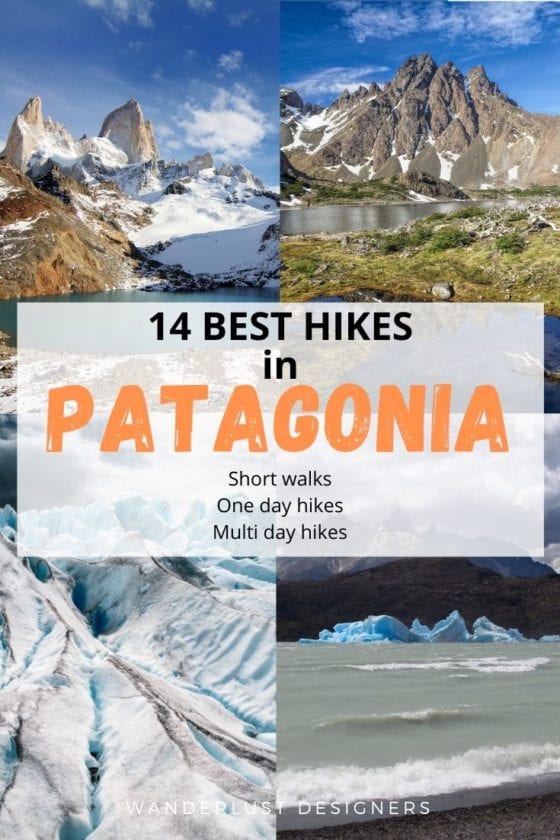
CEO & Editorial manager
Kristine Eksteine-Nizka is the founder of Wanderlust Designers. She has lived in 4 countries and has visited over 200 places in 30 countries, all while holding a full-time job or studying, and is determined to inspire and teach others to do the same.
Similar Posts

Refugios and Campsites in Torres del Paine
Go to sleep under a star cover. Wake up, crawl out of your tent, and enjoy a thousand years old glacier just hanging off a mountain. Campsites in Torres del Paine offer just that. If you’re an avid hiker, the famous W or O treks in Torres del Paine National Park in Chilean Patagonia are…

Activities in Torres del Paine for every taste
There are different activities in Torres del Paine National Park in Chilean Patagonia for different tastes and levels of physical ability. You can, obviously, do hiking – there are many trails that don’t require overnight stays in a tent or even a high level of endurance. There are even guided glacier hikes available! But there…

7 Patagonia highlights for your bucket list
Nature lovers and photographers, welcome to paradise! From the world-class hiking in Torres del Paine and El Chalten, to watching cute little penguins sing their love songs on Isla Magdalena, to enjoying a 12-year-old whiskey with 300-year-old glacial ice right on Perito Moreno glacier, Patagonia will never fail to impress you. Here’s a list of…

7 best hikes in El Chalten: short walks and day hikes
Hiking in El Chalten, Argentina, is like a dream come true for any hiking enthusiast out there. Or even nature enthusiasts, to be fair. Patagonia itself is a hiker’s paradise, and El Chalten is its capital. And you don’t even have to be in perfect shape to hike in this corner of Patagonia! Some of…
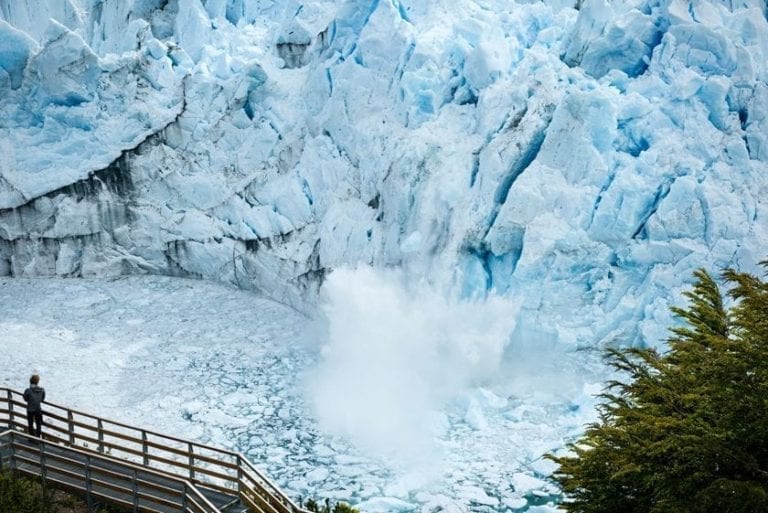
Visiting Perito Moreno Glacier: absolute guide
Visiting Perito Moreno glacier is one of the main and most popular attractions in Los Glaciares national park Although there are many glaciers in Los Glaciares (47 major glaciers and about 190 smaller glaciers actually), Perito Moreno is definitely the most famous one there. And it’s quite special as well – I talk about it…
![What to pack for Patagonia and what not to pack [2024] kiss at laguna jpeg What to pack for Patagonia and what not to pack [2024]](https://wanderlustdesigners.com/wp-content/uploads/2019/03/kiss-at-laguna-jpeg-768x513.jpg)
What to pack for Patagonia and what not to pack [2024]
What to pack for Patagonia? Well, it’s quite easy to answer – winter stuff! Even if you’re travelling to Patagonia during summer, that is, December or January, you still need winter stuff. Patagonia is located in the very south of South America where the Atlantic and Pacific winds meet, so it’s one of the windiest…
Oh wow, what an informative post. It is such a dream of mine to visit Patagonia as the landscapes look incredible and the hikes sound wonderful! I really hope I get to visit and complete at least some of these hikes 😊 it all looks wonderful for photography, especially the Dientes 😍
Thank you so much, Sarah! And I definitely hope that you get to visit Patagonia – I already can’t wait to see your pictures! They are amazing!
Wow, your photos are spectacular. We traveled Chilean Patagonia a few years ago and were blown away by the scenery and it seems we need to visit Argentinian Patagonia too. I am glad that you have some shorter hikes in your list as we don’t like to do 10h hikes in the middle of nowhere.
Thanks, Rudy! You definitely should visit Argentinian Patagonia, you’re right! And yes, I was baffled that there were almost no short hikes in Patagonia mentioned in any articles that I read. Not everyone can do the long ones!
Leave a Reply Cancel reply
Your email address will not be published. Required fields are marked *
Save my name, email, and website in this browser for the next time I comment.
This site uses Akismet to reduce spam. Learn how your comment data is processed .
10 Hikes in Patagonia You Seriously Need to Experience
05/12/2019 by Kristin Addis 46 Comments
Patagonia is for hikers. Though the weather is crazy, the region is remote, and trails can be rough, it’s one of the most impressive places to do long-term treks thanks to all of the crazy rock formations and glaciers. Seriously, there are a lot of both.
I spent 2 months in Patagonia, hopping between Argentina and Chile, and I don’t even know how many glaciers and waterfalls I must have seen during that time. I stopped counting. That’s how incredible the scenery in Patagonia is.
After doing countless hikes, these are my top ten favorites for those exploring Patagonia, in order from north to south:
Table of Contents
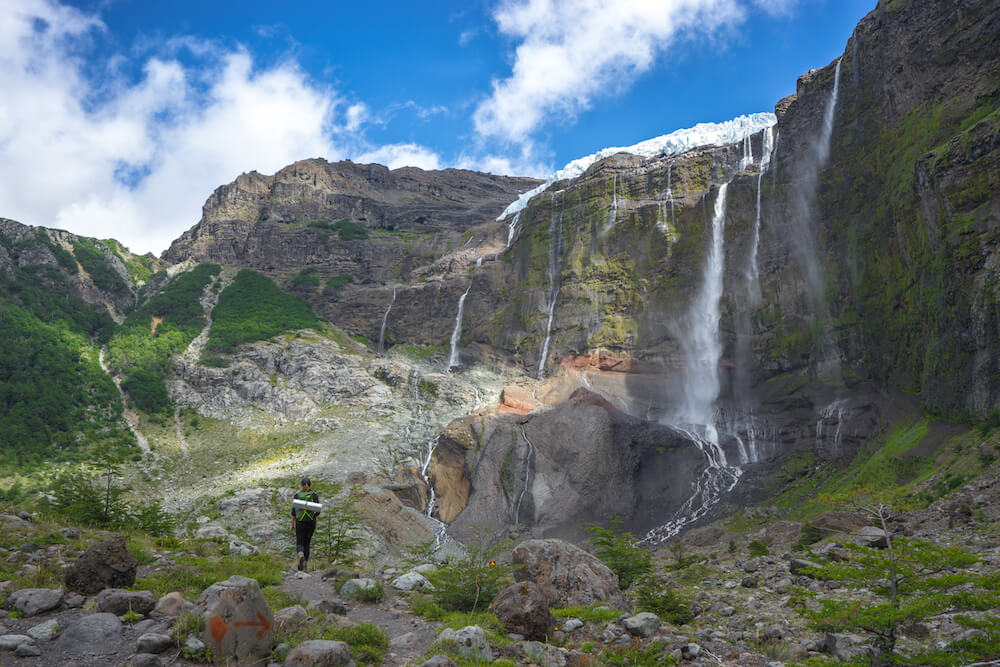
Difficulty: Medium
Length: 36km, overnight
At the north end of Patagonia in Argentina, the Tronador hanging glacier trek is an excellent introduction to the region. If you’re starting up there like I did, don’t miss this hike. The trail starts after a 2-ish hour bus ride from the nearby town of Bariloche, popular for skiing in the winter.
The beginning runs through a forest and is pretty easy until getting to a steep and winding portion called the caracoles. After that, the climb is mostly on rock and though long, the trek is not extremely difficult. There’s a refugio at the top where you can sleep for the night (book ahead in Bariloche at Club Andino!), or tote your own tent and camp. Watching the stars over the glacier is truly a spectacular sight. Read more about Bariloche and the hike here .
Refugio Frey
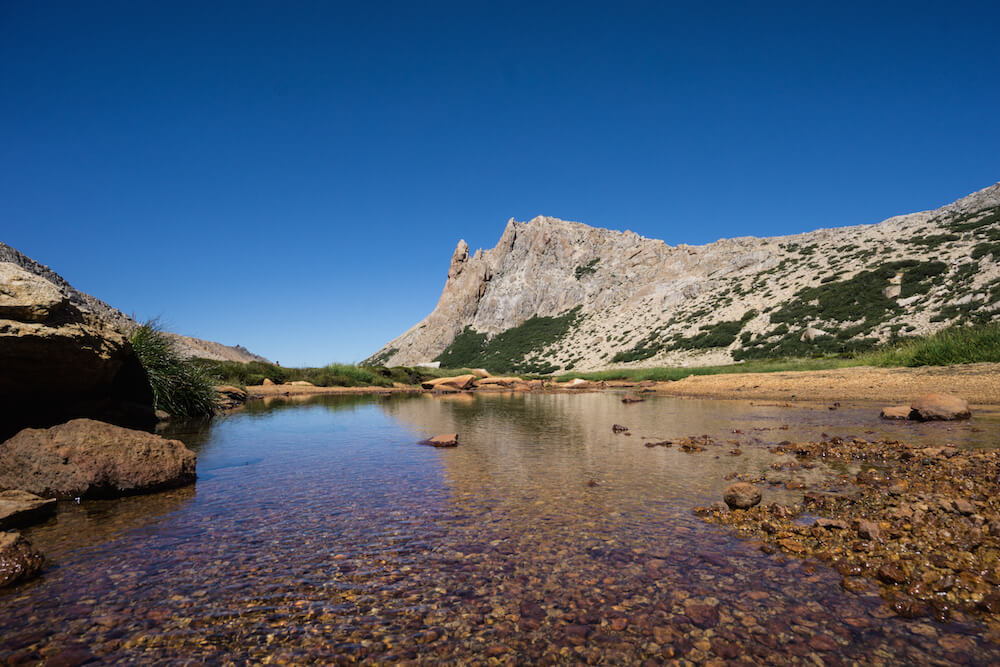
Difficulty: Medium
Length: One day
The time it takes to do this hike and the difficulty can really vary, since there are several ways to get to the Refugio Frey. You can take the ski lift up to the Condor lookout then boulder for a few hours, straight up then straight down, in order to reach the refugio, or you can take the forest path, or some combo of the two.
I love bouldering so I bouldered in and walked through the forest path back out, creating a loop. This hike is doable in one day but beware the steep and narrow path to the boulders for those who don’t like heights. It even had me shaking a bit and I don’t mind them at all!
Cerro Castillo
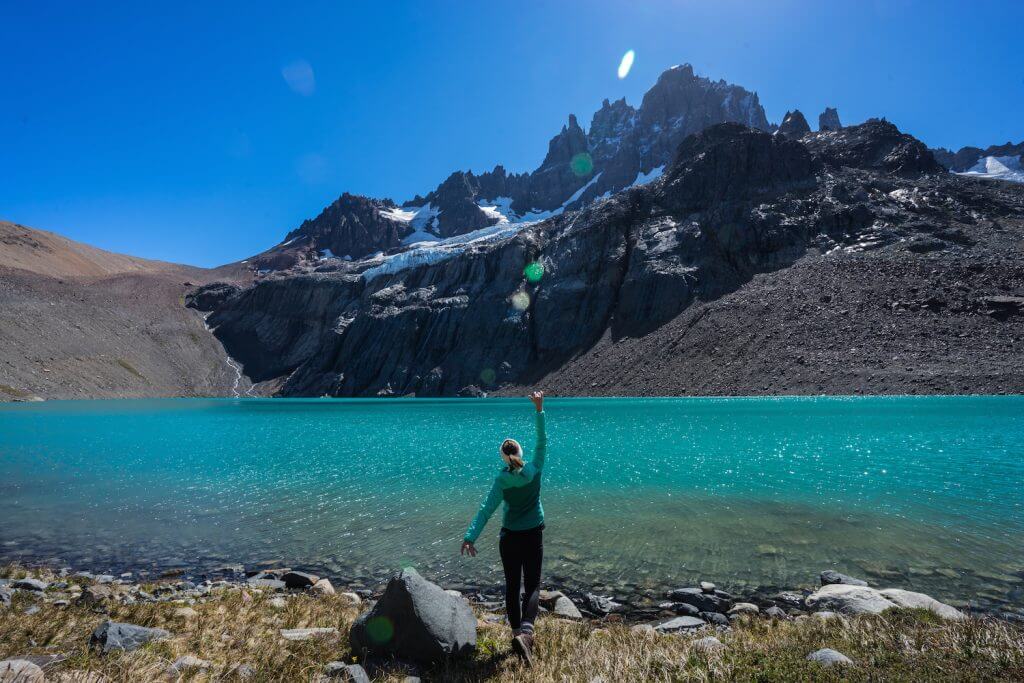
Length: One day
This used to be a multi-day trek from just outside of Coyhaique along the Carretera Austral, but these days they’ve opened up the ’emergency route’ from the town of Villa Cerro Castillo that sits just at the base, and allow hikers to go up the steep trail that takes only one day.
The Cerro Castillo, with its aqua-blue glacial lake and black rocks covered in white glacial ice would be a treat in and of itself, but the views in every direction of the painted mountains and canyons that lead to and away from Villa Cerro Castillo are absolutely stunning as well.
If you find yourself here, meet a gaucho and go on the hike. It’s an excellent way to spend a day.
Exploradores Glacier
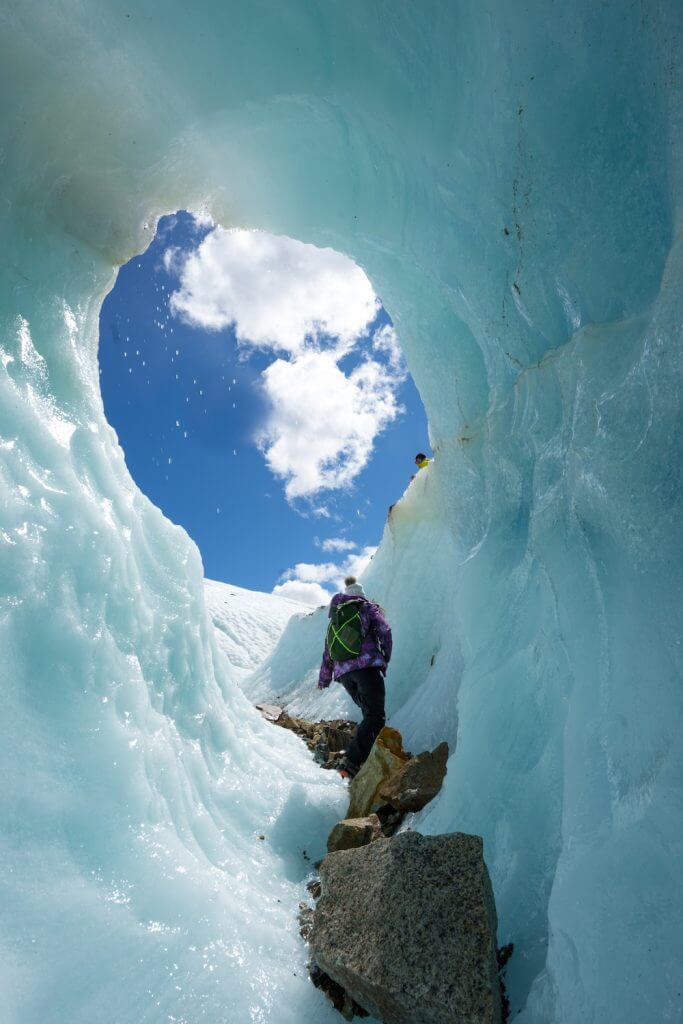
Length: Depends – full day of trekking for at least 8 hours
Part of what makes Patagonia exciting is how recently certain parts of it have been made accessible. It wasn’t even until the late ’80s that one could drive all the way down the Carretera Austral , the mostly gravel road that runs through Chilean Patagonia. Towards the end of it, you’ll find Puerto Rio Tranquilo, the gateway to the Exploradores Glacier.
A local there who runs the tours told me that he only became aware of the glacier over the past five years, and that tours on it have only been going for the last couple. They last several hours and it requires climbing over rocks on the glacier moraine for quite some time before reaching the ice, but once you do, you’ll see ice caves galore. More on how to do it yourself here .
From Villa O’Higgins to El Chaltén
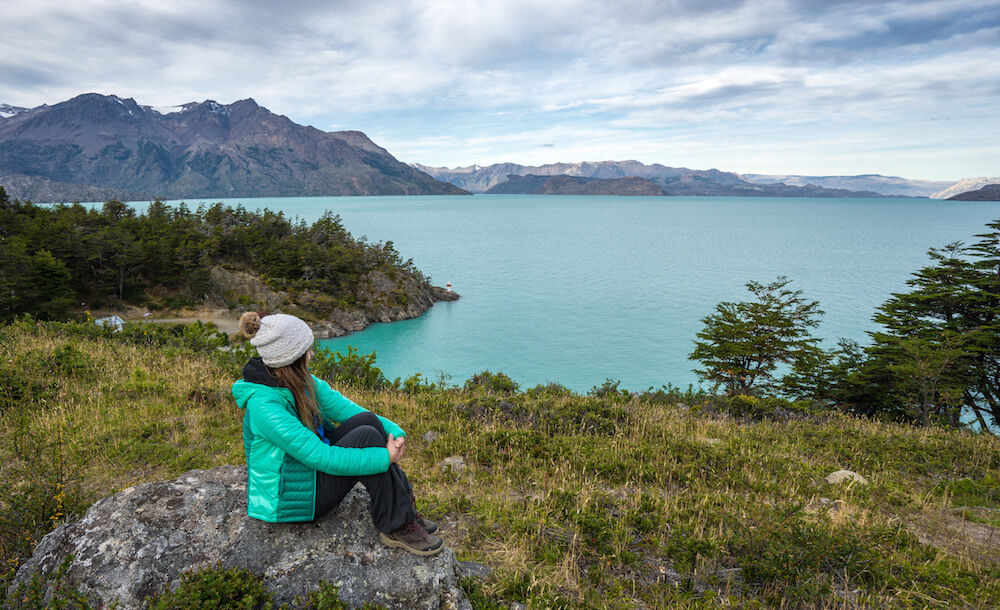
Difficulty: Easy
Length: Depends – 2 or 3 full days
This isn’t a typical hike, per se, so much as walking between two countries in no-man’s land. That makes this one of the most unique hikes in Patagonia and one you won’t see many others on.
This hike sits at the very end of the Carretera Austral, and requires a boat ride, which stops by the gorgeous O’Higgins Glacier, then goes onward to the most remote farm in Chile. Overnight there then get ready to hoof it for 22km into Argentina through no-man’s land.
Once you cross into Argentina, you have the choice to take a boat or to walk an additional 15km to where busses (or cars, if you fancy hitchhiking), can take you into the town of El Chaltén. Keep in mind you’ll be carrying all of your stuff with you for this one, so while it’s mostly flat, you’ll be loaded up and trudging through mud. If you want to give it a try, you can read all about the crossing here .
The Huemul Circuit
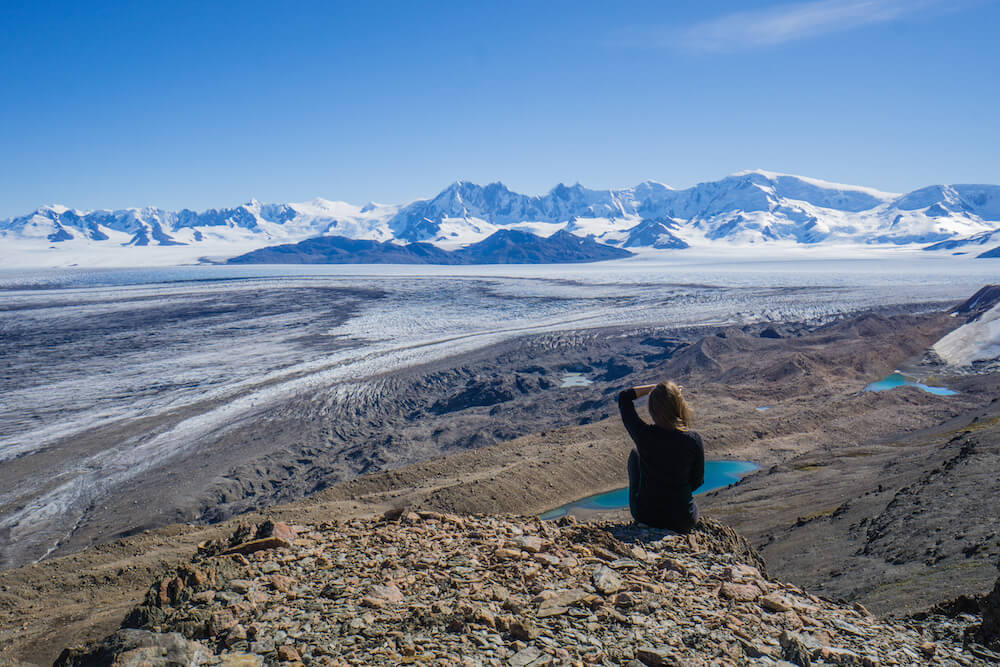
Difficulty: Strenuous
Length: 63km, 4 days
I won’t sugarcoat it, this is one of the toughest treks that I did in Patagonia. Parts of it are straight up and parts of it are straight down. For much of it, there is no real trail and it’s necessary to navigate by GPS. You’ll also need to bring a harness along to pull yourself across two rivers. This one ain’t for pansies!
All that said, this is one of only five trails in Patagonia that you can see the Southern Patagonian Ice Field from, and this view is worth it. Also, this is one of the least-crowded trails in all of Patagonia and while you won’t find any services or well-maintained campgrounds along the way, this is the real Patagonia and it’s incredible. Read more about the glacier lagoon and the Huemul Circuit here .
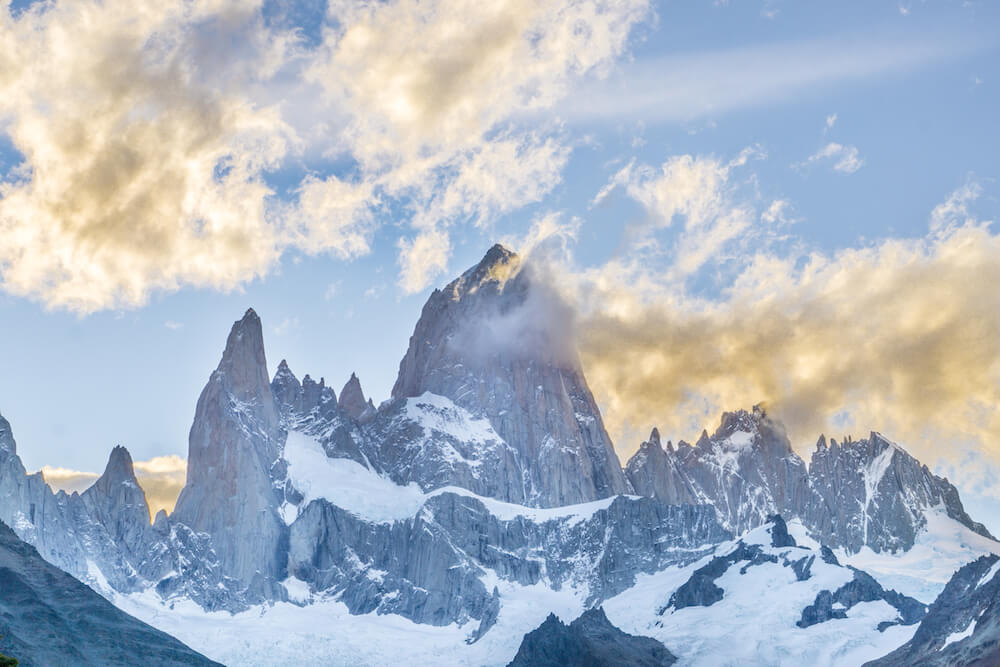
Difficulty: Mostly easy, then strenuous
Length: Full day
Do you recognize those rocks? This famous formation is on the label for Patagonia clothing, and is probably one of the most recognizable sights in Patagonia. Though this is a very famous trek, it’s definitely worth climbing to the top, despite the crowds, to see the Fitz Roy.
You can start the trek from the town of El Chaltén. Most of it is flat and lovely, until the final hour of the trek which is straight up a rocky trail. It will be strenuous, but it will also be worth it! Read more on the Fitz Roy (and the Torres noted below) here .

First Name:
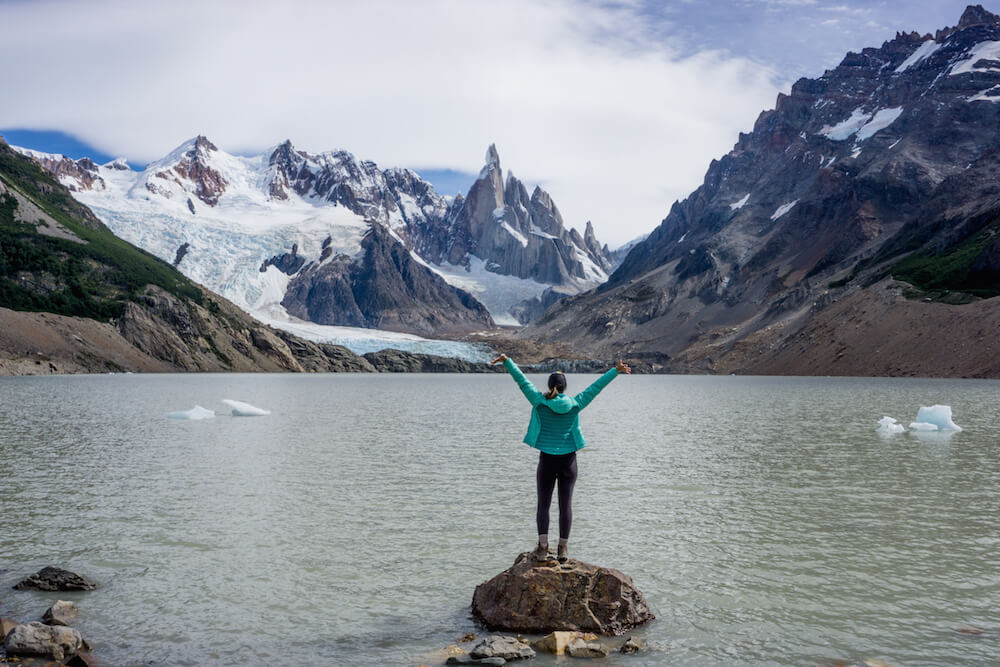
Finally, an easy trek that you can take from the town of El Chaltén without having to plan an overnight or sore muscles the next day! I say above that the length depends because it’s possible to combine the Fitz Roy and the Torres to make it an overnight hike, or if you’re fit enough and leave early enough in the day, it’s possible to hit them both and return back to town for dinner.
Though the trek is mostly flat, it’s long, so make sure that you bring along lunch and plenty of snacks!
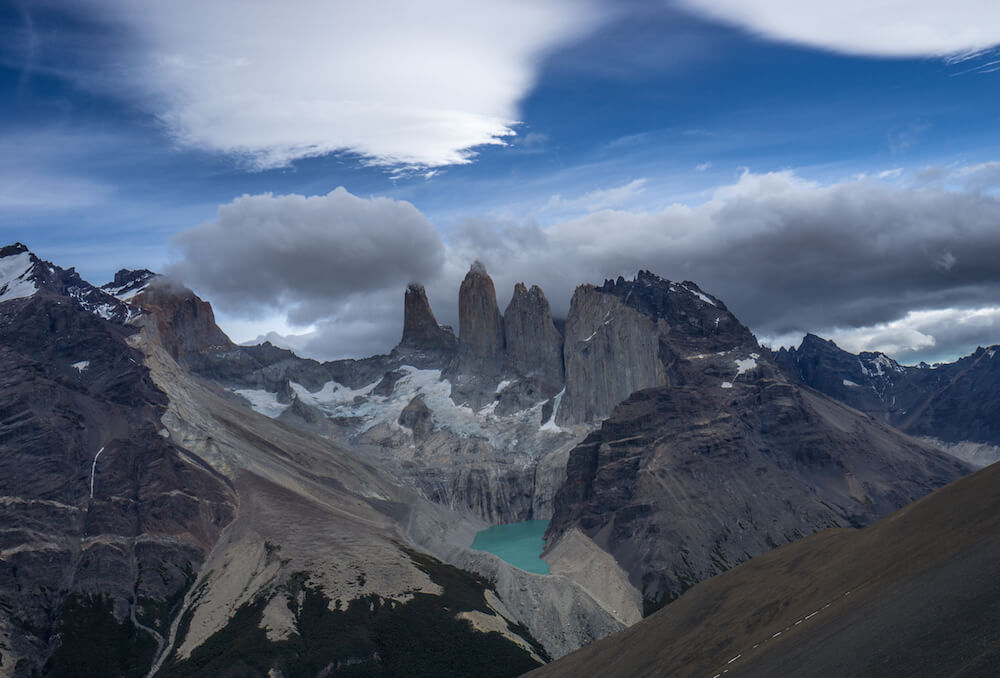
This is yet another trail in Patagonia that will have almost nobody else on it, but this time it’s not just due to the difficulty (by the way, this is a very steep trail on rock that just goes straight up and can experience some seriously heavy wind), but also due to the fact that it’s private land. It belongs to the Hotel Las Torres but if you stay with them, you can take horses part way up and down (recommended to save your knees), and you get a view of the towers that almost nobody else sees.
The Circuit in Torres del Paine
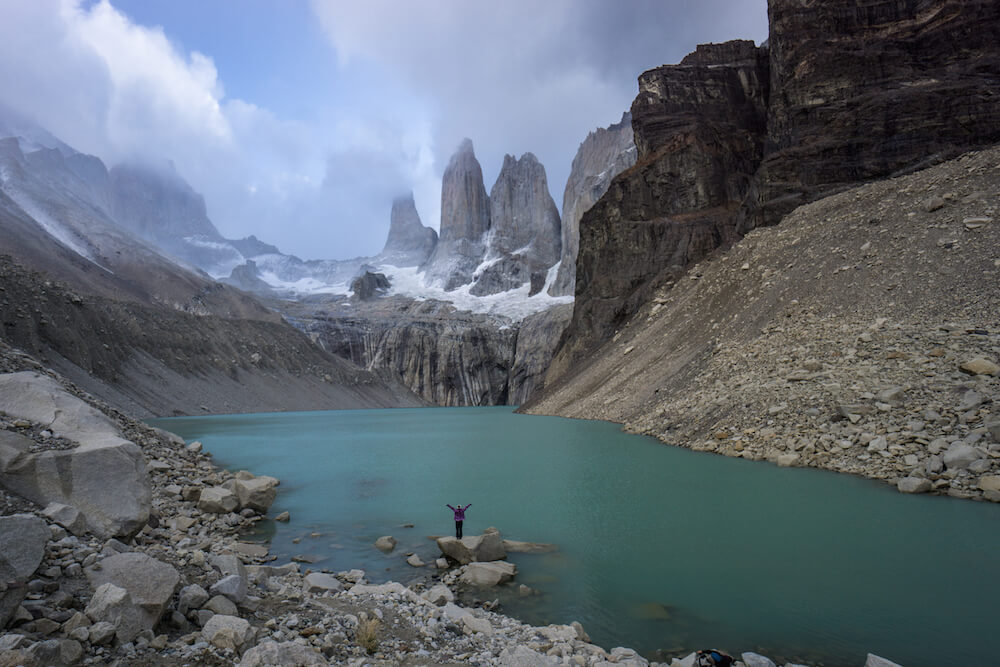
Length: 120km over 8 days (avg.)
The crown jewel of long hikes in Patagonia, Torres del Paine is great to work up to if you’re going from north to south like I did. Each year this park gets exponentially more popular as trekkers discover that Torres del Paine in Chile is a worthy adventure, full of changing landscapes and a glimpse of the Southern Patagonian Ice Field, especially from the full O circuit.
The trek takes about 8 days, give or take, and goes in a loop. If you’re short on time, it’s also possible to hike what’s known as the W, which shaves three days off of the trek and still shows you some amazing views, but none of the ice field, which was a special treat. Read more here on how to prepare for Torres del Paine and for 2019, I’m offering a women’s tour there! Click here to read more. If you’d rather not do 8 days, here are a few day hikes in Torres del Paine worth checking out.
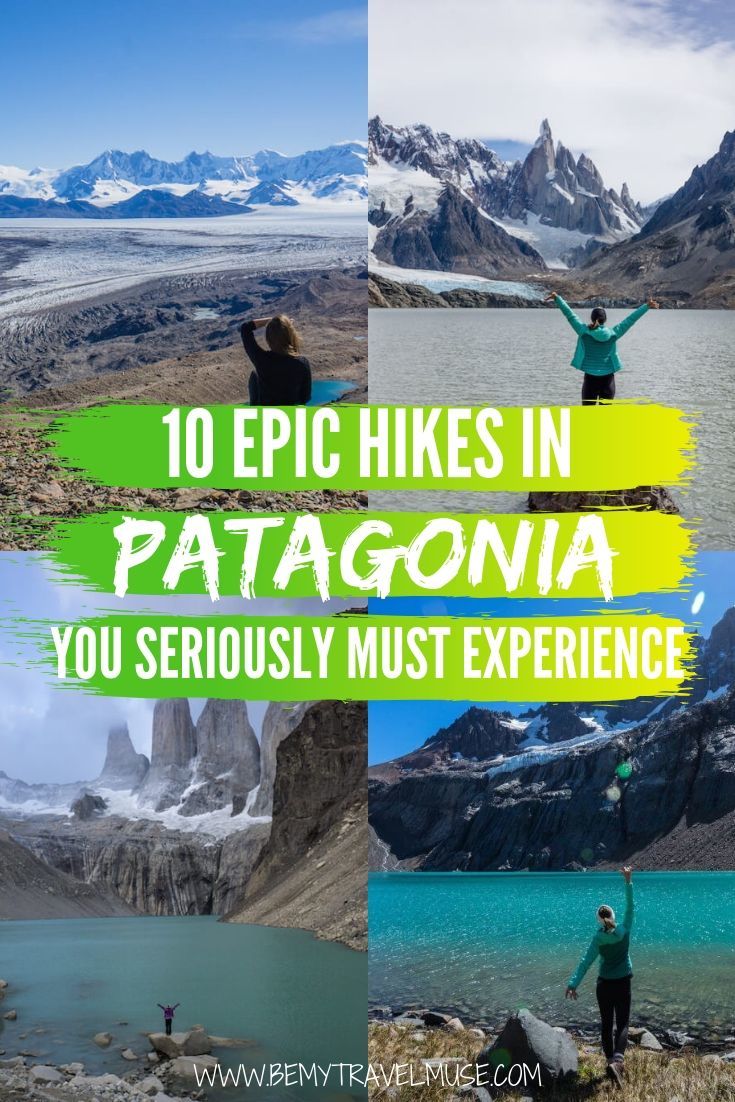
So are you convinced yet to head to Patagonia? Though it’s not the easiest place in the world to hike, it’s definitely one of the most picturesque and impressive.
If it’s your first time hiking through, be sure to check out my guide to trekking in Patagonia , read up on what to pack , and check out my itineraries for one week, two weeks, and one full month in Patagonia .
Happy hiking!
About Kristin Addis
Kristin Addis is the founder and CEO of Be My Travel Muse, a resource for female travelers all around the world since 2012. She's traveled solo to over 65 countries and has brought over 150 women on her all-female adventure tours from Botswana to the Alaskan tundra.
Leave a Reply Cancel reply
Your email address will not be published. Required fields are marked *
Save my name, email, and website in this browser for the next time I comment.
subscribe to our newsletter
This site uses Akismet to reduce spam. Learn how your comment data is processed .
Rebecca Hoffmann says
09/13/2016 at 6:55 am
Hi there, Great informative post and amazing pictures! Will for sure plan some trekking/hiking when visiting Patagonia.
09/17/2016 at 7:56 pm
So many amazing Patagonia posts! I would seriously not mind if Patagonia is all you wrote about for the rest of time 😀 I may just have to follow your exact itinerary through this bit of the world one day because I want to do every single thing you wrote about.
Kristin says
09/18/2016 at 1:31 pm
I’m out of things to say about it now 🙁 I’ll need to go back I guess 🙂
09/18/2016 at 1:27 pm
I really liked the Tronador but that’s two days. I also enjoyed the Fitz Roy and Cerro Torre quite a bit.
Maria Abud says
09/11/2017 at 12:38 pm
Hi, Is a great blog, indeed, I hike all those places and there is a great destination called Cochamo, In Chile. Which I go frecuentarlo with clients who want to go across the andes to Argentina. Is a must!
10/07/2016 at 3:43 am
This looks absolutely stunning! I spent awhile looking at photos of Patagonia and it’s definitely a Bucket List destination for us. I just hope that there are enough trails and places to visit for those of us who can’t really make it through a rough 20 miles route? I think I can comfortably manage 5 miles but not sure about much longer… I really do want to see these amazing places though!
10/07/2016 at 11:06 am
Most of the hikes I did are long and can be difficult but there may be more options 🙂
10/27/2016 at 2:43 pm
Hi and thank you! I will be doing a Spanish language immersion program in Buenos Aires for two weeks. Following that I would like to go with an organized group to hike Machu Picchu and to “hike in Patagonia” (I know it’s a large area!). Would you recommend I hike in Patagonia first, and then head up to Machu Picchu (instead of doing Buenos Aires then M.P. then Patagonia?). And what would be the one amazing Patagonia hike to do that is as close as possible to Buenos Aires? Thank you again…!!
10/28/2016 at 10:24 am
You could head to Bariloche: https://www.bemytravelmuse.com/things-to-do-in-bariloche/
12/07/2016 at 6:02 am
Hi, I really like your blog!
When you did the Huemul Circiut, did you do it on your own or with a guide? I’m traveling on my own and I don’t want to do it by myself, do you know if there are companies in Patagonia I can to the circiut with? Thanks <3
12/07/2016 at 10:20 am
You can definitely do it with guided groups. I did not have a guide, and actually met a guy on the trail who started the trek on his own then asked if he could join up so that he wouldn’t be solo and of course Steve and I said yes. That was a gamble he took starting on his own, though.
01/30/2017 at 4:15 pm
Great content and amazing hikes ! I am currently roughly following your route trough Patagonia, but I am not getting as lucky as you with the weather 🙁 On all of the pictures you have awesome weather and gret views. I just get rain and clouds haha. Unfortunaly I couldn’t see neither Cerro Castillo nor the Fitz Roy.
How did you manage to always have perfect weather ? Was it just pure luck, did you sometimes wait for good forecasts or even went multiple times for the same hike ?
01/30/2017 at 11:52 pm
Hey Max, since I spent 2 months there I waited it out when the weather was bad. I had 10 days in El Chalten and hiked for 6 of them. I did also just get very lucky!
09/11/2017 at 12:47 pm
Hi MAx. The best time to visit Patagonia in my view is March,. I live in Patagonia, born In Argentina and I can recommend early December or March, still very good weather and less tourists, Although the climate is changeable and unpredictable.
anthea says
04/15/2017 at 7:12 am
Hello there, I loved reading this article! Was wondering – for those treks that you’ve mentioned did you do them as day trip, camping? Solo or with hired group? I’m a solo female traveller doing my first big trip to South America July-December and I’m hoping to cut costs by hiking and trekking solo, maybe camp as well 🙂 of course, this is my first trip so safety and not getting lost in wilderness is of top concern
04/15/2017 at 8:42 am
Hi Anthea, I never did a group or hired a guide for any of these Except for the Exploradores Glacier because you really need one when glacier trekking as they know where the crevasses are. I noted on each one how long it took. Some were day trips and some were more like 4 or even 8 days. I was with my friend Steve so I wasn’t solo but on every trail except for the Huemul Circuit, there were plenty of other people so you won’t be hiking alone!
05/07/2017 at 1:23 pm
Awesome coverage of the hikes. I have been in Patagonia for 1 month and am still here. Sadly, I hurt my knee on the third day of the W trek, returned on the 4th day, missed out the Torres. When I attempted Fitz Roy a week later, just 5 minutes from the top, there was a snowstorm, it was extremely windy and slippery and everyone had to turn back. Patagonia hasn’t been kind to me 🙁 Bad knee = missing out on pretty much the whole Patagonia haha.
05/08/2017 at 3:20 am
Ah, I can imagine Patagonia gets more and more difficult as it gets snowy and icy! Definitely do some stuff on boats then! Visit glaciers without having to hike 🙂
Gerald says
07/22/2017 at 9:19 pm
Hello Kristin,
Love your blog! Using it alot to plan our trip! You mentioned that the Huemul Circuit is one of the five treks with views of the Southern Patagonia Ice Field. We’re really keen on getting views of the ice field but the Huemul Circuit looks really challenging! Could you share what the other treks are? Thx!
07/23/2017 at 6:21 am
You can see it from the O in Torres del Paine as well! Less challenging: https://www.bemytravelmuse.com/torres-del-paine-circuit/
Olivia Chen says
08/10/2017 at 8:01 am
Hi Kristin,
Thank you for sharing all the beautiful inspirational pictures and details about your favorite hikes.
Can you tell me more about how I can do The Torres & Fitz Roy in one day? I was planning on doing the W-circuit and taking a bus to El Chalten to do a Fitz Roy day hike.
Thank you. Olivia
08/10/2017 at 8:42 am
Sure, there’s a part in the trail where the two connect but that doesn’t meant the Torres in Chile it means the Torres out of El Chalten. They have the same name.
Travel with Malin says
11/22/2017 at 1:57 am
Awesome post!! Going to Patagonia in one month and this is awesome!!!
Rachel says
12/27/2017 at 1:04 pm
I spent february and march in Patagonia. Your posts were very helpful, especially about the hikes around Bariloche and Torres del Paine and along the Carreterra Austral! I didn’t make it all the way to Higgins but it was quite an adventure! Chile stole my heart. As a solo female traveller it gave me a lot of confidence to do it on my own. So thanks again for that! Looking forward to new posts!
12/27/2017 at 1:06 pm
Amazing! Thanks so much for coming back to tell me! I’m glad that you went and had a blast. Patagonia is so amazing.
05/07/2018 at 2:50 pm
awesome post! Argentina is home to some beautiful spots, but it can get crowded and expensive (especially torres del paine) I just finished an article about free trekking near bariloche incase any other travelers in Argentina are looking for some outdoor adventure. check it out 🙂
05/08/2018 at 4:05 pm
Wouldn’t you know TdP is in Chile, then?
Anonymous says
03/27/2019 at 12:20 am
Ohhhhh we did laugh tremendously didn’t we Joffers
07/25/2018 at 8:07 am
Hi All sound so wonderful! My husband and I will be in Beunos Aires and would love to make it to Patagonia just for a few days and do a hike or two. We are moderate hikers from Northern California, and would be interested in some 8 Mile hikes. Any suggestions? And where would we fly into for the hikes. Thanks! Anna
07/27/2018 at 12:04 am
Maybe look at Bariloche then! https://www.bemytravelmuse.com/things-to-do-in-bariloche/ I love El Chalten too but you’re looking at much longer than 8 miles for almost all of the hikes.
James Ingersoll says
08/15/2018 at 8:05 am
Thanks for the information! Based on what i read, I will take in the ice caves. I will take your word when you say this is much better than Grey. I look forward to leaving for Chile in 3 days. I just miss my Minnesota winters so much, I need to find one.
08/16/2018 at 9:19 pm
If you mean Exploradores YEAH that glacier was soo cool! I’ve hiked on a few since and none had those awesome ice caves. Have a blast.
Kate Daly says
10/02/2018 at 2:52 am
Hey! Your Patigonia blog is being a lifeline for me planning my trip for 2 months to the area. I was wondering if you could give me any ideas though. I have these 2 months off work and really want to feel like I’ve achieved something out there with the time. All the hikes like the o and the Huemul look amazing and am so keen to do but what I want to combine is a real journey rather than lots of things I could really do on holiday.
Walk from a town to another for 2 weeks or something if you get my drift….
Any help appreciated!! Xxxxx
10/02/2018 at 3:34 am
Then I bet you’d love the Carretera Austral: https://www.bemytravelmuse.com/patagonia-hitchhiking-guide/
11/03/2018 at 12:00 pm
Thanks for the advices trek, it definitely worth reading. Can you recommend an equipment ? Do you think it’s possible with a tarp ?! Thank you !
11/04/2018 at 12:33 pm
Gosh that would be so cold! I have suggestions here: https://www.bemytravelmuse.com/how-to-prepare-for-trekking-in-patagonia/
11/19/2018 at 12:49 am
Hi guys, Does anyone have some tips for the best 4-5 day trek, up to 5-6,000 metres? Ive done a fair few hikes/light climbs around that before. Or maybe a combo of two treks, doesnt really need to be high. Thanks very much Sam
11/19/2018 at 3:22 am
thankfully Patagonia is low elevation! You could turn a lot of the hikes in El Chalten into at least an overnight or 3-day trek: https://www.bemytravelmuse.com/el-chalten-hiking-guide/
The W in Chile is just the shorter version of the O and can be 5 days: https://www.bemytravelmuse.com/torres-del-paine-circuit/
12/23/2018 at 11:06 am
Thanks Kristin – it looks truly wonderful. I am trying to plan some treks like this in Patagonia myself. Lots of tour companies organise (expensive) organised treks that can be booked months in advance. My preference, however, would be just to go to the area and do the treks on the spur of the moment that are appropriate to the current weather conditions etc.. Is it common to meet up with other like-minded people in the main hubs (e.g. Bariloche) and just decide to trek together? E.G. Are there local hiking clubs running lots of treks daily/weekly etc? I’m just trying to avoid the hit-and-miss business of organising treks from afar. regards. Rob
12/23/2018 at 11:37 am
You should be able to meet others to hike with. Stay in hostels instead of hotels and it’ll be easier.
Charles says
08/07/2019 at 12:28 am
Hey Kristin! Thanks for the amazing article. I am planning a trip to Patagonia in February and am very excited for all the different trekking options. I did have one question though – the Las Pumas hike that you mentioned…I can’t seem to find much information about it. I was wondering if you could let me know where the starting point of the hike begins. If I plan on doing the O circuit, does it make sense to add one additional day at the beginning or end of the trek at the Central or Chileno campgrounds in order to fit the hike in? Any help is greatly appreciated! Thank you, Charles
08/07/2019 at 7:19 am
To do Las Pumas you have to be a guest at the Hotel Las Torres, which is probably why you didn’t see much about it. The trail is on their private property.
08/07/2019 at 11:56 am
Got it! Appreciate the quick response and thanks for all the great info you have up on the site
Karen Peabody says
03/15/2020 at 9:27 pm
My wife and I do a lot of backpacking and will be there for 1 week was wondering what suggestions you have
Brooke says
01/24/2022 at 7:13 am
Thank you so much for all the great information, I can’t wait to plan a trip and hike these mountains, thanks!

- Standard Domes
- Superior Domes
- Suite Domes
- Suite Dome Loft
- Yoga & Wellness
- 7 Day W Trek
- 7 Day W Trek - Brush Variant
- 5 Day W Trek
- Wildlife Safari
- Epic Patagonia
- Puma Tracking
- 9 Day Paine Circuit
- Green Ethos
- Social Commitment
- Cultural Preservation
- Torres del Paine
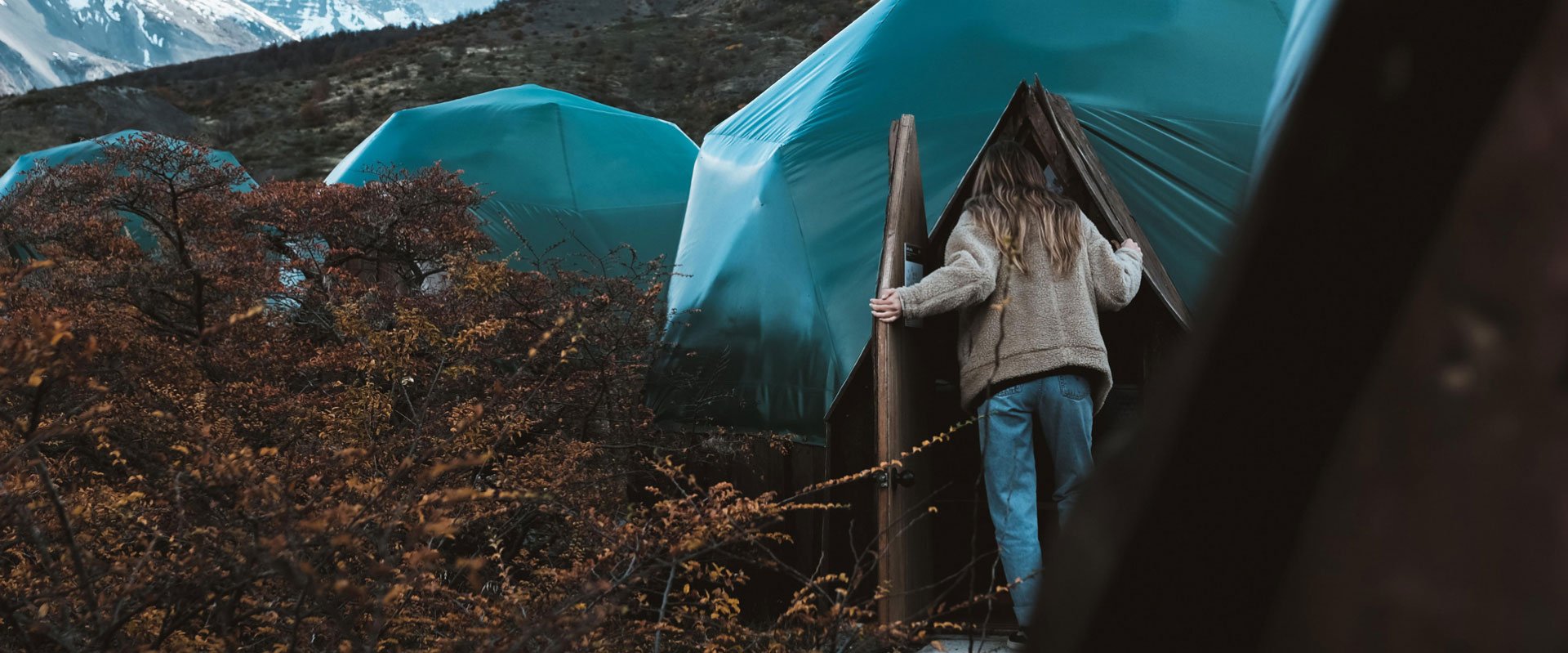
The 5 Best Trekking Circuits in Patagonia
From the rugged peaks of Reserva Cerro Castillo (Aysen Region, Chile) to the giant glaciers of Los Glaciares National Park (Argentina), planning a trekking trip to Patagonia can quickly become a dilemma. There's just too much to see, the distances are long, and you need time, the one thing most visitors don't have. However, every trekking circuit has its particularities making a big difference when it comes to helping you make a decision.
1. Cerro Castillo Circuit
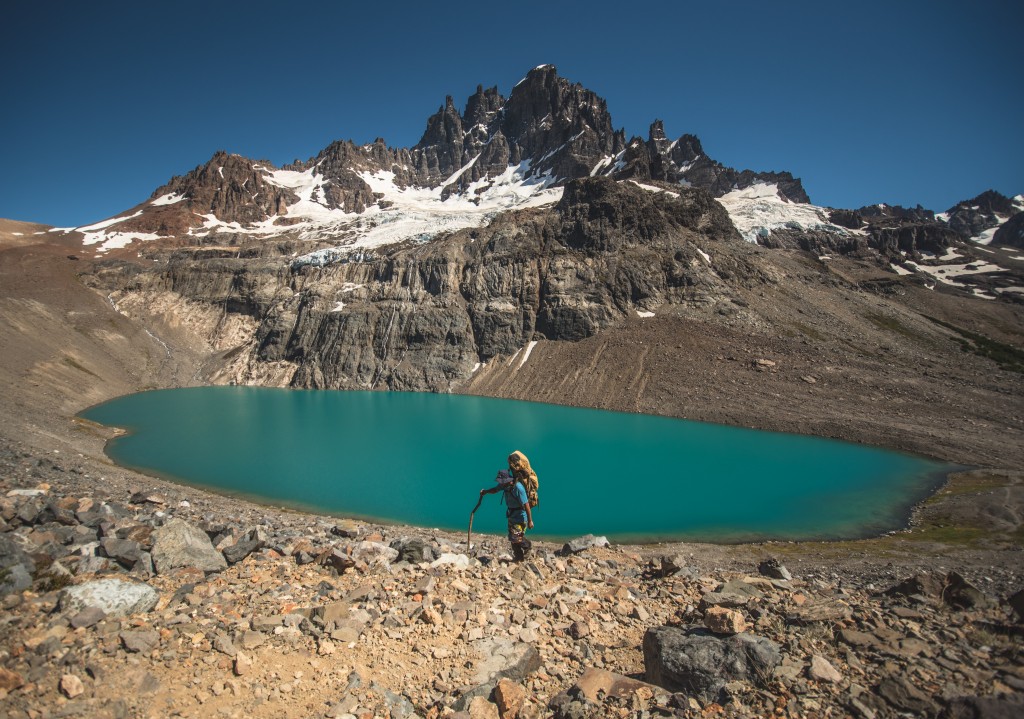
Location: Reserva Cerro Castillo, Aysen Region (Coyhaique Region), Chile
Distance & time: 51km/32mi | 3 to 4 days
Difficulty: Demanding
Cerro Castillo is without a doubt amongst the most beautiful mountain ranges in the Americas, yet its beauty is still under undervalued, making this trail a great alternative to more crowded trails like Torres del Paine National Park. The trek starts about 80 km/50 mi away from Coyhaique, in Chile’s incredible Aysen region (nearest airport is Balmaceda). The best way to start this trek is to head to “Las Horquetas”, 30 kilometers before reaching Villa Cerro Castillo leaving from Coyhaique. From there it is a 4-day epic trek through remote snowy valleys, lush green forests and incredible blue lagoons.
Take into account that climate here may be extreme especially in Autumn and Winter months. It often snows and precipitations may make the experience more adventurous, especially on the trek’s second day (Rio Turbio campsite to Laguna Cerro Castillo) as you hike at 1300m.a.s.l (about 4265ft) through an exposed valley. For that reason, we recommend to hike during Summer months (Nov. to February). There are lots of ups and downs making this trek pretty challenging Also, there is absolutely no infrastructure along the circuit (only campsites), so only do this trek if you’ve got some hiking experience and love to camp.
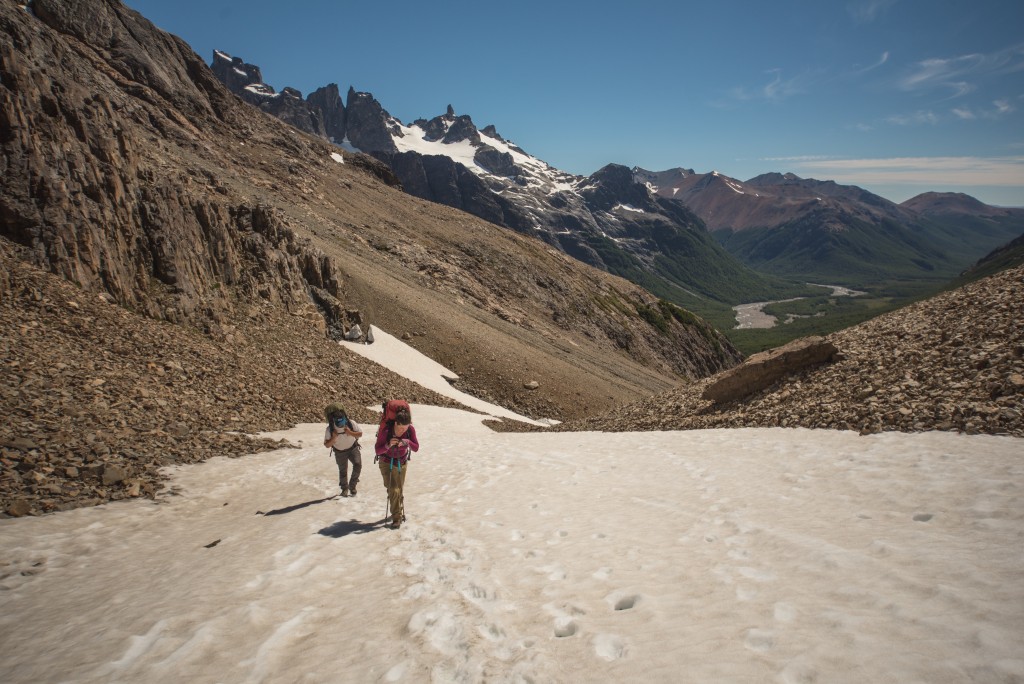
Why we love it:
- The diversity of landscapes
- The beauty of Mt. Cerro Castillo (2675mts/8776ft)
- The quietness on the trails
- The proximity to the “Carretera Austral” (Patagonia’s most epic road)
- The epicness of the campsites’ location
- A true feeling of adventure
Take into account that:
- Weather may be wet
- Autumn, Winter and early Spring may be snowy
- There are no refuges, only campsites
- Previous trekking experience is strongly advised
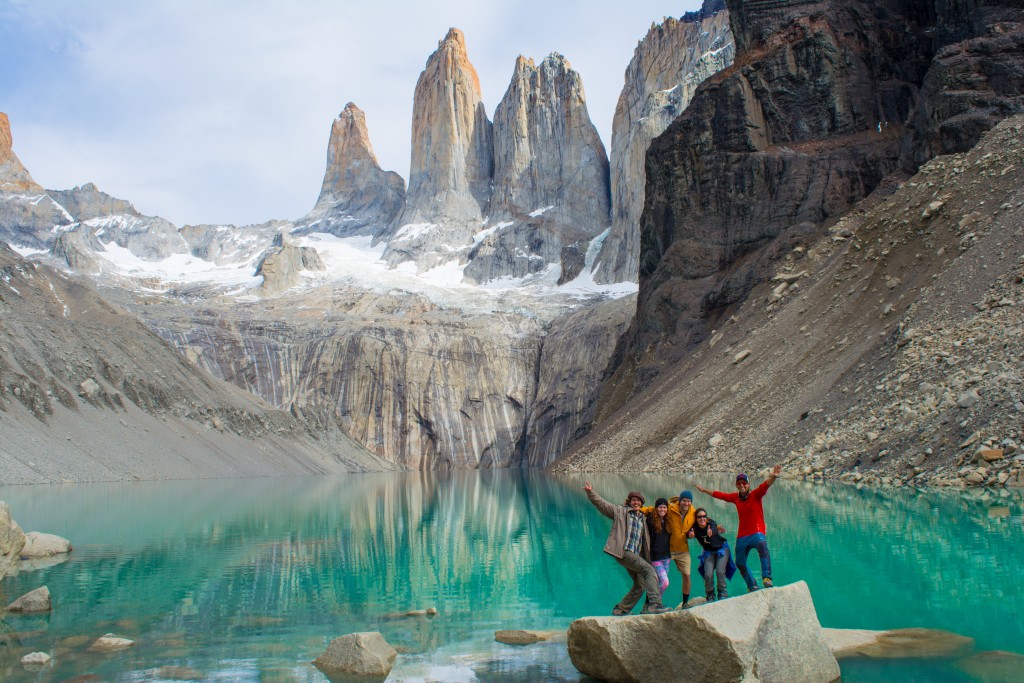
Location: Torres del Paine National Park, Magallanes Region, Chile
Distance & time: 51km/32mi | 4 to 6 days
Difficulty: Moderate
Torres del Paine National Park is also known as “Patagonia’s Crown Jewel” and it is easy to understand why. With its incredible fauna, dramatic granite peaks and giant ice fields, this 242 000 ha vast National Park is home of some of the beautiful trails on Earth. The W Trek is the most popular hiking circuit in Patagonia and it is easy to understand why.
Take a look at the shape of the circuit on a trekking map and you’ll understand the name of this worldwide famous circuit. There are different starting points (Grey Glacier, Paine Grande refuge or the towers’ area) but whichever you choose, you will see the same highlights. Grey Glacier is part of the Southern Patagonian Ice Fields and the W Trek is the best way to have an overview of how giant it is. Keep hiking and you’ll discover the stunning Frenchsman Valley, where you’ll see the park’s highest peak (Paine Grande), avalanches, incredible granite peaks (Los Cuernos, the Shark’s Fin and more) and some of Patagonia’s prettiest lakes (Pehoe Lake, Nordenskjold Lake). You can’t miss then Towers’ Base Lookout hike and an insane viewpoint of the 3 granite towers that gave their name to the park.
Trails here are well indicated and every day you have different sleeping options, with cozy refuges (Los Cuernos, Paine Grande) and large campsites. You can even spend a few nights in some incredible hotel like Ecocamp Patagonia ... Watch a video here .
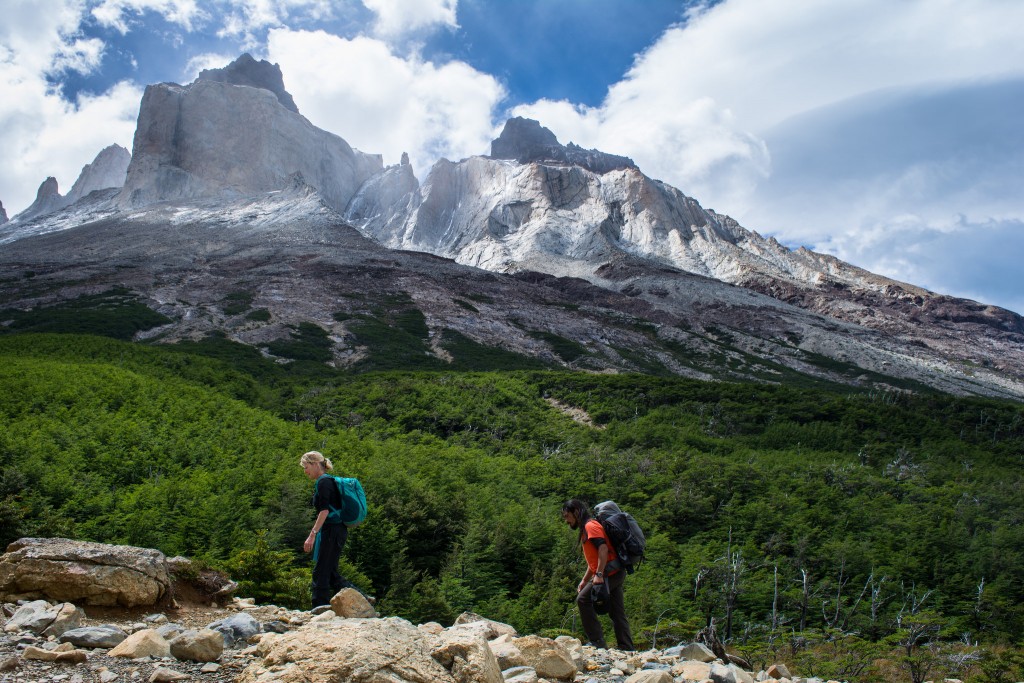
- Some of Patagonia’s most beautiful viewpoints
- Incredible diversity of landscapes
- Trails are well indicated
- Cozy refuges, hotels and campsites
- You can hike the W Trek all year round, even in Winter!
- The region can be very windy especially in Summer
- Trails may be crowded especially in Peak Season (December to February)
- You need to book refuges and campsites with months of anticipation
3. El Chaltén
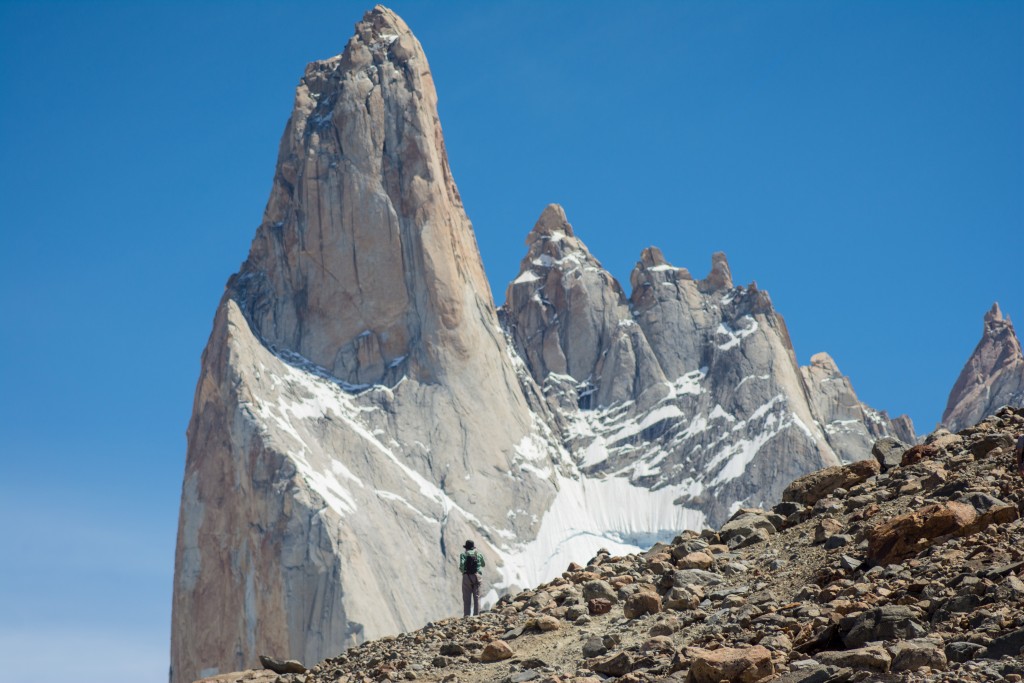
Location : El Chaltén, Los Glaciares National Park, Argentina
Distance & Time : 50 km/30mi | 2 to 4 days
Difficulty : Moderate
OK, this is not really a proper “trekking circuit” as you can go back to El Chalten – the nearby village – every night. However you can also camp in the forest and explore the highlights of the area – Cerro Torre and Mt. Fitzroy – in a couple of days and eventually add a few days to discover the surrounding trails. El Chaltén is Argentina’s hiking capital and its mountain range includes some of the world’s most famous peaks. Cerro Torre (3102m.a.s.l/10200ft) and Mt. Fitzroy (3405m.a.s.l/11200ft) are a fascination for climbers around the world, Cerro Torre being considered for a long time an “impossible mountain” to climb.
Good news is that hikes are nothing technical. The hike to “Laguna Los Tres” to reach Mt. Fitzroy’s viewpoint is steep for about an hour and a half, yet views are completely rewarding. You can start hiking from El Chalten without paying any entrance fee and trails are very well marked and indicated with signs. Just like Torres del Paine National Park, the region can be very windy (especially from November to February) but believe me, this unstable weather makes the experience even more unforgettable.
If you’re looking for a more extreme trekking experience, other options are the “Huemul Circuit” and “Loma del Pliegue Tumbao” that both offer real mountaineering experiences. Check out our Argentine programs here .
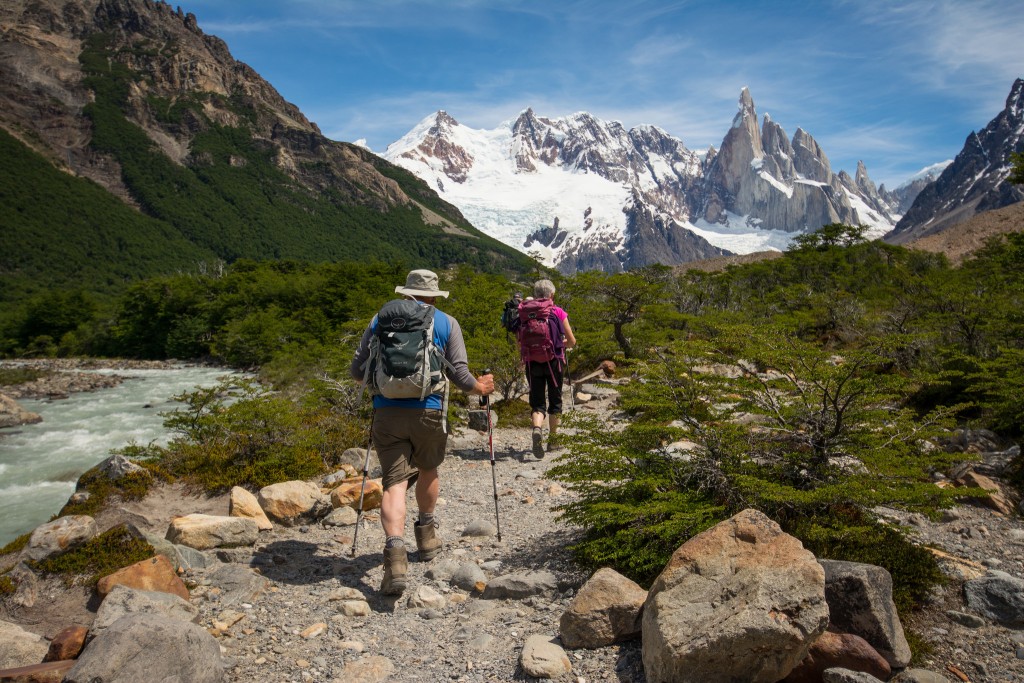
- Some of Patagonia’s most iconic peaks
- Trails are well-marked
- Viewpoints are incredibly rewarding
- The possibility to go back to El Chaltén every night
- No National Park entrance fee
4. Los Dientes de Navarino
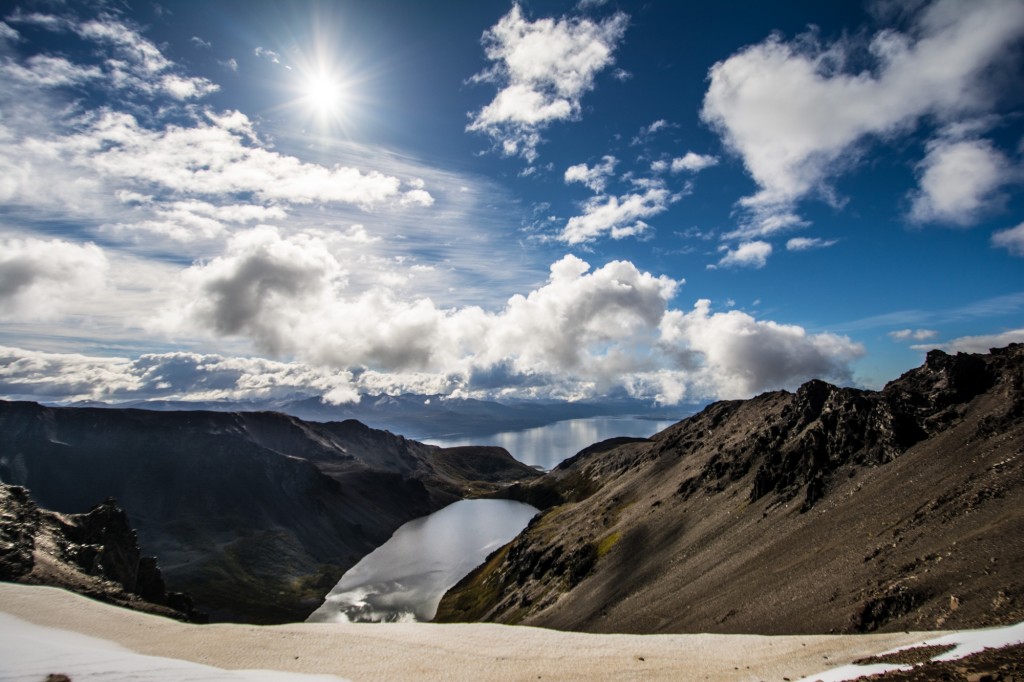
Location : Navarino Island, Magallanes Region, Chile
Distance & Time : about 37 km/22mi | 4 to 5 days
Difficulty : Demanding
This is by far the wildest trekking circuit in Patagonia. “Los Dientes de Navarino” (the teeth of Navarino) is near the legendary Cape Horn and not far from Ushaia, the southernmost city on Earth. The starting point is Puerto Williams, the southernmost village on Earth known by sailors as a stopping-off place before heading to Cape Horn through the Beagle Channel. Climate here is one of the harshest on the planet with regular strong windgusts and low temperatures especially from April to October. That mix of mountain and oceanic weather can make this circuit particularly demanding and you will be happy to have either a good map or a GPS not to lose track of the trail in case of snowfall.
You won’t walk for more than 10 km / 6 mi a day yet this trek is truly intense in scale. Leaving Puerto Williams, you will hiking up Cerro Bandera at 550m.a.s.l and head to “Laguna del Salto” where you can spend the first night. On the next days, you will walk across a series of remote valleys with beautiful viewpoints of the dramatic surrounding peaks (the famous “teeth”) and will eventually see Cape Horn in the distance, the end of the American continent.
This 6-Day trek by Cascada Expediciones was awarded “Best Transformational Travel Experience” in the Pure Awards 2017 and it truly deserves it. You will get the sensation to travel back in time with desolated landscapes and no human infrastructures. Careful though: this means you may have to camp in muddy cold places and hike against the wind. Isn’t it what we’re all looking for? Check out this video : " Hiking Los Dientes de Navarino in 2 Minutes ."
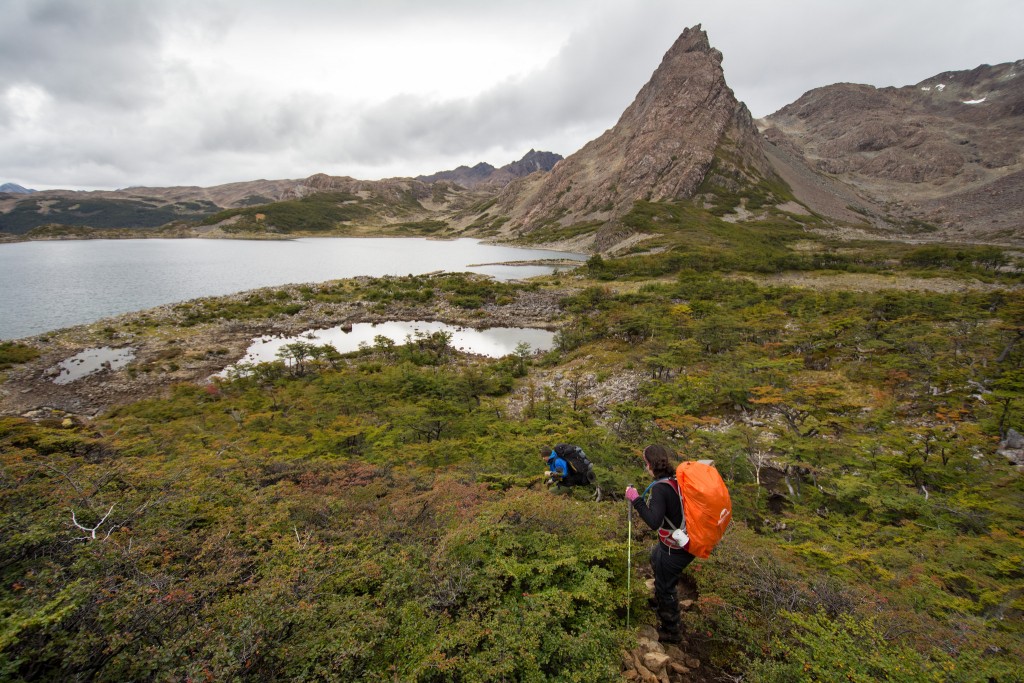
- True wilderness
- The less crowded trails in Patagonia
- The southernmost trail on Earth
- Incredible viewpoints of the Beagle Channel and Cape Horn (if clear weather)
- Climate can be very harsh with low temperatures and strong windgusts
- Only for experienced hikers
- Hiking with a guide is strongly advised
5. Torres del Paine Circuit
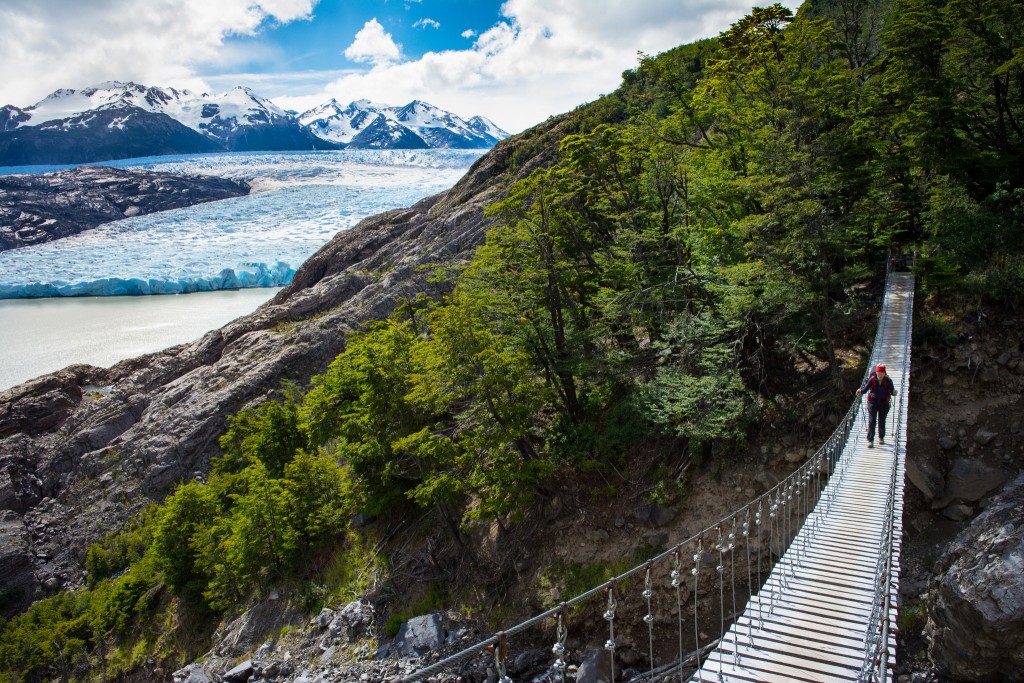
Location: Torres del Paine National Park, Magallanes Region, Chile
Distance & Time: about 138 km/83 mi | 7 days
Difficulty: demanding
This is certainly the most complete trekking experience in Patagonia. OK, Torres del Paine National Park is famous for its diverse wildlife and otherworldly landscapes, yet the Circuit is the most epic way to realize how giant and impressive this park truly is. Starting point is the Seron woods; and the regular way to depart the circuit is to hike 32 kilometers on the first day to reach the Dickson campsite, behind the Paine mountain range. This is the wildest area of this national park and also the most remote, which means logistics are complex and the feeling of nature immersion is authentic.
Hiking through Los Perros forest and reaching the famous John Gardner Pass is an incredible experience, with insane views of the Southern Patagonian Ice Fields and changing weather that can turn your hiking experience into an odyssey. As you reach the trails of the W Trek, you will see how different this is from the less-known trails of the circuit. More crowded, less wild. Yet landscapes like the Frenchsman Valley, Grey Glacier and the towers are pretty unbelievable and this coupled with the other side of the mountains makes for an incredible hiking experience.t
The Torres del Paine Circuit is considered by many as Patagonia’s best trekking circuit, yet it is a pretty long hike only recommended for experienced hikers. The circuit is closed in Winter (May to September) but you should be prepared for all kinds of weathers. Click here if you want the best Torres del Paine Circuit experience while staying in the world’s first geodesic dome hotel !
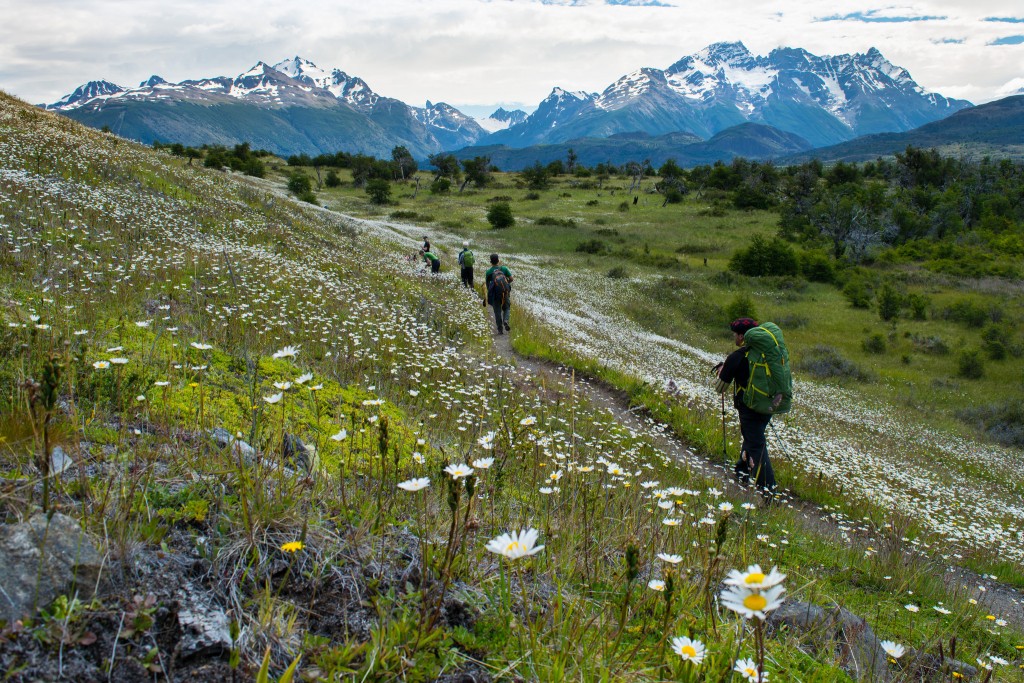
- Overall stunning trekking experience
- Quiet trails in the backside of the Torres del Paine Mountain range
- Incredible views of the Southern Patagonian Ice Fields
- Otherworldly mountains everywhere
- Comfortable overnight options
- You can experience 4 seasons in a day and very strong wind gusts
- You should Book accommodation with months of anticipation
Ready to embark on your outdoor adventure? Check out our trekking programs here! Or reach out to us directly. Our EcoCamp Patagonia contact information can be found here.
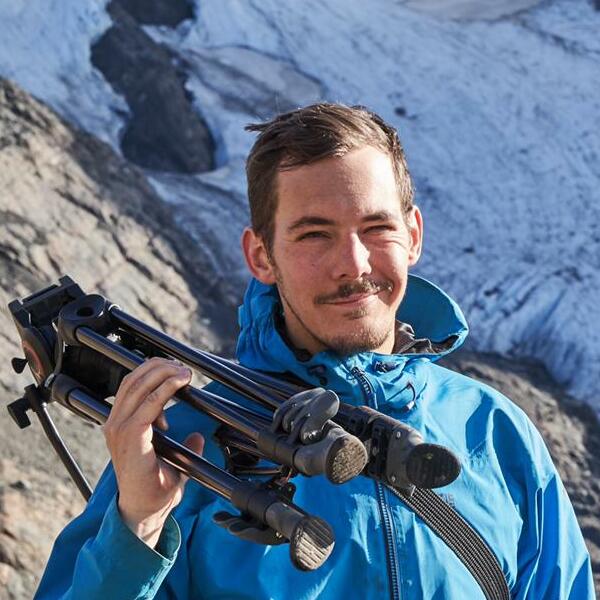
Written by Timothy Dhalleine
Driven by an insatiable wanderlust, I have left my native Hesdin in the north of France in a bid to uncover the tales the soaring peaks of Patagonia and the immensity of the Chilean desert have to tell. I am currently exploring the magic of Torres del Paine National Park while reaffirming my idea of a more sustainable world and my passion for nature as Guest Engagement Manager of Ecocamp Patagonia.
Subscribe to our newsletter
- Related posts -
Tracking pumas in a puma's paradise : torres del paine national park, the best easy excursions in torres del paine national park, take an epic adventure to the base of the paine towers.
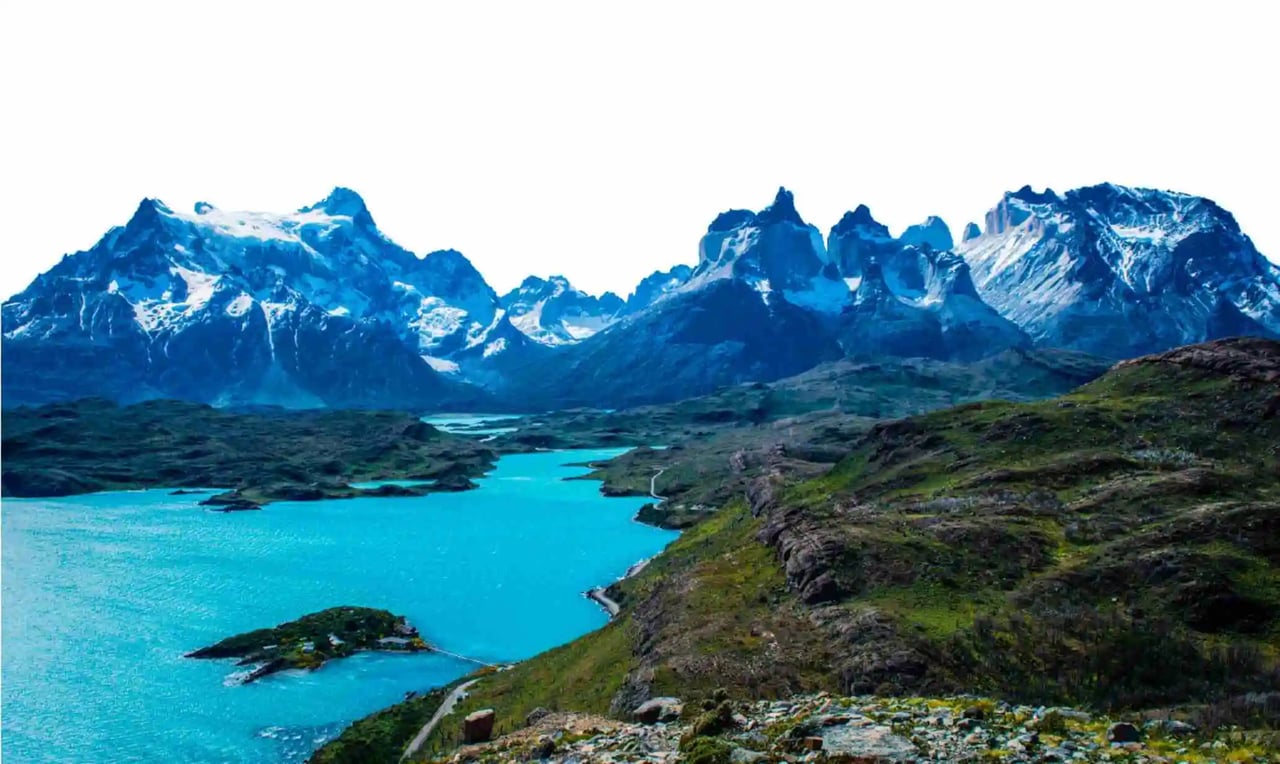
The Patagonia Way
Insider's guide: When to visit Patagonia

- Sustainability
- Photo Gallery
- Privacy Policy
- Work with us

The Best Patagonia Itinerary: 7 to 10 Days in Patagonia [Or More]
Patagonia is a fascinating place. With its wild weather, beautiful hiking trails, and picturesque glaciers, it’s an adventure playground.
I loved every minute of my trip to the region. But before I arrived, I had hundreds of questions (which you probably do too)!
“How many days in Patagonia?”
“Which is better: Chile or Argentina Patagonia”
“Can I visit Patagonia without a tour?”
Now that I’ve been there and spent over a month exploring the Chilean and Argentinian side, I’ve crafted this perfect 10 day itinerary for Patagonia.
It’s easily customizable to a 7 day itinerary but also includes other places to visit if you have 2 weeks in Patagonia.
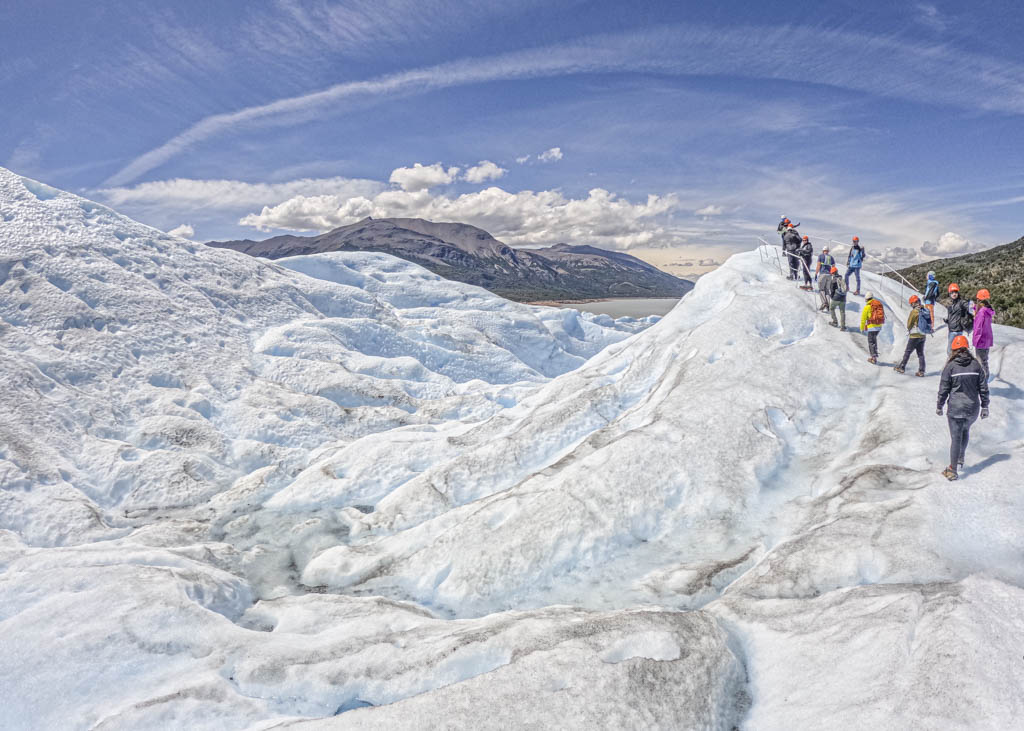
Torn Tackies contains affiliate links. If you make a purchase using one of these links, I may receive compensation at no extra cost to you. See my disclosure for more information.
Quick Navigation
10 Day Patagonia itinerary overview
- Day 1-3: El Chalten (2 nights)
- Day 4-5: El Calafate (2 nights)
- Day 6-10: Torres Del Paine (5 nights)
My Patagonia highlights
My overall favorite place in Patagonia: It’s an easy one! I loved the charming town of El Chalten in Argentinan Patagonia.
Most beautiful place: I still can’t get over how stunning Perito Moreno Glacier is! I did this Mini Trekking glacier tour from El Calafate, and it was one of my Patagonia highlights.
Best multi-day hike in Patagonia: The W Trek in Torres Del Paine, Chile. This hike allowed me to experience the real Patagonia. I had all four seasons in one day and saw landscapes I never knew existed.
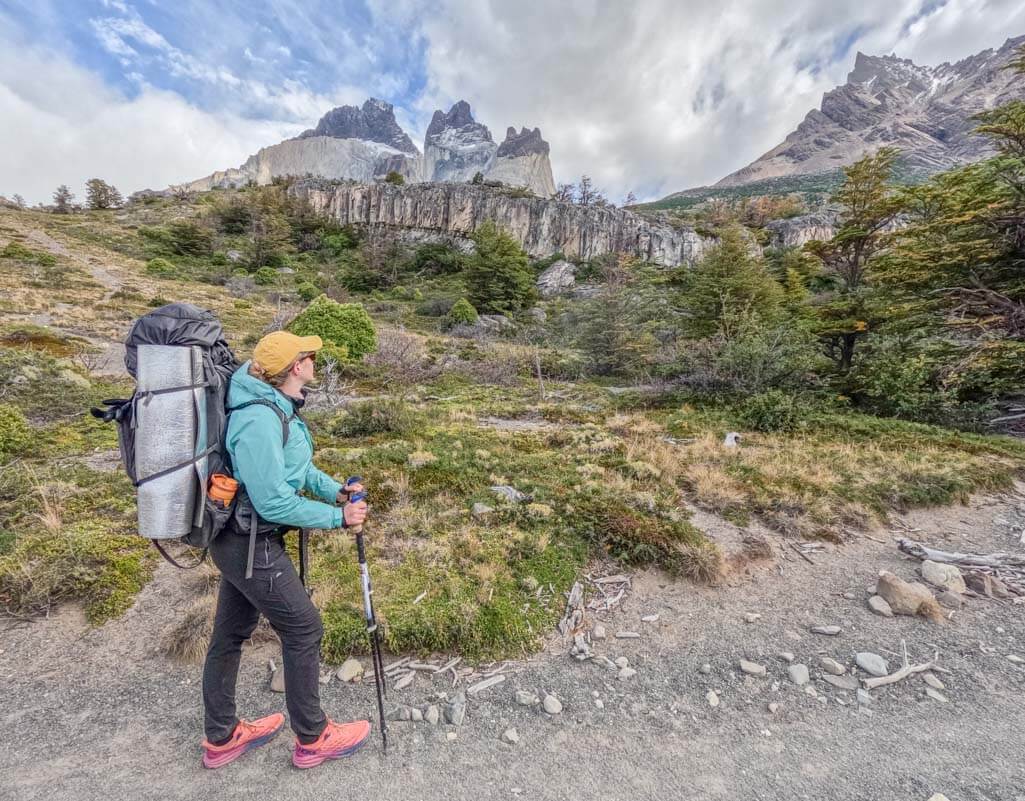
Day 1: Buenos Aires to El Chalten: Hike to Mirador Condores
Surrounded by snow-capped peaks, El Chalten is a small hiking town home to some of the best trails, which I’ve detailed in my El Chalten hiking guide.
It’s my favorite place in all of Patagonia. And if there’s one destination you cannot miss, it’s El Chalten.
If you’re coming from Buenos Aires, you’ll be traveling for most of the day. When you arrive in El Chalten, drop off your bags and put on your hiking shoes!
Mirador de los Condores is a quick and easy hike that’s perfect for day 1 of your Patagonia itinerary. It offers the best views of El Chalten and takes roughly 2 hours to complete.
Top tip: The sun sets after 9 pm in Patagonia during the summer, so you’ll have more than enough time for this hike, so long as you arrive before 6 pm.
How to get to El Chalten
There is no airport in El Chalten. The closest airport is in El Calafate, which services flights from Buenos Aires, Bariloche, and Mendoza in Argentina.
You’ll then need to take a 3.5-hour bus from El Calafate to El Chalten. I booked my bus through Bus Bud . You can check prices and availability here .
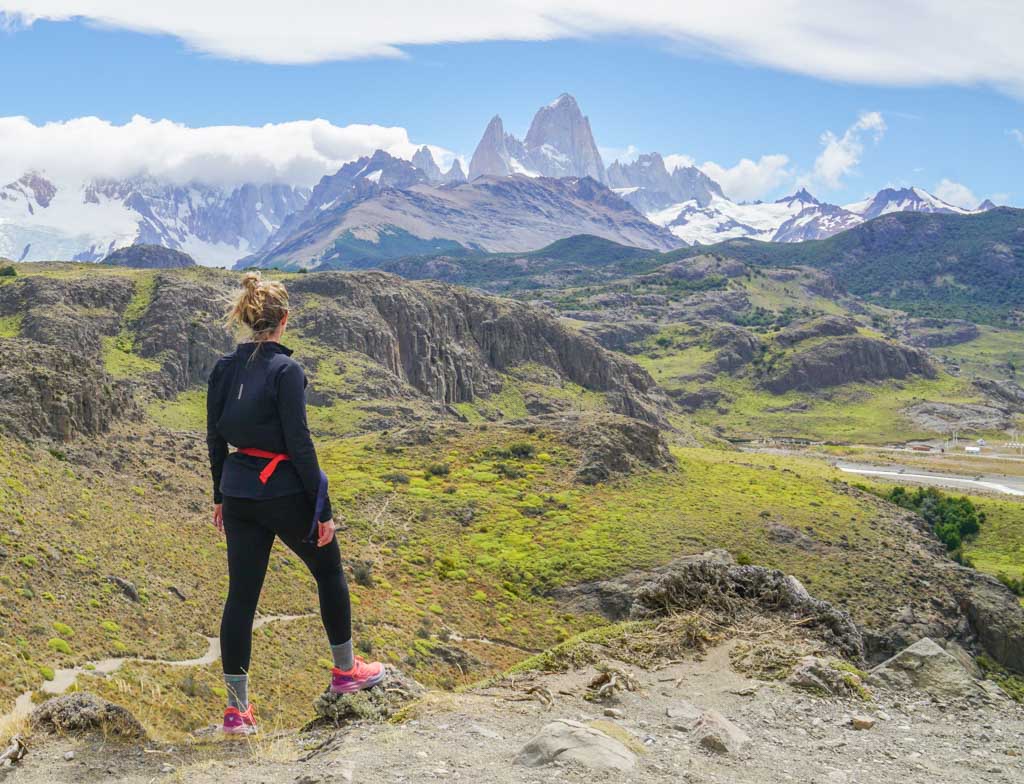
Where to stay in El Chalten
Patagonia is generally a lot more expensive than the other destinations in Argentina.
If you leave it too late, the more affordable options will be taken, and you’ll have to settle for something a bit further from town or out of your budget.
Apart Guillaumet is a basic accommodation option that ticks all the boxes, including an affordable price.
If you’re looking for something more luxurious, you can’t go wrong with Chalten Suites Hotel . There’s an onsite restaurant, and it’s just a stone’s throw away from the trails.
Day 2: Laguna de Los Tres hike (El Chalten)
Laguna De Los Tres is the crown jewel of El Chalten. It’s a turquoise blue lake at the base of the famous Fitz Roy mountain and offers picture-perfect views.
It’s a challenging 9-hour return hike to get from El Chalten to Laguna de los Tres. You’ll need to be prepared with food, water, and a lot of energy.
It was the hardest day hike I did in Patagonia (but so worth it).
You don’t need a guide for this hike or any others in El Chalten, as the routes are easy to follow and clearly marked. Read my guide on getting to Laguna de Los Tres for more details.
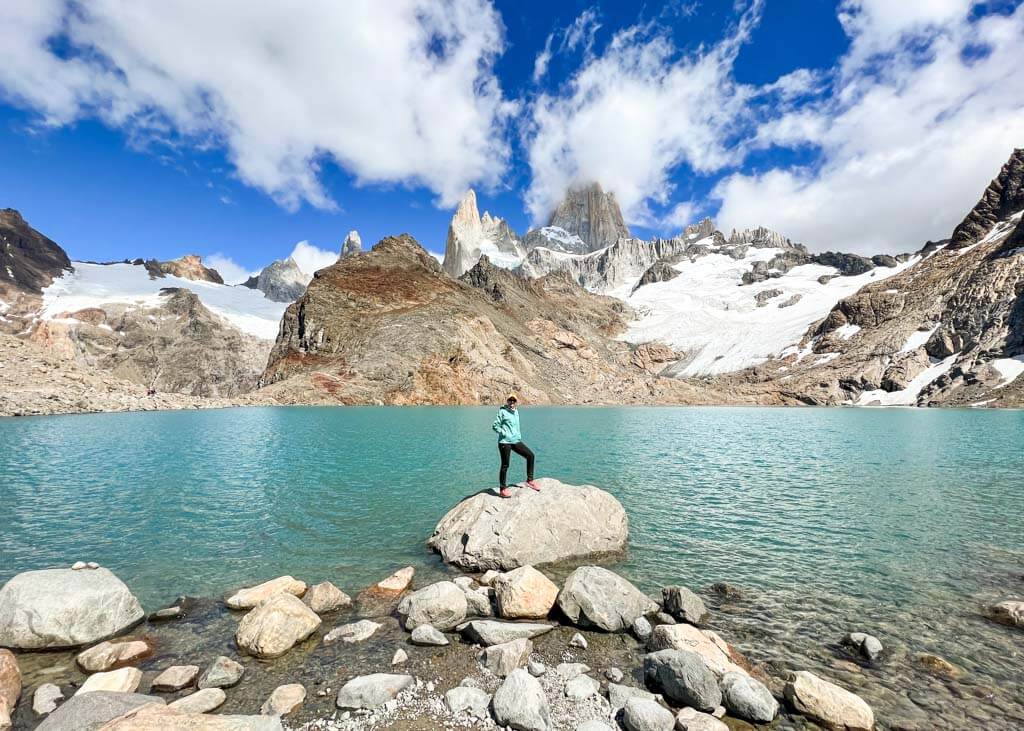
Day 3: Laguna Torre (El Chalten)
Laguna Torre is a vast glacier lake filled with small icebergs. The Cerro Torre Mountain range forms the backdrop and looks like something from a postcard.
The Laguna Torre hike is equally impressive as Laguna de los Tres. The difference? It’s a lot easier! It takes around 6 hours to complete, but most is a flat trail.
Try to start your hike before sunrise to beat the crowds. This will also ensure you’re back in El Chalten by lunchtime.
After the hike, hop on a bus back to El Calafate and spend the night here. It’s time to check out the most incredible glacier in the world!
Other things to do in El Chalten
If one hike in El Chalten is enough for you, or if you have more than 7 days in Patagonia, here are a few other amazing things to do around El Chalten.
White river rafting: I went river rafting in El Chalten and loved it. The rapids aren’t too intense, but they offer a nice break from all the hiking.
Rent a car and make a day trip to Lago del Desierto: Lago del Desierto is a beautiful lake surrounded by forests with picturesque mountain views. Check out Glacier Huemul on the way.
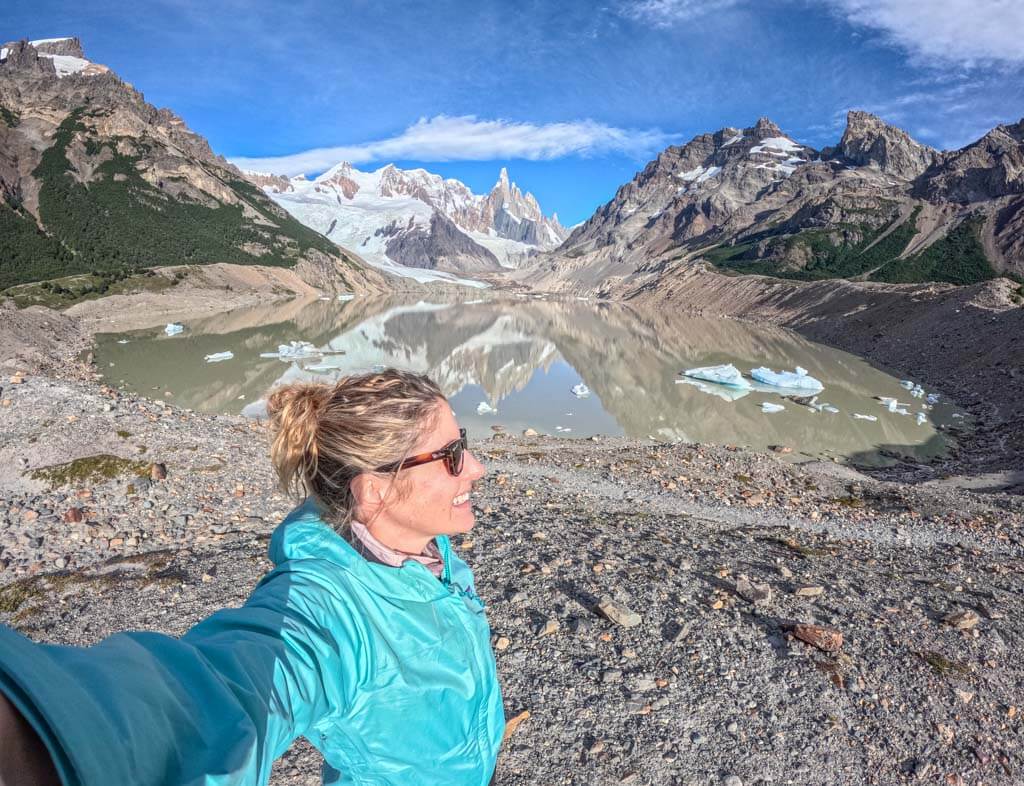
Day 4: Perito Moreno Glacier (El Calafate)
Today, you’ll wake up in El Calafate and make an exciting day trip to one of the most incredible sights I’ve ever seen, Perito Moreno Glacier.
It’s an iconic Patagonia attraction, and its beauty completely blew me away.
Perito Moreno Glacier is located in Los Glaciares National Park, about an hour’s drive west of El Calafate. There are a few ways to experience the glacier.
How to visit Perito Moreno Glacier
Perito Moreno walkways: If you’re on a budget, you can book a bus to the park and visit the walkways only. These comprise of 4 km of interconnected paths that offer panoramic views of the glacier.
Glacier trekking tour: I did this Minitrekking tour , which was well worth the money. Not only do you get to walk on the actual glacier, but it also includes a short boat trip. You’ll have some time to explore the walkways.
Ferry around Perito Moreno: The Minitrekking tour sells out fast, so a good backup option is this boat cruise , which allows you to get closer to the glacier.
Regardless of what tour you do, visiting Perito Moreno Glacier will be expensive! But it’s worth every cent.
Book your spot here , as there is limited availability.
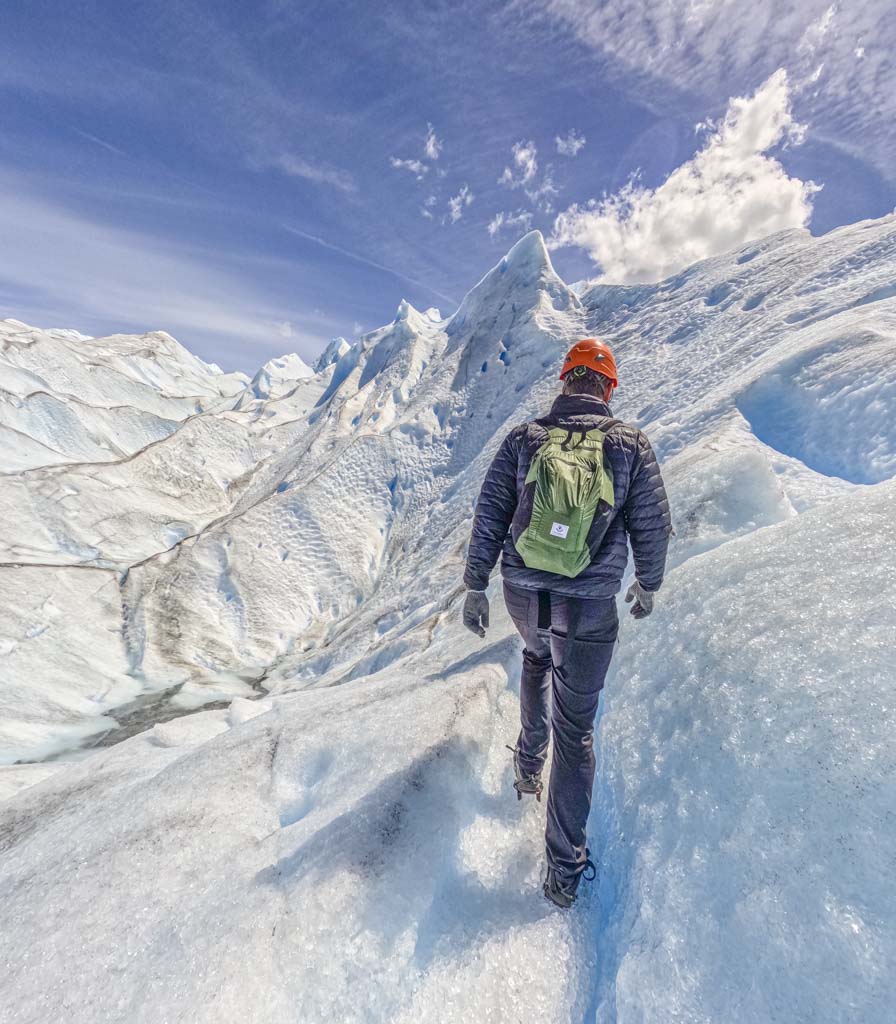
Where to stay in El Calafate
El Calafate is a bigger town than El Chalten, so your accommodation options are greater. It also means that some are closer to the main road than others.
I stayed at Folk Hostel , and it’s a great choice for backpackers. It’s close to the bus terminal, but you’re going to have to walk a bit further to get to the main town center.
Mirador del Lago Hotel has gorgeous large rooms with beautiful views. The breakfasts are exceptional, and it’s perfect for those looking for a more comfortable and luxurious stay.
Day 5 Patagonia itinerary: Puerto Natales
For the second half of your itinerary for Patagonia, there are a few places to visit.
I recommend crossing the border and checking out the Chilean side. You can then fly out of Santiago in Chile rather than crossing the border back into Argentina.
But depending on your time and interests, you may want to visit Bariloche or Ushuaia on the Argentinian side instead.
Where would I go? It’s an easy one! Torres Del Paine National Park in Chilean Patagonia. This park is home to the famous O and W Treks.
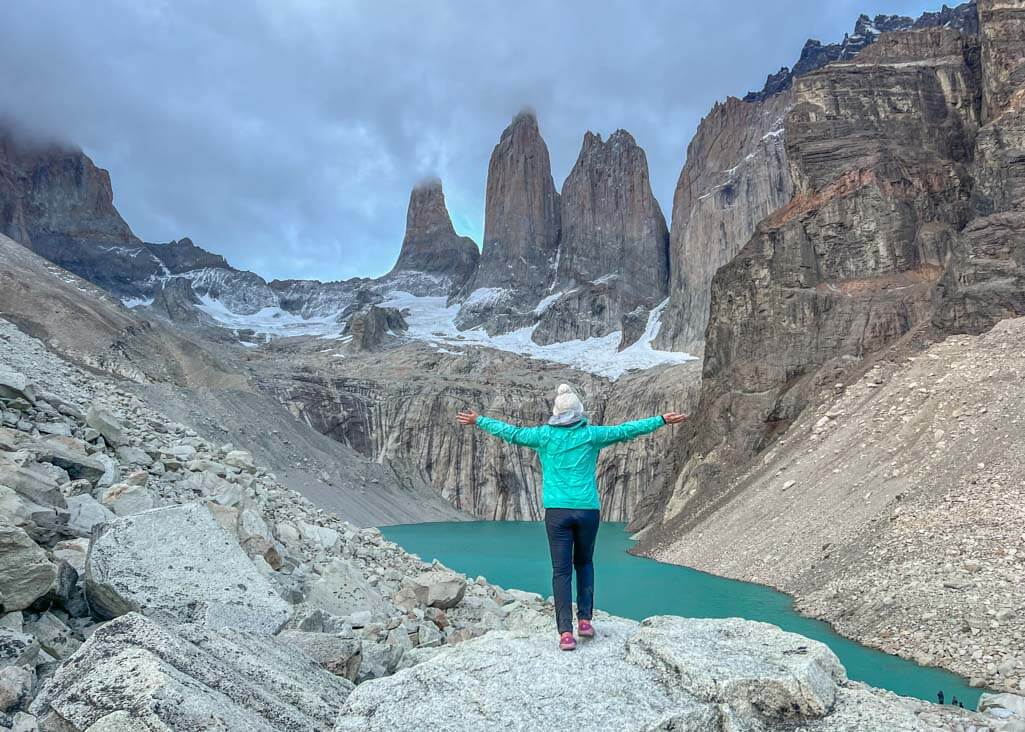
How to get from El Calafate (Argentina) to Puerto Natales (Chile)
Puerto Natales is the gateway to Chilean Patagonia.
Getting here involves an easy border crossing, which you’ll need to do via a bus from El Calafate in Argentina to Puerto Natales in Chile.
The bus drive takes 5 hours but allow for an extra hour at immigration. The buses are extremely comfortable, with large reclining seats. Check prices and availability here.
However, the town of Puerto Natales isn’t as charming as some other towns in Patagonia. So rather spend your first night in Puerto Natales and the rest in the national park.
Where to stay in Puerto Natales
I stayed at El Patagonico Hostel , a fantastic hostel in the heart of Puerto Natales. They offer private and dorm rooms and a big kitchen and lounge area. The price is hard to beat, and they’ll store your bags for free while you do the W Trek.
If you’re looking for a hotel with lake views, you can’t go wrong with The Singular Patagonia Hotel . The elegant rooms are some of the best you’ll find in Puerto Natales, and the staff are outstanding.
Day 6 – 10: W Trek (Torres Del Paine)
The W Trek is a 4-night/5-day trek through Torres Del Paine. It’s not as challenging as you think and can be done independently.
But the notorious Patagonia weather will affect your experience. During my W Trek (which you can read about here ), I experienced the most intense weather conditions.
Sunshine, rain, snow!
I was blown over numerous times while walking through French Valley and had to get down on my haunches to catch my breath. It rained heavily one day. The next, it was sunny and hot.
But despite not having perfect conditions and spectacular views throughout, braving this weather was one of my highlights. I got to experience Patagonia at its finest – the raw and harsh conditions were unlike anything I’d experienced before.
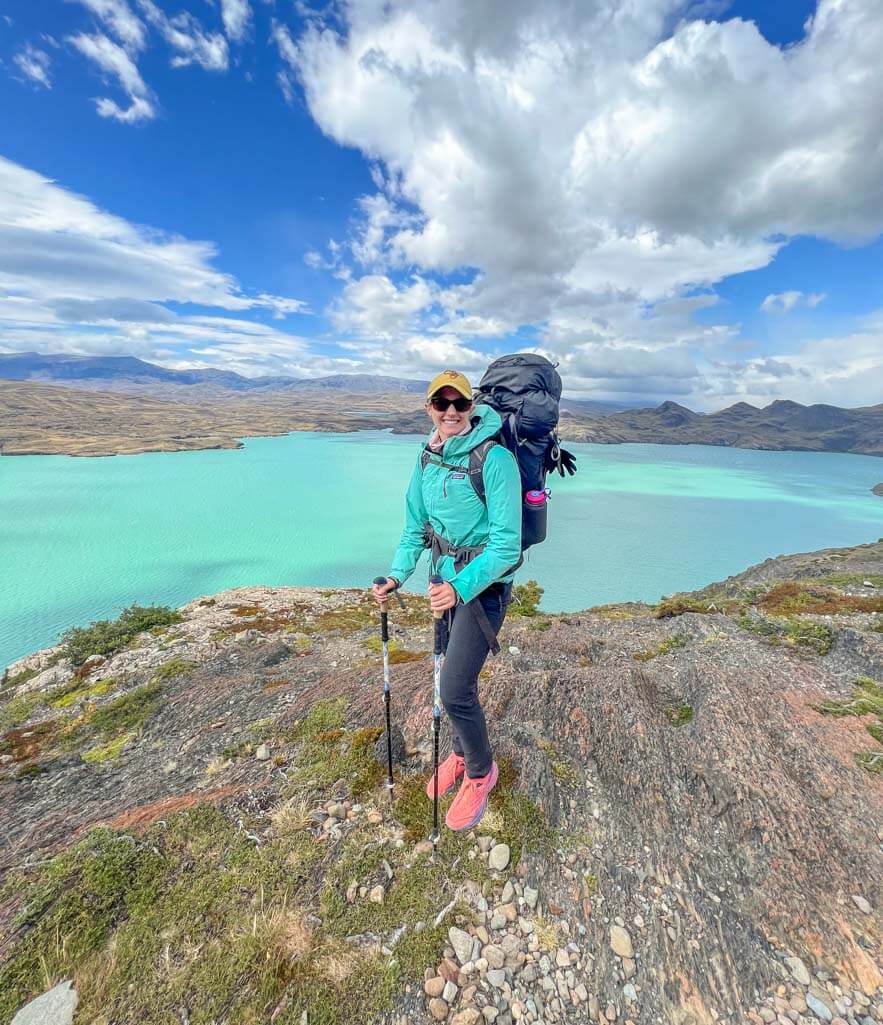
Accommodation on W Trek
If you’re doing the W Trek without a guide, you’ll need to organize your own accommodation. You can choose mountain huts or campsites, but the prices differ substantially.
Bookings open in July every year, and it’s a scramble to get a spot.
Two companies manage the accommodation along the W Trek: Vertice and Fantastico Sur (also known as Las Torres).
Booking your accommodation for the W Trek is a serious mission and highly time-consuming. But it’s the only downside of doing the W Trek independently.
Alternative option: Day trips to Torres Del Paine
Because of limited availability at campsites, your timing, or simply the fact that multi-day hikes are not everyone’s cup of tea, you can also visit Torres Del Paine on day trips from Puerto Natales.
If you’re choosing this option, it’s best to hire a car or take a day tour like this one .
Here are some day trip options:
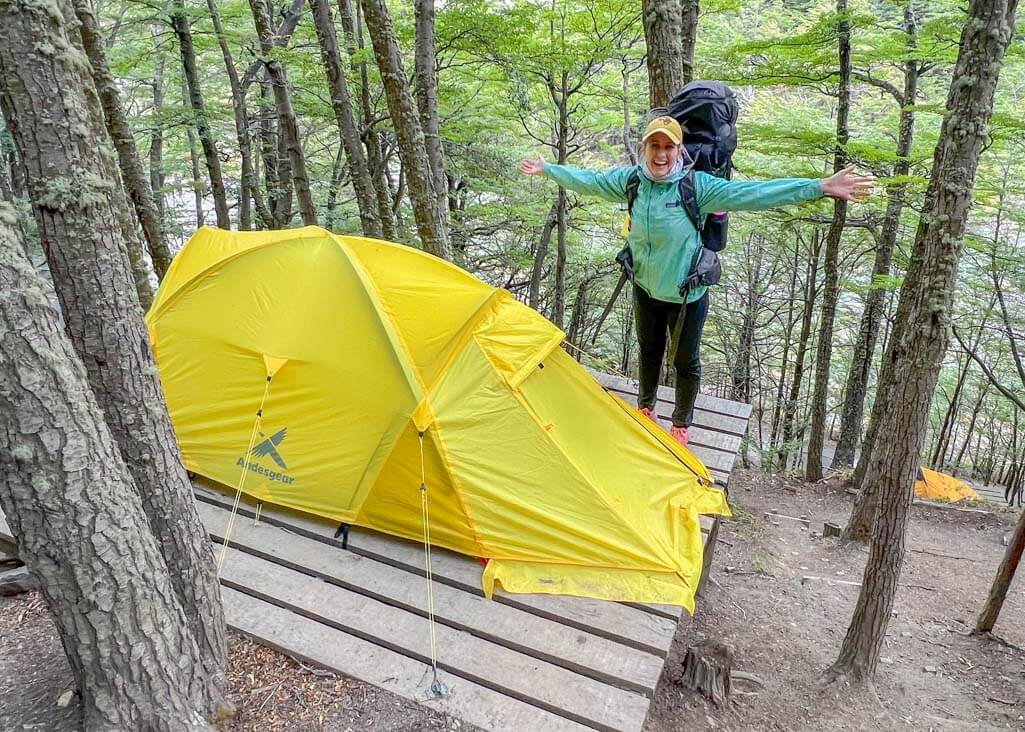
1. Mirador Las Torres (The Towers)
Mirador las Torres is an iconic site in Torres Del Paine. It’s the most popular section of the W Trek and gets busy with day trippers.
Getting to The Towers is a 9-hour return hike that starts challenging and does not get easier. The views are magnificent, though.
This is one of the best day tours from Puerto Natales to The Towers. Check price and availability here.
Top tip: If you’re following my Patagonia 10 day itinerary and struggled with the hike to Laguna de los Tres in El Chalten, skip Mirador Las Torres and opt for one of the below day hikes in Torres Del Paine instead.
2. French Valley
French Valley is the most picturesque day hike in Torres Del Paine National Park.
You’ll need to get on the first bus from Puerto Natales to the park and take the ferry to Refugio Paine Grande. From there, it’s a 2.5-hour hike to Refugio Italiano, which sits at the heart of French Valley.
3. Glacier Grey
Glacier Grey is the biggest glacier in Torres Del Paine and forms part of the western section of the W Trek.
You’ll need to catch the same catamaran as you would if you’re doing the French Valley day hike. But instead of following the trail that leads to French Valley on the right, you’ll go north to Refugio Grey.
Visiting Grey Glacier on a day trip is an ambitious yet achievable goal if you’re a fast hiker. It’s best to rather spend the night at Refugio Grey and head back to town the next day.
Top tip: If you’re planning a 7 day Patagonia itinerary and can only do 2 day hikes in Torres Del Paine, I suggest doing French Valley and Mirador Las Torres (The Towers).
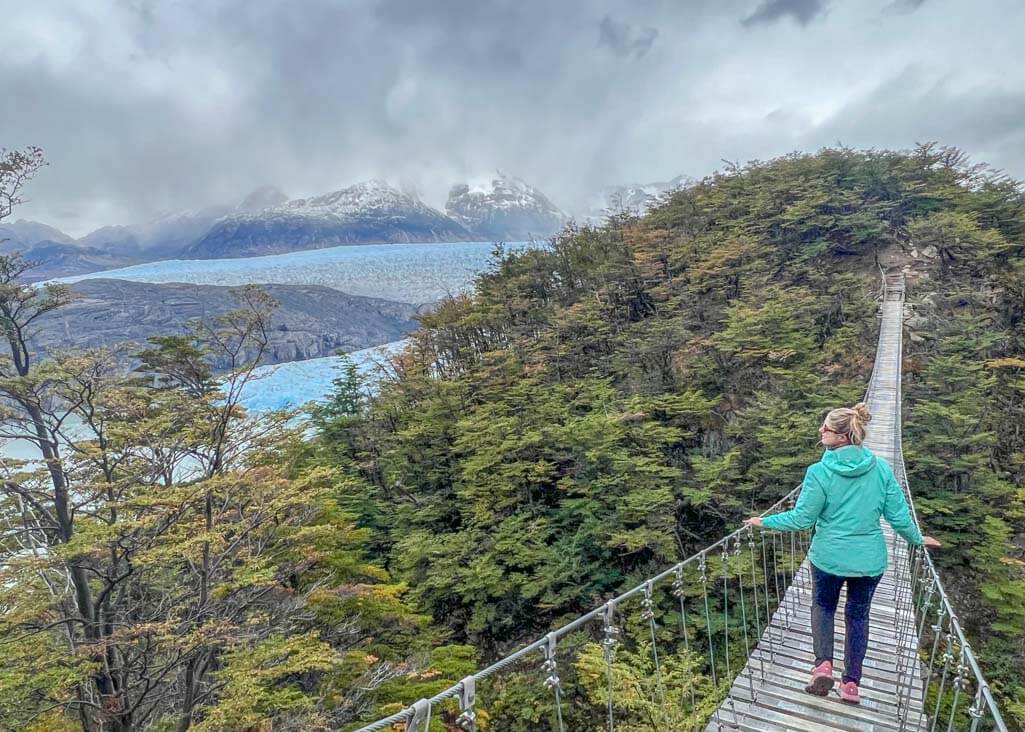
Other places to visit in Patagonia
Some travelers may want to avoid the border crossing from Argentina to Chile.
If this is the case for you, there’s the option to stay on the Argentinian side and explore more of Patagonia from there.
Bariloche is the lake district of Argentinian Patagonia. It’s strikingly different from all other places on this Patagonia trip itinerary.
Bariloche is ideal for travelers who want a break from hiking and prefer a mix of nature and comfort.
It’s best to spend 3 days in Bariloche and possibly even a night in San Martin de los Andes.
Day 1 in Bariloche
Try to arrive in Bariloche by lunchtime, so you have the afternoon to explore the town. The streets are lined with alpine-styled buildings, and the Centro Civico (the town square) is incredibly picturesque.
The Bariloche lakefront is a great place to hang out. It overlooks Nahuel Huapi Lake and is calming and serene.
A beautiful walking path leads from the Bariloche sign along the water’s edge. It passes a skate park and other sites, leading to an iconic Cathedral.
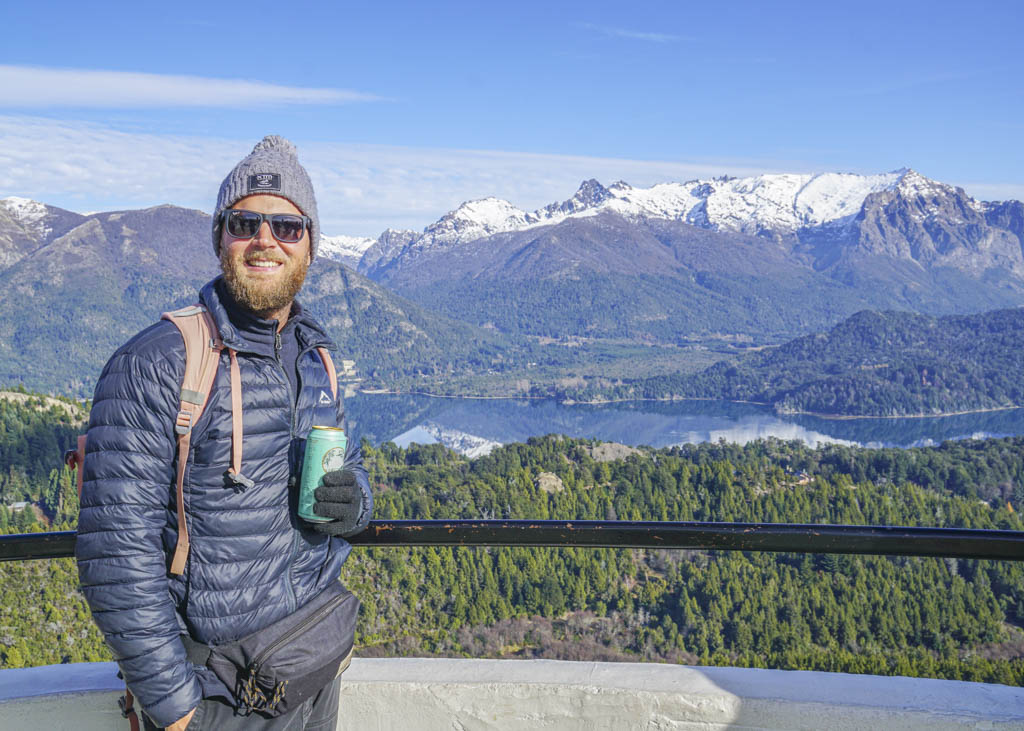
How to get to Bariloche
If you’re skipping the Chilean Patagonia side, or if you have more time in Patagonia and want to add Bariloche to your itinerary, you’ll need to get to Bariloche from El Calafate.
The easiest way is via a quick 2 hour flight between the towns.
Where to stay in Bariloche
Bariloche is a lot bigger than most Patagonia towns. There are many different areas to base yourself in. Unless you stay in the town center, you’ll need to use public buses or rent a car to get around.
I stayed at Trip Select Bariloche , just a short walk from the main road in Bariloche. The private rooms are simple yet comfortable and are great value for money.
Llao Llao Resort is one of the most luxurious places to stay in Bariloche. The location is everything, surrounded by mountain peaks with incredible views from every window. But you’ll need a car to get here.
Deciding where to stay can be overwhelming, so here’s my comprehensive guide to the best areas and accommodations in Bariloche.
Day 2 in Bariloche: Llao Llao National Park & Cerro Campanario
Llao llao national park.
An hour west of Bariloche lies Parque Municipal Llao Llao. It’s home to gorgeous hiking trails and spectacular views.
The most popular trail leads to Cerro Llao Llao, a panoramic viewpoint. You’ll walk up a steep zig-zag trail for 30 minutes to get here.
You can combine this with the Sendero de los Arrayanes trail. This loop track meanders through Parque Municipal Llao Llao, passing lush walkways and the picturesque Lake Moreno. It’s a flat trail and an excellent option for kids.
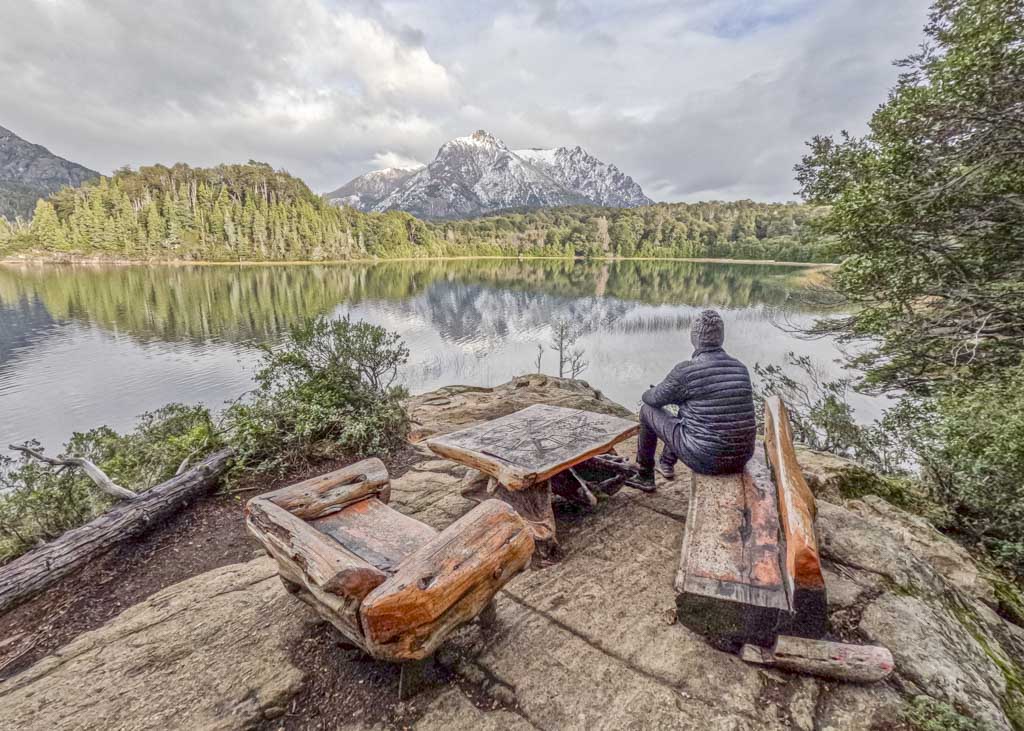
Cerro Campanario
After visiting Llao Llao National Park, make your way to Cerro Campanario. Here, you’ll find the most impressive viewpoint in Bariloche.
The best part? There’s no strenuous hike involved (unless you opt to walk instead of taking the chair lift to the top).
There are numerous viewpoints at the peak, and you’ll have 360-degree views overlooking the lake district. There’s also a small cafe and bar.
Day 8 in Bariloche: 7 Lakes drive or Refugio Frey hike
For the final day of your itinerary for Patagonia, you have two options. You can either explore the iconic 7 Lakes route or do the popular full-day hike to Refugio Frey.
7 Lakes Drive
The 7 Lakes route is one of the most scenic drives in all of Patagonia.
It starts in a lake-side town outside Bariloche called Villa la Angostura and goes north to San Martin de Los Andes.
Throughout the 7 Lakes Drive, you’ll pass seven stunning glacial lakes, dense forests, and picturesque mountain landscapes.
If you have the time, spend a night in San Martin de Los Andes. It will break up the long drive and is a quaint town to explore.
But if you only have a few days in Bariloche, you’ll need to squeeze this into one day, although two days are preferable.
This full-day tour from Bariloche stops at all the lakes. It’s an excellent option for solo travelers or those who would prefer not to rent a car.
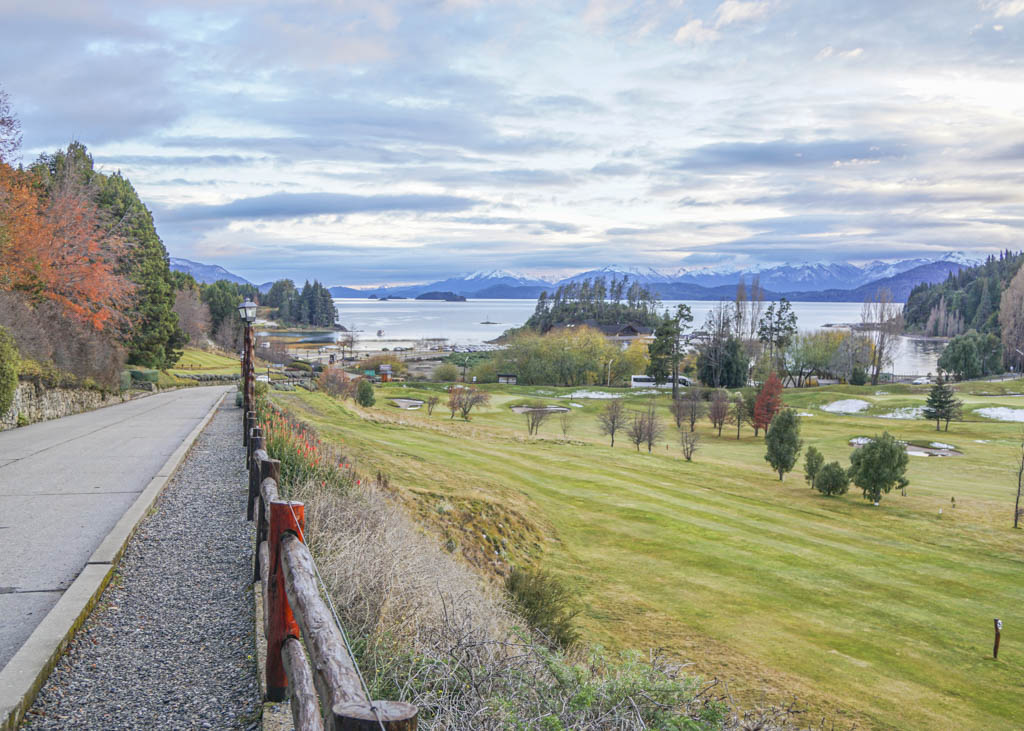
Hike to Refugio Frey
I highly recommend the Refugio Frey trek if you’d rather spend your day hiking around Bariloche as opposed to enjoying the views from a car.
It starts at Cerro Cathedral, which is Argentina’s largest ski resort. The trail ends at Refugio Frey, which sits in front of Laguna Toncek and is surrounded by craggy peaks.
The 22 km return hike takes 8 hours and is more challenging than the other hikes around Bariloche.
Best time to visit Patagonia
The best time to visit Patagonia is from October to April. The days are warmer and longer, providing ideal conditions for hiking and exploring.
Keep in mind that October and November will still be cold, and the glacier lakes may be iced up.
December through February are the best months to visit. But they’re also the busiest.
For less crowds and great weather, March is the ideal month to plan your Patagonia travel itinerary.
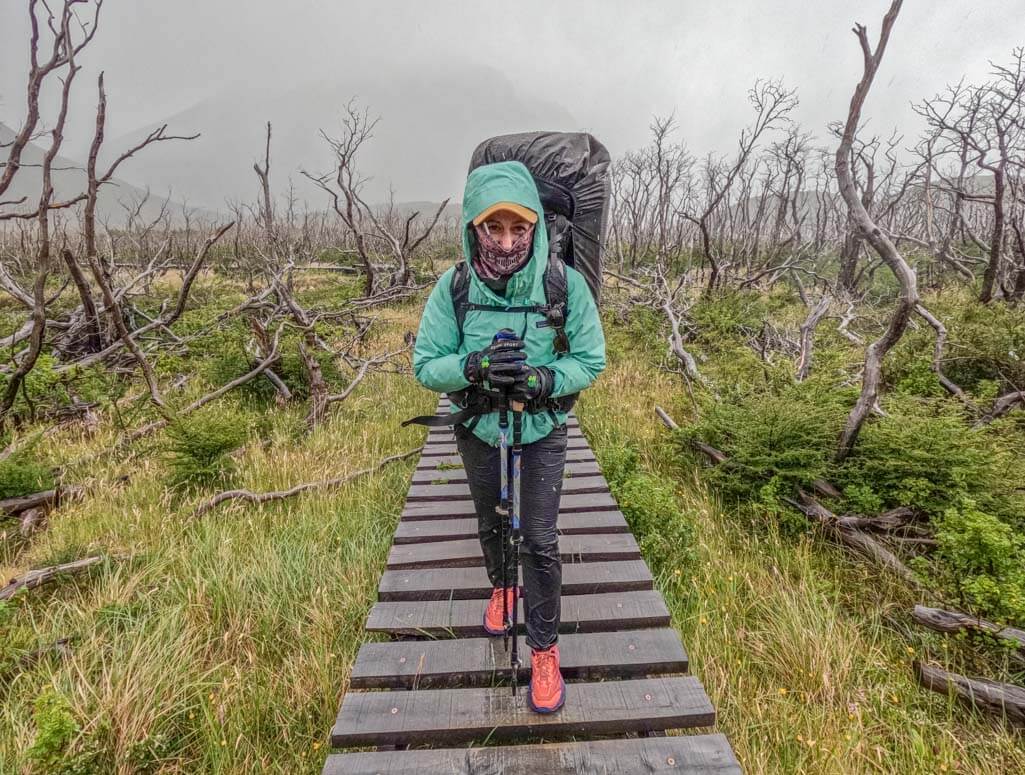
How many days should I spend in Patagonia?
You’ll need at least 7 days in Patagonia. But if you want to travel slower and visit all the attractions, you’ll need 2 weeks.
Which is better: Chilean or Argentina Patagonia
I loved Argentinian Patagonia! It’s home to my favorite places in Patagonia and has incredible hiking trails. It’s also a lot cheaper than the Chilean side.
Which is the best month to visit Patagonia?
If I could choose any month, it would be March. This is the end of high season, so the crowds are fewer. But the weather is still optimal, and you can expect long, sunny days.
Where do you fly into for Patagonia?
You can either fly into Buenos Aires in Argentina or Santiago in Chile. To get to the Patagonia region from there, you must fly to El Calafate or Bariloche in Argentina. Or Puerto Natales in Chile.
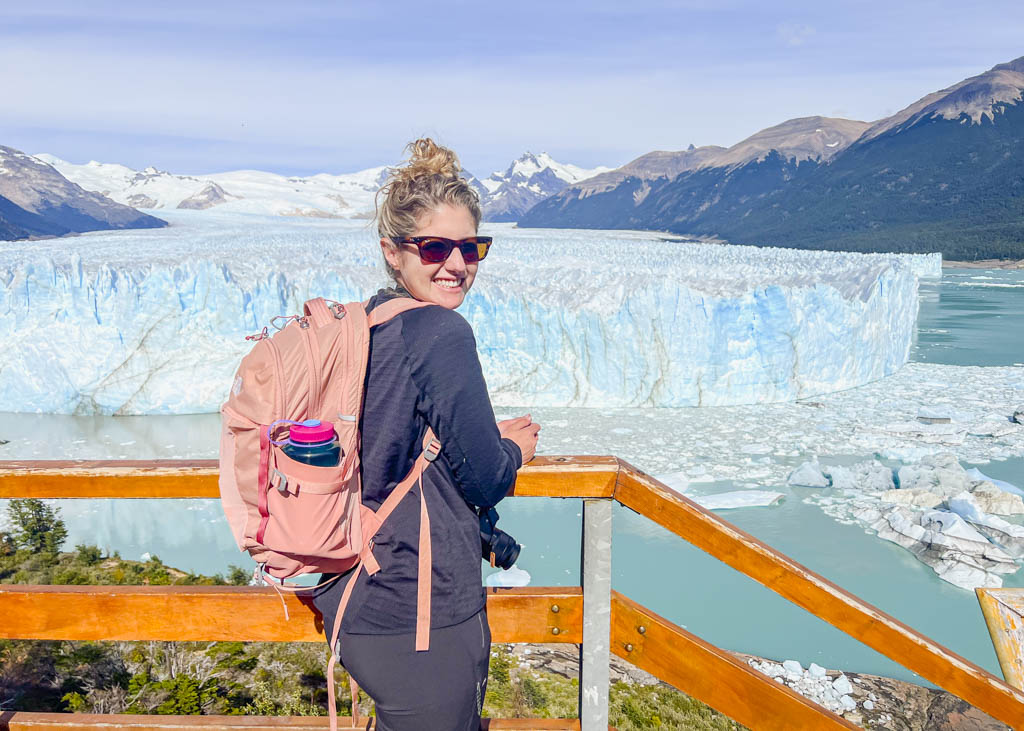
Final thoughts on my itinerary for Patagonia
I spent 7 months backpacking South America, and some of my best memories are from Patagonia.
But remember one thing about the region.
You can do all the planning and preparation for your trip, but unfortunately, you can’t prepare for the weather. It can be unforgiving, even during the summer months, which are said to be the best times to visit.
But no matter what Patagonia brings, embrace it. Enjoy the stunning scenery and take in the power of Mother Nature.
Like it? Pin it!
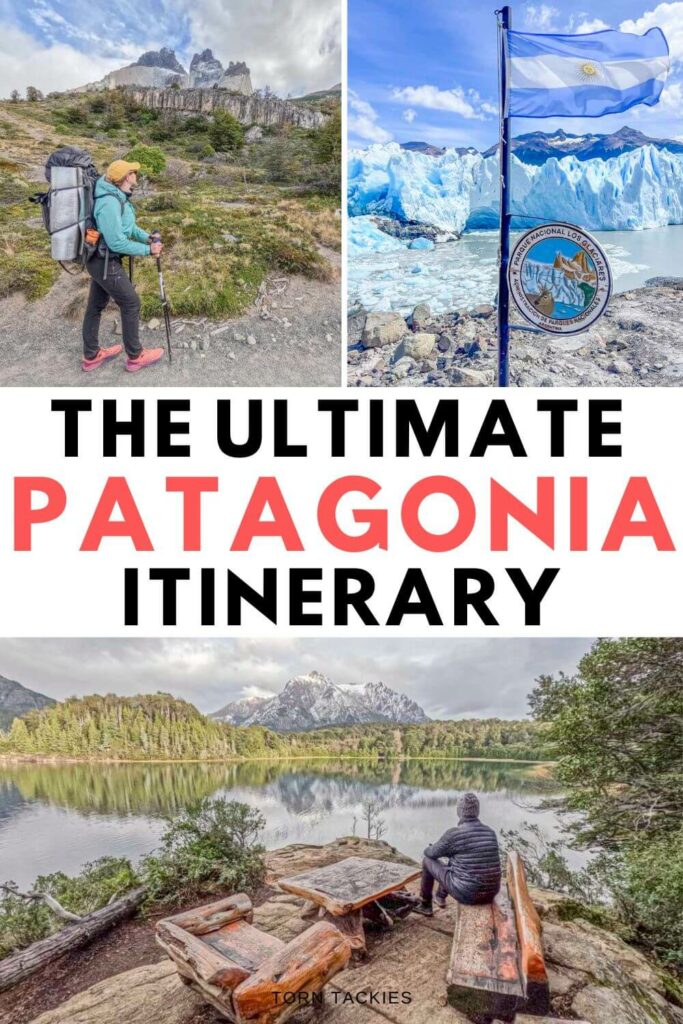
Planning your Patagonia itinerary and have any questions? Drop me a message in the comments section below.
Looking for more Patagonia travel inspiration? Check out my other posts!
- Hiking Mirador De Los Condores in El Chalten
- The Ultimate W Trek Packing List
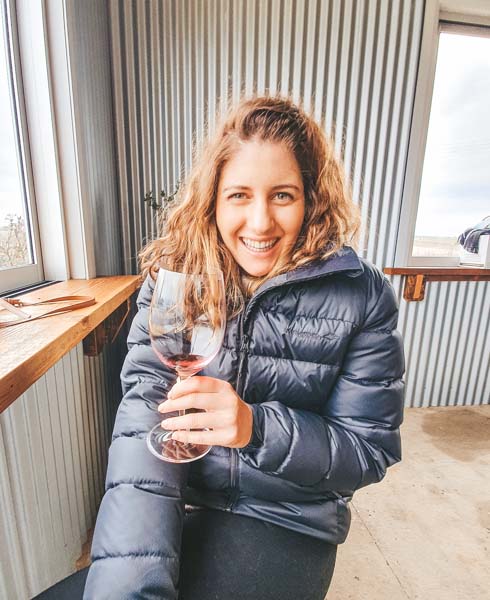
Hi, I'm Carryn. I’m an adventure travel blogger trying to figure out my way through life by traveling and exploring. Join me as I share my travel guides and tips for life abroad. Find out more about me here .
Where to stay in Cusco (before Inca trail): Best hotels and areas
The best argentina itinerary: how to spend 2 weeks in argentina, leave a comment cancel reply.

The Ultimate Guide to Patagonia Hiking: 2024 Edition
Set out for an epic adventure in Patagonia Hiking. Our 2024 guide gives expert advice on gear, preparations, top trails, and must-see sights!
Patagonia, a region located at the southern end of South America, offers some of the most breathtaking landscapes and challenging trails for hiking enthusiasts. With its rugged mountain ranges, vast glaciers, and picturesque lakes, it provides a dramatic backdrop for an unforgettable outdoor adventure. Whether you’re an experienced hiker looking for a new challenge or someone who wants to immerse yourself in the beauty of nature, Patagonia has a variety of trekking routes to satisfy every level of outdoor enthusiast.
Your journey through Patagonia’s trails will not only test your physical strength but will also reward you with encounters with diverse wildlife, insights into unique local cultures, and views of remote, unspoiled wilderness. Before you set out, it’s important to prepare and plan thoroughly, taking into account the remote nature of the area, the variable climate, and the necessary gear . With the right preparation, your Patagonia hiking trip has the potential to be a life-changing experience, leaving you with lasting memories and stories to share.
Key Takeaways
- Patagonia is a top destination for diverse hiking experiences, offering trails for all skill levels.
- Preparation is crucial, considering Patagonia’s remote terrain and variable weather.
- A successful trip includes encounters with unique wildlife, cultural insights, and stunning natural beauty.
Planning Your Patagonia Hiking Trip
Embarking on a hiking adventure in Patagonia requires careful planning. It’s important for you to choose the best time for your trip, determine a personalized itinerary, and understand the regulations of the parks you intend to visit.
Choosing the Right Season
Best Time to Go Hiking in Patagonia: The optimal season for your hike largely depends on the weather conditions and crowd preference. Peak Season for hiking in Patagonia spans from November to early March , when the weather is most favorable. However, be prepared for more companions on the trail as this is also the busiest period.
Determining Your Itinerary
Plan Your Routes: Carefully consider which places you want to explore. For a truly unique experience, mix well-known trails with some off-the-beaten-path routes. Start with accessible areas and gradually venture out to more challenging hikes based on your experience and fitness level. Always keep in mind the distance and terrain difficulty when planning.
Understanding Park Regulations
Park Permit and Regulations: Specific areas in Patagonia may require you to obtain a permit before hiking. Regulations can include designated camping sites, limited numbers of hikers per day, and mandatory guides for certain trails. Adhering to park rules ensures your safety and preserves the pristine environment for future adventurers.
Hiking Essentials and Gear
When setting out for a Patagonia hike, choosing the right clothing and gear is critical to ensure comfort and safety. Packing a functional backpack with essential items will enhance your hiking experience.
Selecting Suitable Clothing
Your choice of clothing for a Patagonia hike should prioritize functionality and adaptability to varying weather conditions. Start with a moisture-wicking base layer to keep dry and add an insulating fleece or a lightweight down jacket for warmth. Outer layers should be windproof and waterproof to protect against the elements. Opt for quality brands that are known for their durability and performance in outdoor environments.
- Base Layer: Moisture-wicking material
- Insulation: Fleece or lightweight down jacket
- Outer Layer: Windproof and waterproof garments
Top Hiking Gear to Carry
The right hiking gear can make a significant difference in your Patagonia adventure. A sturdy pair of hiking boots is essential for traction and support. Additionally, consider packing a reliable sleeping bag if you plan to camp, and a multitool for various tasks on the trail.
- Footwear: Durable hiking boots
- Multitool: For cutting, repairs, and more
- Sleeping Bag: Rated for the expected temperatures
Packing a Functional Backpack
Your backpack is your portable basecamp; it should contain everything you need without being overpacked. Ensure it has enough capacity and pockets to organize your gear. Essential items include a map, compass, water, snacks, first aid kit, and a headlamp. Balance the load in your backpack for comfort and pack heavier items closer to your back.
- Navigation: Map and compass
- Hydration: Water bottle or hydration system
- Nutrition: High-energy snacks
- Safety: First aid kit and headlamp
- Organization: Balance load and use pockets effectively
Remember to tailor your gear to the specifics of your hiking trip, considering the length of your journey, weather forecast, and personal needs. Happy hiking!
Weather Patterns and Climate
Exploring Patagonia means preparing for its unpredictable weather patterns. The region’s climate can shift rapidly due to its geographic placement, and knowing what to expect will keep you safe and comfortable on your hikes.
Understanding the Wind
Patagonia is famous for its strong and incessant winds , especially during the summer months. The wind can be relentless and sudden, testing even the most experienced hiker’s preparedness and resilience. When you’re planning a trek , always check local wind conditions and consider starting early in the day when the wind is often calmer.
- Checking Wind Forecasts : Regularly consult with local weather stations for up-to-date wind conditions.
- Sheltered Routes : Select hiking paths that offer natural windbreaks such as valleys or forested areas.
- Secure your Gear : Ensure all gear is tightly secured to prevent loss or damage.
Preparing for Rain and Snow
Your hiking experience can be affected by the frequency of rain and snowfall in Patagonia. Winters bring snow, particularly from June through August, while rain can be a year-round occurrence. Adequate preparation for these weather conditions is essential for a safe hiking experience.
- Waterproof Clothing : Invest in high-quality waterproof clothing to stay dry and comfortable.
- Layering : Utilize a layering system to adapt to changing temperatures and conditions.
- Know Your Route : Be aware that snow can obscure trails. Stay on marked paths and be prepared to turn back if conditions worsen.
By understanding and preparing for Patagonia’s winds, rain, and snow, you’ll ensure a memorable and secure hiking adventure.
Trail Profiles and Trekking Routes
In Patagonia, your hiking adventure will be defined by the trails you choose, each with its distinct beauty and challenges. From the renowned towers of Torres del Paine to lesser-known, equally breathtaking circuits, you’re set for an unforgettable trekking experience.
Famous Treks: W Trek and O Circuit
W Trek : The iconic W Trek is your ticket to some of the best sights in Torres del Paine National Park . Covering approximately 70 kilometers, this trek can be completed in about 4 to 6 days. You’ll witness the park’s most famous landmarks like the Base Torres lookout, French Valley, and Grey Glacier. Each night, rest at designated campsites or refugios dotted along the path.
O Circuit : For a more extensive experience, the O Circuit encompasses the W Trek and adds a northern section, giving you a full loop of the park. This trek is roughly 110 kilometers and typically takes 7 to 10 days to complete. The backside of the circuit is less crowded, allowing for intimate encounters with Patagonia’s wild side.
Hidden Gems: Huemul Circuit and Others
Huemul Circuit : If you’re seeking a trail less traversed, embark on the Huemul Circuit. This challenging route spans about 70 kilometers, taking you through remote parts of the southern Patagonian Ice Field. Over 4 to 5 days, your journey will involve glacier navigation, steep ascents, and potentially using a harness and rope for river crossings.
Additionally, you’ll find plenty of other hidden gems in Patagonia offering serene landscapes away from the main trekking routes. Trails like the Dientes de Navarino or the Loma del Pliegue Tumbado provide unique views and solitary treks. While they may lack the fame of the best hikes and treks in typical guidebooks, their untouched beauty makes them a true hiker’s delight.
Notable Destinations
Exploring Patagonia offers a symphony of natural wonders, including majestic mountains and breathtaking panoramas. The trails leading through this vast wilderness cater to your thirst for adventure and visual splendor.
Torres Del Paine National Park
Torres Del Paine National Park in Chile is a magnet for hikers worldwide, with its iconic horn-shaped peaks of the Paine Massif. Embarking on treks like the W Circuit, you’ll encounter the park’s gem, the Base of the Towers, famed for its dramatic granite monoliths and emerald waters.
Los Glaciares National Park
Adjacent to Chile in Argentina, Los Glaciares National Park encompasses a portion of the Andes range. The park invites you to witness colossal ice formations, serene forests, and alpine meadows. And, no Patagonia trek is complete without a Perito Moreno Glacier Hike organized by tour planners who are experts in glacial hiking.
El Chaltén and Fitz Roy
Considered Argentina’s trekking capital, El Chaltén serves as the gateway to trails leading to Mount Fitz Roy and Cerro Torre . The trek to Laguna de los Tres rewards you with unparalleled views of Fitz Roy’s daunting spires, while Cerro Torre beckons climbers with its sheer ice-clad face and challenging ascents.
Wildlife and Natural Attractions
Patagonia is a land of ethereal beauty, with its vast expanses offering you an array of natural wonders and wildlife spectacles. From the majestic pumas to the awe-inspiring glaciers, prepare to be enchanted by the raw beauty of this pristine wilderness.
Encountering Patagonian Fauna
As you trek across the rugged terrain, keep your eyes peeled for the emblematic guanacos , relatives of the llama and a common sight in the Patagonian steppes. Their elegant stature and curious gaze make a serene moment on your hike. The skies above often host the impressive Andean condors , soaring with a wingspan that can reach up to an impressive three meters. The opportunity to witness these grand birds in flight is a memory that will last a lifetime. If fortune favors you, a glimpse of the elusive puma could be the highlight of your journey. These magnificent predators are the apex of Patagonian wildlife, embodying the untamed spirit of the region.
Exploring Glaciers and Ice Fields
Patagonia’s glaciers are colossal rivers of ice, etching their way through the Andes and sculpting the landscape as they go. Among the icy expanses, the Patagonian Ice Field stands out as one of the largest expanses of ice outside the polar regions. A trek here means tracing the edges of ancient ice, where the air is crisp and the views, of blue-tinged ice against the stark mountain slopes, are unforgettable. Remember, while the glaciers are a hiker’s paradise, they are also delicate environments that require our respect and care to preserve their timeless beauty.
Safety and Difficulty Levels
When planning your hike in Patagonia, understanding the trail difficulty and ensuring proper emergency preparedness are paramount to both your safety and enjoyment. Different trails pose varied challenges, from gentle paths to demanding climbs, and unforeseen circumstances can arise, requiring self-sufficiency and readiness.
Assessing Trail Difficulty
Before setting out, assess the trail difficulty to match your skill level. Difficulty can range from easy walks, like those found on some well-maintained paths near popular tourist sites, to highly technical climbs necessitated by the rugged Patagonian terrain. Consider the following factors:
- Trail length: Longer trails require more stamina and provisions.
- Elevation gain: Steep sections may be challenging for inexperienced hikers.
- Terrain type: Unstable ground such as scree or snow increases difficulty.
- River crossings: Be prepared for potential fords, which can be hazardous due to strong currents or sudden changes in the water level.
For practicality, classify trail difficulty using a simple system:
- Easy: Flat terrain, no experience required.
- Moderate: Some elevation gain, basic hiking skills advised.
- Difficult: Steep climbs, technical skills recommended.
Check online resources like the detailed accounts found in Enduring Patagonia to gauge what to expect.
Emergency Preparedness
Your safety on the trail is crucial and requires preparation for emergencies. The unpredictable Patagonian weather and isolated stretches necessitate taking appropriate measures:
Essential safety items to pack:
- Navigation tools: Map, compass, and GPS device.
- Protection: Sunscreen, hat, and layers to accommodate rapid weather changes.
- Rations: Enough food and water, plus purification methods for longer hikes.
- Emergency gear: First aid kit, multi-tool, emergency shelter, and a whistle.
Keep in mind that you must be self-reliant; rescue services may not be readily available in remote areas. Prepare by learning essential skills, equipment, and safety techniques beforehand. Inform someone of your itinerary and expected return, and always pack a charged cellphone or a satellite communicator for critical situations.
Accommodation and Campsites
When planning your Patagonia adventure, you’ll need to decide where you’ll rest each night. Your choices can range from pitching a tent at campsites or staying in more structured accommodations known as “refugios”.
Choosing Between Camping and Refugios
Camping: If you’re looking to immerse yourself in the Patagonian wilderness, camping is an excellent choice. You’ll carry your own tent and set it up at designated campsites. The sense of adventure is unparalleled, and you’re likely to have a more intimate experience with nature. However, this means you’ll be responsible for your own gear and comfort.
Refugios: On the other end, refugios provide a more comfortable but rustic shelter, akin to mountain huts. For instance, Refugio Grey is a sought-after destination for its stunning views and amenities. Here, you can appreciate the outdoors during the day and return to a warm bed at night.
Booking and Costs
Booking: It’s crucial to book your campsites or refugio stays well in advance, especially during peak season. The accommodation options in Patagonia, particularly in popular areas, can fill up quickly. Ensure you secure your spot early to avoid any changes to your hiking itinerary.
Costs: Expect to pay for the convenience of refugios, as the prices are typically higher than campsites. Campsites offer a budget-friendly alternative, but costs can vary depending on location and the level of facilities provided. Camping generally requires a fee for pitching your tent, while refugio prices reflect the added comfort and services. Always check the latest fees and consider that these are subject to change.
Luxury Tour Operators
There is another option for those who are looking for a premium way to experience Patagonia. Top tour operators specialize in crafting luxurious Chilean adventure tours that encompass an array of exhilarating experiences. From luxury accommodations to fully planned itineraries and tour packages, these companies provide a valuable service for travelers who appreciate a more concierge-level approach to travel.
Cultural Insights and Local Life
Exploring Patagonia through hiking offers more than breathtaking landscapes; it’s an immersion into the rich tapestry of cultures that inhabit Southern Chile and Argentina. As you lace up your boots and set out on the trails, you’ll encounter the vibrant communities and the enduring spirit that define this rugged region.
The People of Patagonia
The soul of Patagonia is etched deeply into the faces of its people; a blend of indigenous communities like the Mapuche , descendants of European settlers, and hardy locals who have adapted to the windswept plains and peaks of this remote area. In towns like Punta Arenas or Ushuaia , the world’s southernmost city, you’ll likely meet these warm, resilient individuals. You might share a mate , a traditional caffeine-rich infused drink, and hear stories that are as captivating as the landscape itself. Whether you’re navigating the trails near Tierra del Fuego or setting up camp at Campamento Poincenot, each encounter adds a personal touch to your adventure.
- Mapuche Community : Traditionally from the northern Patagonian region, known for their rich cultural heritage and deep connection with the land.
- Settlers’ Descendants : Families from Europe who arrived in the 19th and 20th centuries, bringing their own customs that have since blended with local traditions.
- Local Patagonians : People born and raised here, often sharing a love for the untamed wilderness of Patagonia and a spirit of self-sufficiency.
The Spirit of Southern Chile and Argentina
Patagonia is split between Chile and Argentina , each side offering its own unique cultural experiences connected by the majestic backdrop of the Andes Mountains. In Chile, the region’s spirit is felt through vibrant cultural practices and a deep respect for the stunning environment. Across the border in Argentina, the gaucho culture adds to the mystique of Patagonia, where the lone horseman riding across the steppe symbolizes freedom and strength. As you traverse this land, from the mountains of Tierra del Fuego to the bustling streets of Ushuaia , the spirit of the south is evident in everything from the food you’ll taste to the music you’ll hear softly echoing through the valleys.
- Chilean Patagonia : Known for its intricate fjords, temperate rainforests, and the iconic Torres Del Paine National Park.
- Argentine Patagonia : Home to vast steppes, deserts, and the distinctive Patagonian ice fields.
Logistics and Travel Tips
When preparing for an exhilarating hiking adventure in Patagonia, it’s crucial to consider transportation options to access various trails and to understand the visa and entry requirements that may apply to you.
Transportation and Routes
To start your journey in Patagonia, you’ll likely fly into El Calafate , which serves as a gateway to the region’s renowned national parks and trekking routes. The town offers bus services to key hiking destinations such as the iconic Torres del Paine National Park or the more secluded Caleta Gonzalo in Chile. To optimize your travel:
- Plan ahead: Book airport shuttles or bus tickets in advance, especially during peak trekking seasons.
- Local transit: Renting a car can give you flexibility, but be prepared for potentially rough Patagonian roads.
For backpacking routes:
- Torres del Paine: Find guided tours or embark on the famous W Trek or the longer O Circuit, ensuring you have the necessary permits.
- Caleta Gonzalo: This is a less-traveled path but offers stunning vistas; arrive via the Carretera Austral or boat from Chaitén.
Visa and Entry Requirements
Before you travel, make sure you understand the visa requirements for entering Chile or Argentina, depending on your itinerary in Patagonia.
- Check your status: Determine whether you need a visa based on your nationality. Many travelers can enter visa-free for short periods.
- Travel documents: Ensure your passport is valid for at least six months from your planned date of entry.
Keep these logistics and travel tips in mind as you plan for an unforgettable hiking experience in Patagonia. With proper planning and an understanding of the travel requirements, you’ll be set to enjoy the breathtaking scenery and challenging trails that await.
Frequently Asked Questions
When planning your next adventure in Patagonia, certain details can make all the difference. Here are the answers to some frequently asked questions to ensure you’re well-prepared for your hiking journey.
What are some recommended day hikes to experience in Patagonia?
Patagonia offers a variety of day hikes, from the picturesque Laguna de los Tres near El Chaltén, offering stunning views of Mount Fitz Roy, to the Mirador Las Torres trail in Torres del Paine National Park.
What type of clothing is best for hiking in Patagonia?
For hiking in Patagonia, layering is key. Choose moisture-wicking fabrics for your base layer, an insulating fleece or down jacket for warmth, and a waterproof, wind-resistant outer shell.
Could you suggest some resources to find reliable hiking maps of Patagonia?
Reliable hiking maps of Patagonia can be found at local outdoor shops, national park visitor centers, or through online retailers specializing in topographic maps.
Are there guided tours available for hiking in Patagonia, and how do I choose one?
Yes, there are many guided tours available for hiking in Patagonia. When choosing one, consider factors such as the guide’s experience, group size, itinerary, and included amenities.
What kind of footwear is most suitable for the trails in Patagonia?
Trail-appropriate footwear is essential in Patagonia. Choose waterproof hiking boots with good ankle support and aggressive tread for stability on uneven terrain.
What should I consider when selecting a backpack for my Patagonia hiking trip?
When selecting a backpack for your Patagonia hike, prioritize comfort, capacity, and durability. Ensure it has enough space for your gear and is fitted with a supportive waist belt and shoulder straps.

Scott Meldrum
Scott founded FunOutdoors to connect his professional life with his passions. When Scott isn’t working, you’ll find him on the bike trail, riding a wave, or skiing down a mountain.
Related Content

My Day On The Trails With Silverlight Hiking Shorts & Socks

Top-Rated Hiking Backpack for Women: 2024 Gear Guide

Step Up Your Hike: Expert Picks for the Best Hiking Pants in 2024

Top-Rated 2 Person Backpacking Tents for 2024

Amazing Jungle Trekking Destinations: Top Trails and Tips

Kids Hiking Backpacks: Top Packs for Young Explorers

5 Days of Hiking in Patagonia: The Basecamps Trek
Hiking in Patagonia, the mere mention of this phrase conjures up a mental image of adventure and I am happy to report that after all these years of anxious anticipation, our time spent in Patagonia did not disappoint.
As we’re currently on a mission to take on and complete the Top 100 Travel Adventures in the World, we decided to finally make a break for South America and chase some of those adventures.
Hiking in Los Glaciares National Park in Argentine Patagonia makes the list because a visit to Patagonia wouldn’t be complete without getting up close and personal with Fitz Roy and Cerro Torre.
The Patagonia Basecamps Trek is one of the Top 100 Travel Adventures in the world. View the list and follow our mission to complete them.

Of course, we’re not talking about day hikes either. We’re talking about strapping on your backpack, carrying all your own supplies and heading off on the trails into the backcountry. I firmly believe that Patagonia is a place with feeling, a place with connection and if you rush through it, you’re kind of missing the point.
Selecting the route that meets our criteria wasn’t an easy task but from the first time, we saw the 5 days dual basecamp trek to Fitz Roy and Cerro Torre that we’d made the right decision to name it as a Top 100 Travel Adventure.
The Basecamps Trek: Backpacking Cerro Fitzroy and Cerro Torre touts towering views of the east face of Mount Fitz Roy from Laguna de los Tres, trekking to Laguna Torre and Mirador Maestri to witness the mythical Cerro Torre and Glacier Grande, zip-lining across the Fitz Roy River, hiking over a pass with vista views of Cerro Torre and Fitz Roy from the south and a full day adventure to Paso del Viento to view the Viedma glacier and Southern Patagonia Ice Field.
Just naming that out for you gives me goosebumps, it was a trip that was nothing short of epic.
Full details on the Basecamps Trek with Mountaineering Patagonia .
Hiking in Patagonia: 5 Day Basecamps Trek
Table of Contents
Day 1 – El Chalten, Argentina
Overnight: Hostel Patagonia

We’d already been in Patagonia for three days, using El Calafate as a base to recover from our long haul flight from the USA. We also couldn’t miss visiting the Perito Moreno Glacier.
El Calafate hosts the regions only airport, so if you want to hike Fitz Roy, you’ll likely be routed through there before jumping on a bus to make the 3-hour trip north to El Chalten.
Our day started early, a 5 am alarm clock followed by a 7 am pick up before we were on our way to El Chalten.
Besides being a travel day, we’d also be arriving at the Patagonia Hostel to meet the rest of the hikers in our group and the crew from Mountaineering Patagonia that would be guiding us through the backcountry for the next 6 days.
We spent the afternoon exploring El Chalten before our meeting, which was much more than just a meet and greets.
We had a full briefing of where we would be going, where we would be camping, how the days would go and exactly how we should pack.
We had our initial gear check and were instructed to leave room for our share of food and team supplies. There would be no porters and we all had to carry our supplies for the 5-day trek.
We left the meeting in good spirits and confident we were in the good hands of the team at Mountaineering Patagonia.
Check out The Best GoPro Accessories for Adventure Travel
Day 2 – El Chalten to Laguna de los Tres
7-8 hours with 700m elevation gain
Overnight: Poincenot Camp

Starting our day with a fantastic breakfast at the Hostel Patagonia, we then returned to our room to finish packing our backpacks. We also organized our larger luggage to leave behind at the hostel for our return.
The morning was busy with everyone buzzing in the lobby, sorting through group supplies, food and rearranging their packs to fit.
We wouldn’t start our trek from El Chalten, instead, we would board a bus and make the 17km journey to the Hotel El Pilar.
By taking this route, you not only get the amazing views along the Rio Blanco Valley but also have a less strenuous start to the trip.
The trail has only a slight uphill gain to it but is relatively flat until you reach the basecamp of Fitz Roy.

With all the adrenaline and excitement in the air, it was easy to set off without really noticing the weight of the packs and an hour or more easily passed before I even thought about the weight, which was roughly 30 pounds.
I was in absolute awe from the moment we stepped out of the van and we had a gorgeous weather day to boot.
It’s not often you can say you’ve visited Patagonia and been treated to a sunny, no wind day with clear skies. Our guides shed their layers right down to t-shirts, that’s how nice it was.
Of course, this meant we stopped more than the average person because none of us could pass up the photo opportunities along the trail.
Arriving into the Poincenot camp at Fitz Roy Basecamp, we felt fresh and elated.
Having made good time, our group opted to set up camp and settle in before making the steep trek up to Laguna de los Tres for the iconic views of Fitz Roy and the turquoise pools.

This part of the trail is a real workout with a steep climb. While the beginning starts out gradual from the Poincenot Camp, once you start reaching the top the trail deteriorates quickly and becomes almost a scramble.
It’s advisable to bring hiking poles for this part of the hike to help you stabilize on the often frozen trail.
Once we reached the top we were disappointed to find the first lagoon was completely frozen and covered in snow.
This was not the image of Fitz Roy that I was expecting, despite the fact that we had a gorgeous day and could see the mountain so clearly. A bit bummed, Merlin, our Mountaineering Patagonia guide, suggested we descend toward the lake and climb the adjacent hill.
At this point, we were sloughing along in knee-deep snow, laughing about our luck and heading for another climb.
What we didn’t know, was at the top of that adjacent hill was a view of another lake that much to our surprise, was thawed and open.
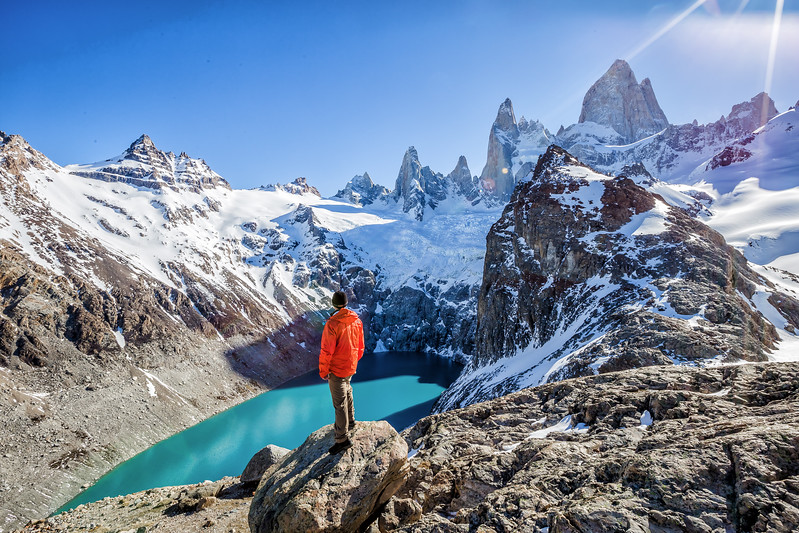
The feeling of excitement over this discovery cannot be put in words. After thinking we’d missed a chance to see the iconic view, all was made right with the extra effort of climbing the second hill.
We lingered for the better part of an hour, taking pictures and celebrating a moment that we’d anticipated since we booked this trek in the Spring.
Of course, all good things must come to an end and we wanted to beat the onset of sunset back to camp. Heading back down the same trail we navigated on the climb up wasn’t much easier.
There were even portions of the trail I had to squat down to avoid slipping but I’m happy to report we made it back to camp well before sunset.
It was nice to arrive back to an already set up camp. This meant we could gather around for stories and hot drinks near the cook tent.
Patagonia has a strict rule of no fires in National Park areas, so we went without a campfire but the atmosphere was fine without one.
The Poincenot Camp is comfortable with great tree coverage for blocking wind. It’s located near to a clean water source and has a long drop toilet.
Day 3 – Poincenot Camp to Laguna Torre
5-6 hours with 400m elevation gain
Overnight: De Agostini Camp
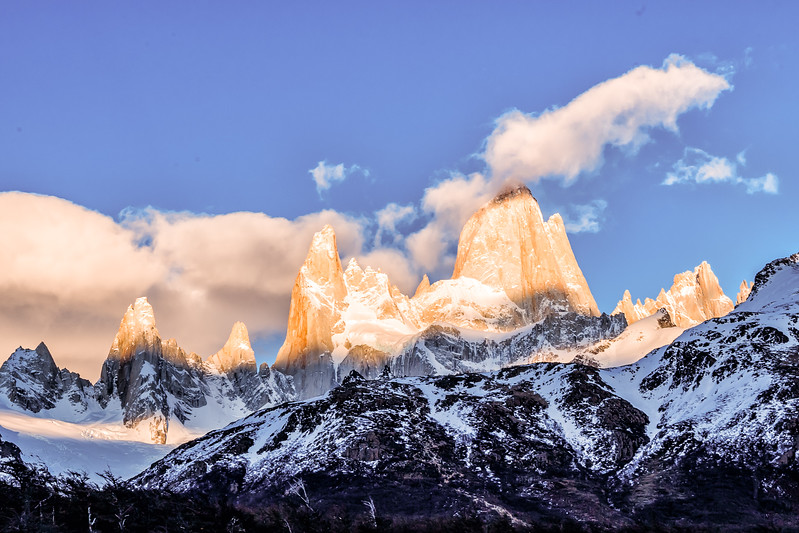
Despite wanting to squeeze every minute of sleep from the night, we opted to get up early for sunrise.
Our luck with the weather the day before, and an optimistic forecast, meant we could have a chance for clear skies as the sun rose over Mount Fitz Roy. I love to sleep, but how could we possibly miss that opportunity?
Happy to report that we didn’t and the sunrise was amazing. Returning to camp we enjoyed breakfast before repacking our backpacks and tearing down our tents.
We had some ground to cover and much to our luck the weather was on our side for another sunny, clear sky day. It was pretty unreal to have 2 days in a row of perfect weather.

The hike between Poincenot Camp and De Agostini Camp took us around 3 hours including a stop for an early lunch. To say the views are stunning doesn’t do it justice.
Just after leaving camp we could tell it was going to be good and looking back on the trail we were passing afforded us the most amazing views of Fitz Roy and the surrounding area.
The trails on this section are well marked and easy to follow, a lot of day hikers come up to Laguna de los Tres and then make the loop over to Laguna Torre, so this area is no stranger to hikers.
Entering a section of the trail with marshy areas, we welcomed the sight of a wooden walkway to elevate us out of the water. Just so happens it’s in the most picturesque part of the trail.
Besides the photo stops, we made good time, arriving at De Agostini Camp just after lunch. With time on our side we opted to set up camp again and settle in before taking on a 3-hour return hike to Mirador Maestri.
This hike takes you up a tall glacier-formed bank that creates a lip around the Laguna Torre.
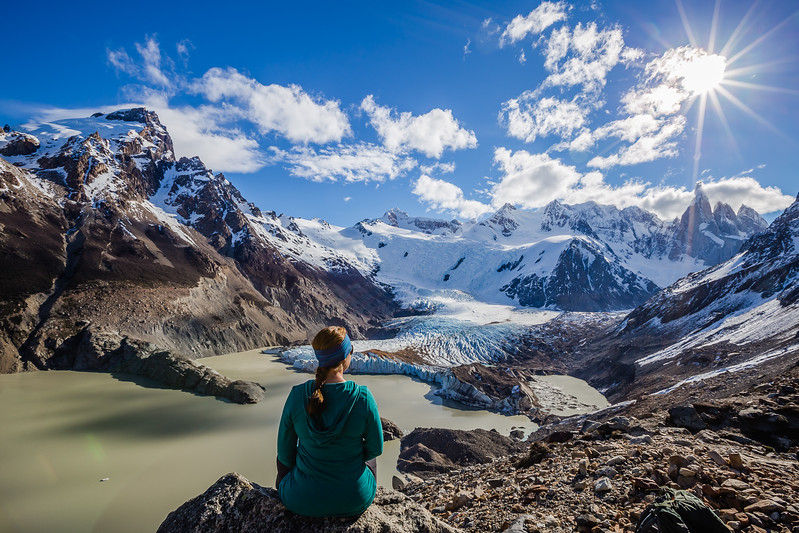
Walking along this lip is fairly easy once you reach the top and offer you unparalleled views of Cerro Torre and the Glacier Grande on a clear day. If you can believe it we found ourselves enjoying another t-shirt beautiful day in Patagonia with no wind.
The biggest risk on this hike is maintaining your footing so you don’t go tumbling down the side into the iceberg littered Laguna Torre. It’s hard to keep your eyes on the trail with the views you get in this spot, so I recommend caution on the highest level.
Safety aside, it’s a stunning way to spend the afternoon with views that rival the base of Cerro Fitz Roy. The trail along the lip takes you all the way to the official Cerro Torre basecamp, an iconic camp that is used only by people making attempts to summit the insanely technical mountain.
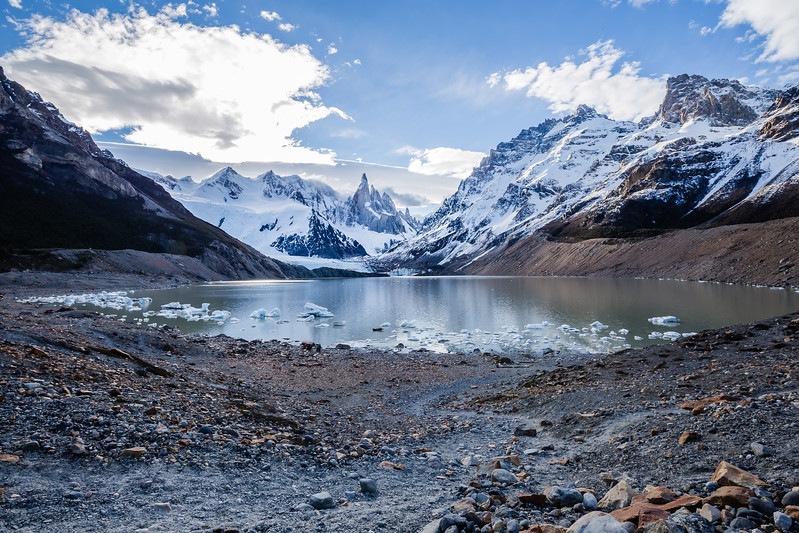
It’s really something to stand in a place where great climbers have stood while marveling at the views that surround you. It’s a feeling we can only compare to the basecamp of Mount Everest.
The De Agostini Camp is beautiful, located just on the banks of a fresh glacier-fed river. The campsites have great tree protection from wind, rain and wood branch barriers have been constructed to keep the wind off your tents.
Day 4 – De Agostini Camp to Laguna Toro
6-7 hours with 800m elevation gain
Overnight: Laguna Toro Camp

Today would prove to be the most challenging yet fun day on the trek. We set the alarms again for a sunrise; we would have been fools to not do it as we were given another beautiful morning with sunshine, barely any clouds and no wind.
Having captured the first light on Cerro Torre, we headed back to camp for breakfast and then broke down camp. We had a long day ahead of us and we started moving before 9 am.

Making our way back towards Laguna Torre, we headed down towards the Fitz Roy River in the opposite direction of the lake hike we did the day before.
It was upon arriving at the river that we prepared for our first of several adventures that day, a zipline crossing.
Guides must carry all of the gear needed to cross the line because where we were going they don’t want day hikers. The zipline is a barrier of entry and if you don’t have the gear to cross it, you don’t go.
This made it exciting as we sent our packs across the river one by one and then lined up to take our turn across.
Of course, this isn’t like the attraction ziplines that use gravity and angles to move you, on this zipline we had to pull ourselves across by using the hand over hand method on the line.

Once the group was across we said goodbye to Laguna Torre and started our trek to Pliegue Tumbado where we would summit the Paso de Las Agachonas. It wasn’t long before we started our climb.
Surprisingly, it took us through a heavily wooded area before the ‘trail’ began to ascend at a very steep rate through thick forest.
For me, this was the most difficult part of the day. The route was steep and obstructed by tree roots and brush.
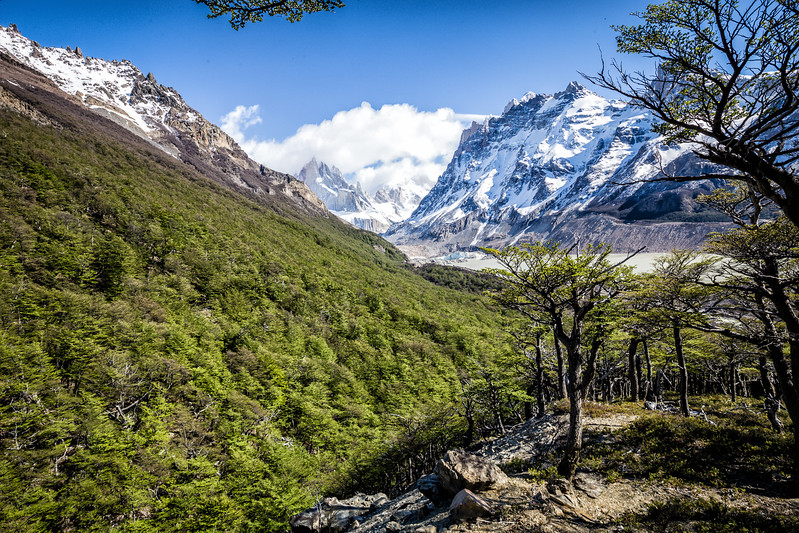
I tend to climb slowly anyways but the added obstacle course set me behind the group for the first half of the climb. Slow and steady was the name of the game and it wasn’t too long before we stopped for a rest.
It’s amazing what you can accomplish when you just put your head down and push through.
From the rest stop, we made the last push to the summit of the Agachonas Pass and were awarded incredible views of Cerro Torre, Mount Fitz Roy, Laguna Torre and Glacier Grande below us.
We seriously felt like we were standing on top of the world and were all elated with our feat.

With the amazing weather, another unbelievable day without wind, we made the mutual decision to have lunch on top of the pass before descending down the other side of Pliegue Tumbado en route to Laguna Toro. That lunch stop easily makes the top 5 best lunch stops of my life list.
Leaving was a struggle but we knew we had more ground to cover and this time it wasn’t without strapping on some gators.
October is the beginning of the trekking season in Patagonia, meaning the parks open and the trails are open to hikers, however, this doesn’t mean the pass routes will be clear of snow yet.

It wasn’t long after leaving the pass that we encountered blankets of snow across the side of the mountain. We trudged through, oftentimes stepping into sinking areas that dropped us into the snow up to our waist.
Luckily we had the sun on our side so instead of being miserable we enjoyed playing in the snow along the way.
Once out of the snow it was another 20 minutes of downhill before we stepped into the Rio Tunel Valley and began a long flat walk to the Laguna Toro Campsite.
The walk was mostly along a trail leading through thick brush area and over a couple of streams before ending in an eerie campsite set within stripped trees and large rocky hills.
Exhausted from the long day we quickly claimed a campsite, set up camp and headed for the cook tent for a much needed hot drink.

Dinner was a welcomed sight as we sat around the tent sharing travel stories and reminiscing about the day.
We didn’t linger and everyone headed to bed early in anticipation of our route for the next day, the infamous Paso del Viento.
The Laguna Toro Camp is quite remote and set in an area that has an eerie feel to it. The area is very notorious for winds, so people have gone to some effort to pile up high walls around each tent site.
It has a long drop toilet and a spring in camp. We were the only people camping there during our trek.
Day 5 – Laguna Toro Camp to Paso del Viento
7-8 hours with 900m elevation gain

What was to be our most remote and adventurous day was the day the notorious weather of Patagonia caught up with us. Finally. After enjoying the most amazing four days of weather, the wind and rain joined the party.
Under normal circumstances, we wouldn’t hesitate to hike in these conditions, but when your guide tells you that the winds are too strong to risk it, you take notice.
He told us that in the current conditions, we’d likely have to crawl our way up to some challenging parts of that trail.

Merlin and his team are experienced mountaineers who have been guiding in Patagonia for 20 years. When they tell you it is not safe to make a climb, you listen. So for us, this meant a day pinned down in the Laguna Toro Camp.
After breakfast, we hiked out from camp to the shores of Laguna Toro so we could all get a taste of what Patagonia can be like when the winds are roaring.
Leaving the protection of the trees in camp, the wind gusts became apparent immediately yet didn’t feel as strong as we had anticipated.

It wasn’t until we got to the shore of Laguna Toro that we felt the real force of Patagonia. I’ve never before stood in wind so strong that I couldn’t lift my foot without being blown sideways.
There were times I was walking on the beach and a gust would come in so fast it would move me easily 6 feet or more from where I was walking.
The wind was no joke and we were grateful to have an experienced guide with us to advise against the pass attempt.
As we stood there longer we could feel the air building around us and as if on cue, the glacier from the mountains released a gale force of wind across the lake right at us.

We all turned to face the wind and leaned into it as it howled around us. There were times our bodies were at 45-degree angles to the ground and yet we didn’t fall.
Laughing about our brush with the windy forces of Patagonia we returned to camp for an afternoon of napping, conversation, and eating.
It was a pretty laid back day and despite our disappointment in the change of plans, we were happy to have experienced one of Patagonia’s most notorious faces.

Day 6 – Laguna Toro to El Chalten
As if the day before had never happened we awoke to another beautiful, sunny day. In disbelief of our luck, we ate breakfast quickly and began packing up camp.
It was our last day on the trail and we would be spending the majority of the day walking our way back to El Chalten.
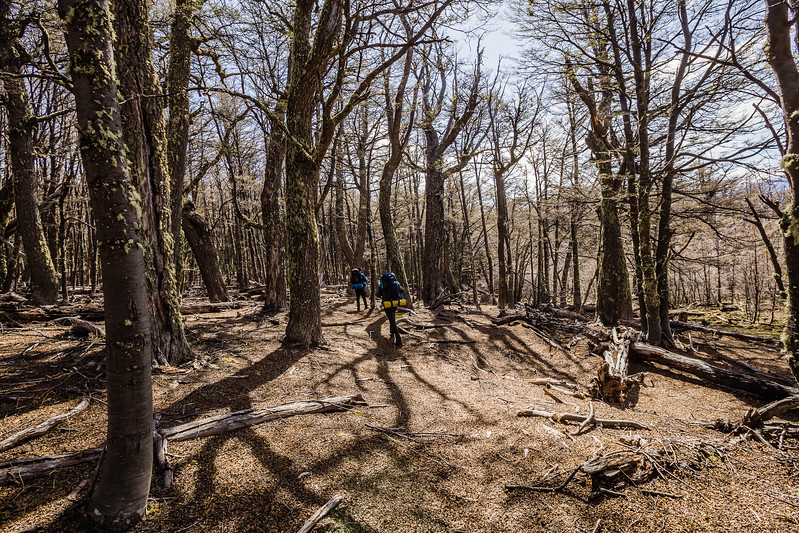
Leaving Laguna Toro Camp we headed back out the way we came through the thick brush and hopping across streams.
When we came to the base of Pliegue Tumbado we reminisced about our descent from the pass a few days prior and this time headed along the base of the mountain.
While you can’t go wrong with the views in Patagonia, this was the least exciting day of the trek view wise.
Most of the hike out is through open areas of marshland before turning into heavily wooded beech forests and descending down into El Chalten.

The best view of the day came when we left the base of Pliegue Tumbado and approached a stunning view over Lago Viedma. We were lucky enough to enjoy a lunch stop here with several Condors flying overhead.
As much as I wanted to stay, I was really looking forward to a change of clothes, a hot shower, and a beer.
With all endings, the excitement built as the town came into view and we powered through the last part of the hike, swaggering into town like a band of backcountry survivalists.
We’d done it. We’d crossed another Top 100 Travel Adventure off the list and had one hell of an adventure in the process.
Hiking in Patagonia Tips
Our 5 days of trekking in Patagonia was everything we could have hoped for and so much more. We had a fantastic group, two of the most experienced guides in Patagonia and amazing weather. It really doesn’t get much better than that.
It seems that many people tend to head towards Torres del Paine when planning trips to Patagonia but after being in Los Glaciares, I think they should reconsider.
Granted, we haven’t been to Torres del Paine, yet, but the appeal of less crowded trails will call to an adventurer and you can get that in Argentina.
We know we’ll be back and we intend to hike the W and O trails in Torres del Paine too. If you like true backcountry adventures then hook up with Merlin at Mountaineering Patagonia and prepare for the trip of a lifetime.
You might also like:
- Amazing Hiking Trips Around the World
- Best Hiking Poles: Top 5 + How to Choose the Right Ones
- 40 Hiking Essentials: The Ultimate Hiking Packing List
- 10 Best Hiking Backpacks for Your Next Adventure
- 10 Essential Tips For Planning A Trip to Patagonia
- Machu Picchu or Patagonia: Which is the Best Long Distance Trek for You?
Did you like this story? Share it!
Travel planning resources, about lina stock.
Lina is an award-winning photographer and writer that has been exploring the world since 2001. She has traveled to 100 countries on all 7 continents. Member: SATW, NATJA, ATTA, ITWA
6 thoughts on “5 Days of Hiking in Patagonia: The Basecamps Trek”
It reminds me of my trip to Patagonia Argentina where I visited Los glaciares de El Chalten (Torre Glacier) and Calafate. Amazing landscapes.
Loved this, and your video on youtube. Planning to do it late this year, or early next.
You’re going to love it! Def reach out to Merlin at Mountaineering Patagonia, he’s the best!
Our trek begins Dec 1st with Merlin and company! Can’t wait! Do you have any suggestions as to the packing list they recommend on their website? Anything you would bring more or less of than they recommend? Would you say most days are moderate or difficult treks? Thanks again!
Yay!! You’re going to have such a great time. Patagonia is incredible and Merlin and company are top-notch guides! Their packing list is spot-on, my biggest piece of advice is to pack as light as possible. Don’t bring anything you don’t need – which is way easier said than done. Your layers are absolutely critical. High tech fabrics are worth the money, they actually work. Bring your own poles or rent from Merlin. You’ll need them. AND, bring/rent gaiters. Most days were moderate. Enjoy!!
Wow beautiful post and pictures in it are amazing.
Leave a Comment Cancel reply

You are using an outdated browser. Please upgrade your browser or activate Google Chrome Frame to improve your experience.

- Trip Styles
- Destinations
Top Five Best Hikes In Patagonia
- All Inspiration and Destinations
- Canadian Rockies
- New Hampshire
- New Zealand
- North Carolina
- Vancouver Island
- Washington State
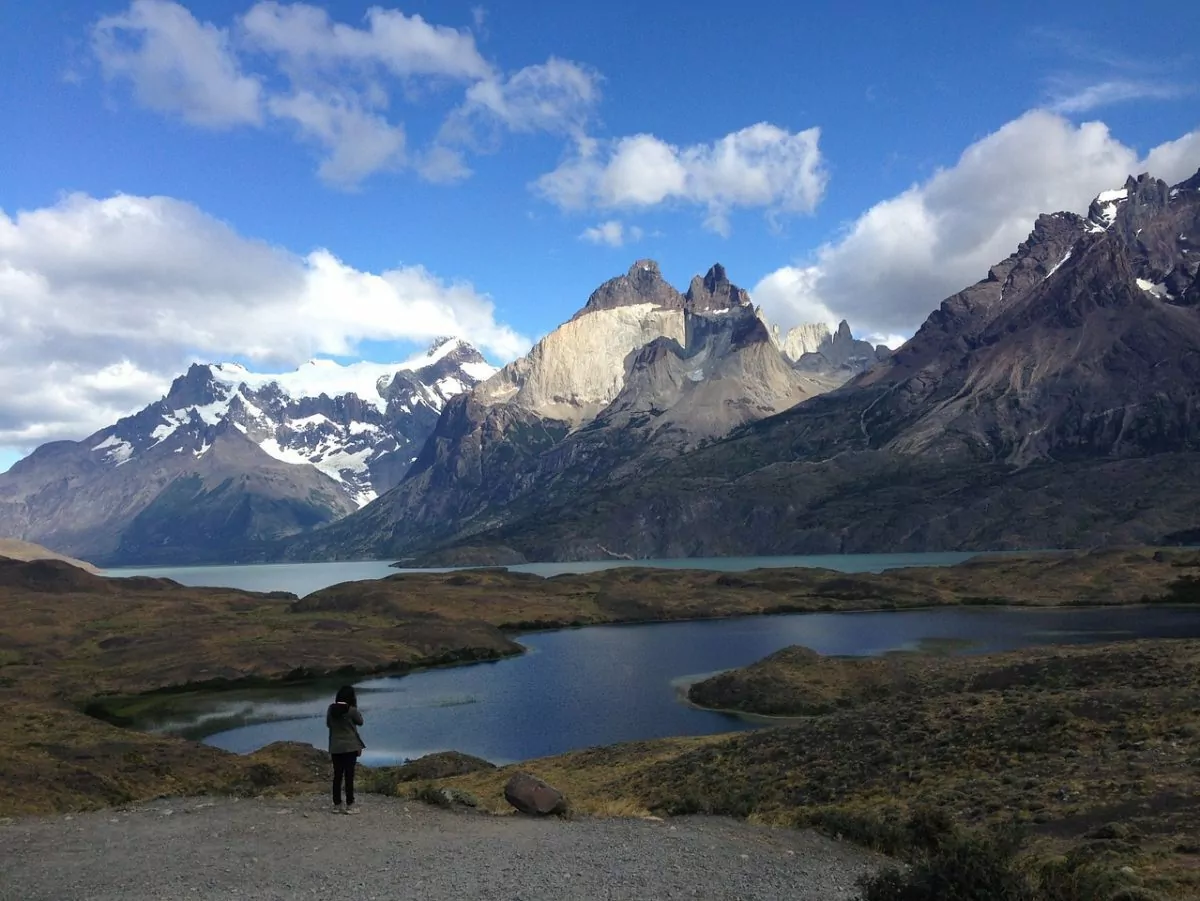
Patagonia. The word itself holds inquisitive notions. Planning a visit and wondering which hike to be footloose and fancy-free along? Look no further, we have you covered in the top five best hikes in Patagonia!
All-inclusive Patagonia Trekking Adventures
1) The W-Trek
Embark on the very classic multi-day pilgrimage route through one of the most stunning regions of Patagonia. Located in the heart of Torres Del Paine National Park in Chile, the W-Trek certainly will not disappoint. The hike itself viewed on a map is in the shape of a “W”. On this well-trodden rite of passage, you will find glaciers, giant jagged-edged sedimentary peaks, wildlife, grasslands, wind struck flora, beautiful forests, and blazing blue lakes. This jaw-dropping hike is popular for a reason and is known to many as one of the best hikes in the world. Come see what this magical gem smothered in the middle of the Andean mountain range is all about!
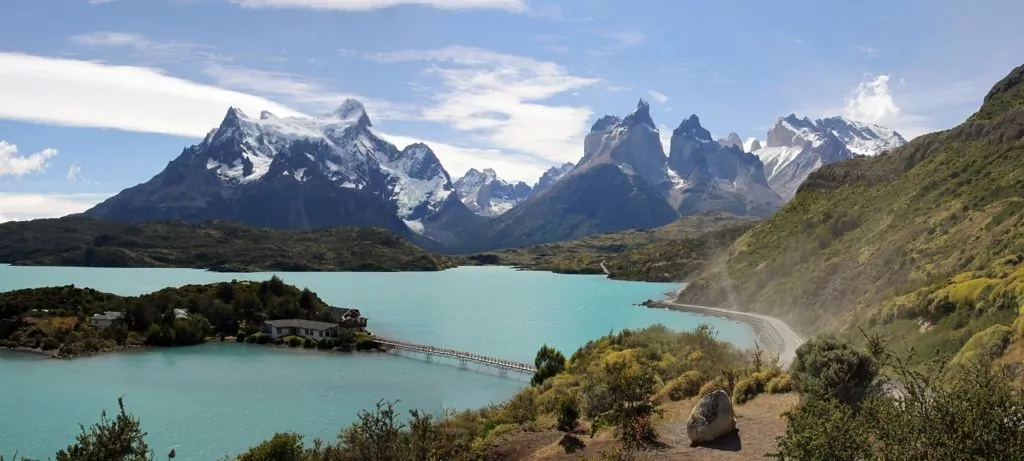
The W-Trek is rated moderate in difficulty. It covers up to 45 miles/72 kilometers with a cumulative elevation gain and loss of 9,700 feet/ 2,956 meters. The hike can be accomplished year-round, although the winter months may bring freezing temperatures, snow, and road closures. October to April is the best weather window, but crowds are to be expected this time of year. By mid-March in this region, you can begin to see the transformation of the fall leaves bursting into their autumn colors. If you are looking to avoid crowds on the W-Trek and are resilient to elements, visit in the fall or winter months.
The multi-directional route is typically accomplished between 3-7 days. You can certainly do the W-Trek on your own, or alternatively, you can join a guided company . If you plan to go on your own, booking in advance is essential and the key to a successful trek. There are a plethora of options when it comes to accommodation. It is wonderful to have so many choices, but it can also be a tad overwhelming. Refer to the list below for your sleeping and budget preference while on the trail. Along the W-Trek you may mix and match your accommodation choices. For example, you can book a stay for two nights at a refugio, and one-night camping or one night in a lodge, and two nights in refugios and so forth.
accommodations
Refugios are similar to backcountry huts or lodges. This is a mid-range pricing option. They must be booked in advance, as spots are limited. Refugios typically are 6-8 person dorm-style rooms, equipped with kitchens, cooking staff, bathrooms, showers, and a communal area. These are fantastic hubs for social mingling with other trekkers. The refugios vary with either a simple bed option (no bedding, you will need to bring your own sleeping bag) or with a made-up bed (where all bedding is provided). It is advised to bring ear-plugs, as it can be a bit noisy. Accommodation pricing will be separate from the meal prices unless you are going with an all-inclusive guiding company. Some hikers who wish to camp, but not carry all of the food, opt to dine at some of these establishments along the way.
For camping along the W-Trek, there are designated campsites with cooking stations, assigned camping spots, and bathrooms. This would be the cheapest option to partake in along the trek. Many of these campsites are situated near lodges or refugios where further amenities can be found. The campsites vary from 50-200 tent spots available and are considered simple. Some of the more remote campsites are free to stay at, while other sites typically in close proximity to lodging have charges. The free campsites hold only basic amenities such as toilets and running water. The paid campsites will have toilets, showers, electricity, gear rental, a restaurant, running water, and wi-fi in some areas. All campsites should be booked in advance.
You can either bring all of your own gear or rent a sleeping bag, sleeping pad, and tent. This rental choice can be arranged so that you will not need to carry any sleeping gear on the duration of the hike, and the tent will be set up for you upon arrival. Do book this in advance when choosing your locations to camp.In general, the rental tents and sleeping gear are good quality and in a decent state. Renting gear permits you to only need a day pack with pertinent items. On the other hand, if you enjoy the challenge and can carry your own tent, sleeping bag, and sleeping pad- it can be very nice having your personal gear along.
When it comes to meals on the trail while camping, there are options as well. You can either carry and pack all of your own food and stove, or choose to dine in the restaurants at the refugios. You can certainly mix and match these as well. The refugio’s host hearty meals with plentiful portions and can cater to various dietary restrictions. When cooking your own meals, it is extremely important that cooking is done only in designated areas.
Luxury Eco-Yurts
A recent addition to Torres Del Paine, Luxury Eco-Yurts captures a unique experience with creature comforts along with modern amenities. This enables travelers to have private spaces, but still contains great communal areas for meeting other travelers. There are two companies in Torres Del Paine which run these great yurt options. Patagonia camp has its 18 beautiful yurts stationed along the bank of Lago Toro with even private Jacuzzies in each yurt. The property has kayaks and stand-up paddleboards for getting out on the lake and a restaurant with delectable local Chilean dishes. Eco-Camp is deemed as the world’s first geodesic dome hotel. The 100 percent sustainable lodging sits in a stunning location within close proximity to all of the action in Torres Del Paine. Yoga, massages, unique tours, horse-back riding, and delicious meals await.
Not keen on refugios, yurts, or camping? Have no fear, lodges are near. While staying in lodges within Torres Del Paine, you can still hike most of the W-Trek and be able to obtain further amenities and creature comforts. You can still see the highlights along the W-Trek and only need to carry a small day-pack for the hikes. These accommodations are comfortable, warm, and away from the notorious Patagonia wind. In many of the lodges, breakfast is included, dinner is available on-site, and wi-fi is available. Generally, the lodges are situated in a gorgeous location and offer tours, package deals, and activities around the vicinity. There are many choices when it comes to lodges in Torres Del Paine ranging from mid-range to up-scale. Check out a lodge-based hiking tour here .
Meal packages can be purchased in refugios and lodges if not already included in your stay. These will contain breakfast, a box lunch, and dinner. Typically guided tours will be all-inclusive and have 3 meals a day provided. If you are camping, you can certainly get packaged meals as well. These meal packages along with most logistics in Torres Del Paine, need to be booked in advance. If meals aren’t booked in advance, they may not be able to provide a meal for you. If you are camping the entire way or mostly camping, mixing and matching when you cook versus when purchasing a meal is very doable.
Hike The W-Trek with a Guide
Guided W-Trek adventures are available. It is a stress-free, exciting way to do this trip. The tour company handles permits, gear, transportation, meals, and provides a professional guide so you can focus 100% on enjoying your adventure.
guided w-trek trips
2) The Torres Del Paine Circuit

The Torres Del Paine Circuit is an amazing continuation of the W-Trek located in Torres Del Paine National Park, Chile. This variation is a longer, rugged, more challenging, and further picturesque journey through the park. This sensational hike is also known as “The O”. Additionally, for an even longer extension of The classic W-Trek and Torres Del Paine Circuit, there is also “The Q” which is a day tacked on at the beginning of the classic circuit. On the map, these treks complete an “O” and a “Q” in shape, consequently giving their names.
The circuit is a remarkable trek that takes you through open grasslands, around crystal blue lakes, dense old-growth forests, bridge crossings, and over the astounding John Garner Pass (Paso John Garner) to the flabbergasting and aptly named, Grey Glacier. The stunning Gray Glacier is the largest in the National Park, expanding a total of approximately 3.7 miles (6 kilometers).
If you have the time, energy, and stamina I highly recommend spending the extra days to complete the entire circuit. It is well worth it and an excellent feeling to come full circle, so to speak. The trail tends to be less crowded in the backside of the park for a bonus. The trek is rated moderate to difficult and the average journey on this trek is 6-10 days. It is a well-maintained trail, and fairly easy to follow. The trail heading up to Glacier Gray is loose, steep, and uneven. This counter-clockwise journey in total is approximately 85 miles ( 137 kilometers). The season runs mainly from October-March here as the pass can be impassable.
Unquestionably, the hike can be planned and accomplished on your own. This is only recommended for the experienced hiker, however. Planning and booking in advance is of the essence. On the other hand, there are many tour companies that operate this hike. Click here to find out more about guided tours. Going with a guided company relieves all the hassle of booking, planning, logistics, and heavy research.
This hiking odyssey holds 4 options for sleeping quarters listed below.
- Your personal tent: Bringing your tent allows for flexibility, personal achievement, and is the most affordable option along the Torres Del Paine Circuit.
- A rented and already set-up tent at each location along with a sleeping kit: This is a great option for cruising into camp and not having to set up your sleeping area, the work would already be completed for you! The tents, sleeping pads, and sleeping bags are well taken care of, clean, and are usually adequate in quality.
- Refugios and two nights sleeping in a tent: There are two areas along the trek that will need to be camped in (either with your tent or rented tent and sleeping gear), as there are no refugios available in those sites.
- A mixed alternative if you don’t mind the extra planning and logistics, you can book nights in lodges, refugios, and camping combined to complete the circuit.
To book campsites and refugios for the circuit, reserve from the three sites provided well in advance. CONAF campsites are the two free campsites in the park. Fantastico Sur offers packages, camping, refugios, and cabins. Vertice Patagonia offers camping, programs, and refugio stays. These sites can all be viewed in English and provide an assortment of options to choose from. Within the Refugio’s there are the simple bed or made-up bed choices available. Meals will be purchased separately unless booking a package deal complete with meals, or going with a guided service.
For the W-Trek, O-Trek, and Q-Trek there is more than just hiking available. Fishing, wildlife tours, kayaking, boating, climbing, horseback riding, glacier tours, and even off-road tours may be arranged. With all of these alternative activities and ways to experience the park, you definitely don’t have to be into just hiking to fall in love with this region.
For transportation to and from Torres Del Paine National Park, please refer to Dan Purdy’s Wildland Trekking blog page titled “All About Torres Del Paine National Park” where you will find a wealth of helpful information on getting there and more.
Hike The Torres Del Paine Circuit with a Guide
Guided O-Treks are available, and are a stress-free, exciting way to do this trip. The tour company handles permits, gear, transportation, meals, and provides a professional guide so you can focus 100% on enjoying your adventure.
guided O-trek trips
3) The Refugio Otto Meiling Trail
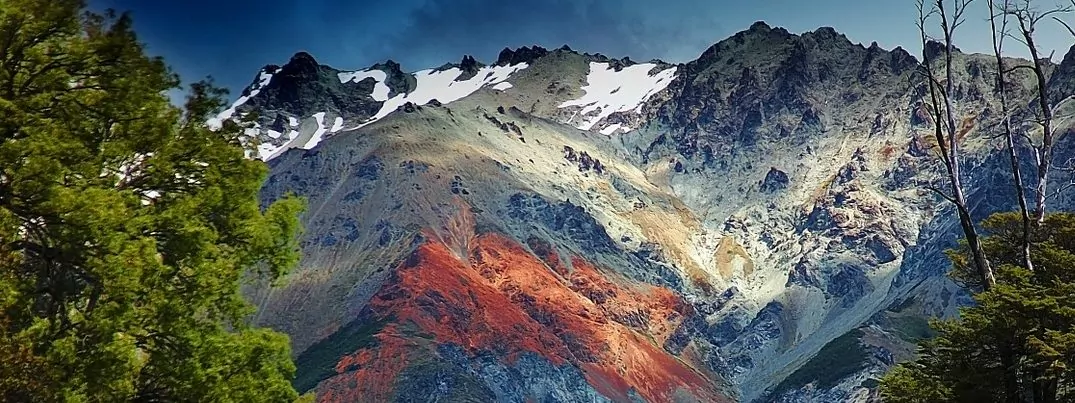
The Refugio Otto Meiling Trail is located near Bariloche, Argentina. Bariloche is a hub for outdoor adventures and definitely worth a stopover. The hike itself is unique in the fact that the peak named Tronador, straddles two National parks and two countries. It is located in the Nahuel Huapi National Park and Vicente Pérez Rosales National Park (the oldest National Park in Chile). The journey starts and finishes in Argentina, with the closest town being Pampa Linda. From Pampa Linda, this is the gateway to not just one, but many great hikes.
The peak named Tronador was first ascended by a German gentleman named Otto Meiling in 1934. The refugio along the trek and hike is now named after him. He also founded a mountaineering club in Bariloche, that still exists today. Tronador is a popular place for trekkers and mountaineers alike. It is now an extinct stratovolcano at approximately 11,400 feet (3,500 meters) that is home to 8 alluring glaciers. The Tronador translates to the word “Thundering” in English, which was noted due to the falling of rocks and ice. Along this hike, you will trace through U-shaped valleys carved out by glaciers, view stunning waterfalls plummet to the volcanic encrusted earth that surrounds, be captivated by giant glaciers, and be hiking on a volcano!
Getting there can be a fairly daunting task, but it is surely worth it and due to the location it is a less crowded hike within the Andes. From Bariloche Argentina, it is a 3-hour journey to Pampa Linda. The road here is very narrow, therefore results in the necessary use of a time-table system for traffic management. The Mountaineering Club, as I mentioned earlier named Club Andino Bariloche (CAB), can assist in arranging transportation, guides, and information for hiking as well as climbing. Buses depart regularly from Bariloche to head to the park. You may also take a rental vehicle, but it is a rough road.
The trek is on average 2-3 days and rated moderate in difficulty. This hike is best completed from December to April. It is roughly 18.5 miles (29.9 Kilometers) in total. It contains a total elevation gain and loss is 6,300 feet (1,920 meters). The Refugio Otto Meiling is where you can camp or stay in the dorm-style rooms overlooking the Cerro Tronador. The Refugio accommodates up to 60 guests and has a restaurant on site. It is possible the Refugio Otto Meiling hike can be combined for a longer adventure with Paso De Las Nubes.
4) Laguna de Los Tres (Fitz Roy Trek)
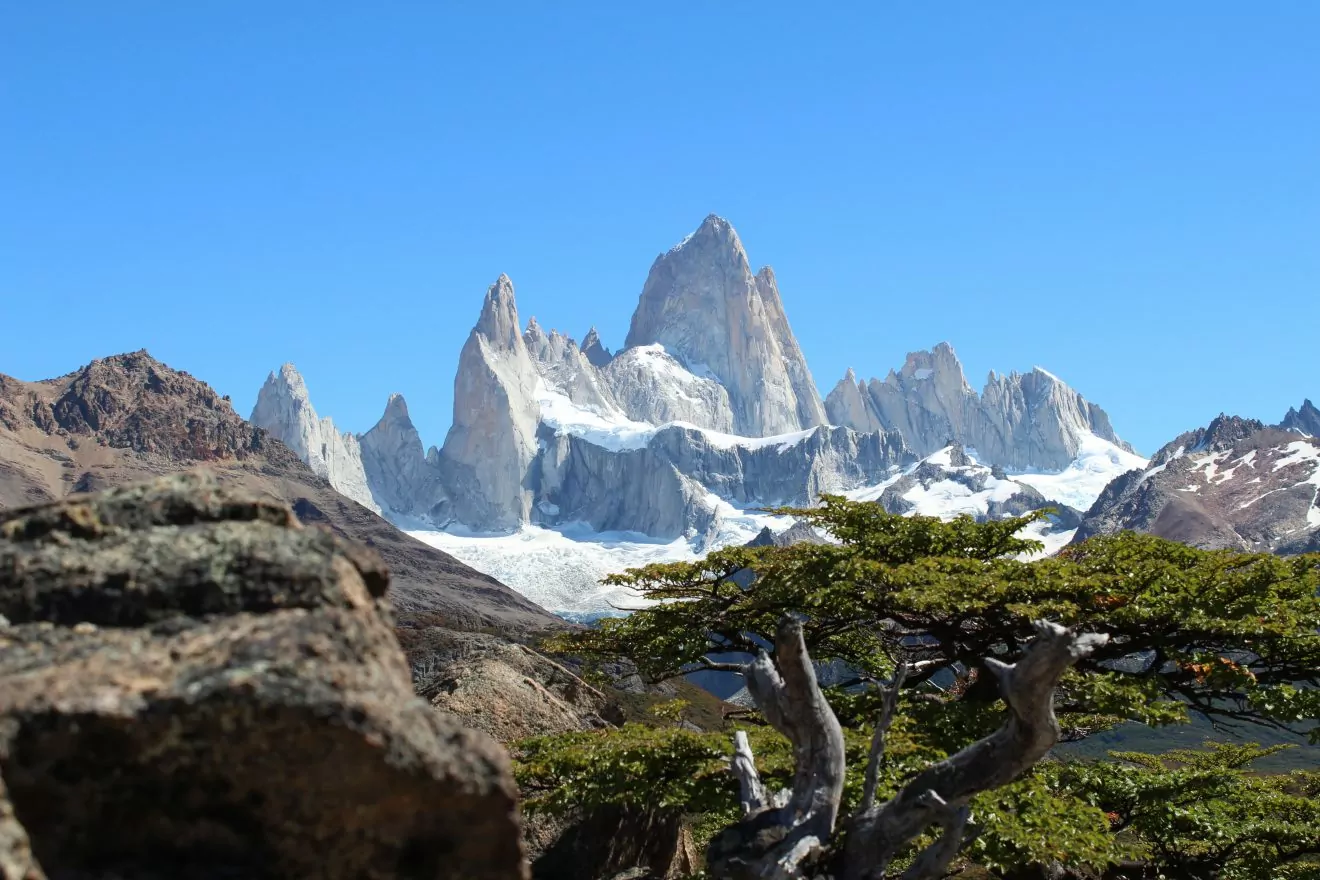
Photo by Rodri Caruso on Unsplash
The Laguna de Los Tres hike , also known as The Fitz Roy Trek, had to be put on the list. This shorter trek located near El Calafate in Los Glaciares National Park is unforgettable. The region is a bird watcher’s paradise, filled with sheer jagged peaks, dazzling blue lakes, tranquil forests, spectacular glaciers, and panoramic views. The Laguna de Los Tres hike takes you right up to the foothills of the three beautiful peaks, the Poincenot, the Fitz Roy, and the Torre.
This popular hike is typically completed within one to three days and is roughly 16 miles (26 kilometers) in length and rated moderate in difficulty. It is fairly steep, with uneven surfaces. Overall, the trail is easy to find and well maintained. The trek is more commonly completed in one day, but many hikers will decide to tack on the Cerro Torre or Madre e Hija trails to complete a longer distance journey. The Fitz Roy Trek is possible to complete year-round but may be impassable when there is heavy snow in the winters. The total cumulative elevation for this trail is approximately 3,150 feet (960 Meters).
El Calafate is the basecamp mountain village to many amazing hikes. It is also a very popular spot for rock climbers. Los Glaciares National Park was established in 1937 and by 1981 was designated a UNESCO World Heritage Site. The region is free to enter and there is a wealth of information around Calafate’ to send you well on your way. The start of the trail is just right outside of town, so it is within walking distance from all accommodations. There is also a parking lot at the trailhead if you are renting a vehicle. El Calafate has a wide range of lodging options, but they will all fill up very quickly in peak season. Be sure to book far in advance for your stay.
If you choose to camp overnight in Glaciares National Park along the Laguna de Los Tres trail, there is a designated free campsite named Poincenot along the way to the lake. The next morning you can either continue back down to El Calafate on the same trail or conjoin one or two other hikes. This trek can be completed as an organized tour, or with some planning, it can be done solo.
5) The Huemul Circuit
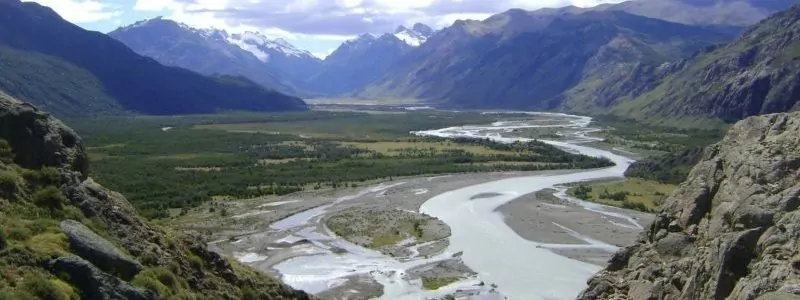
Last but not least, the amazing Huemul Circuit . This is known to be one of Patagonia’s most challenging hiking trails. This intense, but extremely rewarding trail climbs over two passes, has several river crossings, requires strong navigational skills, and even has a zip-line crossing on one of the river sections. This is for the experienced hiker only, but it is possible to go with a guided company along this journey. This hike has absolutely breathtaking views and due to the challenging aspects of this hike, you won’t see as many people here in comparison to the other hikes mentioned above. Massive glaciers, panoramic views, glacial silt-filled rivers, lush forests, and beautiful peaks await your eyes here.
The hike can be completed from December through April. The length is 40 miles (64 kilometers) in the circuit. The first day of this trek will feel very mild in comparison to the following days, but don’t let that fool you! The second day will be the start of the real challenges with the ascent and descent of one of the passes, named Paso del Viento. The descents on this trail are known to be as equally challenging as the ascent. The river and stream crossings with a backpack over uneven terrain are deemed difficult. Know your limits before you embark.
Camping is the only option available on this journey, and you will need to carry a backpack with all of your essential gear. Going with at least one other person to help share the big gear items such as a tent is extremely helpful, and safer. You’ll need specific items (like a harness, rope, and carabiners) to complete this trek. If you don’t own this gear, a guiding service can provide these items or alternatively you can rent most of these items in El Calafate. Like most things in Patagonia, you will want to rent in advance or at least make sure there are plenty of these items still available when it comes time for your journey in the Huemul. El Calafate is a good place to obtain your backcountry meals as well.
The trek is in a deeper and less explored area of Los Glaciares National Park, which sits next to the charming town of El Calafate. The trek can be started from the town of El Calafate gently heading towards Torre Valley. The duration of this hike is three to five days. Before heading out on this endeavor, be sure to register at the park office in El Calafate with a ranger. A permit is required for this trek. Make sure you have a map, compass or GPS, and know how to use them. A ranger at the park headquarters will most likely want to check your equipment and gear for the zip-line as well. Know how to use the equipment before you go on this trail and before getting to park headquarters.
hike Patagonia!
I hope that the information provided has been a segway into assisting with what hikes to do while visiting Patagonia. Whichever hike you choose to embark upon, you really can’t go wrong here. The hard part is just narrowing the choices down because you could honestly spend a lifetime hiking in this region and only scratch the surface. When you do choose your trek, travel safely, responsibly, and have an amazing journey south!
If you would like further information on Patagonia, these hikes, or others be sure to visit our website or read our other blog posts about Patagonia! Thanks for your time and see you on the trails down south!
Wildland Trekking Hiking Adventures
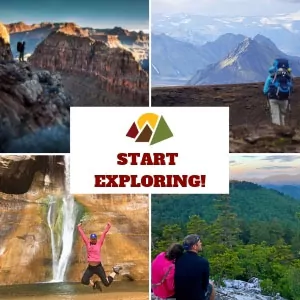
As the world’s premier hiking and trekking company , Wildland believes in connecting people to fantastic environments in amazing ways. Patagonia offers an array of incredible hiking and trekking experiences. Wildland Trekking provides 5 different multi-day hiking and backpacking adventures in the region. Read more about our Patagonia trips .
To learn more about our guided backpacking trips and all of our award-winning hiking vacations , please visit our website or connect with one of our Adventure Consultants: 800-715-HIKE
Explore Patagonia with Expert Guides
About Jeanelle Carpentier

Jeanelle Carpentier is an ambassador of the world. She has resided in 4 countries, 7 states and has been guiding with Wildland for over 5 years. When she is not sharing her passions while working, she spends her time traveling, volunteering, and exploring. Nature has always been strong to her heart and loves being able to write about it, work in it, help protect it, and dwell in it as often as possible.

wildland Wires
Sign up to receive our exclusive Wildland Wire emails and stay up to date with Wildland Trekking's promotions, discounts, contests, outdoor tips and tricks, trip reports and more!
A Full Backpacking Guide to the ‘O Trek’ in Patagonia: Where & How to Go
In the southern region of Chilean Patagonia, Torres del Paine National Park's 'O Trek' combines European hostel-style accommodations with rugged Patagonian terrain. Here’s how to do it right.
Share this:
- Click to share on Facebook (Opens in new window)
- Click to email a link to a friend (Opens in new window)

Exploring Patagonia is an adventure of all adventures, a premier spot for virtually every type of outdoor activity you could imagine. This region , located at the tip of South America, spans both Chile and Argentina and has rivers, mountains, vistas, and glaciers that are inscribed in the brains of dirtbag climbers and bucket-list travelers alike.
But logistically, exploring Patagonia (and the surrounding area) is far from convenient. Flights into the region are sparse, and the bus systems, while perfectly nice, take a long time and can be tricky to book. Cell service is even more unreliable. Exploring between both Chile and Argentina also requires border crossings (of course), currency exchanges (bring plenty of high-value USD bills), and a lot of squandered plans due to bad weather.
Regardless of inconveniences, one of the region’s most popular areas for recreation — Torres del Paine National Park — draws visitors of all walks of life to its entrance. The park, located in Chile, is markedly different from what you might find in U.S. National Parks.
Instead of a network of roads, there is a hiking loop spanning the majority of the park, creating a broad O shape. To see the whole expanse of the park, hiking the O Trek is the only way to do so, beyond getting a permit to rock climb some of the park’s famous peaks.
But for most, devoting dollars and logistics to an international climbing expedition is out of the question. Luckily, hiking the O Trek is accessible to a wider swath of outdoor recreators, with gear rentals and hostel stays available along the trail.
Guide to the ‘O Trek’ in Los Torres National Park
What is the o trek.

Put simply, the O Trek or O Circuit, is a trail that loops within Torres del Paine National Park (also known as ” Los Torres”). Visitors must book campsites in advance and walk counter-clockwise on the loop.
Most folks hike the trail in 8 days, offshooting to include famous lookout points like the Mirador Britanico and Mirador Base de Las Torres. One of the trail’s most famous and the most difficult sections, Los Perros to Glacier Grey, is a beautiful stretch with spanning views of the Southern Patagonian Icefield.
Overall, Torres del Paine is one of the largest and most popular national parks in Chile — and the O Trek is the picturesque, full treatment of what the park has to offer.
The trek also coincides with a shorter section of trail called the “W trek,” this section (the lower part of the “O”) connects Guardería Glacier Grey with Guardería Torres, the starting and ending point of the trail. Visitors can hike in either direction on the “W,” as a ferry services Refugio Paine Grande. This also means that visitors can hike the upper part of the “O” and end early at the ferry for a 5-day loop.
The best — and only — time to complete the O Circuit is in the Chilean summer, from late November to mid-March. Travel in the winter months is limited, but guided trips in the winter along the W-Trek are possible.
Getting There
The easiest and most direct way to get to Torres del Paine is by flying from Santiago, Chile, to Puerto Natales, the closest town to the park. From there, the bus ride into the park is about 2 hours to the Laguna Amarga ranger station, where you will pay your park entry fee (bring cash). From there, a small bus (bring cash for this, too) will take you to Hotel Las Torres/Ecocamp Patagonia where you will start the trek to Campamento Serón.
To clarify, there are no cars inside the majority of Torres del Paine National Park. Driving is limited to the hotel area near the Las Torres trailhead, and a small section near the O Trek start. Unlike what you might find in most U.S. National Parks, you will not be able to tour the loop by vehicle. It is highly suggested you take a bus into the park. It is far cheaper and almost everyone does it, especially other trekkers.
In our experience, the bus system in Patagonia was nice and reliable once there, although making reservations can be difficult. Busing from other destinations like El Calafate and Punta Arenas to Puerto Natales is possible as well. The day before our trek we flew into Puerto Natales and checked into our hostel. Our reservation was with Bus Sur, so we went to the Bus Sur office to get our tickets. Booking at the main bus depot is also an option.
Day-to-Day on the ‘O Trek’ Trail

The O Trek is a 7-night route that covers roughly 80 miles with roughly 13,000 feet of elevation gain. If you plan to hike to Mirador Las Torres, plan to tack that onto your last day (day 8) before departing for your bus: it’s an early wakeup but well worth it. Note that posted distances (especially on the trail signs in the park) are often inaccurate, which makes for a fun guessing game while you hike!
The O Trek route is simple to book and follow for the first 4 days. There are only a select number of sites to camp at and no variations when hiking the first section of the trail, unless you stay an extra day at a refugio or decide to combine 2 days. (Hiking from Portería Laguna Amarga to Refugio Dickson, for example, would be a long day, but definitely feasible.)
Booking can get complicated when the O Trek begins to overlap with the W Trek. Here, a higher number of refugio options vary the distance that travelers may hike per day. The variations here are not drastic, but note that camping at Refugio Chileno on your last night will add elevation to your backpacking distance, but shorten your morning hike to Mirador Las Torres.
The most difficult day is from Refugío Los Perros over John Gardner’s Pass (the highest point of the loop at 4,000 feet) to Refugio Grey. The total day is roughly 15 miles with an elevation gain of roughly 700 feet and elevation loss of roughly 2,000 feet.
The climb is hard but steady; the descent is muddy and brutal. Hiker beware, there are three bridge crossings that’ll get your heart rate going, especially if you are scared of heights.
But while braving difficult terrain and weather, you will find a trail community on the O Trek like no other. I will always be grateful for the smattering of hikers from around the world who we met. Informally, our trail group would cook together and hike sections together. We still have a GroupMe chat to this day.
The first 4 days of the O Trek bonds folks. So, if you plan to hike solo, know that there will be plenty of other folks on the trail and at the campsites with you, but not such a large amount to make the experience crowded or unenjoyable.

Accommodations and Food
At every stop along the O Trek there are “refugios” — think mountain huts and small ski lodges with bathrooms and small markets attached. Each site has a base price for folks who plan to set up their own tent and cook their own meals. Enclosed cooking huts are provided.
From there, hikers can upgrade and rent pre-erected tents, domes, hostel beds, and more depending on each site. Sleeping bags can also be rented at refugio sites.
Both my hiking partner and I were shocked by how well-stocked the refugio markets were. Even the most “rugged” hut (Guardería Los Perros) had basic items, like ramen and energy bars, stocked. This was the only hut without showers. Other huts provided beer, pizza, hamburgers, pay-for-Wi-Fi, and more.
Packing out enough food for 7 days is not necessary if you are willing to spend some money (roughly moderate ski lodge prices) for a meal or snacks here and there. Cooking-wise, a small canister of gas and a pocket rocket-style stove is ideal. We used an MSR International Stove . If you plan to pack out all of your own food, plan to shop in Puerto Natales; the grocery store is picked over but fine. We personally lugged our food in from Santiago, which was overkill.
The great thing about the O Trek is that gear is readily available for rent and purchase in Puerto Natales. For peace of mind, reserving gear in town (like tents and sleeping bags) before your arrival is easiest. Or, opt to spend more money and have a sleeping bag waiting for you at each refugio along the way.
We brought an MSR fuel canister along with us from Santiago, unsure of what options would be available in town. This was unnecessary; there were abundant fuel canisters (and stoves ) for purchase at many stores in Puerto Natales.

Weather shifts fast in Patagonia. If you are hiking the O Trek, expect to brave torrential winds and all weather conditions. The westerly gales are often referred to as “Escoba de Dios” or God’s Broom. Have full rain gear (pants and jacket ), layers, and a sturdy tent ready for wind gusts.
If you are unsure if your tent can take the wind, rent an appropriate one in town. We saw enough tent disasters on the trail to know that taking a poorly built tent on the O Trek isn’t worth it. During the day, the weather can get hot, so a T-shirt and shorts are also nice to have.
Booking & Cost
Ready to take the plunge? Our total booking cost was $507 for two people and 7 nights of camping. This cost did not include groceries and food, our park pass, or travel to, or accommodations in, Puerto Natales. Booking in advance is highly recommended, especially if you want to camp. Booking last minute is possible, but there may only be expensive lodging options (like a hostel bed) left.
The easiest way to book your campsites is through the site Booking Patagonia . Two different vendors operate the campsites within the park, which makes booking independently tricky and confusing. Booking Patagonia automatically checks availability at all of the campsites to create your itinerary on the loop. The site also books your bus ticket from Puerto Natales.
Ultimately, we never received a departure time so we went to the bus depot in person to solve the issue. Additionally, the booking site doesn’t include the shorter bus ride from the ranger station into the park. Bring extra cash for this and for snacks in the refugíos (the cheese empanadas in the park are * chef’s kiss* ).
‘O Circuit’ in Torres del Paine, Patagonia: Can I Do it?

Broadly, if you are fit and have backpacked before, this loop is for you. You will also need the proper gear. We saw several people on the W Trek with traditional duffel bags and school backpacks. You will be miserable (and unable to hike the O) if you approach terrain like this without proper gear. It doesn’t need to be fancy, but backpacking-specific gear is a must. If you don’t know if your gear will work, rent in town.
Additionally, this loop is not for folks who refuse to brave bad weather. John Gardner’s Pass is no joke, especially in wind and rain. Plus, once you are on the loop, you are on the loop. Few rangers exist in the park, so if you get into trouble, it is not easy to get help. Know your limits. Opt to carry less and pay for gear at the refugíos if you are nervous about how much weight you can carry.
Overall, if you have the time and funds, definitely opt for the O Trek over the W Trek. The views from John Gardner’s Pass are worth it alone. Plus, the limited crowds on the O-Trek-only sections make the backpacking experience well worth the advance planning.

We Almost Died Trekking Nepal: Here’s What Went Wrong
A hapless guide, poison tea, and fatal flooding — these are the hard lessons we learned about the avoidable dangers of trekking in Nepal. After getting a glorious 105 miles through the Upper Mustang region of Nepal under our belts, the sky seemed the limit to our Himalayan hiking endeavors. Read more…

Claire Barber calls the West and Southwest (Colorado mountains) home, though she grew up and spent her younger years in South Florida, Washington, D.C., and North Carolina. In the winter, you’ll find Claire on the skin track and chairlift, and writing. When the snow melts, you’ll find her traveling and chasing stories. She has expertise in van life, skiing, backpacking, camping, and more. Claire’s articles and gear reviews aim to highlight complex stories of conservation and innovation, often through the unique outdoor characters that call the mountains home.
Follow Us On
Subscribe Now
Get adventure news and gear reviews in your inbox!
Join Our GearJunkie Newsletter
Gear Top Stories Deals

Passing Thru Travel
15 Best Places in Patagonia To Visit in 2024
Posted: February 24, 2024 | Last updated: February 24, 2024
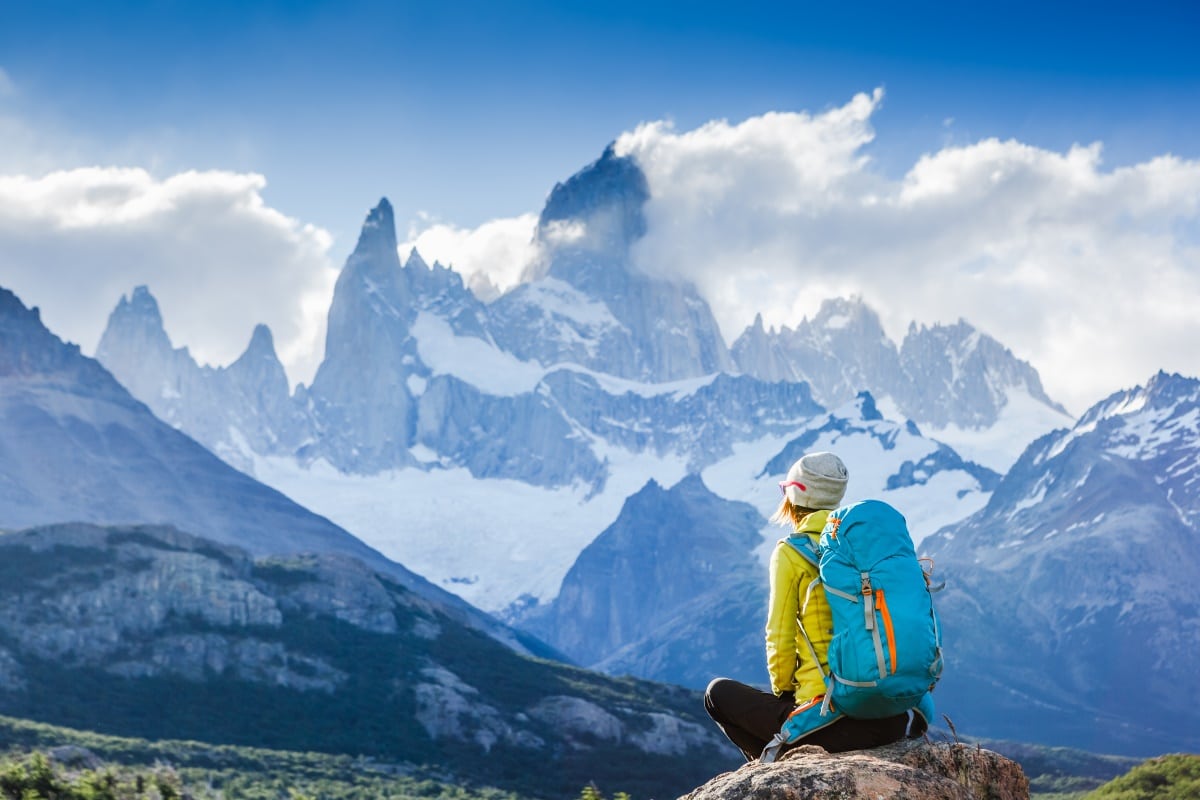
Patagonia, a region shared by Argentina and Chile, is a land of awe-inspiring natural beauty. Known for its rugged landscapes, towering mountains, and pristine glaciers, Patagonia is a haven for adventurers and nature lovers alike. This guide takes you through the most breathtaking destinations in Patagonia, each offering a unique experience of this wild and untamed region. Patagonia’s diverse landscapes promise an unforgettable journey from the iconic Torres del Paine to the remote Tierra del Fuego.
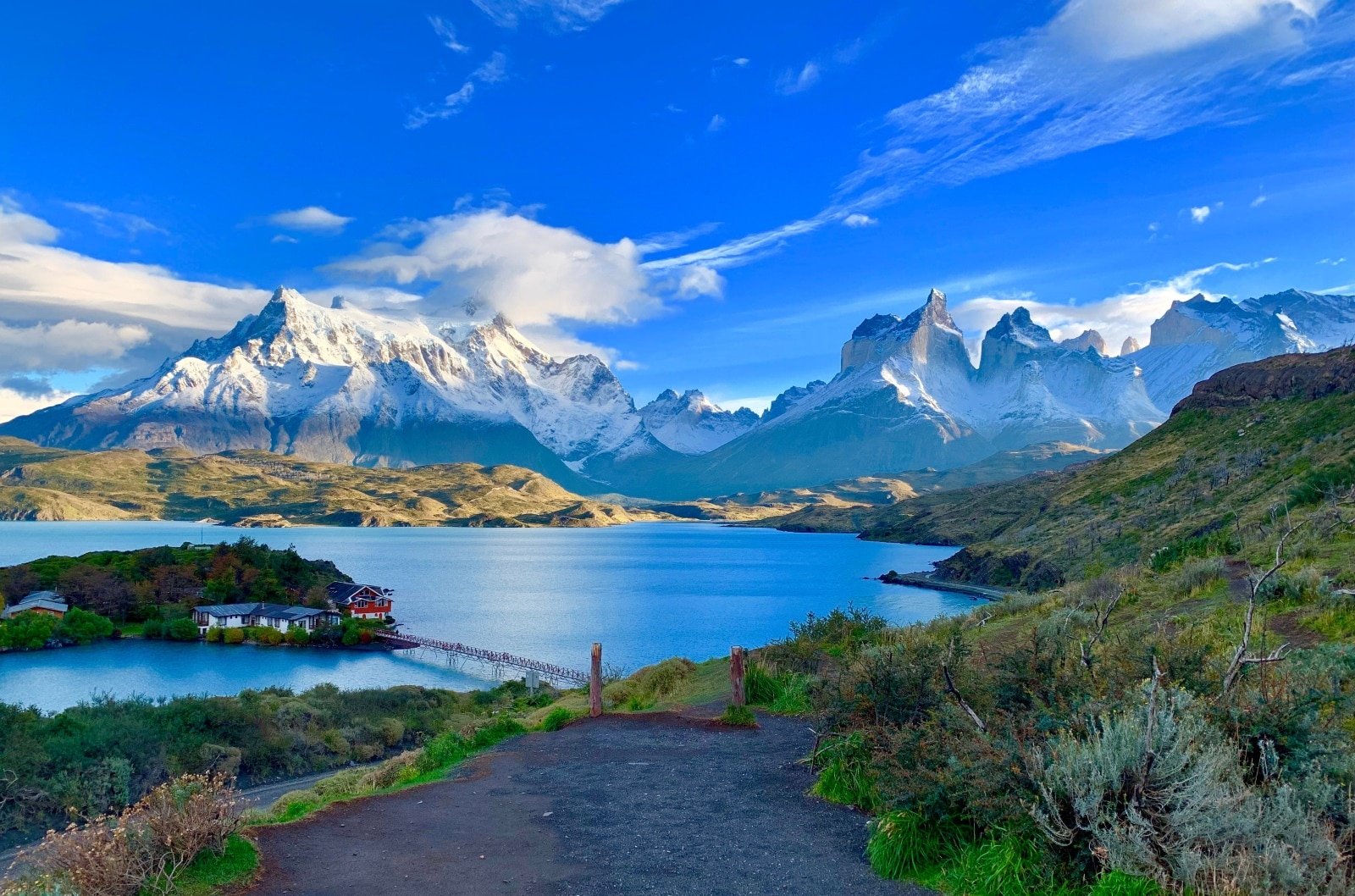
1. Torres del Paine National Park, Chile
Torres del Paine National Park, a highlight of Chilean Patagonia, is renowned for its dramatic peaks, bright blue icebergs, and vast pampas. The park’s network of trails, including the famous W Trek and the O Circuit, offers some of the world’s best trekking experiences. Hikers are treated to stunning views of the park’s namesake towers, the Paine Massif, and the Grey Glacier. The diverse ecosystems within the park, from steppe to subpolar forests, are home to an array of wildlife, including guanacos and condors.
Insider’s Tip: Book refugios or campsites well in advance if you plan to trek.
When To Travel: The best time to visit is during the Southern Hemisphere’s summer, from November to early March.
How To Get There: Fly to Punta Arenas in Chile and then take a bus or a rented car to the park.
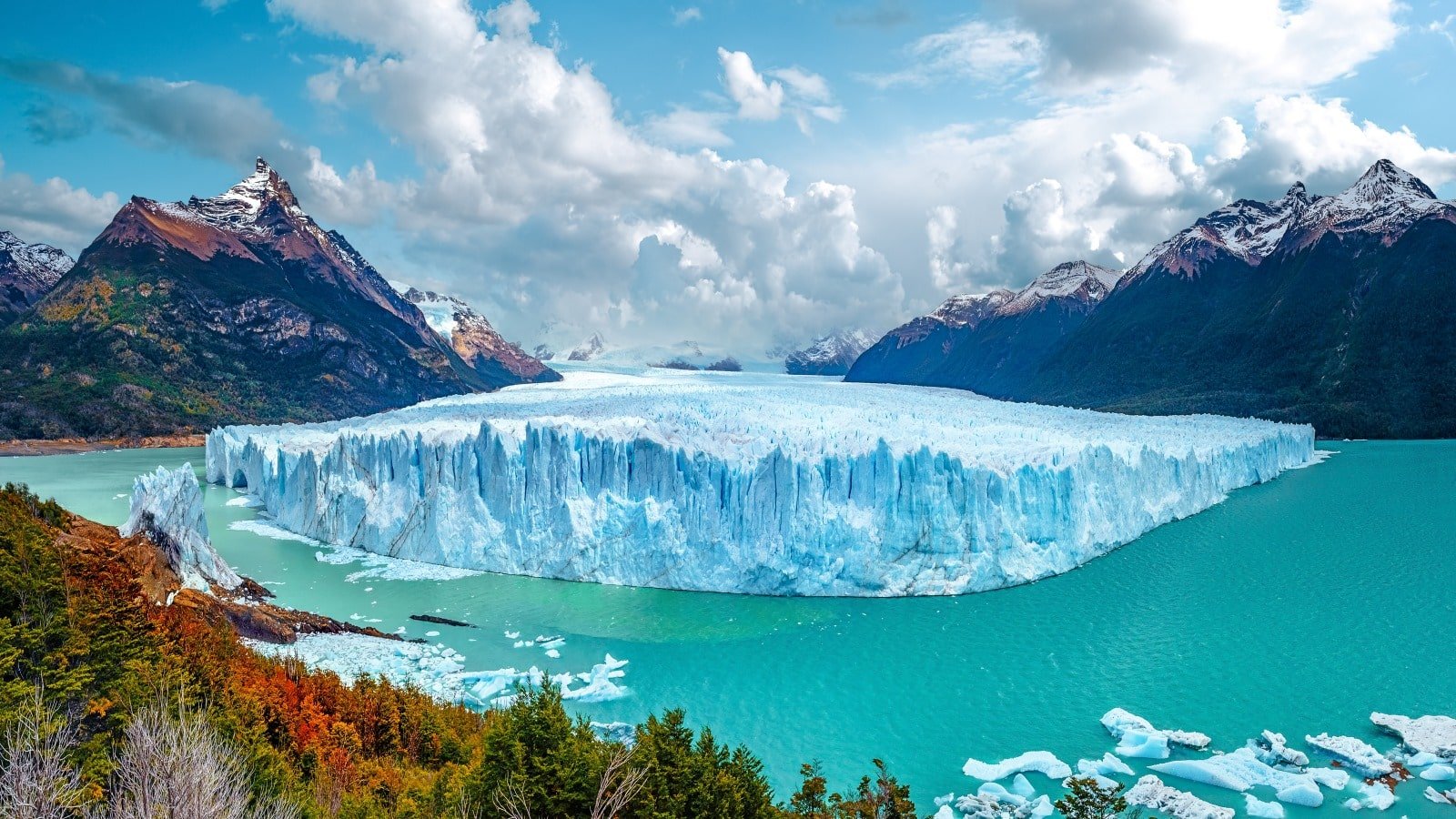
2. Perito Moreno Glacier, Argentina
The Perito Moreno Glacier, part of Argentina’s Los Glaciares National Park, is one of the most accessible and dynamic glaciers on the planet. Visitors can witness the awe-inspiring sight of ice calving from the glacier into Lake Argentino. The park offers various viewing platforms and boat tours for different perspectives of this natural wonder. Unlike many other glaciers worldwide, Perito Moreno is one of the few still growing, making it a particularly fascinating site for glaciology enthusiasts.
Insider’s Tip: Take a guided glacier walk on the ice for a memorable experience.
When To Travel: Visit between October and April for milder weather.
How To Get There: Fly to El Calafate in Argentina, and then it’s a short drive to the glacier.
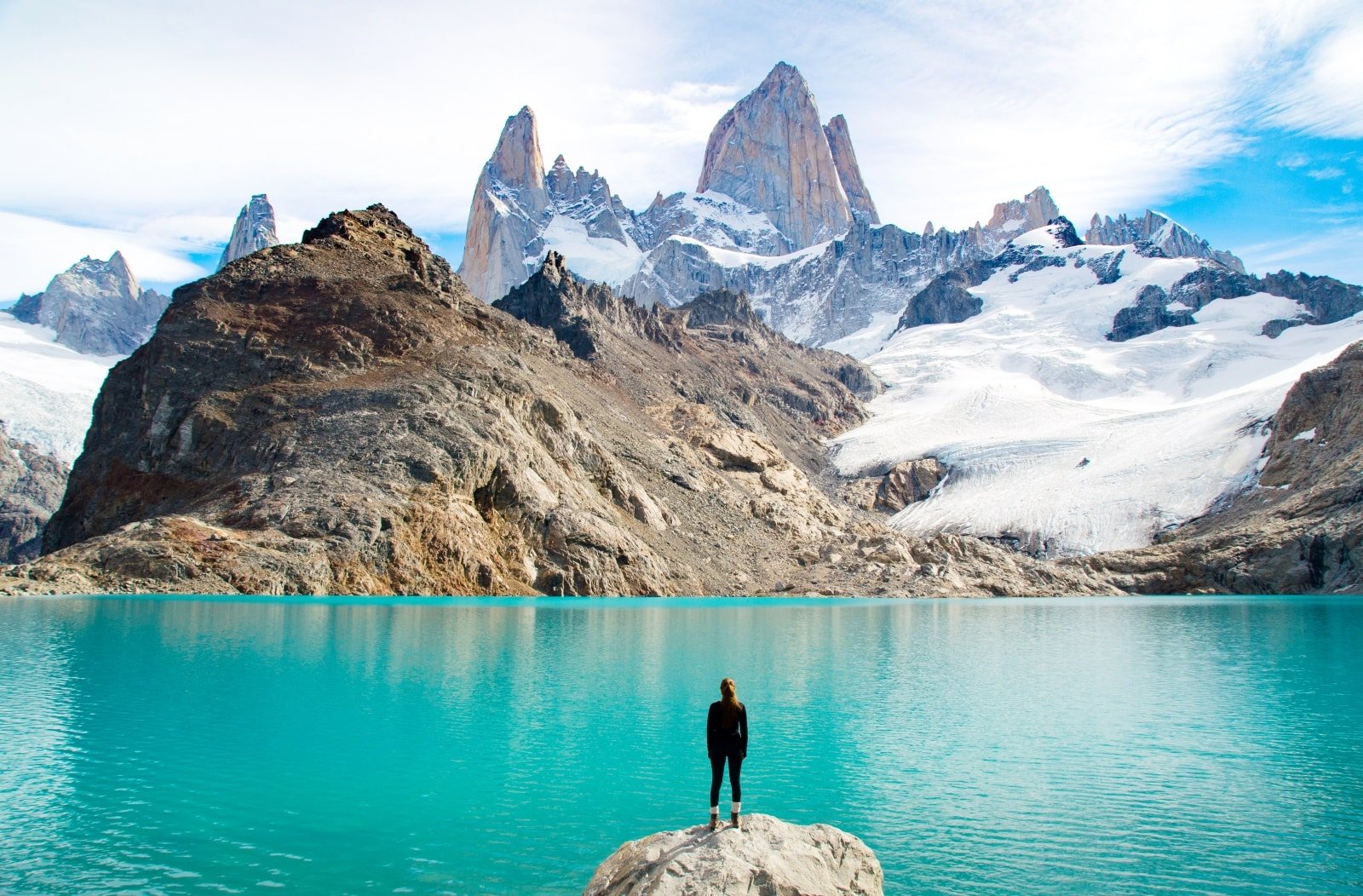
3. Fitz Roy Mountain, Argentina
Fitz Roy Mountain, near the small town of El Chaltén, is a paradise for experienced hikers and climbers. The mountain’s iconic jagged peaks present one of the world’s most challenging and rewarding climbs. For those seeking less strenuous activities, numerous trails like Laguna de los Tres offer breathtaking views of Fitz Roy and the surrounding Patagonian landscape. The town of El Chaltén itself is a charming base for exploring the region, with cozy accommodations and local eateries.
Insider’s Tip: Start your hike early in the morning to avoid crowds and enjoy the best views.
When To Travel: Trekking season runs from November to April.
How To Get There: Fly to El Calafate and then take a bus to El Chaltén.
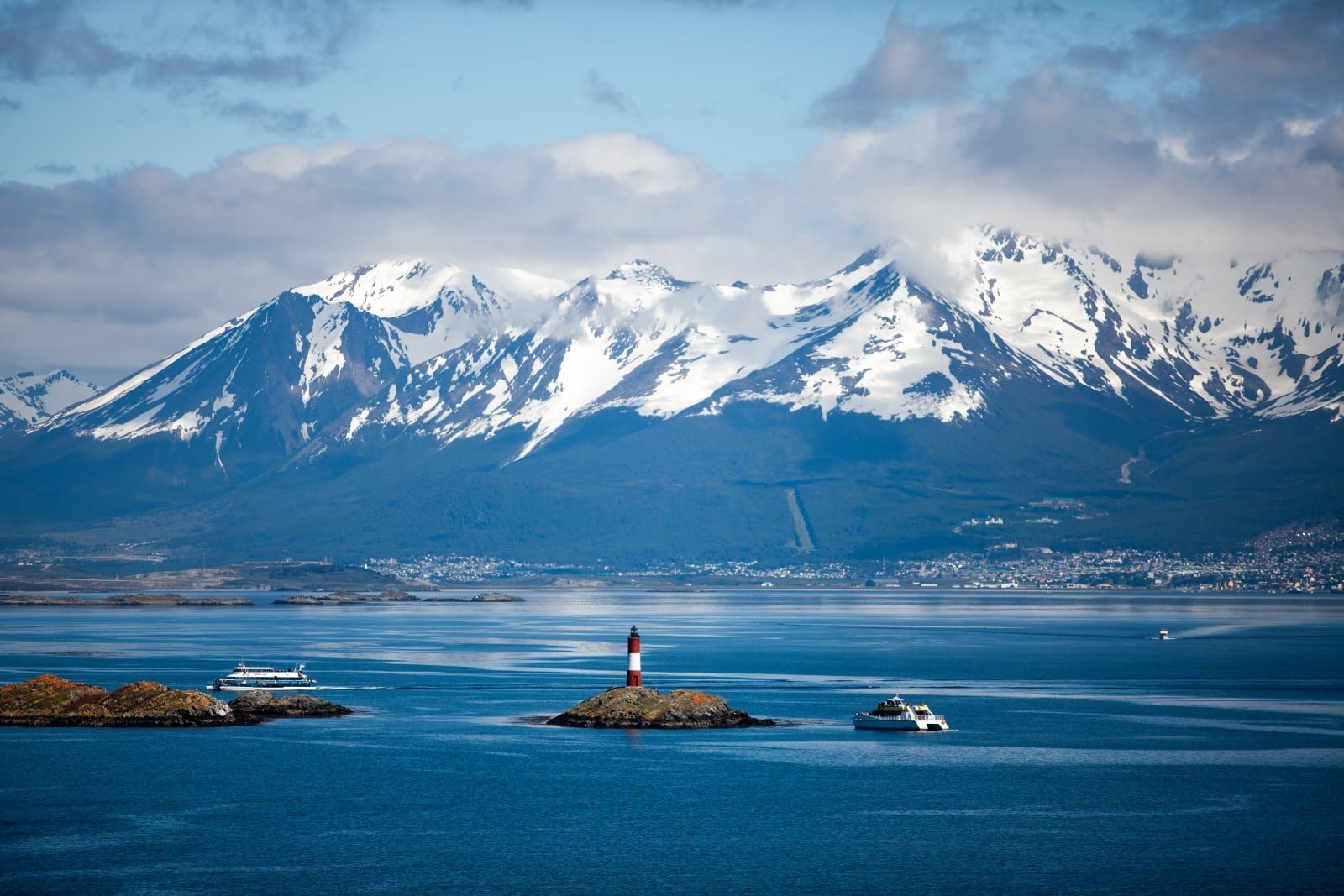
4. Tierra del Fuego, Argentina and Chile
Tierra del Fuego, an archipelago off the southern tip of South America, is a land of stark contrasts and extreme beauty. Ushuaia, the world’s southernmost city, is the gateway to this remote region. Here, visitors can explore the Tierra del Fuego National Park, take boat trips along the Beagle Channel, or embark on expeditions to Antarctica. The region’s unique flora and fauna, including Magellanic penguins and Andean foxes, make it a fascinating destination for wildlife enthusiasts.
Insider’s Tip: Visit the End of the World Museum in Ushuaia to glimpse the area’s history.
When To Travel: The best time is during the Southern Hemisphere’s summer, from December to March.
How To Get There: Fly to Ushuaia from major cities in Argentina or Chile.
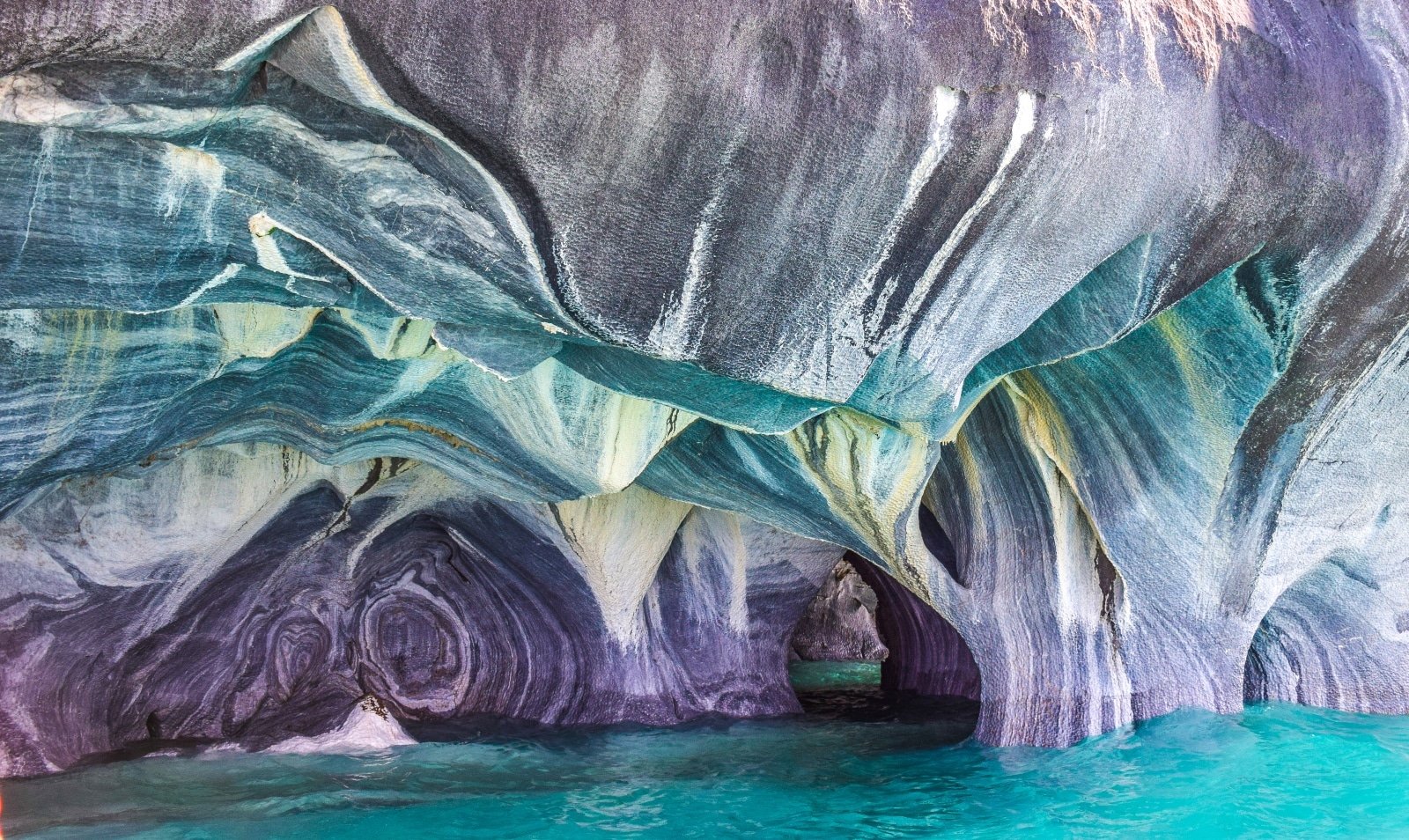
5. Marble Caves, Chile
The Marble Caves on Lake General Carrera are a breathtaking natural formation. Millennia of waves washing against calcium carbonate have sculpted these caves into stunning formations. The caves’ walls, with their swirling patterns of blue and grey, are a photographer’s dream, especially when reflected in the lake’s azure waters. Accessible only by boat, the caves offer a serene and otherworldly experience.
Insider’s Tip: Take a boat or kayak tour for the best views of the caves.
When To Travel: Visit between September and February for the best weather.
How To Get There: Fly to Balmaceda, then drive to Puerto Río Tranquilo, where tours to the caves are available.
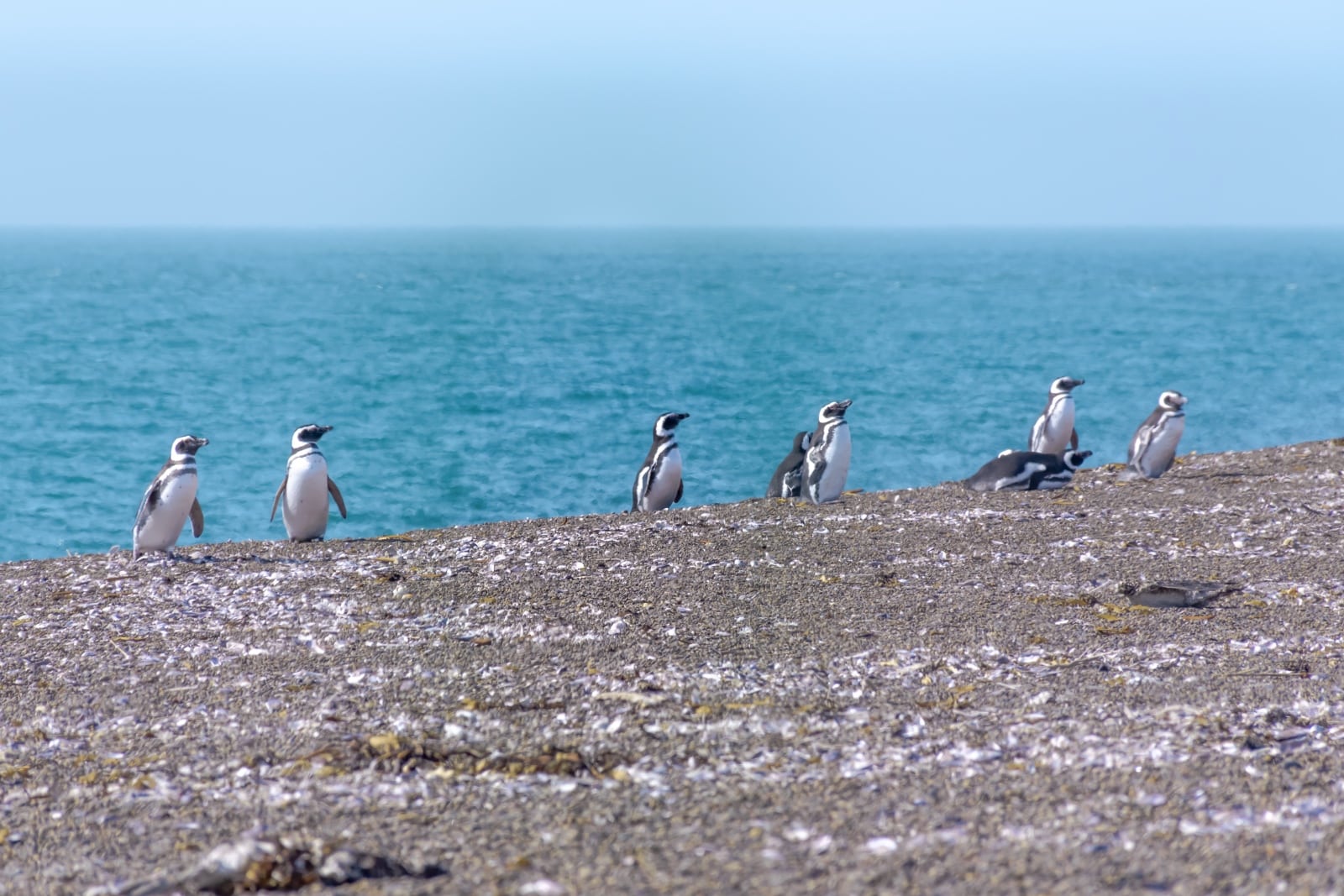
6. Valdés Peninsula, Argentina
Image Credit: Shutterstock / Natalia Di Marco The Valdés Peninsula is a UNESCO World Heritage Site celebrated for its unique marine wildlife and rugged coastline. It’s one of the best places in the world to see Southern Right Whales, which come close to shore between June and December. The peninsula also hosts large colonies of sea lions, elephant seals, and various bird species. Its steppe-like interior and dramatic coastline offer stunning landscapes and excellent wildlife viewing opportunities.
Insider’s Tip: Take a whale-watching tour between June and December to see Southern Right Whales.
When To Travel: Wildlife viewing is best from September to March.
How To Get There: Fly to Puerto Madryn or Trelew, then drive to the peninsula.
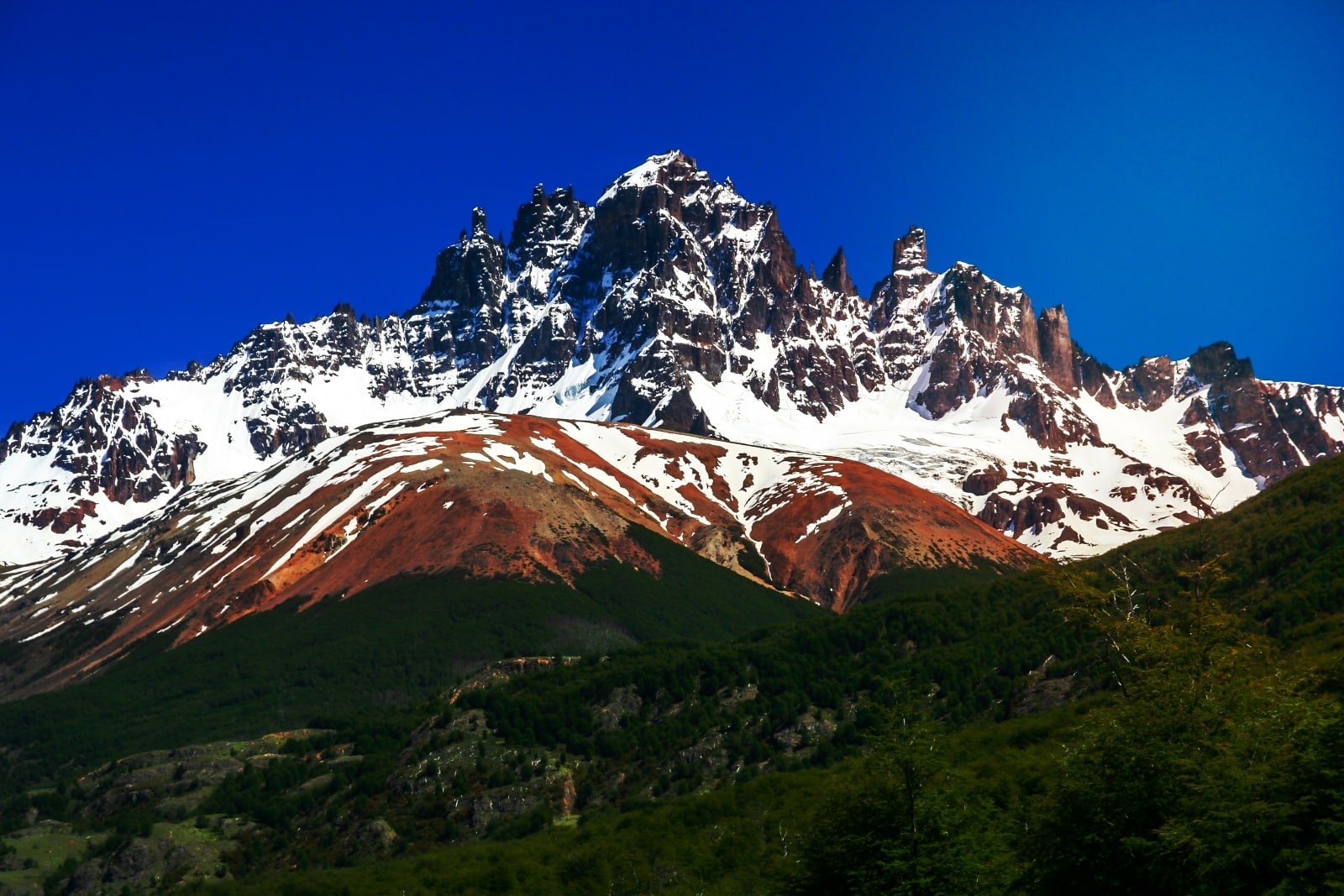
7. Cerro Castillo, Chile
Cerro Castillo, less crowded than Torres del Paine, offers equally stunning scenery for those willing to venture off the beaten path. The trek around Cerro Castillo takes you through diverse landscapes, including forests, alpine meadows, and high mountain passes, with the castle-like peaks of Cerro Castillo as a constant backdrop. The trek is challenging but rewards hikers with incredible views of glaciers, turquoise lakes, and the Patagonian wilderness.
Insider’s Tip: Pack for all weather conditions, as the weather can change rapidly.
When To Travel: The trekking season is from November to April.
How To Get There: Fly to Balmaceda and then drive or take a bus to Villa Cerro Castillo.
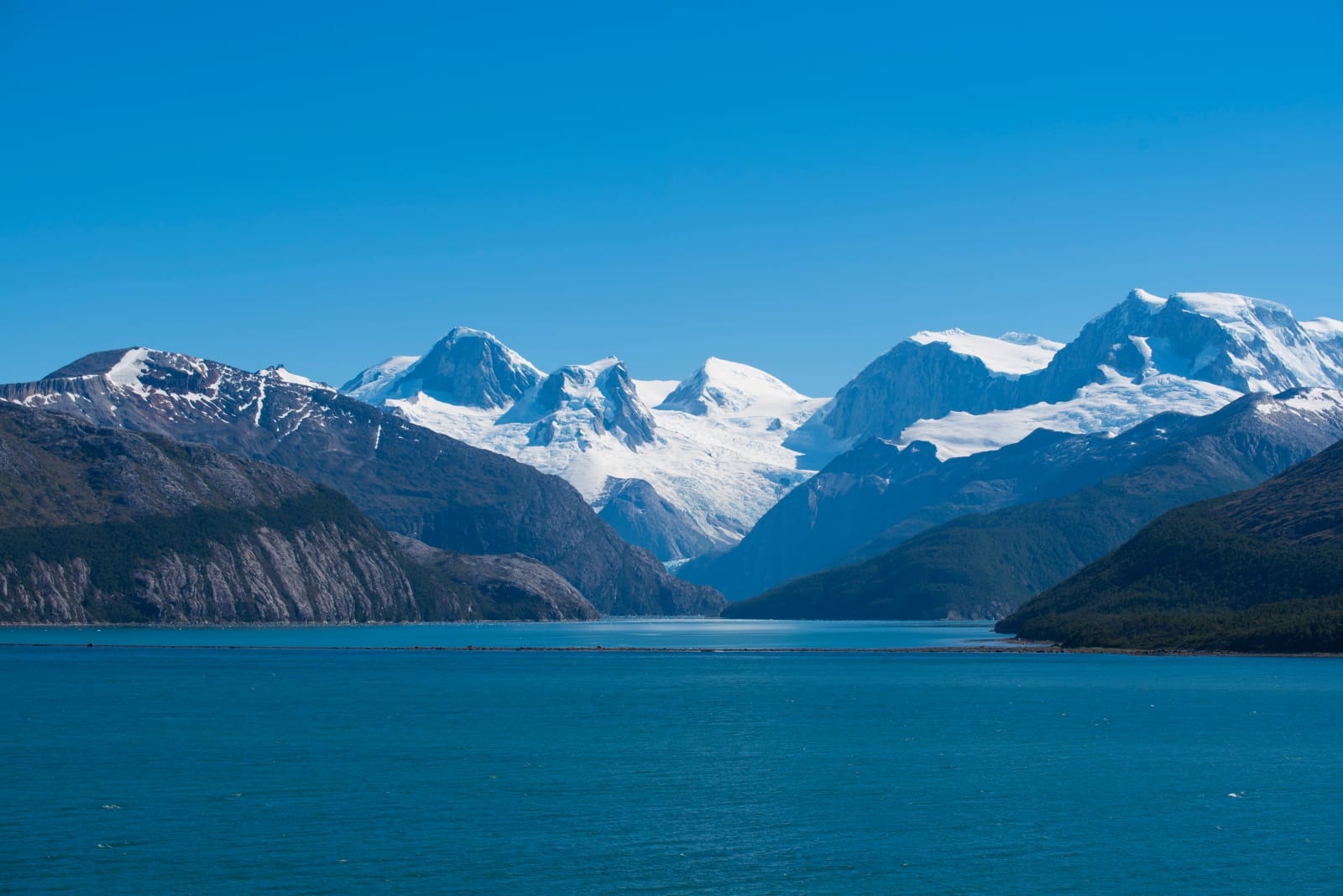
8. Cape Horn, Chile
At the southernmost tip of the South American continent, Cape Horn is a legendary location known for its challenging sailing conditions and rich maritime history. Cruises to this remote area offer a unique opportunity to experience the wild beauty of the southern seas and the sense of adventure that comes with reaching the “end of the world.” The area is also significant for its unique flora and fauna adapted to harsh conditions.
Insider’s Tip: Choose a cruise that includes lectures on the region’s history and wildlife.
When To Travel: Cruises run during the Southern Hemisphere’s summer, from December to March.
How To Get There: Cruises to Cape Horn typically depart from Ushuaia.
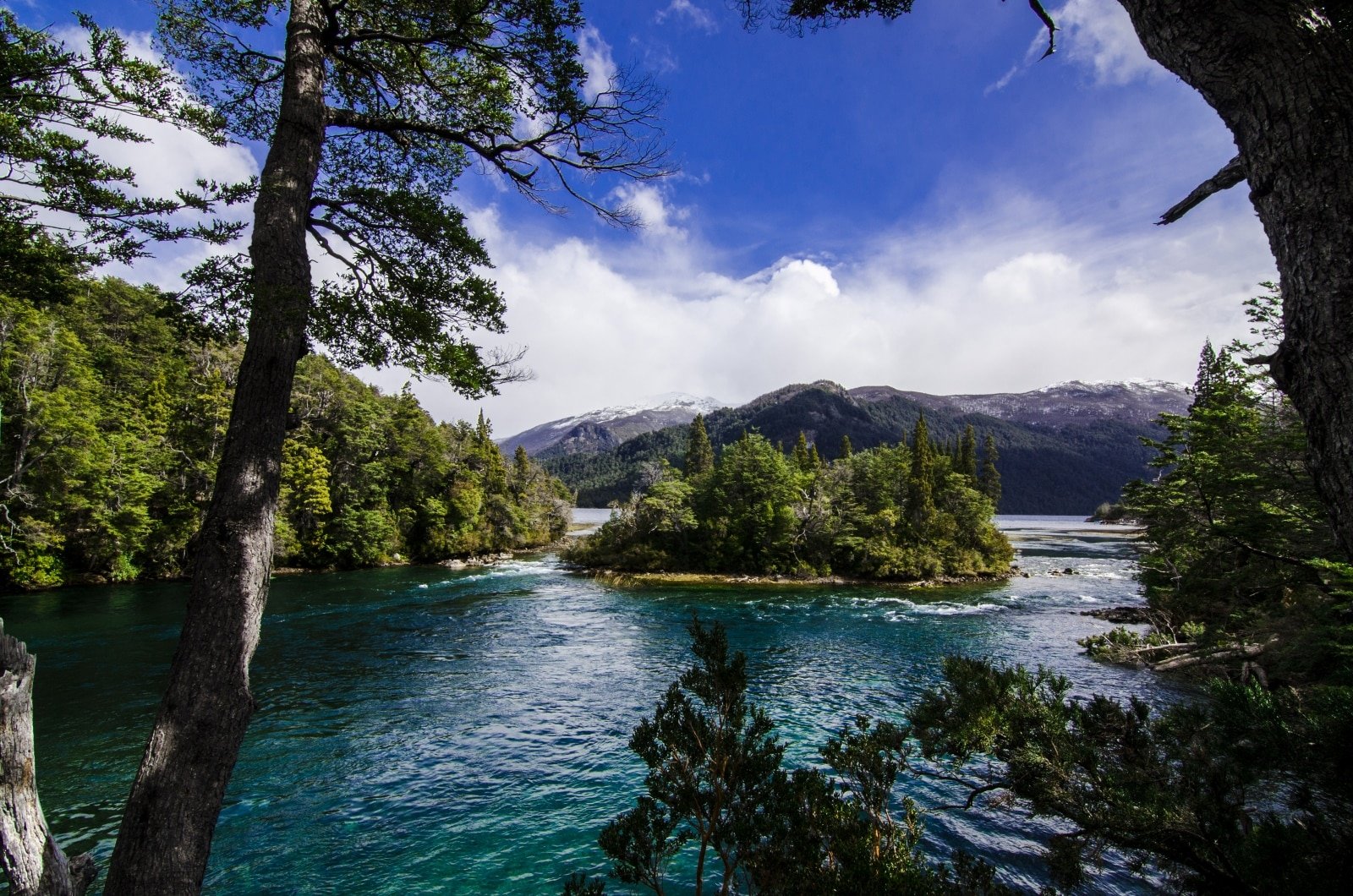
9. Los Alerces National Park, Argentina
Los Alerces National Park, a UNESCO World Heritage Site in Argentina, is known for its ancient Alerces trees, some of which are over 3,000 years old. The park’s lakes, rivers, and forests offer a serene setting for hiking, kayaking, and fishing. The park is a testament to Argentina’s commitment to conservation, with well-maintained trails and minimal-impact tourism practices. The park’s diverse ecosystems are home to various wildlife, including deer, pumas, and several bird species.
Insider’s Tip: Explore the Arrayanes Forest for a magical walk among unique cinnamon-colored trees.
When To Travel: Visit from October to April for the best weather.
How To Get There: Fly to Esquel and then drive to the park.
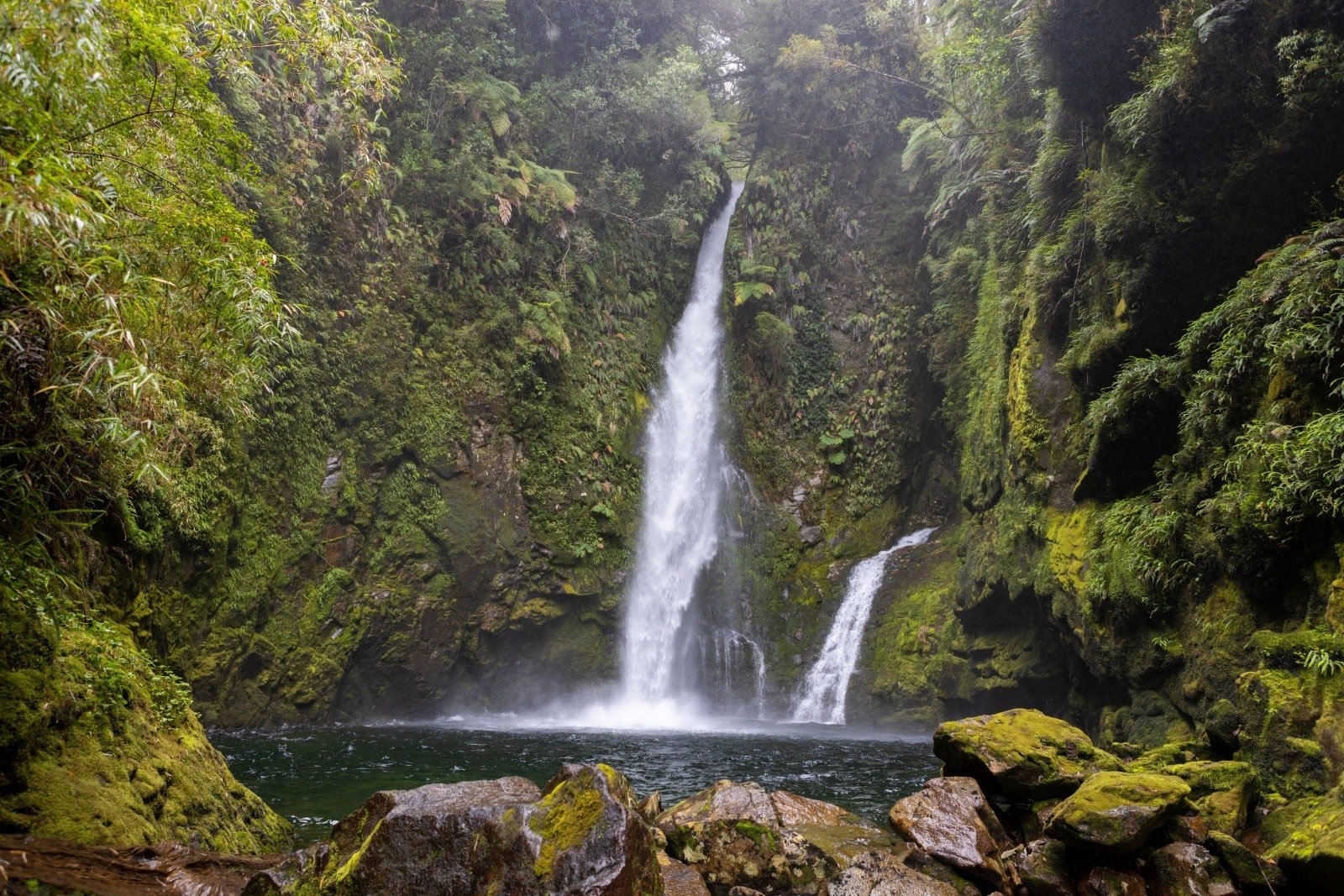
10. Pumalín Park, Chile
Pumalín Park, one of the largest private parks in the world, is a testament to conservation efforts in Chilean Patagonia. Created by conservationist Douglas Tompkins, the park spans over 400,000 hectares of temperate rainforests, fjords, and waterfalls. Visitors can hike through pristine forests, kayak along untouched fjords, and witness the park’s commitment to environmental preservation firsthand. The park’s infrastructure, including trails and campgrounds, is designed to minimize human impact on the environment.
Insider’s Tip: Visit the park’s environmental information centers to learn about its conservation efforts.
When To Travel: The best time to visit is from December to March.
How To Get There: Fly to Puerto Montt, then drive or take a ferry to the park.
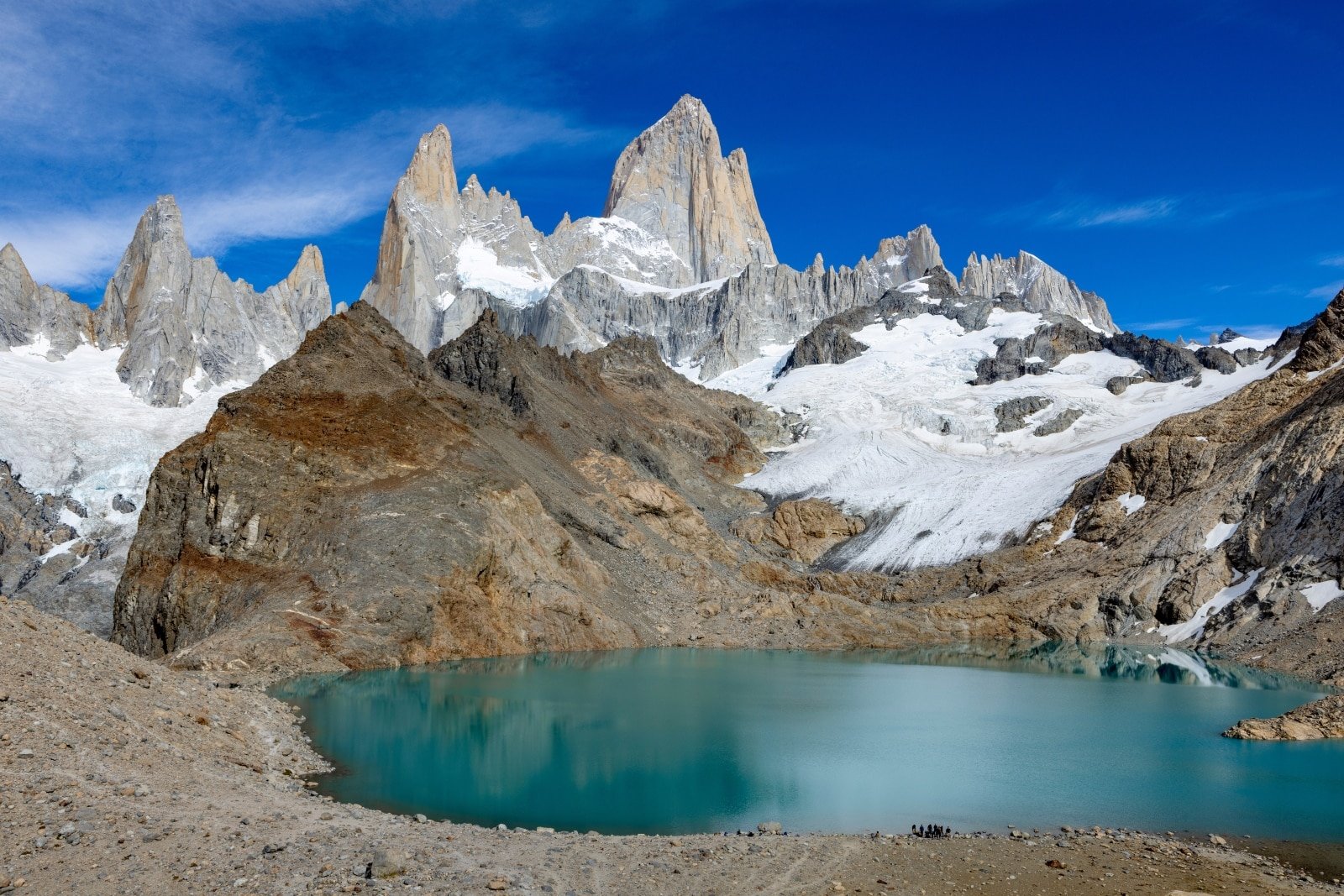
11. El Chaltén, Argentina
El Chaltén, often called Argentina’s trekking capital, is the gateway to some of Patagonia’s most iconic trails. The town offers a range of trekking options, from easy day hikes to challenging multi-day expeditions. The surrounding landscapes of glaciers, lakes, and mountains provide a stunning backdrop for outdoor activities. In addition to trekking, visitors can enjoy rock climbing, horseback riding, and fishing.
Insider’s Tip: Visit the Los Condores viewpoint for a stunning panoramic view of the town and surrounding peaks.
When To Travel: Trekking season is from October to April.
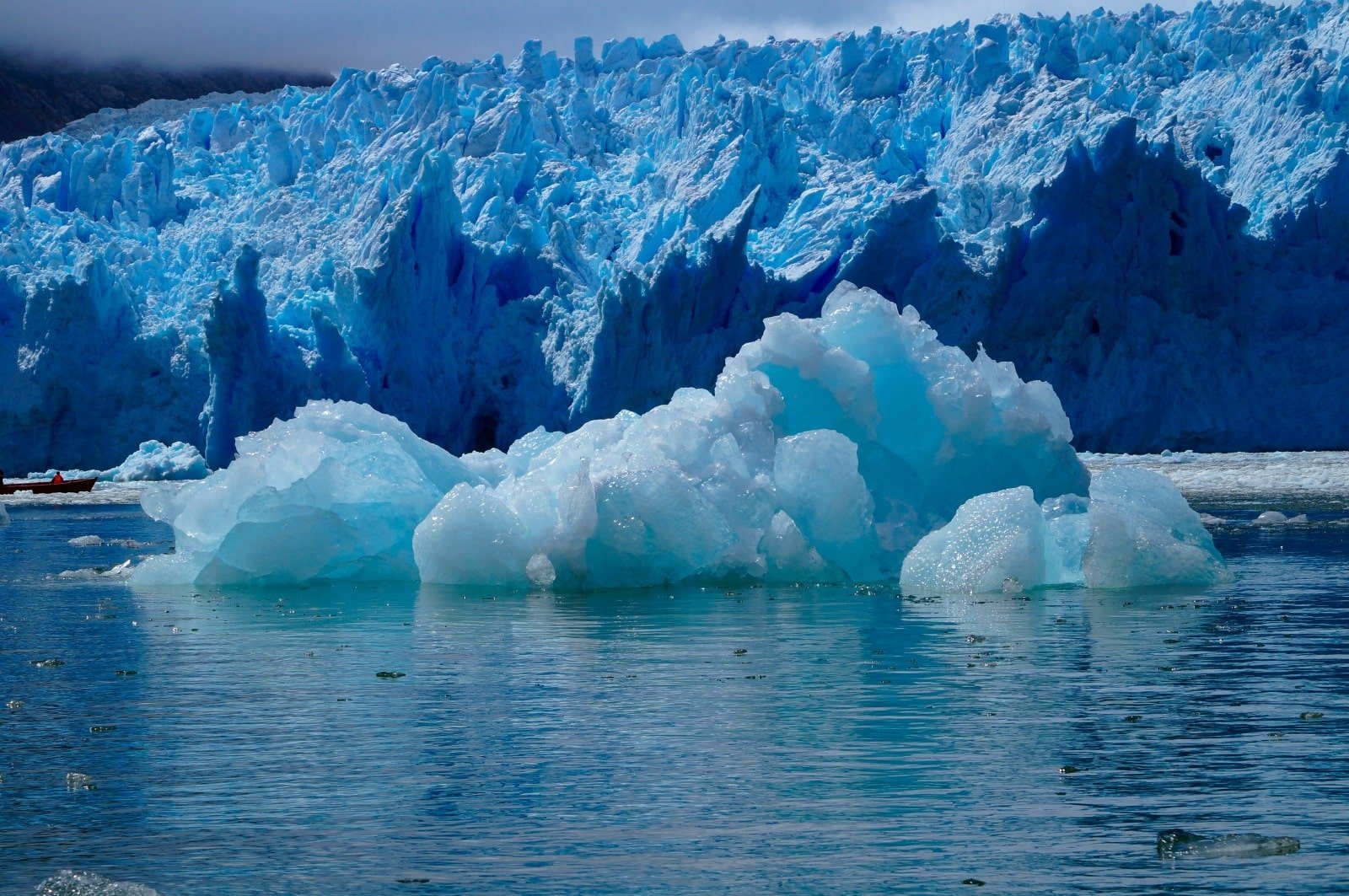
12. Laguna San Rafael National Park, Chile
Laguna San Rafael National Park is home to the San Rafael Glacier, one of the largest and most actively calving glaciers in the Chilean Patagonia. The park offers boat tours that provide close-up views of the glacier and the icebergs in the lagoon. The park’s remote location and stunning ice landscapes make it a must-visit for adventure seekers and nature enthusiasts. Visitors can also explore the surrounding rainforests and spot wildlife such as sea lions and dolphins.
Insider’s Tip: Take a boat tour that includes visiting the hot springs at Quitralco Fjord.
When To Travel: The best time for boat tours is from October to April.
How To Get There: Access is mainly by boat or plane from Coyhaique or Puerto Chacabuco.
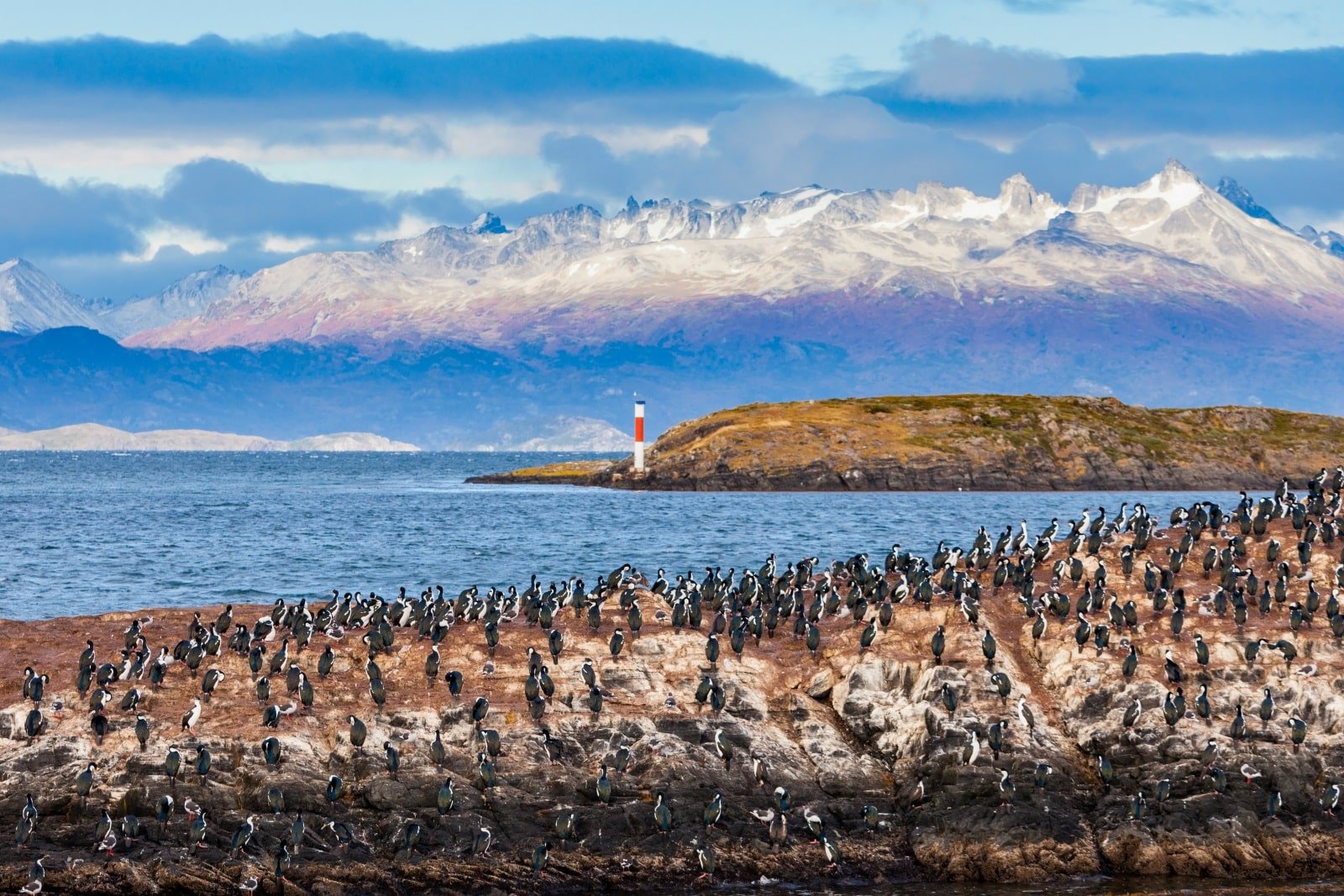
13. King Penguin Colony, Tierra del Fuego, Chile
The King Penguin Colony on the Chilean side of Tierra del Fuego offers a unique opportunity to observe these majestic birds. Located at Parque Pingüino Rey, the colony is one of the few places outside Antarctica where you can see king penguins in their natural habitat. The park provides a respectful and sustainable way to observe the penguins, with designated viewing areas to minimize disturbance.
Insider’s Tip: Respect the penguins’ space and observe them from a distance to avoid disturbing them.
When To Travel: Penguins can be seen year-round, but the best time is during the breeding season, from September to March.
How To Get There: Fly to Punta Arenas, take a ferry and drive to the park.
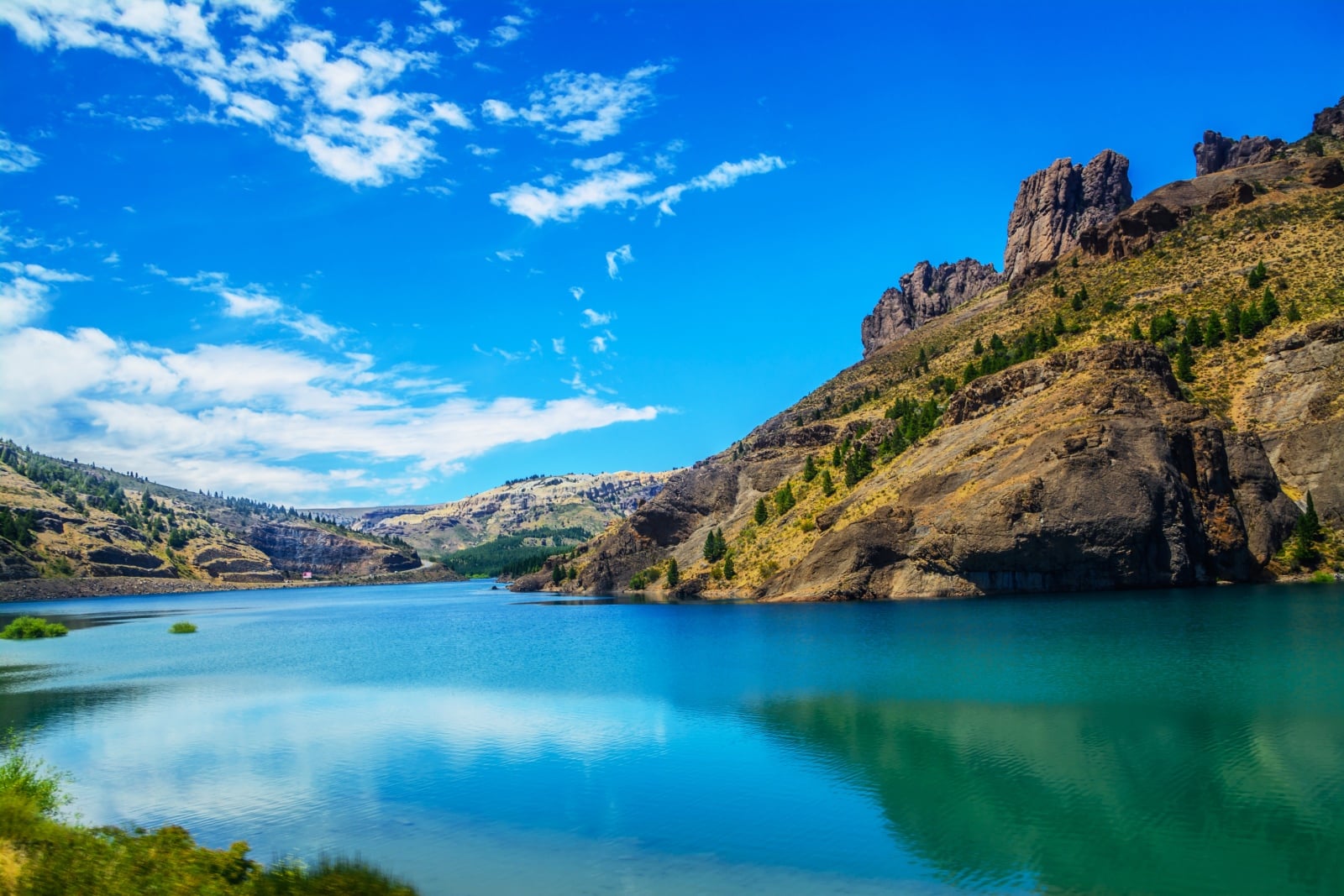
14. Bariloche, Argentina
San Carlos de Bariloche, known simply as Bariloche, offers a unique combination of stunning natural landscapes and a lively city atmosphere. Bariloche is located in Argentina’s Lake District, a hub for outdoor activities like hiking, kayaking, and mountain biking. The city’s Swiss-style architecture and renowned chocolate shops add to its charm, making it a popular destination year-round. In winter, Bariloche transforms into a ski resort, while the summer months are perfect for exploring the surrounding lakes and mountains.
Insider’s Tip: Take the cable car to Cerro Campanario for one of the best views in the region.
When To Travel: Visit from December to March for outdoor activities and pleasant weather.
How To Get There: Fly to Bariloche Airport, with regular flights from Buenos Aires.
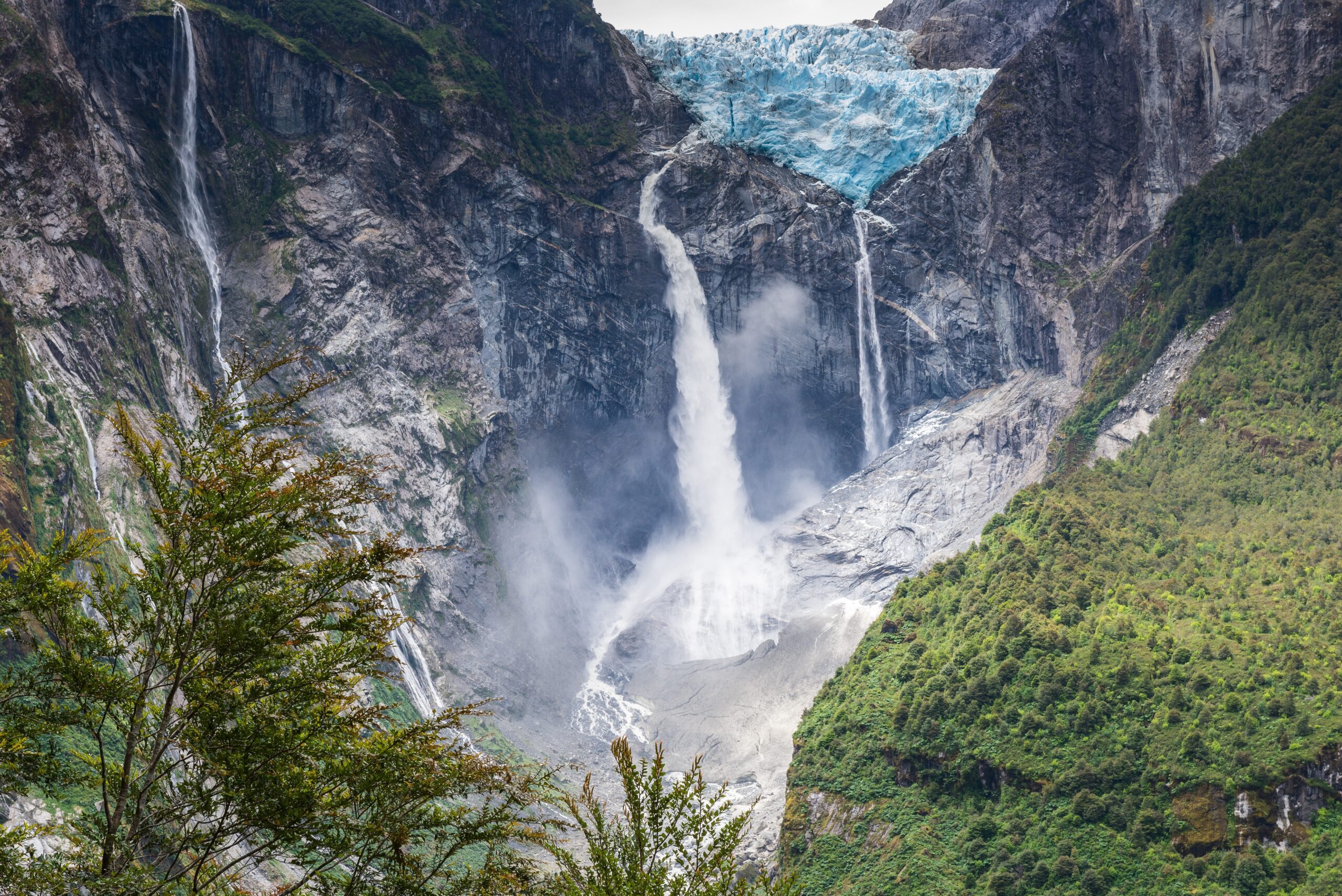
15. Aysén Region, Chile
The Aysén Region in Chilean Patagonia is a secluded paradise for adventurers. Less crowded and largely untouched, it offers a wilderness experience that includes the Northern Patagonian Ice Field and numerous fjords. The Carretera Austral, a scenic route through the region, leads to remote beauty spots ideal for hiking, kayaking, and fishing. Aysén’s rugged terrain and pristine landscapes are perfect for those seeking an immersive nature experience away from tourist trails.
Insider’s Tip: Plan a road trip along the Carretera Austral for a unique way to explore the region’s diverse landscapes.
When To Travel: The best time to visit is during the Southern Hemisphere’s summer, from December to March.
How To Get There: Fly to Balmaceda Airport and rent a car for the best exploration experience.
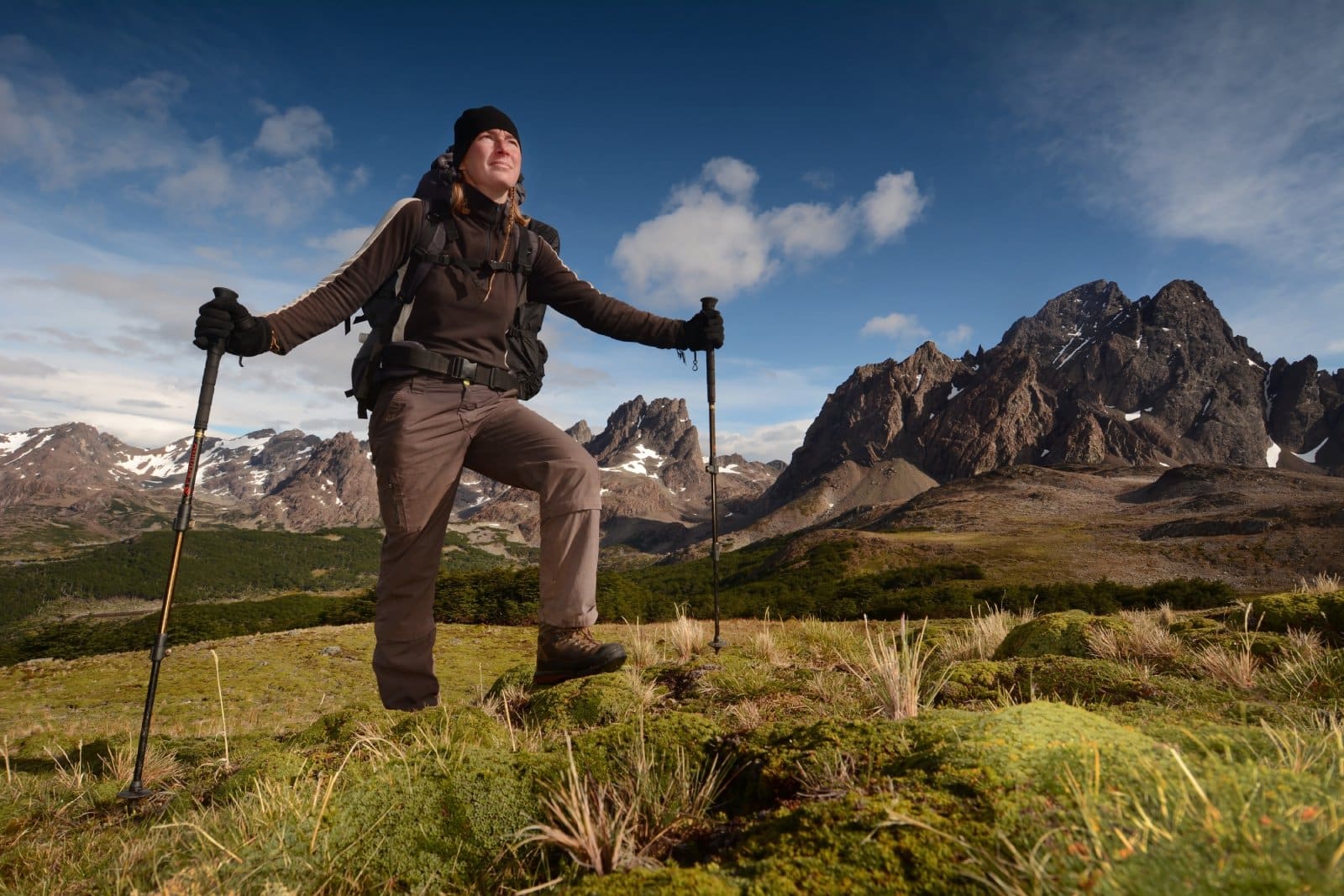
The Bottom Line
Patagonia is a land of endless natural wonders, offering experiences that range from witnessing colossal glaciers to trekking through pristine forests. Each destination in this vast region presents an opportunity to connect with nature and witness the raw beauty of one of the world’s most spectacular landscapes. As you plan your journey through Patagonia, remember that the true essence of this place lies in its wild and untamed spirit, inviting you to explore and discover its many treasures.
More Articles Like This…
Barcelona: Discover the Top 10 Beach Clubs
2024 Global City Travel Guide – Your Passport to the World’s Top Destination Cities
Exploring Khao Yai 2024 – A Hidden Gem of Thailand
The post 15 Best Places in Patagonia To Visit in 2024 republished on Passing Thru with permission from The Green Voyage .
Featured Image Credit: Shutterstock / Olga Danylenko.
For transparency, this content was partly developed with AI assistance and carefully curated by an experienced editor to be informative and ensure accuracy.
More for You
Mandisa, ‘American Idol' Star and Grammy-Winning Christian Singer, Dies at 47
‘It can happen again’: Judge set to preside over Trump trial delivers her toughest Jan. 6 sentence to date
US in ‘world first’ dogfight between AI jet and human pilot
Crows vs. Ravens: 7 Ways To Tell the Corvid Cousins Apart
25 human foods you should never give your dog—and 25 foods you can
Stephanie Sparks Dies: Host Of The Golf Channel's ‘Big Break' Reality Series Was 50
Russian Rocket Scientists Jailed for High Treason: Full List
I’m a Real Estate Agent: Here Are the 4 Florida Cities Where You Should Avoid Buying a Home
10 most ‘overpriced’ tourist attractions in the world – and three are in the US
The cicadas are coming, and some may become ‘flying saltshakers of death’
17 High Protein Snack Ideas for When You’re Hungry
25 legendary musicians you might not know were LGBTQ+
Satellite images shows extent of damage after Israeli strike on Iran
Budanov reveals details of Tu-22M3 downing
3 underrated Netflix movies you should watch this weekend (April 19-21)
'RuPaul's Drag Race' Finale Shows the Massive Impact of the Show
Jayden Daniels has a preference on where he'd like to play in the NFL
Average US annual salary by age revealed – see how you compare
Here are 5 foods and drinks to avoid if you have high blood pressure
The iconic road everyone in your state should drive down at least once
Hello, what can we help you find today?
Consider browsing by category:, popular topics.
- Programs & Resources for Students (external link)
- Request your official Stanford transcript (external link)
- Potential COVID Exposures on Campus (external link)
- Alumni Membership Card (external link)
- Stanford Alumni Email
Contact Information
- SAA Customer Service (external link)
- Stanford University Contact Information (external link)
- SAA Departments
/f/103430/800x600/42a12e9172/collection-south-america-beautiful-summer-day-national-park-torres-del-paine-patagonia-chile.jpg)
Patagonia Trek
Torres del Paine National Park is the ultimate Patagonian experience, and you’ll enjoy all it has to offer before resting and rejuvenating at our private base “glamp.”
Enlightening explorations of a vibrant region
In addition to glorious treks (including the famous W Trek), you’ll have the opportunity to partake in numerous Chilean foods and traditions. We’ll travel to a local estancia for horsebacking riding along a scenic trail and a lunch of traditional Chilean asado: open-fire lamb barbeque.
As we hike amidst the jaw-dropping beauty of Torres Del Paine, you’ll take in towering peaks, sprawling glaciers, and the crystal waters of vast lakes. We’ll venture deep into secluded valleys, where the scenery becomes even more dramatic. And for the features that have to be seen up close to be believed, we’ll travel by boat. From our catamaran, we’ll marvel at the icy blue walls of Grey Glacier and float amongst its enormous icebergs.
Minimum age
Ready to go looking for more information, be the first to know when reservations open, have a question for us.
Get in touch with someone at Travel/Study.

IMAGES
COMMENTS
Alesha enjoying the view over Grey Glacier. The French Valley - Valle Del Frances. Time Required: 3 to 4 hours Distance: 12km Difficulty: Moderate Start / Finish Points: Refugio Los Cuernos You always have energy in Patagonia, even when you are literally falling asleep, so don't miss this epic side trip that takes you between the Cerro Paine Grande and the Cuernos del Paine following the ...
Volcan Chaitén Crater Trail, Parque Nacional Pumalín Douglas R. Tompkins (Chile) Best all-encompassing view. 2.7 miles (4.4km) round trip, 3 hours, moderate. In 2008, the eponymous volcano in northern Patagonia staged a surprise eruption and buried half the town of Chaitén under mud and ash. This relatively steep five-hour round-trip trek ...
Other hikes in Torres del Paine National Park: There are dozens of trails in the park, so read my guide to the best Torres del Paine day hikes for inspiration. 10. Hike to Cabo Froward, Punta Arenas. The beginning of the Cabo Froward trail, a truly beyond-the-beaten-trail hiking route in Patagonia.
Accessibility - by car/bus from Coyhaique or Villa Cerro Castillo. Admission fee+camping in the park - CLP 30 000/US$3 5. Accommodation options - camping. The Cerro Castillo trek is one of our favorite long-distance treks in Patagonia. The route goes through the Cerro Castillo National Park.
4. The Laguna Torre Trek The Laguna Torre Trek . The wind-whipped village of El Chaltén is Argentina's premier trekking capital, with some of the most scenic hikes in South America. The most popular day hike from town, which can be extended into a multi-day hike for more adventurous travelers, is Laguna Torre also known as the Fitz Roy Trek.This 20-kilometer, in-and-out route takes you to ...
Difficulty level: easy to moderate. The hike to Laguna Esmeralda is one of the easy hikes in Patagonia. It takes you to a beautiful, emerald lagoon at the base of Glacier Albino. The starting point of the hike to Laguna Esmeralda is in Valle de Los Lobos, about 17 Km (10.5 miles) east of Ushuaia, along Ruta 3.
Because the backside of the 'O' Circuit must be traversed counter-clockwise, your only option will be to begin hiking east along the trail, which will be easy to find. Camp Italiano is a comfortable 7.5-kilometer (4.7-mile) hike from Paine Grande. Once you arrive, check in with the park ranger and set up camp.
Patagonia is an incredibly varied trekking destination. This is a true natural wonderland where condors soar and volcanos smoke. Patagonia hiking trails offer, in my opinion, some of the best treks in South America!. In 2022 I was lucky enough to spend a few months in Patagonia hiking and exploring.
Highlights: Witness the famous Torres del Paine towers mirrored in the glacial lake. One cannot speak of hiking in Patagonia without mentioning Torres del Paine National Park. A must-visit for any trekking enthusiast, the Mirador Las Torres trail offers a challenging but immensely rewarding day hike.
At the top of the mountain, you get to enjoy views of some of Patagonia's most stunning landscapes, such as El Trebol Lagoon and some of the mountains - Cerro Otto and Cerro Catedral. ... Best multi-day treks in Patagonia. Patagonia is a hiker's paradise with an enormous number of remote areas that have been barely touched by people.
The W Trek is one of the best hikes in Patagonia. The W Trek is one of the most popular hikes in all of South America, as well as the most famous trek in Torres del Paine National Park, so it's a no-brainer that it's a top contender on many a hiking bucket list.. Taking about 4-5 days to complete, the W Trek is the ideal way to cover the must-sees in the park in a more condensed time ...
6-Day Tour of Patagonia visiting El Calafate, Perito Moreno Glacier & El Chalten. 9-Day Best of Patagonia tour: El Calafate, El Chalten and Puerto Natales. 13-Day Best of Patagonia Tour from El Calafate to Ushuaia: Los Glaciares, Torres del Paine and Tierra del Fuego National Parks.
Tronador. Looking up at the Cerro Tronador hanging glacier. Difficulty: Medium. Length: 36km, overnight. At the north end of Patagonia in Argentina, the Tronador hanging glacier trek is an excellent introduction to the region. If you're starting up there like I did, don't miss this hike. The trail starts after a 2-ish hour bus ride from the ...
Some trails may be crowded in high season (Dec. to February) 4. Los Dientes de Navarino. Dientes de Navarino Trek. Location : Navarino Island, Magallanes Region, Chile. Distance & Time : about 37 km/22mi | 4 to 5 days. Difficulty : Demanding. This is by far the wildest trekking circuit in Patagonia.
Where to Stay:Mid-range:Yelcho en la Patagonia|Mid-range:Paraiso Patagonico|Mid-range:Hotel Mi Casa. #2 Hanging Glacier in Queulat National Park. Queulat National Park, near a small village called Puyuhuapihides one of the most photogenic places in Patagonia, the Hanging Glacier.
Best multi-day hike in Patagonia: The W Trek in Torres Del Paine, Chile. This hike allowed me to experience the real Patagonia. ... Top tip: If you're following my Patagonia 10 day itinerary and struggled with the hike to Laguna de los Tres in El Chalten, skip Mirador Las Torres and opt for one of the below day hikes in Torres Del Paine ...
Straddling Chile and Argentina, and divided by the Andes running in the middle, the region offers one of the top hiking and trekking destinations in the world. Torres del Paine National Park in the Chilean side and El Chalten on the Argentinean side of Patagonia have a plethora of treks and hikes, of varying length, duration and difficulty.
Scott founded FunOutdoors to connect his professional life with his passions. When Scott isn't working, you'll find him on the bike trail, riding a wave, or skiing down a mountain. Set out for an epic adventure in Patagonia Hiking. Our 2024 guide gives expert advice on gear, preparations, top trails, and must-see sights!
Wildland's Guided Patagonia hikes are all-inclusive opportunities to discover Patagonia's sheer granite spires, towering mountains, glaciers, lakes, rivers, wildlife and more! Our Patagonia hiking tours are focused on Torres del Paine National Park, an invaluable conservation and wilderness gem in Chile; and Parque Patagonia, a vast ...
The Patagonia Basecamps Trek is one of the Top 100 Travel Adventures in the world. View the list and follow our mission to complete them. Of course, we're not talking about day hikes either. We're talking about strapping on your backpack, carrying all your own supplies and heading off on the trails into the backcountry. I firmly believe ...
1) The W-Trek. Embark on the very classic multi-day pilgrimage route through one of the most stunning regions of Patagonia. Located in the heart of Torres Del Paine National Park in Chile, the W-Trek certainly will not disappoint. The hike itself viewed on a map is in the shape of a "W". On this well-trodden rite of passage, you will find ...
1. Torres del Paine 'W' & 'Circuit' Treks. Torres del Paine is a very popular hike in Patagonia, and with good reason. From the distinctive rock towers that give the national park its name to the stunning Glacier Grey and more, Torres Paine National park is full of jaw-droppingly beautiful scenery.
Adventure Backpacking Chilean Patagonia O Trek. Claire Barber. Claire Barber calls the West and Southwest (Colorado mountains) home, though she grew up and spent her younger years in South Florida ...
Patagonia, a region shared by Argentina and Chile, is a land of awe-inspiring natural beauty. ... The park's network of trails, including the famous W Trek and the O Circuit, offers some of the ...
Patagonia Trek. Torres del Paine National Park is the ultimate Patagonian experience, and you'll enjoy all it has to offer before resting and rejuvenating at our private base "glamp." Overview. Enlightening explorations of a vibrant region. In addition to glorious treks (including the famous W Trek), you'll have the opportunity to ...